
W83877ATF
WINBOND I/O

W83877ATF Data Sheet Revision History
Pages
Dates
Version
Version
on Web
Main Contents
1
n.a.
07/29/97
0.50
First published.
2
1,3,6,49,50,98,140,
141,142,170
04/10/98
0.51
A1
Typo correction and data calibrated
3
4
5
6
7
8
9
10
Please note that all data and specifications are subject to change without notice. All
the trade marks of products and companies mentioned in this data sheet belong to
their respective owners.
LIFE SUPPORT APPLICATIONS
These products are not designed for use in life support appliances, devices, or
systems where malfunction of these products can reasonably be expected to result
in personal injury. Winbond customers using or selling these products for use in
such applications do so at their own risk and agree to fully indemnify Winbond for
any damages resulting from such improper use or sales.

W83877ATF
Publication Release Date: July 1997
- I -
Version 0.50
TABLE OF CONTENTS
GENERAL DESCRIPTION ................................................................................................1
FEATURES ..........................................................................................................................2
1.0 PIN CONFIGURATION ...............................................................................................4
1.0
PIN DESCRIPTION ........................................................................................................................5
1.1
HOST INTERFACE .........................................................................................................................5
1.2
SERIAL PORT INTERFACE ...........................................................................................................7
1.3
MULTI-MODE PARALLEL PORT ..................................................................................................9
1.4
FDC INTERFACE ..........................................................................................................................14
2.0 FDC FUNCTIONAL DESCRIPTION........................................................................16
2.1
W83877ATF FDC...........................................................................................................................16
2.2
REGISTER DESCRIPTIONS .........................................................................................................28
3.0 UART PORT................................................................................................................39
3.1
UNIVERSAL ASYNCHRONOUS RECEIVER/TRANSMITTER (UART A, UART B)..................39
3.2
REGISTER ADDRESS...................................................................................................................40
3.3
INFRARED PORT .........................................................................................................................49
4.0 PARALLEL PORT.....................................................................................................82
4.1
PRINTER INTERFACE LOGIC .....................................................................................................82
4.2
ENHANCED PARALLEL PORT (EPP) .........................................................................................84
4.3
EXTENDED CAPABILITIES PARALLEL (ECP) PORT ...............................................................88
4.4
EXTENSION FDD MODE (EXTFDD)...........................................................................................97
4.5
EXTENSION 2FDD MODE (EXT2FDD).......................................................................................97
5.0 PLUG AND PLAY CONFIGURATION ....................................................................98
6.0 ACPI /LEGACY FEATURE AND AUTO POWER MANAGEMENT .....................98
6.1
ACPI/LEGACY POWER MANAGEMENT ...................................................................................98
6.2
DEVICE(AUTO) POWER MANAGEMENT..................................................................................98
7.0 SERIAL IRQ.................................................................................................................99

W83877ATF
Publication Release Date: July 1997
- II -
Version 0.50
7.1
START FRAME ........................................................................................................................... 100
7.2
IRQ/DATA FRAME ..................................................................................................................... 100
7.3
STOP FRAME.............................................................................................................................. 101
7.4
RESET AND INITIALIZATION .................................................................................................. 101
8.0 EXTENDED FUNCTION REGISTERS ..................................................................102
8.1 EXTENDED FUNCTIONS ENABLE REGISTERS (EFERS)........................................................... 102
8.2 EXTENDED FUNCTION INDEX REGISTERS (EFIRS), EXTENDED FUNCTION DATA
REGISTERS (EFDRS) ................................................................................................................... 103
8.3 ACPI REGISTERS FEATURES ....................................................................................................... 150
8.4 ACPI REGISTERS (ACPIRS)........................................................................................................... 152
9.0 SPECIFICATIONS....................................................................................................166
9.1
ABSOLUTE MAXIMUM RATINGS............................................................................................ 166
9.2
DC CHARACTERISTICS ............................................................................................................ 166
9.3
AC CHARACTERISTICS ............................................................................................................ 168
10.0 TIMING WAVEFORMS ........................................................................................174
10.1 FDC.............................................................................................................................................. 174
10.2 UART/PARALLEL....................................................................................................................... 175
10.3 PARALLEL PORT ....................................................................................................................... 177
11.0 APPLICATION CIRCUITS....................................................................................183
11.1 PARALLEL PORT EXTENSION FDD ........................................................................................ 183
11.2 PARALLEL PORT EXTENSION 2FDD....................................................................................... 184
11.3 FOUR FDD MODE...................................................................................................................... 184
12.0 ORDERING INFORMATION ...............................................................................185
13.0 HOW OT READ THE TOP MARKING ...............................................................185
14.0 PACKAGE DIMENSIONS .....................................................................................186

W83877ATF
WINBOND I/O
Publication Release Date: April 1998
- 1 -
Version 0.51
GENERAL DESCRIPTION
The W83877ATF is an enhanced version from Winbond's most popular I/O chip W83877F --- which
integrates the disk drive adapter, serial port (UART), IrDA 1.0 SIR, parallel port, configurable plug-
and-play registers for the whole chip --- plus additional powerful features:
IrDA 1.1 (MIR for 1.152M
bps or FIR for 4M bps), TV remote IR,
ACPI, serial IRQ,
full 16-bit address decoding, and ACPI
compliant.
The disk drive adapter functions of W83877ATF include a floppy disk drive controller compatible with
the industry standard 82077/765, data separator, write pre-compensation circuit, decode logic, data
rate selection, clock generator, drive interface control logic, and interrupt and DMA logic. The wide
range of functions integrated onto the W83877ATF greatly reduces the number of components
required for interfacing with floppy disk drives. The W83877ATF supports four 360K, 720K, 1.2M,
1.44M, or 2.88M disk drives and data transfer rates of 250 Kb/S, 300 Kb/S, 500 Kb/S,1 Mb/S, and 2
Mb/S.
The W83877ATF provides two high-speed serial communication ports (UARTs), one of which
supports serial Infrared communication. Each UART includes a 16-byte send/receive FIFO, a
programmable baud rate generator, complete modem control capability, and a processor
interrupt
system. One of the UARTs supporting infrared (IR) includes 32-byte FIFO, serial IR, 1.152M bps MIR,
0.576M bps, 4M bps FIR, and TV remote IR (supporting NEC, RC-5, extended RC-5, and RECS-80
protocols). Both UARTs provide legacy speed with baud rate 115.2k, and provide advanced speed
with baud rate
230k, 460k, and 921k bps which support higher speed Modems.
The W83877ATF supports one PC-compatible printer port (SPP), Bi-directional Printer port (BPP)
and also Enhanced Parallel Port (EPP) and Extended Capabilities Port (ECP). Through the printer
port interface pins, also available are: Extension FDD Mode and Extension 2FDD Mode allowing one
or two external floppy disk drives to be connected to the notebook computer.
Winbond W83877ATF provides functions that comply with
ACPI (Advanced Configuration and Power
Interface), which includes support of legacy and ACPI power management through
SMI
or
SCI
function pins. One 24-bit power management timer is implemented with carry notify interrupt.
W83877ATF also has auto power management to reduce power consumption.
The
Serial IRQ for PCI architecture is supported, ISA IRQs (IRQ1~IRQ15) can be cascaded into one
IRQ pin. W83877ATF also features ISA bus IRQ sharing and allows two or more devices to share the
same IRQ.
W83877ATF is made to fully comply with
Microsoft
TM
PC97 Hardware Design Guide. IRQs, DMAs,
and I/O space resource are flexible to adjust to meet ISA PnP requirements. Moreover, W83877ATF
is made to meet the specification of PC97's requirement in the power management:
ACPI and DPM
(Device Power Management).
The configuration registers support mode selection, function enable/disable, and power down function
selection. Furthermore, the configurable PnP features are compatible with the plug-and-play feature
demand of Windows 95
TM
, which makes system resource allocation more efficient than ever.
Another benifit is that W83877ATF has the same pin assignment as W83877F, W83877AF,
W83877TF. Thius makes the design very flexible.

W83877ATF
Publication Release Date: April 1998
- 2 -
Version 0.51
FEATURES
General:
�
Plug & Play 1.0A Compliant
�
Support 8 IRQs (ISA), or 15 IRQs (Serial IRQ), 4 DMA channels, and 480 Relocatable addresses
�
Capable of ISA Bus IRQ Sharing
�
Compliant with
Microsoft
TM
PC97 Hardware Design Guide
�
Support
DPM (Device Power Management), ACPI
�
Report ACPI status interrupt by
nSCI signal from serial IRQ pin, or from IRQ A~H pins
�
Single 24M or 48M Hz crystal input
FDC:
�
Compatible with IBM
TM
PC AT disk drive systems
�
Variable write pre-compensation with track selectable capability
�
DMA enable logic
�
Support floppy disk drives and tape drives
�
Detects all overrun and underrun conditions
�
Built-in address mark detection circuit to simplify the read electronics
�
FDD anti-virus functions with software write protect and FDD write enable signal (write data signal
is forced to be inactive)
�
Support up to four 3.5-inch or 5.25-inch floppy disk drives
�
Completely compatible with industry standard 82077
�
360K/720K/1.2M/1.44M/2.88M format; 250K, 300K, 500K, 1M, 2M bps data transfer rate
�
Support vertical recording format
�
Support 3-mode FDD, and its Windows95
TM
driver
�
16-byte data FIFOs
UART:
�
Two high-speed 16550 compatible UARTs with 16-byte send/receive FIFOs
�
MIDI compatible
�
Fully programmable serial-interface characteristics:
-
5, 6, 7 or 8-bit characters
-
Even, odd or no parity bit generation/detection
-
1, 1.5 or 2 stop bits generation

W83877ATF
Publication Release Date: April 1998
- 3 -
Version 0.51
�
Internal diagnostic capabilities:
-
Loop-back controls for communications link fault isolation
-
Break, parity, overrun, framing error simulation
�
Programmable baud generator allows division of 1.8461 M Hz and 24 MHz by 1 to (2
16
-1)
�
Maximum baud rate up to 921k bps for 14.768M Hz and 1.5M bps for 24M Hz
Infrared:
�
Support IrDA version 1.0 SIR protocol with maximum baud rate up to 115.2K bps
�
Support SHARP ASK-IR protocol with maximum baud rate up to 57,600 bps
�
Support IrDA version 1.1 MIR (1.152M bps) and FIR (4M bps) protocol
-
Single DMA channel for transmitter or receiver
-
32-byte FIFO is supported in both FIR TX/RX transmission
-
8-byte status FIFO is supported to store received frame status (such as overrun, CRC error, etc.)
�
Support auto-config SIR and FIR
�
Support full Customer IR
�
Support driver for
Microsoft
TM
Windows 95
TM
and Windows
98
TM
(Memphis
TM
)
Parallel Port:
�
Compatible with IBM
TM
parallel port
�
Support PS/2 compatible bi-directional parallel port
�
Support Enhanced Parallel Port (EPP)
-
Compatible with IEEE 1284 specification
�
Support Extended Capabilities Port (ECP)
-
Compatible with IEEE 1284 specification
�
Extension FDD mode supports disk drive B and Extension 2FDD mode supports disk drives A and B
through parallel port
�
Enhanced printer port back-drive current protection
Others:
�
Programmable configuration settings
�
Immediate or automatic power-down mode for power management
�
All hardware power-on settings have internal pull-up or pull-down resistors as default value
�
Full 16-bit address decode (UART B pin option)
�
PNF pin (Printer-Not-Floppy pin) for distinguishing printer port connection --- FDD or Printer; unique
for notebook application of external floppy through printer port
Package:
�
100-pin QFP (W83877ATF), and also 100-pin TQFP (W83877ATD)

W83877ATF
Publication Release Date: April 1998
- 4 -
Version 0.51
PIN CONFIGURATION
/
M
O
B
/
M
O
A
/
T
R
A
K
0
N
W
P
/
D
S
K
C
H
G
A
1
0
/
R
D
A
T
A
D
7
D
6
D
5
D
4
D
3
D
2
D
1
D
0
G
N
D
/
I
O
W
/
I
O
R
A
E
N
A
9
A
8
A
7
A
6
A
5
V
D
D
A
4
A
3
A
2
A
1
A
0
X
X
X
X
X
X
X
X
X
X
X
X
X
X
X
X
X
X
X
X
X
X
X
X
X
X
X
X
X
X
X
X
X
X
X
X
X
X
X
X
X
X
X
X
X
X
X
X
X
X
X
X
X
X
X
X
X
X
X
X
X
X
X
X
X
X
X
X
X
X
X
X
X
X
X
X
X
X
X
X
X
X
X
X
X
X
X
X
X
X
X
81
82
83
84
85
86
87
88
89
90
91
92
93
94
95
96
97
98
99
100
50
49
48
47
46
45
44
43
42
41
40
39
38
37
36
35
34
33
32
31
80 79 78 77 76 75 74 73 72 71 70 69 68 67 66 65 64 63 62 61 60 59 58 57 56 55 54 53 52 51
1 2 3 4 5 6 7 8 9 10 11 12 13 14 15 16 17 18 19 20 21 22 23 24 25 26 27 28 29 30
RIB
DCDB
DSRB
CTSB
DTRB
RTSB
IRQ_C
SOUTB
SINB
DACK_A
GND
DRQ_A
SOUTA
IRQ_D
RTSA
DTRA
CTSA
DSRA
DCDA
RIA
I
R
Q
G
/
C
S
/
S
C
I
D
R
Q
|
C
I
O
C
H
R
D
Y
M
R
C
L
K
I
N
/
S
M
I
P
D
0
P
D
1
P
D
2
P
D
3
P
D
4
V
D
D
P
D
5
P
D
6
P
D
7
/
D
A
C
K
|
C
/
S
T
B
/
A
F
D
/
I
N
I
T
/
S
L
I
N
I
R
Q
|
E
B
U
S
Y
G
N
D
/
A
C
K
P
E
S
L
C
T
/
E
R
R
S
I
N
A
INDEX
STEP
DSA
DSB
WE
WD
RWC
HEAD
DIR
GND
IRQ_H
IRQ_B
IRQIN
IRRX2
IRTX2
IRQ_A
TC
DACK_B
IRQ_F
DRQ_B

W83877ATF
Publication Release Date: April 1998
- 5 -
Version 0.51
1.0 PIN DESCRIPTION
Note: Refer to section 9.2 DC CHARACTERISTICS for details.
I/O
8tc
- TTL level output pin with 8 mA source-sink capability; CMOS level input voltage
I/O
12t
- TTL level bi-directional pin with 12 mA source-sink capability
I/O
12ts
- TTL level bi-directional pin with 12 mA source-sink capability and Schmitt-triggered input
I/O
24t
- TTL level bi-directional pin with 24 mA source-sink capability
OUT
8t
- TTL level output pin with 8 mA source-sink capability
OUT
12t
- TTL level output pin with 12 mA source-sink capability
OD
12
- Open-drain output pin with 12 mA sink capability
OD
24
- Open-drain output pin with 24 mA sink capability
IN
t
- TTL level input pin
IN
ts
- TTL level Schmitt-triggered input pin
IN
cs
- CMOS level Schmitt-triggered input pin
1.1 HOST INTERFACE
SYMBOL
PIN
I/O
FUNCTION
D0
-
D7
66-73
I/O
24t
System data bus bits 0-7.
A0
-
A10
51-55
57-61
75
IN
t
System address bus bits 0-10.
IOCHRDY
5
OD
24
In EPP Mode, this pin is the I/O Channel Ready output to extend
the host read/write cycle.
MR
6
IN
ts
Master Reset. Active high. MR is low during normal operations.
CS
2
IN
ts
Active low chip select signal.
A11
IN
ts
System address bus bit 11, when 16-bit address decoder is set to
logic 0 in which
CR16.bit6 (
EN SA
16
).
AEN
62
IN
t
System address bus enable.
IOR
63
IN
ts
CPU I/O read signal.
IOW
64
IN
ts
CPU I/O write signal.
DACK_ A
41
IN
ts
DMA acknowledge signal A.
DRQ_A
39
OUT
8t
DMA request signal A.
DRQ_B
100
OUT
12t
DMA request signal B.
DACK_B
98
IN
ts
DMA acknowledge signal B.
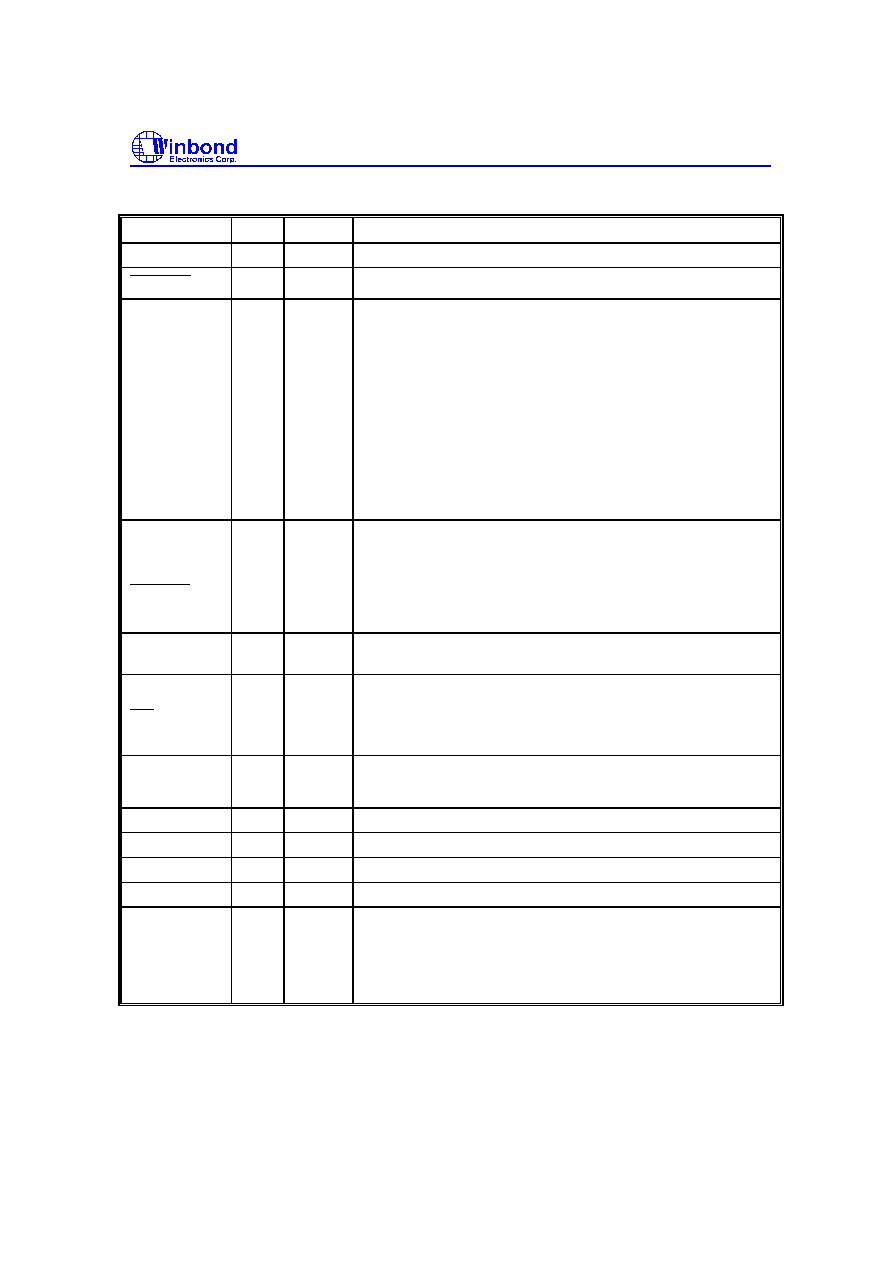
W83877ATF
Publication Release Date: April 1998
- 6 -
Version 0.51
1.1 Host Interface, continued
SYMBOL
PIN
I/O
FUNCTION
DRQ_C
4
OUT
12t
DMA request signal C.
DACK_ C
18
IN
ts
DMA acknowledge signal C.
IRQIN
93
IN
ts
Interrupt request input.
DRQ_D
OUT
12t
DMA request signal D.
IRSL2
OUT
12t
IR module mode selection 2.
IRRXH/IRSL0
I/O
12ts
When input, acts as a function of high speed IR receiving
terminal. When output selected, acts as a IR module mode
selection 0.
PNF
IN
ts
Detects printer is active, and not external FDC. When this pin
PNF is detected to 1 signal, the device is switched to parallel
printer. When this pin PNF is detected to 0 signal, the device is
switched to external FDC. The pin is configured in
CR16.bit7
(ENPNF)
.
IRRXH/IRSL0
3
I/O
12ts
When input pin, high speed IR received terminal. When output
pin, IR module mode select 0. Input or output are definied in
high speed IR register.
DACK_D
IN
ts
DMA acknowledge signal for channel D.
IRSL1
OUT
12t
IR module mode select 1.
TC
97
IN
ts
Terminal Count. When active, this pin indicates termination of
a DMA transfer.
IRQ_ A
96
OUT
12t
When CR16 Bit 5 (GOIQSEL) = 0: Interrupt request signal A.
SCI
OUT
12t
ACPI interrupt signal, selected by PnP IRQ configure register.
GIO1
I/O
12t
When CR16 Bit 4 (GOIQSEL) = 1: General Purpose I/O port 1.
IRQ_ B
92
OUT
12t
When CR16 Bit 4 (GOIQSEL) = 0: Interrupt request signal B.
GIO0
I/O
12t
When CR16 Bit 4 (GOIQSEL) = 1: General Purpose I/O port 0.
IRQ_C
44
OUT
12t
Interrupt request signal C.
IRQ_D
37
OUT
12t
Interrupt request signal D.
IRQ_E
23
OUT
12t
Interrupt request signal E.
IRQ_F
99
OUT
12t
Interrupt request signal F.
IRQ_G
1
OUT
12t
Interrupt request signal G.
DRQ_D
OUT
12t
DMA request signal channel D.
IRSL2
OUT
12t
IR module mode select 2.
PCICLK
IN
t
PCI clock input when the serial IRQ function is selected.
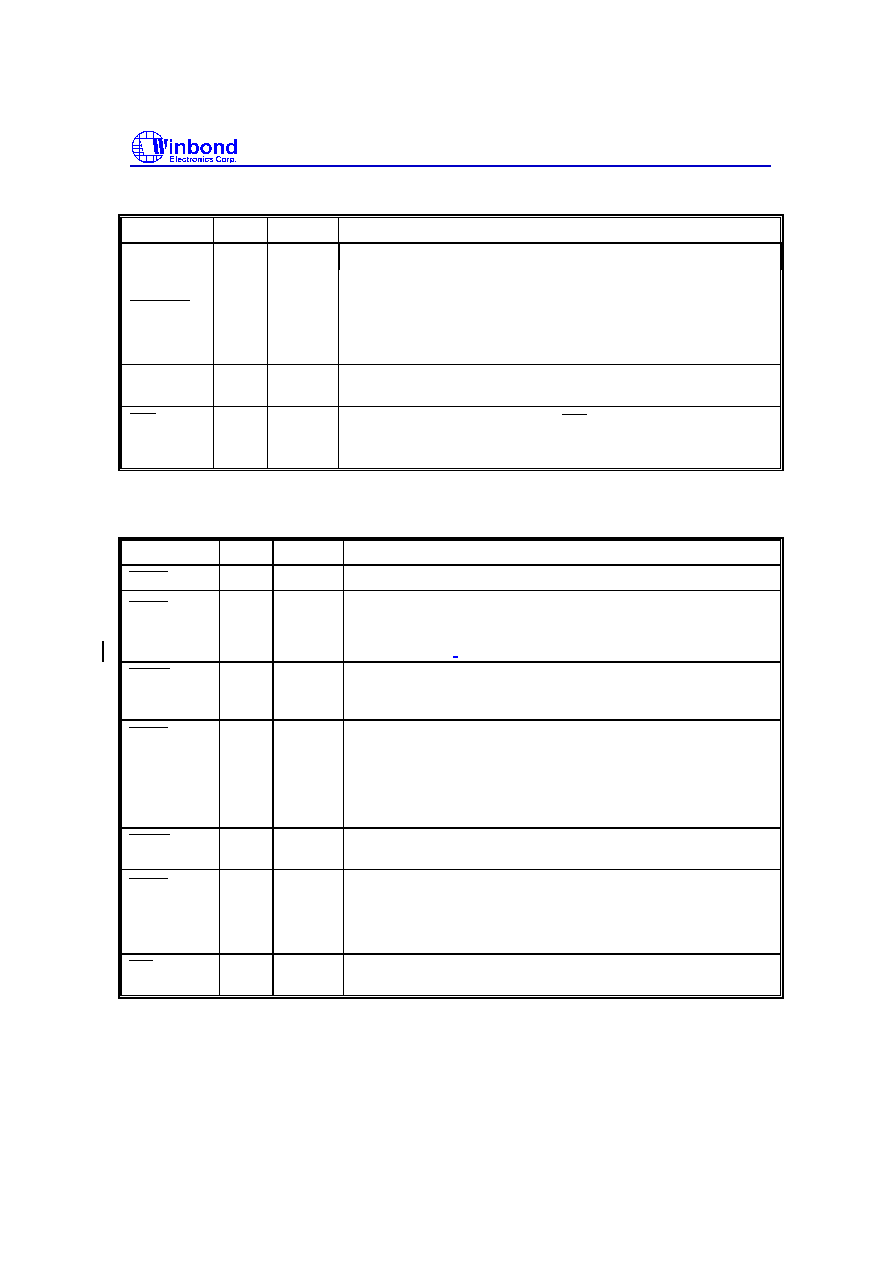
W83877ATF
Publication Release Date: April 1998
- 7 -
Version 0.51
1.1 Host Interface, continued
SYMBOL
PIN
I/O
FUNCTION
IRQ_H
91
OUT
12t
Interrupt request signal H.
IRSL2
OUT
12t
IR module mode selection 2.
DACK_D
IN
ts
DMA acknowledge signal D.
SERIRQ
OUT
12t
Serial Interrupt output, when the function of the serial IRQ is set
to logic 1 defined in the
CR31.bit2 (IRQMODS).
CLKIN
7
IN
t
24MHz/48MHZ clock input. CLKINSEL bit in CR2C register
should be correctly reset/set according to the input frequency.
SMI
8
OUT
12t
For the power management, the
SMI
is and active low by the
power management events, that generate an nSCI in ACPI
mode.
1.2 Serial Port Interface
SYMBOL
PIN
I/O
FUNCTION
CTSA
34
IN
t
Clear To Send is the modem control input.
CTSB
47
IN
t
Clear To Send is the modem control input.
A12
IN
t
System address bus bit 12, when 16-bit address decoder is
selected, that is
,
nEN16SA (
CR16.bit6
) is set to logic 0.
DSRA
33
IN
t
Data Set Ready. An active low indicates the modem or data set
is ready to establish a communication link and transfer data to
the UART.
DSRB
48
IN
t
Data Set Ready. An active low indicates the modem or data set
is ready to establish a communication link and transfer data to
the UART.
A13
IN
t
System address bus bit 13, when 16-bit address decoder is
selected.
DCDA
32
IN
t
Data Carrier Detect. An active low indicates the modem or data
set has detected a data carrier.
DCDB
49
IN
t
Data Carrier Detect. An active low indicates the modem or data
set has detected a data carrier.
A14
IN
t
System address bus bit 14, when 16-bit address decoder is
selected.
RIA
31
IN
t
Ring Indicator. An active low indicates that a ring signal is being
received by the modem or data set.
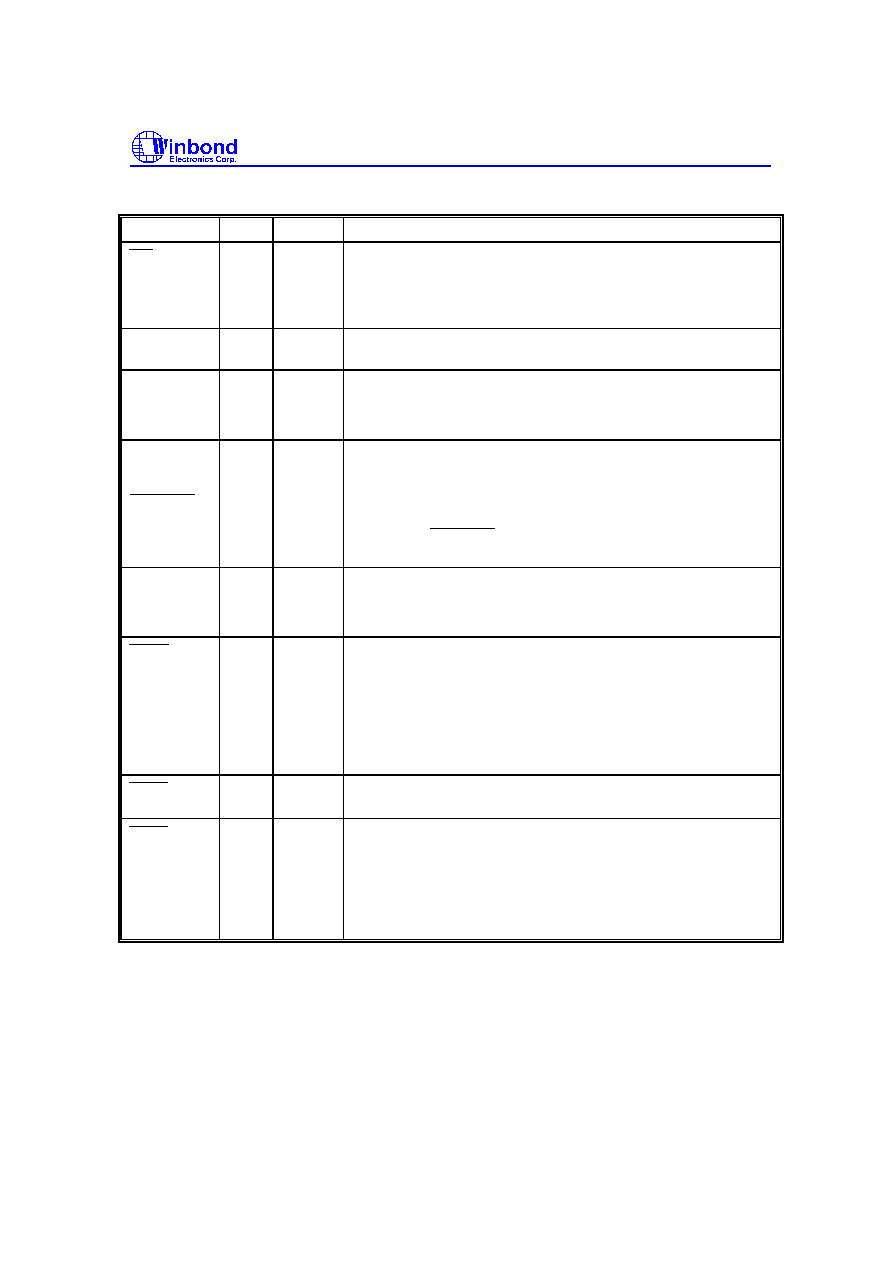
W83877ATF
Publication Release Date: April 1998
- 8 -
Version 0.51
1.2 Serial Port Interface, continued
SYMBOL
PIN
I/O
FUNCTION
RIB
50
IN
t
Ring Indicator. An active low indicates that a ring signal is being
received by the modem or data set.
A15
IN
t
System address bus bit 15, when 16-bit address decoder is
selected.
SINA
30
IN
t
Serial Input of COM A. Used to receive serial data from the
communication link.
SINB
42
IN
t
Serial Input of COM B. Used to receive serial data from the
communication link.
IRRX1
IN
t
When infrared function is selected, acts as infrared input.
SOUTA
38
I/O
8tc
UART A Serial Output. Used to transmit serial data out to the
communication link.
PEN16SA
IN
t
During power-on reset, this pin is pulled up internally and is
defined as PEN16SA, which provides the power-on value for
CR2E.bit6
(
PEN16SA
). A 4.7 k
is recommended when
intending to pull down at power-on reset.
SOUTB
43
I/O
12t
UART B Serial Output. Used to transmit serial data out to the
communication link.
IRTX1
IN
t
Infrared serial data output when COM B acts as infrared port.
DTRA
35
I/O
8tc
UART A Data Terminal Ready. An active low informs the
modem or data set that the controller is ready to communicate.
PHEFRAS
IN
t
During power-on reset, this pin is pulled down internally and is
defined as PHEFRAS, which provides the power-on value for
CR16 bit 0 (HEFRAS), and Configuration Port is defined at 250h.
A 4.7 k
is recommended when intending to pull up at power-on
reset, and Configuration Port is defined at 3F0h.
DTRB
46
I/O
8t
UART B Data Terminal Ready. An active low informs the
modem or data set that controller is ready to communicate.
RTSA
36
I/O
8tc
UART A Request To Send. An active low informs the modem or
data set that the controller is ready to send data.
PPNPCVS
IN
t
During power-on reset, this pin is pulled up internally and is
defined as PPNPCVS, which provides the power-on value for
CR16 bit 2 (PNPCVS). A 4.7 k
is recommended when
intending to pull down at power-on reset.
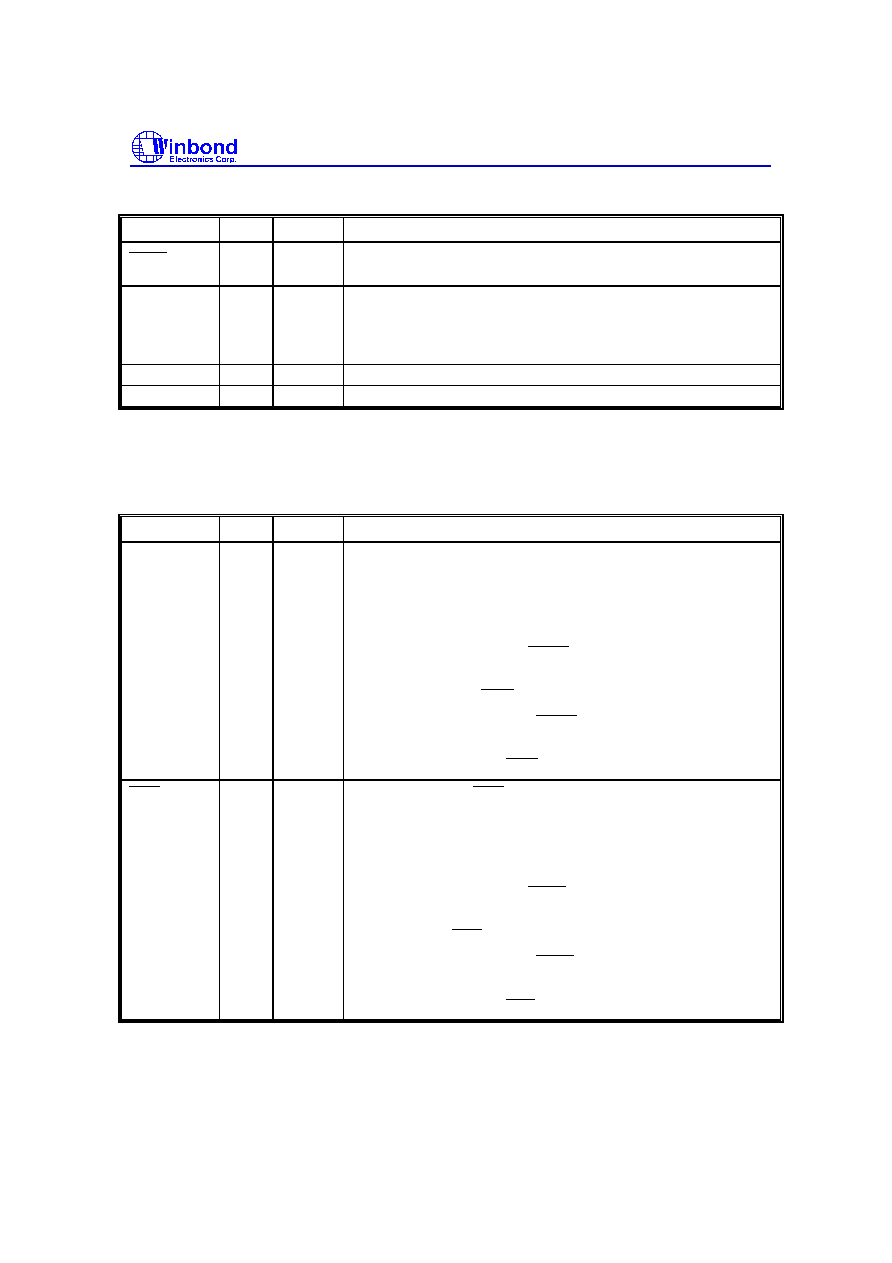
W83877ATF
Publication Release Date: April 1998
- 9 -
Version 0.51
1.2 Serial Port Interface, continued
SYMBOL
PIN
I/O
FUNCTION
RTSB
45
I/O
8tc
UART B Request To Send. An active low informs the modem or
data set that the controller is ready to send data.
PGOIQSEL
IN
t
During power-on reset, this pin is pulled down internally and is
defined as PGOIQSEL, which provides the power-on value for
CR16 bit 4 (GOIQSEL). A 4.7 k
is recommended when
intending to pull up at power-on reset.
IRTX2
95
OUT
12t
Function as a InfraRed transmission data line.
IRRX2
94
IN
t
Function as a InfraRed receiving line.
1.3 Multi-Mode Parallel Port
The following pins have eight functions, which are controlled by bits PRTMOD0, PRTMOD1, and
PRTMOD2 of CR0 and CR9 (refer to section 8.0, Extended Functions).
SYMBOL
PIN
I/O
FUNCTION
BUSY
24
IN
t
PRINTER MODE: BUSY
An active high input indicates that the printer is not ready to
receive data. This pin is pulled high internally. Refer to the
description of the parallel port for the definition of this pin in ECP
and EPP mode.
OD
12
EXTENSION FDD MODE: MOB2
This pin is for Extension FDD B; the function of this pin is the
same as that of the MOB pin.
OD
12
EXTENSION 2FDD MODE: MOB2
This pin is for Extension FDD A and B; the function of this pin is
the same as that of the MOB pin.
ACK
26
IN
t
PRINTER MODE: ACK
An active low input on this pin indicates that the printer has
received data and is ready to accept more data. This pin is
pulled high internally. Refer to the description of the parallel port
for the definition of this pin in ECP and EPP mode.
OD
12
EXTENSION FDD MODE: DSB2
This pin is for the Extension FDD B; its functions are the same
as those of the DSB pin.
OD
12
EXTENSION 2FDD MODE: DSB2
This pin is for Extension FDD A and B; the function of this pin is
the same as that of the DSB pin.
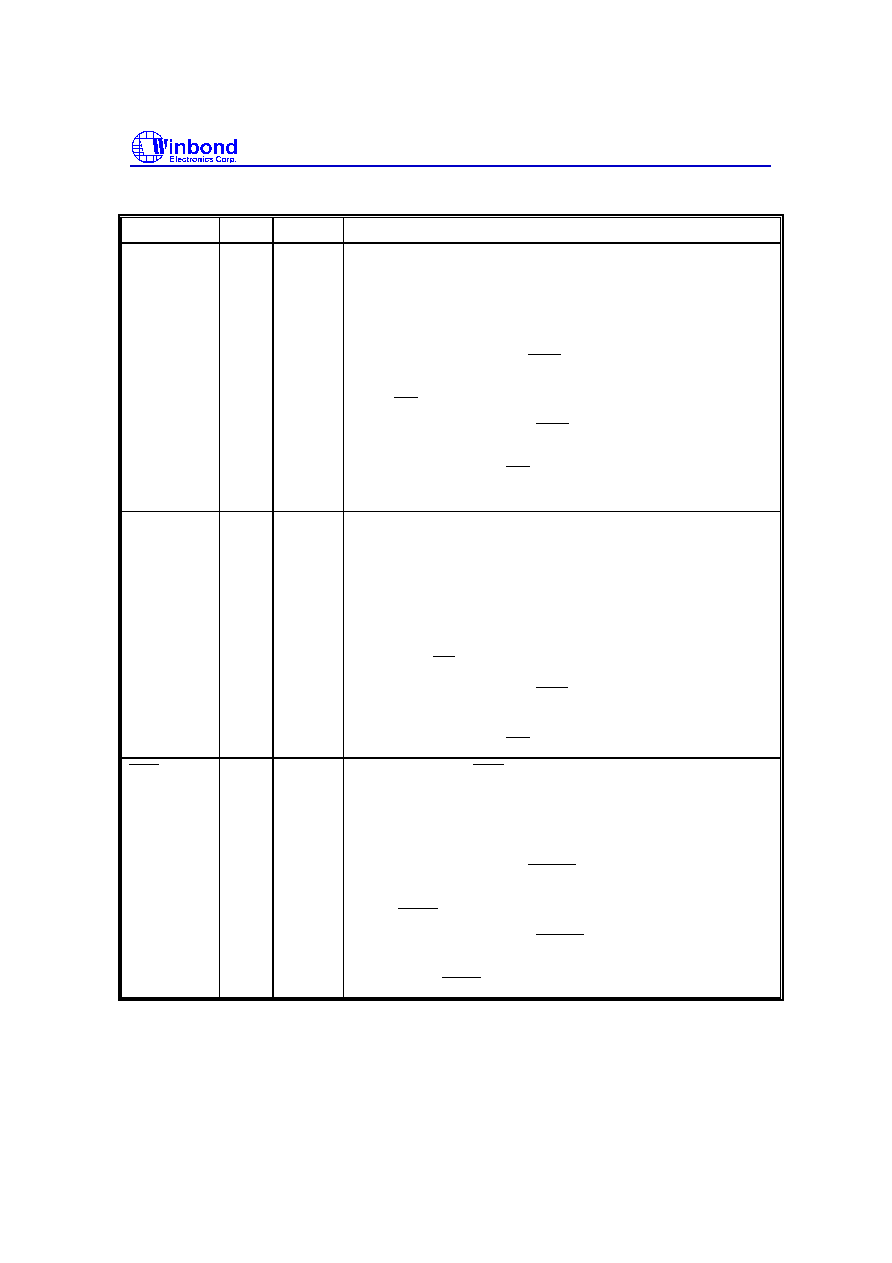
W83877ATF
Publication Release Date: April 1998
- 10 -
Version 0.51
1.3 Multi-Mode Parallel Port, continued
SYMBOL
PIN
I/O
FUNCTION
PE
27
IN
t
PRINTER MODE: PE
An active high input on this pin indicates that the printer has
detected the end of the paper. This pin is pulled high internally.
Refer to the description of the parallel port for the definition of
this pin in ECP and EPP mode.
OD
12
EXTENSION FDD MODE: WD2
This pin is for Extension FDD B; its function is the same as that
of the WD pin.
OD
12
EXTENSION 2FDD MODE: WD2
This pin is for Extension FDD A and B; the function of this pin is
the same as that of the WD pin.
JOYSTICK MODE: NC pin.
SLCT
28
IN
t
PRINTER MODE: SLCT
An active high input on this pin indicates that the printer is
selected. This pin is pulled high internally. Refer to the
description of the parallel port for the definition of this pin in ECP
and EPP mode.
OD
12
EXTENSION FDD MODE: WE2
This pin is for Extension FDD B; its functions are the same as
those of the
WE
pin.
OD
12
EXTENSION 2FDD MODE: WE2
This pin is for Extension FDD A and B; the function of this pin is
the same as that of the WE pin.
ERR
29
IN
t
PRINTER MODE: ERR
An active low input on this pin indicates that the printer has
encountered an error condition. This pin is pulled high internally.
Refer to the description of the parallel port for the definition of
this pin in ECP and EPP mode.
OD
12
EXTENSION FDD MODE: HEAD2
This pin is for Extension FDD B; its function is the same as that
of the HEADpin.
OD
12
EXTENSION 2FDD MODE: HEAD2
This pin is for Extension FDD A and B; its function is the same
as that of the HEAD pin.
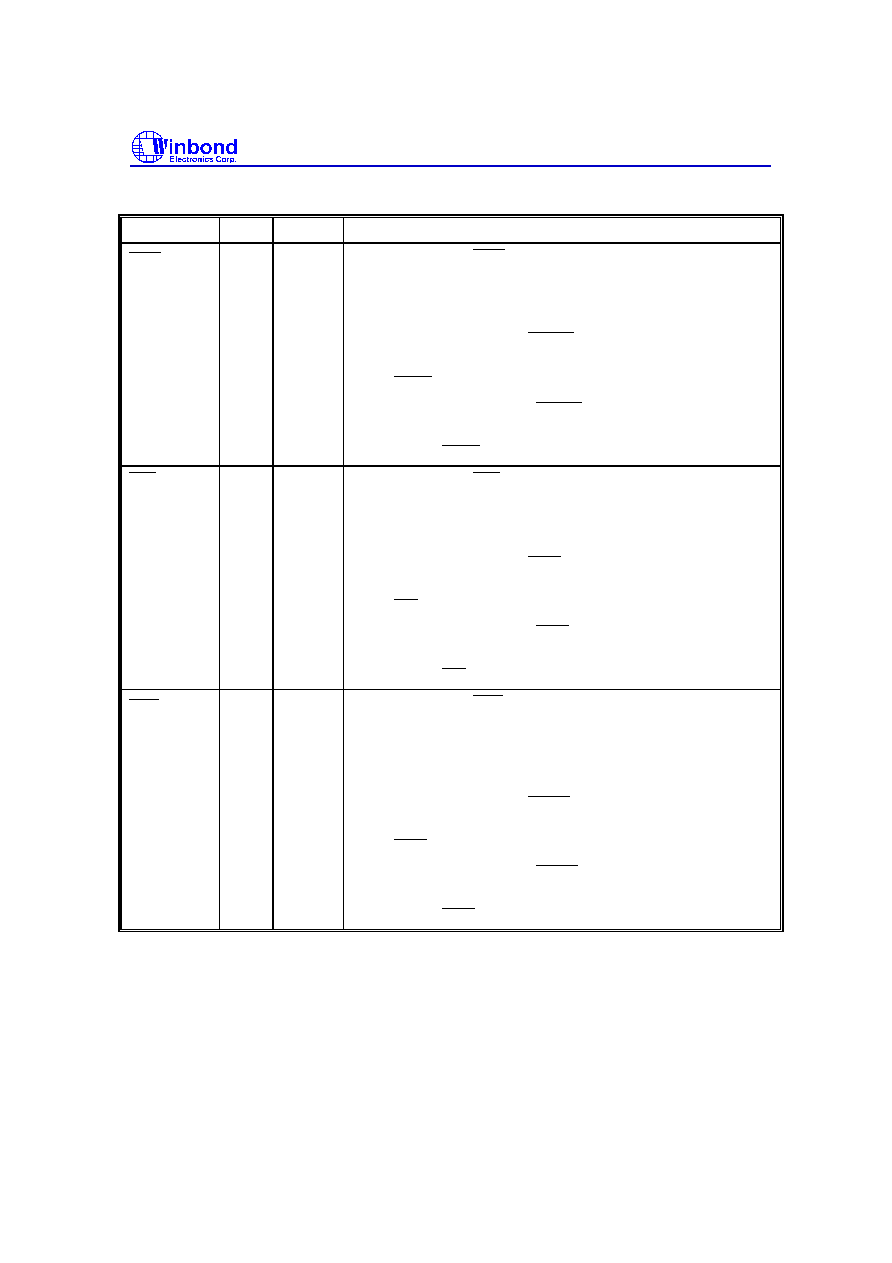
W83877ATF
Publication Release Date: April 1998
- 11 -
Version 0.51
1.3 Multi-Mode Parallel Port, continued
SYMBOL
PIN
I/O
FUNCTION
SLIN
22
OD
12
PRINTER MODE: SLIN
Output line for detection of printer selection. This pin is pulled
high internally. Refer to the description of the parallel port for the
definition of this pin in ECP and EPP mode.
OD
12
EXTENSION FDD MODE: STEP2
This pin is for Extension FDD B; its function is the same as that
of the STEP pin.
OD
12
EXTENSION 2FDD MODE: STEP2
This pin is for Extension FDD A and B; its function is the same
as that of the STEP pin .
INIT
21
OD
12
PRINTER MODE: INIT
Output line for the printer initialization. This pin is pulled high
internally. Refer to the description of the parallel port for the
definition of this pin in ECP and EPP mode.
OD
12
EXTENSION FDD MODE: DIR2
This pin is for Extension FDD B; its function is the same as that
of the DIR pin.
OD
12
EXTENSION 2FDD MODE: DIR2
This pin is for Extension FDD A and B; its function is the same
as that of the DIR pin.
AFD
20
OD
12
PRINTER MODE: AFD
An active low output from this pin causes the printer to auto feed
a line after a line is printed. This pin is pulled high internally.
Refer to the description of the parallel port for the definition of
this pin in ECP and EPP mode.
OD
12
EXTENSION FDD MODE: RWC2
This pin is for Extension FDD B; its function is the same as that
of the RWC pin.
OD
12
EXTENSION 2FDD MODE: RWC2
This pin is for Extension FDD A and B; its function is the same
as that of the RWC pin.
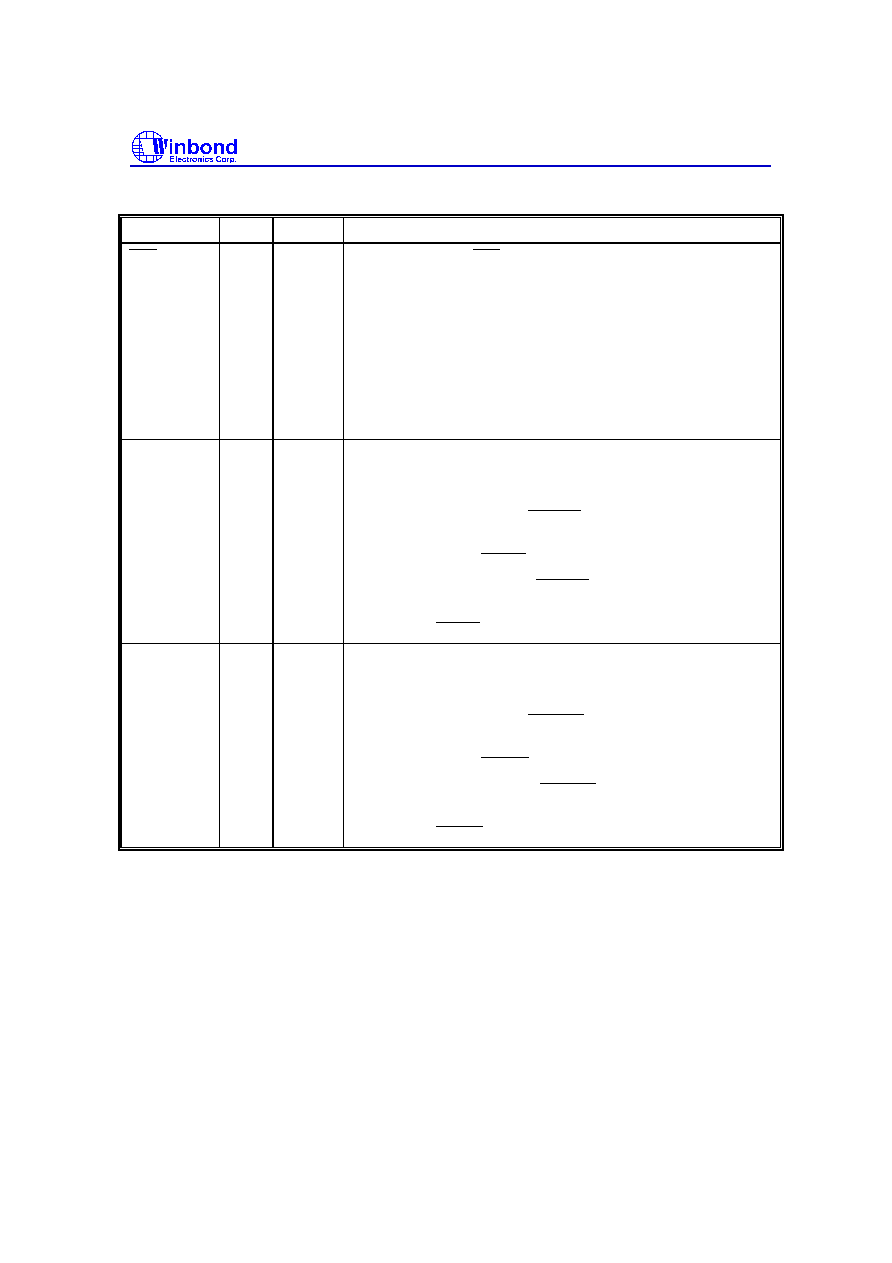
W83877ATF
Publication Release Date: April 1998
- 12 -
Version 0.51
1.3 Multi-Mode Parallel Port, continued
SYMBOL
PIN
I/O
FUNCTION
STB
19
OD
12
PRINTER MODE:
STB
An active low output is used to latch the parallel data into the
printer. This pin is pulled high internally. Refer to the description
of the parallel port for the definition of this pin in ECP and EPP
mode.
-
EXTENSION FDD MODE: No Connection
This pin is a tri-state output.
-
EXTENSION 2FDD MODE: No Connection
This pin is a tri-state output.
PD0
9
I/O
24t
PRINTER MODE: PD0
Parallel port data bus bit 0. Refer to the description of the
parallel port for the definition of this pin in ECP and EPP mode.
IN
t
EXTENSION FDD MODE: INDEX2
This pin is for Extension FDD B; the function of this pin is the
same as that of the INDEX pin. This pin is pulled high internally.
IN
t
EXTENSION 2FDD MODE: INDEX2
This pin is for Extension FDD A and B; the function of this pin is
the same as INDEX pin. This pin is pulled high internally.
PD1
10
I/O
24t
PRINTER MODE: PD1
Parallel port data bus bit 1. Refer to the description of the
parallel port for the definition of this pin in ECP and EPP mode.
IN
t
EXTENSION FDD MODE: TRAK02
This pin is for Extension FDD B; the function of this pin is the
same as that of the TRAK0 pin. This pin is pulled high internally.
IN
t
EXTENSION. 2FDD MODE: TRAK02
This pin is for Extension FDD A and B; the function of this pin is
the same as TRAK0 pin. This pin is pulled high internally.

W83877ATF
Publication Release Date: April 1998
- 13 -
Version 0.51
1.3 Multi-Mode Parallel Port, continued
SYMBOL
PIN
I/O
FUNCTION
PD2
11
I/O
24t
PRINTER MODE: PD2
Parallel port data bus bit 2. Refer to the description of the
parallel port for the definition of this pin in ECP and EPP mode.
IN
t
EXTENSION FDD MODE: WP2
This pin is for Extension FDD B; the function of this pin is the
same as that of the
WP
pin. This pin is pulled high internally.
IN
t
EXTENSION. 2FDD MODE: WP2
This pin is for Extension FDD A and B; the function of this pin is
the same as that of the WP pin. This pin is pulled high
internally.
PD3
12
I/O
24t
PRINTER MODE: PD3
Parallel port data bus bit 3. Refer to the description of the
parallel port for the definition of this pin in ECP and EPP mode.
IN
t
EXTENSION FDD MODE: RDATA2
Motor on B for Extension FDD B; the function of this pin is the
same as that of the RDATA pin. This pin is pulled high internally.
IN
t
EXTENSION 2FDD MODE: RDATA2
This pin is for Extension FDD A and B; the function of this pin is
the same as that of the RDATA pin. This pin is pulled high
internally.
PD4
13
I/O
24t
PRINTER MODE: PD4
Parallel port data bus bit 4. Refer to the description of the
parallel port for the definition of this pin in ECP and EPP mode.
IN
t
EXTENSION FDD MODE: DSKCHG2
Drive select B for Extension FDD B; the function of this pin is the
same as that of DSKCHG pin. This pin is pulled high internally.
IN
t
EXTENSION 2FDD MODE: DSKCHG2
This pin is for Extension FDD A and B; the function of this pin is
the same as that of the
DSKCHG
pin. This pin is pulled high
internally.
PD5
14
I/O
24t
PRINTER MODE: PD5
Parallel port data bus bit 5. Refer to the description of the
parallel port for the definition of this pin in ECP and EPP mode.
-
EXTENSION FDD MODE: No Connection
This pin is a tri-state output.
-
EXTENSION 2FDD MODE: No Connection
This pin is a tri-state output.
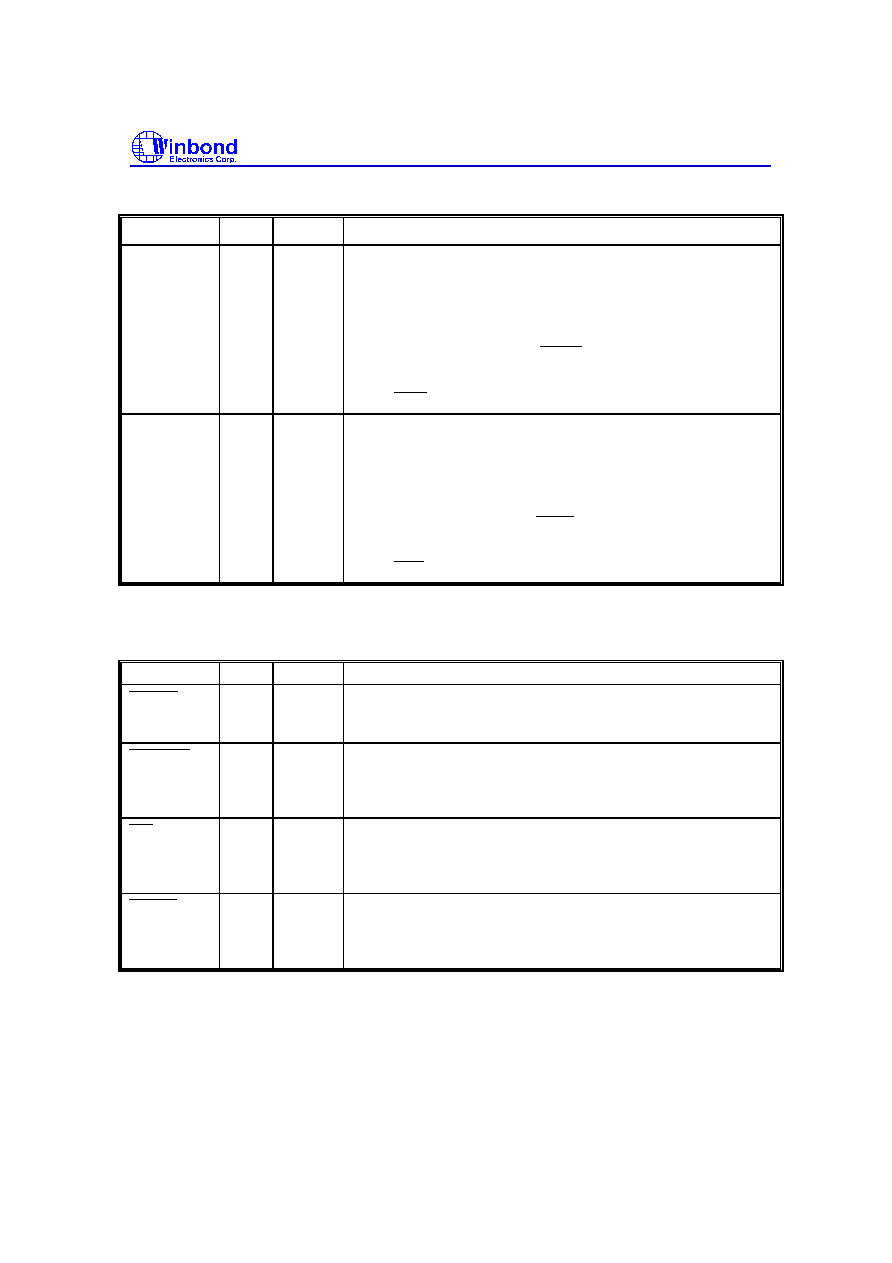
W83877ATF
Publication Release Date: April 1998
- 14 -
Version 0.51
1.3 Multi-Mode Parallel Port, continued
SYMBOL
PIN
I/O
FUNCTION
PD6
16
I/O
24t
PRINTER MODE: PD6
Parallel port data bus bit 6. Refer to the description of the
parallel port for the definition of this pin in ECP and EPP mode.
-
EXTENSION FDD MODE:This pin is a tri-state output.
IOD
24
EXTENSION. 2FDD MODE: MOA2
This pin is for Extension FDD A; its function is the same as that
of the MOA pin.
PD7
17
I/O
24t
PRINTER MODE: PD7
Parallel port data bus bit 7. Refer to the description of the
parallel port for the definition of this pin in ECP and EPP mode.
-
EXTENSION FDD MODE: This pin is a tri-state output.
OD
24
EXTENSION 2FDD MODE: DSA2
This pin is for Extension FDD A; its function is the same as that
of the DSA pin.
1.4 FDC Interface
SYMBOL
PIN
I/O
FUNCTION
RDATA
74
IN
cs
The read data input signal from the FDD. This input pin is pulled
up internally by an approximately 1K ohm resistor. The resistor
can be disabled by bit 4 of CR6 (FIPURDWN).
DSKCHG
76
IN
cs
Diskette change. This signal is active low at power on and
whenever the diskette is removed. This input pin is pulled up
internally by an approximately 1K ohm resistor. The resistor can
be disabled by bit 4 of CR6 (FIPURDWN).
WP
77
IN
cs
Write protected. This active low schmitt input from the disk drive
indicates that the diskette is write-protected. This input pin is
pulled up internally by an approximately 1K ohm resistor. The
resistor can be disabled by bit 4 of CR6 (FIPURDWN).
TRAK0
78
IN
cs
Track 0. This schmitt input from the disk drive is active low when
the head is positioned over the outermost track. This input pin is
pulled up internally by an approximately 1K ohm resistor. The
resistor can be disabled by bit 4 of CR6 (FIPURDWN).

W83877ATF
Publication Release Date: April 1998
- 15 -
Version 0.51
1.4 FDC interface, continued
SYMBOL
PIN
I/O
FUNCTION
INDEX
81
IN
cs
This schmitt input from the disk drive is active low when the head
is positioned over the beginning of a track marked by an index
hole. This input pin is pulled up internally by an approximately 1K
ohm resistor. The resistor can be disabled by bit 4 of CR6
(FIPURDWN).
MOA
79
OD
24
Motor A On. When set to 0, this pin enables disk drive 0. This is
an open drain output.
MOB
80
OD
24
Motor B On. When set to 0, this pin enables disk drive 1. This is
an open drain output.
STEP
82
OD
24
Step output pulses. This active low open drain output produces a
pulse to move the head to another track.
DSA
83
OD
24
Drive Select A. When set to 0, this pin enables disk drive A. This
is an open drain output.
DSB
84
OD
24
Drive Select B. When set to 0, this pin enables disk drive B. This
is an open drain output.
WE
85
OD
24
Write enable. An open drain output.
WD
86
OD
24
Write data. This logic low open drain writes precompensation
serial data to the selected FDD. An open drain output.
RWC
87
OD
24
Reduced write current. This signal can be used on two-speed disk
drives to select the transfer rate. An open drain output.
Logic 0 = 250 Kb/s
Logic 1 = 500 Kb/s
When bit 5 of CR9 (EN3MODE) is set to high, the three-mode
FDD function is enabled, and the pin will have a different
definition. Refer to the EN3MODE bit in CR9.
HEAD
88
OD
24
Head select. This open drain output determines which disk drive
head is active.
Logic 1 = side 0
Logic 0 = side 1
DIR
89
OD
24
Direction of the head step motor. An open drain output.
Logic 1 = outward motion
Logic 0 = inward motion
V
DD
15,
56
+5 power supply for the digital circuitry
GND
25,
40
65,
90
Ground
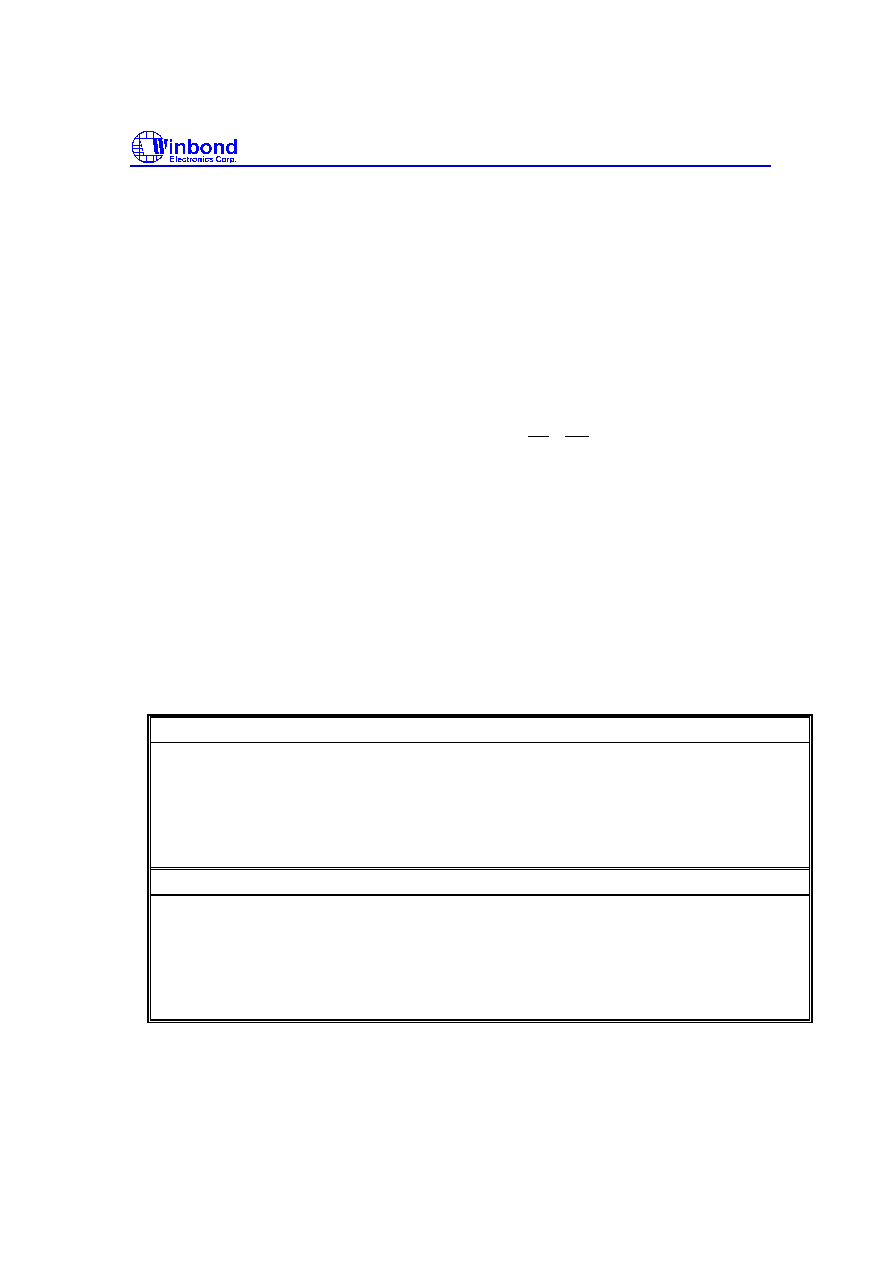
W83877ATF
Publication Release Date: April 1998
- 16 -
Version 0.51
2.0 FDC FUNCTIONAL DESCRIPTION
2.1 W83877ATF FDC
The floppy disk controller of the W83877ATF integrates all of the logic required for floppy disk
control. The FDC implements a PC/AT or PS/2 solution. All programmable options default to
compatible values. The FIFO provides better system performance in multi-master systems. The
digital data separator supports up to data rate 1 M bits/sec or 2 M bits/sec.
The FDC includes the following blocks: AT interface, Precompensation, Data Rate Selection, Digital
Data Separator, FIFO, and FDC Core.
2.1.1 AT interface
The interface consists of the standard asynchronous signals: RD , WR , A0-A3, IRQ, DMA control,
and a data bus. The address lines select between the configuration registers, the FIFO and
control/status registers. This interface can be switched between PC/AT, Model 30, or PS/2 normal
modes. The PS/2 register sets are a superset of the registers found in a PC/AT.
2.1.2 FIFO (Data)
The FIFO is 16 bytes in size and has programmable threshold values. All command parameter
information and disk data transfers go through the FIFO. Data transfers are governed by the RQM
and DIO bits in the Main Status Register.
The FIFO defaults to disabled mode after any form of reset. This maintains PC/AT hardware
compatibility. The default values can be changed through the CONFIGURE command. The
advantage of the FIFO is that it allows the system a larger DMA latency without causing disk errors.
The following tables give several examples of the delays with a FIFO. The data are based upon the
following formula:
THRESHOLD
�
(1/Data Rate) *8 - 1.5
�
S = DELAY
FIFO THRESHOLD
MAXIMUM DELAY TO SERVICING AT 500K BPS
Data Rate
1 Byte
1
�
16
�
S - 1.5
�
S = 14.5
�
S
2 Byte
2
�
16
�
S - 1.5
�
S = 30.5
�
S
8 Byte
8
�
16
�
S - 1.5
�
S = 6.5
�
S
15 Byte
15
�
16
�
S - 1.5
�
S = 238.5
�
S
FIFO THRESHOLD
MAXIMUM DELAY TO SERVICING AT 1M BPS
Data Rate
1 Byte
1
�
8
�
S - 1.5
�
S = 6.5
�
S
2 Byte
2
�
8
�
S - 1.5
�
S = 14.5
�
S
8 Byte
8
�
8
�
S - 1.5
�
S = 62.5
�
S
15 Byte
15
�
8
�
S - 1.5
�
S = 118.5
�
S

W83877ATF
Publication Release Date: April 1998
- 17 -
Version 0.51
At the start of a command the FIFO is always disabled
,
and command parameters must be sent
based upon the RQM and DIO bit settings in the main status register. When the FDC enters the
command execution phase,
it clears the FIFO of any data to ensure that invalid data are not
transferred.
An overrun and underrun will terminate the current command and the data transfer. Disk writes will
complete the current sector by generating a 00 pattern and valid CRC. Reads require the host to
remove the remaining data so that the result phase may be entered.
DMA transfers are enabled with the SPECIFY command and are initiated by the FDC by activating
the DRQ pin during a data transfer command. The FIFO is enabled directly by asserting DACK
,
and
addresses need not be valid.
Note that if the DMA controller is programmed to function in verify mode
,
a pseudo read is performed
by the FDC based only on DACK . This mode is only available when the FDC has been configured
into byte mode (FIFO disabled) and is programmed to do a read. With the FIFO enabled the above
operation is performed by using the new VERIFY command. No DMA operation is needed.
�@
2.1.3 Data Separator
The function of the data separator is to lock onto the incoming serial read data. When a lock is
achieved the serial front end logic of the chip is provided with a clock which is synchronized to the
read data. The synchronized clock, called the Data Window, is used to internally sample the serial
data portion of the bit cell, and the alternate state samples the clock portion. Serial to parallel
conversion logic separates the read data into clock and data bytes.
The Digital Data Separator (DDS) has three parts: control logic, error adjustment, and speed tracking.
The DDS circuit cycles once every 12 clock cycles ideally. Any data pulse input will be synchronized
and then adjusted by immediate error adjustment. The control logic will generate RDD and RWD for
every pulse input. During any cycle where no data pulse is present, the DDS cycles are based on
speed. A digital integrator is used to keep track of the speed changes in the input data stream.
2.1.4 Write Precompensation
The write precompensation logic is used to minimize bit shifts in the RDDATA stream from the disk
drive. Shifting of bits is a known phenomenon in magnetic media and is dependent on the disk media
and the floppy drive.
The FDC monitors the bit stream that is being sent to the drive. The data patterns that require
precompensation are well known. Depending upon the pattern, the bit is shifted either early or late
relative to the surrounding bits.
2.1.5 Perpendicular Recording Mode
The FDC is also capable of interfacing directly to perpendicular recording floppy drives. Perpendicular
recording differs from the traditional longitudinal method in that the magnetic bits are oriented
vertically. This scheme packs more data bits into the same area.
FDCs with perpendicular recording drives can read standard 3.5" floppy disks
,
and can also read and
write perpendicular media. Some manufacturers offer drives that can read and write standard and
perpendicular media in a perpendicular media drive.
A single command puts the FDC into perpendicular mode. All other commands operate as they do
normally. The perpendicular mode requires a 1 Mbps data rate for the FDC. At this data rate the FIFO
eases the host interface bottleneck due to the speed of data transfer to or from the disk.

W83877ATF
Publication Release Date: April 1998
- 18 -
Version 0.51
2.1.6 Tape Drive
The W83877ATF supports standard tape drives (1 Mbps, 500 Kbps, 250 Kbps) and new fast tape
drive (2M bps).
2.1.7 FDC Core
The W83877ATF FDC is capable of performing twenty commands. Each command is initiated by a
multi-byte transfer from the microprocessor. The result can also be a multi-byte transfer back to the
microprocessor. Each command consists of three phases: command, execution, and result.
Command
The microprocessor issues all required information to the controller to perform a specific operation.
Execution
The controller performs the specified operation.
Result
After the operation is completed, status information and other housekeeping information is provided
to the microprocessor.
2.1.8 FDC Commands
Command Symbol Descriptions:
C:
Cylinder number 0 - 256
D:
Data Pattern
DIR:
Step Direction
DIR = 0, step out
DIR = 1, step in
DS0:
Disk Drive Select 0
DS1:
Disk Drive Select 1
DTL:
Data Length
EC:
Enable Count
EOT:
End of Track
EFIFO:
Enable FIFO
EIS:
Enable Implied Seek
EOT:
End of track
FIFOTHR:
FIFO Threshold
GAP:
Gap length selection
GPL:
Gap Length
H:
Head number
HDS:
Head number select
HLT:
Head Load Time
HUT:
Head Unload Time
LOCK:
Lock EFIFO, FIFOTHR, PTRTRK bits prevent affected by software reset
MFM:
MFM or FM Mode
MT:
Multitrack
N:
The number of data bytes written in a sector
NCN:
New Cylinder Number
ND:
Non-DMA Mode
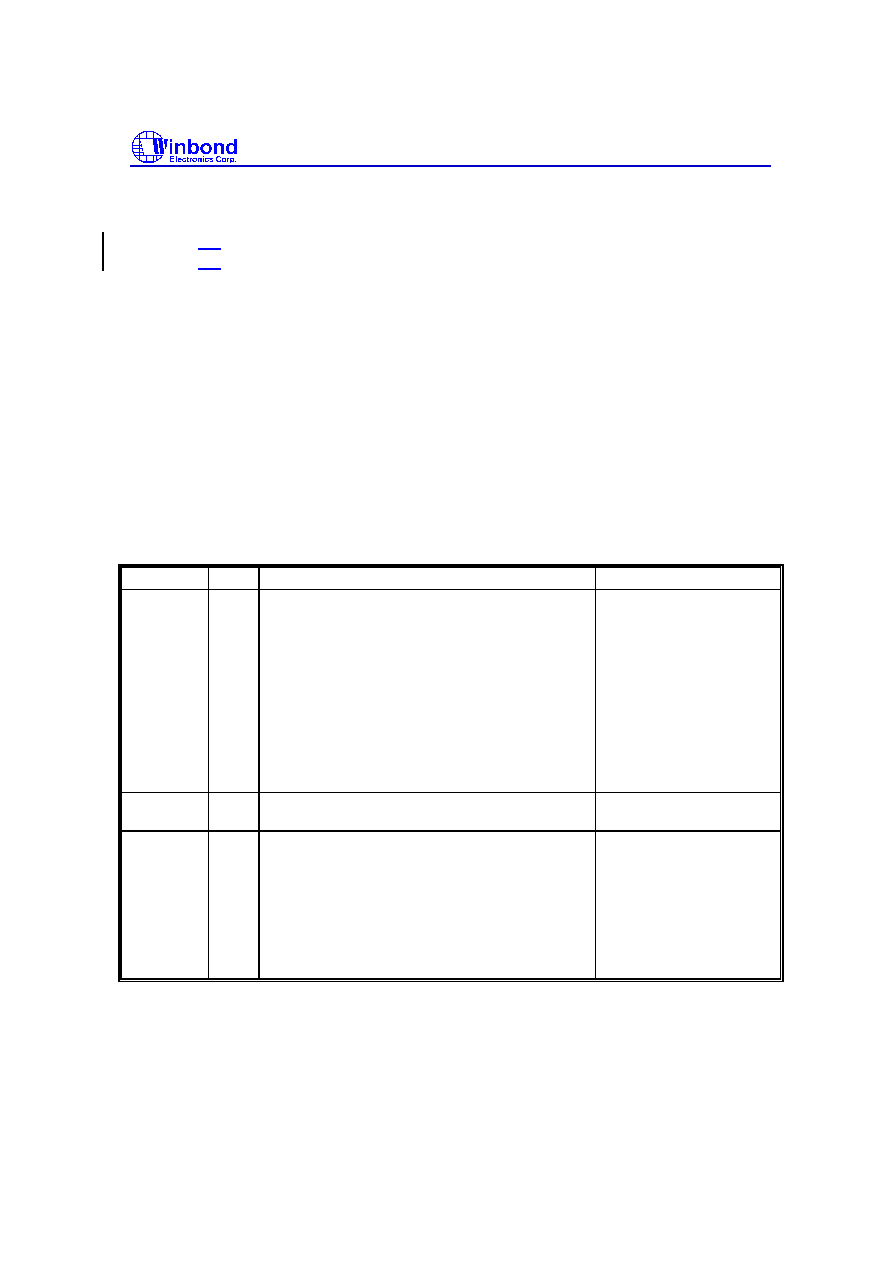
W83877ATF
Publication Release Date: April 1998
- 19 -
Version 0.51
OW:
Overwritten
PCN:
Present Cylinder Number
POLL:
Polling Disable
PRETRK:
Precompensation Start Track Number
R:
Record
RCN:
Relative Cylinder Number
R/W:
Read/Write
SC:
Sector/per cylinder
SK:
Skip deleted data address mark
SRT:
Step Rate Time
ST0:
Status Register 0
ST1:
Status Register 1
ST2:
Status Register 2
ST3:
Status Register 3
WG:
Write gate alters timing of WE
2.1.9 FDC Instruction Sets
(1) Read Data
PHASE
R/W
D7
D6
D5
D4
D3
D2
D1
D0
REMARKS
Command
W
MT
MFM
SK
0
0
1
1
0
Command codes
W
0
0
0
0
0
HDS
DS1
DS0
W
W
---------------------- C ------------------------
---------------------- H ------------------------
Sector ID information
prior to command
execution
W
W
---------------------- R ------------------------
---------------------- N ------------------------
W
W
-------------------- EOT -----------------------
-------------------- GPL -----------------------
W
-------------------- DTL -----------------------
Execution
Data transfer between the
FDD and system
Result
R
R
R
-------------------- ST0 -----------------------
-------------------- ST1 -----------------------
-------------------- ST2 -----------------------
Status information after
command execution
R
R
R
R
---------------------- C ------------------------
---------------------- H ------------------------
---------------------- R ------------------------
---------------------- N ------------------------
Sector ID information
after command execution

W83877ATF
Publication Release Date: April 1998
- 20 -
Version 0.51
(2) Read Deleted Data
PHASE
R/W
D7
D6
D5
D4
D3
D2
D1
D0
REMARKS
Command
W
MT
MFM
SK
0
1
1
0
0
Command codes
W
0
0
0
0
0
HDS
DS1
DS
0
W
W
---------------------- C ------------------------
---------------------- H ------------------------
Sector ID information prior
to command execution
W
W
---------------------- R ------------------------
---------------------- N ------------------------
W
W
-------------------- EOT -----------------------
-------------------- GPL -----------------------
W
-------------------- DTL -----------------------
Execution
Data transfer between the
FDD and system
Result
R
R
R
-------------------- ST0 -----------------------
-------------------- ST1 -----------------------
-------------------- ST2 -----------------------
Status information after
command execution
R
R
R
R
---------------------- C ------------------------
---------------------- H ------------------------
---------------------- R ------------------------
---------------------- N ------------------------
Sector ID information after
command execution

W83877ATF
Publication Release Date: April 1998
- 21 -
Version 0.51
(3) Read A Track
PHASE
R/W
D7
D6
D5
D4
D3
D2
D1
D0
REMARKS
Command
W
0
MFM
0
0
0
0
1
0
Command codes
W
0
0
0
0
0
HDS
DS1
DS0
W
W
---------------------- C ------------------------
---------------------- H ------------------------
Sector ID information prior
to command execution
W
W
---------------------- R ------------------------
---------------------- N ------------------------
W
W
-------------------- EOT -----------------------
-------------------- GPL -----------------------
W
-------------------- DTL -----------------------
Execution
Data transfer between the
FDD and system; FDD
reads contents of all
cylinders from index hole to
EOT
Result
R
R
R
-------------------- ST0 -----------------------
-------------------- ST1 -----------------------
-------------------- ST2 -----------------------
Status information after
command execution
R
R
R
R
---------------------- C ------------------------
---------------------- H ------------------------
---------------------- R ------------------------
---------------------- N ------------------------
Sector ID information after
command execution

W83877ATF
Publication Release Date: April 1998
- 22 -
Version 0.51
(4) Read ID
PHASE
R/W
D7
D6
D5
D4
D3
D2
D1
D0
REMARKS
Command
W
0
MFM
0
0
1
0
1
0
Command codes
W
0
0
0
0
0
HDS
DS1
DS0
Execution
The first correct ID
information on the cylinder
is stored in Data Register
Result
R
R
R
-------------------- ST0 -----------------------
-------------------- ST1 -----------------------
-------------------- ST2 -----------------------
Status information after
command execution
R
R
R
R
---------------------- C ------------------------
---------------------- H ------------------------
---------------------- R ------------------------
---------------------- N ------------------------
Disk status after the
command has been
completed
(5) Verify
PHASE
R/W
D7
D6
D5
D4
D3
D2
D1
D0
REMARKS
Command
W
MT
MFM
SK
1
0
1
1
0
Command codes
W
EC
0
0
0
0
HDS
DS1
DS0
W
W
---------------------- C ------------------------
---------------------- H ------------------------
Sector ID information prior
to command execution
W
W
---------------------- R ------------------------
---------------------- N ------------------------
W
W
-------------------- EOT -----------------------
-------------------- GPL -----------------------
-------------------- DTL/SC -------------------
Execution
No data transfer takes
place
Result
R
R
R
-------------------- ST0 -----------------------
-------------------- ST1 -----------------------
-------------------- ST2 -----------------------
Status information after
command execution
R
R
R
R
---------------------- C ------------------------
---------------------- H ------------------------
---------------------- R ------------------------
---------------------- N ------------------------
Sector ID information after
command execution

W83877ATF
Publication Release Date: April 1998
- 23 -
Version 0.51
(6) Version
PHASE
R/W
D7
D6
D5
D4
D3
D2
D1
D0
REMARKS
Command
W
0
0
0
1
0
0
0
0
Command codes
Result
W
1
0
0
1
0
0
0
0
Enhanced controller
(7) Write Data
PHASE
R/W
D7
D6
D5
D4
D3
D2
D1
D0
REMARKS
Command
W
MT
MFM
0
0
0
1
0
1
Command codes
W
0
0
0
0
0
HDS
DS1
DS0
W
W
---------------------- C ------------------------
---------------------- H ------------------------
Sector ID information
prior to Command
execution
W
W
---------------------- R ------------------------
---------------------- N ------------------------
W
W
-------------------- EOT -----------------------
-------------------- GPL -----------------------
W
-------------------- DTL -----------------------
Execution
Data transfer between the
FDD and system
Result
R
R
R
-------------------- ST0 -----------------------
-------------------- ST1 -----------------------
-------------------- ST2 -----------------------
Status information after
Command execution
R
R
R
R
---------------------- C ------------------------
---------------------- H ------------------------
---------------------- R ------------------------
---------------------- N ------------------------
Sector ID information
after Command execution

W83877ATF
Publication Release Date: April 1998
- 24 -
Version 0.51
(8) Write Deleted Data
PHASE
R/W
D7
D6
D5
D4
D3
D2
D1
D0
REMARKS
Command
W
MT
MFM
0
0
1
0
0
1
Command codes
W
0
0
0
0
0
HDS
DS1
DS0
W
W
---------------------- C ------------------------
---------------------- H ------------------------
Sector ID information prior
to command execution
W
W
---------------------- R ------------------------
---------------------- N ------------------------
W
W
W
-------------------- EOT -----------------------
-------------------- GPL -----------------------
-------------------- DTL -----------------------
Execution
Data transfer between the
FDD and system
Result
R
R
R
-------------------- ST0 -----------------------
-------------------- ST1 -----------------------
-------------------- ST2 -----------------------
Status information after
command execution
R
R
R
R
---------------------- C ------------------------
---------------------- H ------------------------
---------------------- R ------------------------
---------------------- N ------------------------
Sector ID information after
command execution
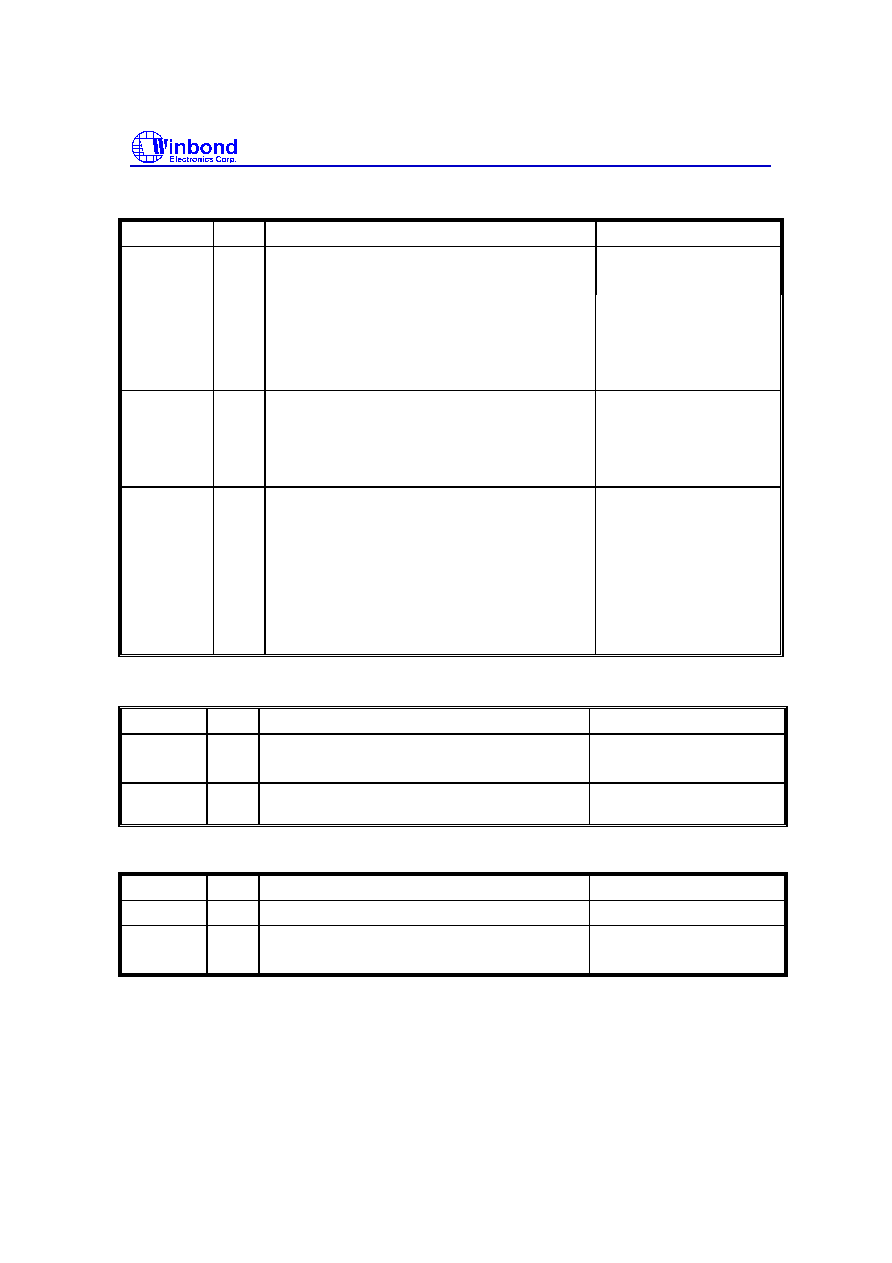
W83877ATF
Publication Release Date: April 1998
- 25 -
Version 0.51
(9) Format A Track
PHASE
R/W
D7
D6
D5
D4
D3
D2
D1
D0
REMARKS
Command
W
0
MFM
0
0
1
1
0
1
Command codes
W
0
0
0
0
0
HDS
DS1
DS0
W
W
---------------------- N ------------------------
--------------------- SC -----------------------
Bytes/Sector
Sectors/Cylinder
W
W
--------------------- GPL ---------------------
---------------------- D ------------------------
Gap 3
Filler Byte
Execution
for Each
Sector
Repeat:
W
W
W
W
---------------------- C ------------------------
---------------------- H ------------------------
---------------------- R ------------------------
---------------------- N ------------------------
Input Sector Parameters
Result
R
R
R
-------------------- ST0 -----------------------
-------------------- ST1 -----------------------
-------------------- ST2 -----------------------
Status information after
command execution
R
R
R
R
---------------- Undefined -------------------
---------------- Undefined -------------------
---------------- Undefined -------------------
---------------- Undefined -------------------
(10) Recalibrate
PHASE
R/W
D7
D6
D5
D4
D3
D2
D1
D0
REMARKS
Command
W
0
0
0
0
0
1
1
1
Command codes
W
0
0
0
0
0
0
DS1
DS0
Execution
Head retracted to Track 0
Interrupt
(11) Sense Interrupt Status
PHASE
R/W
D7
D6
D5
D4
D3
D2
D1
D0
REMARKS
Command
W
0
0
0
0
1
0
0
0
Command codes
Result
R
R
---------------- ST0 -------------------------
---------------- PCN -------------------------
Status information at the
end of each seek operation
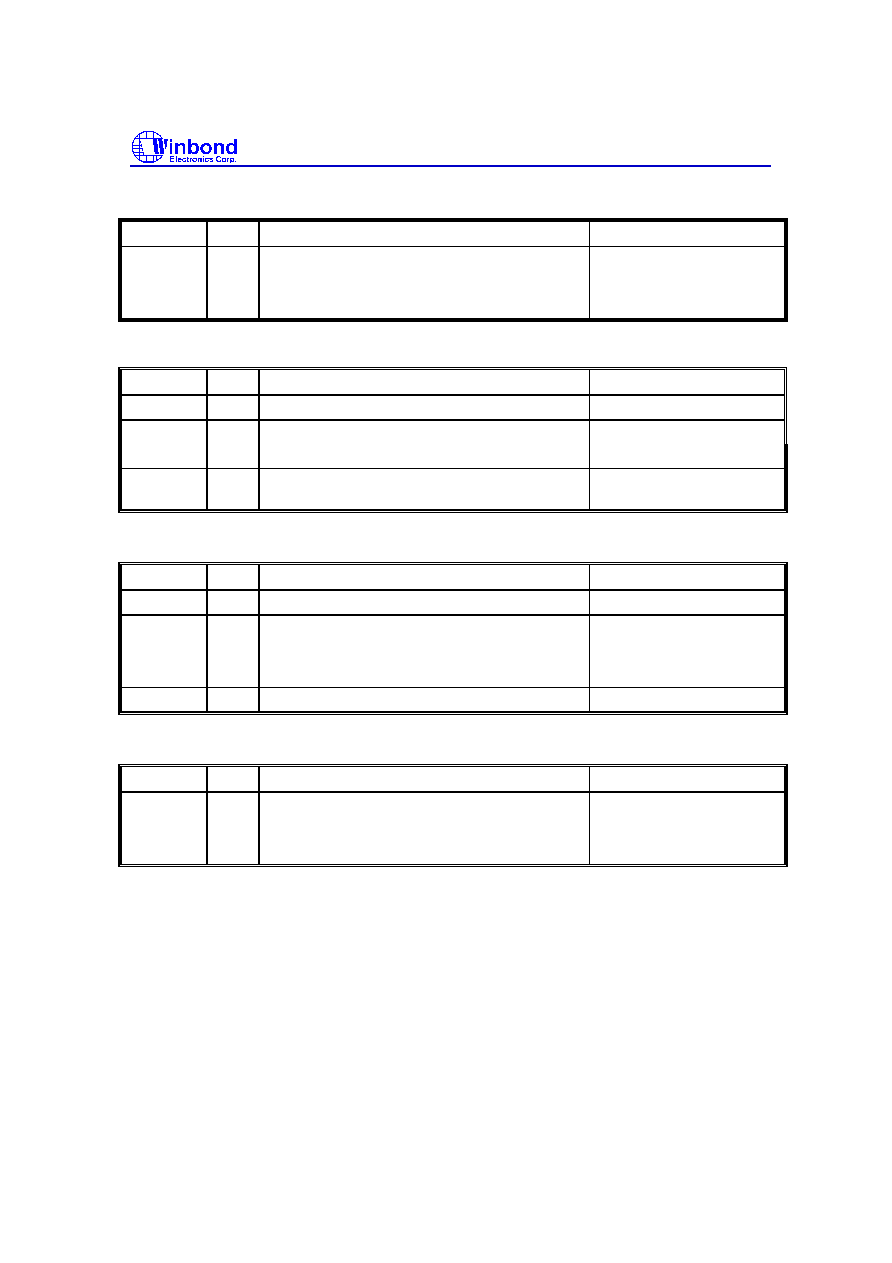
W83877ATF
Publication Release Date: April 1998
- 26 -
Version 0.51
(12) Specify
PHASE
R/W
D7
D6
D5
D4
D3
D2
D1
D0
REMARKS
Command
W
0
0
0
0
0
0
1
1
Command codes
W
W
| ---------SRT ----------- | --------- HUT ---------- |
|------------ HLT -----------------------------------| ND
(13) Seek
PHASE
R/W
D7
D6
D5
D4
D3
D2
D1
D0
REMARKS
Command
W
0
0
0
0
1
1
1
1
Command codes
W
0
0
0
0
0
HDS
DS1
DS0
W
-------------------- NCN -----------------------
Execution
R
Head positioned over
proper cylinder on diskette
(14) Configure
PHASE
R/W
D7
D6
D5
D4
D3
D2
D1
D0
REMARKS
Command
W
0
0
0
1
0
0
1
1
Configure information
W
0
0
0
0
0
0
0
0
W
W
0 EIS
EFIFO POLL
| ------ FIFOTHR ----|
| --------------------PRETRK ---------------------- |
Execution
Internal registers written
(15) Relative Seek
PHASE
R/W
D7
D6
D5
D4
D3
D2
D1
D0
REMARKS
Command
W
1
DIR
0
0
1
1
1
1
Command codes
W
0
0
0
0
0
HDS
DS1
DS0
W
| -------------------- RCN ---------------------------- |
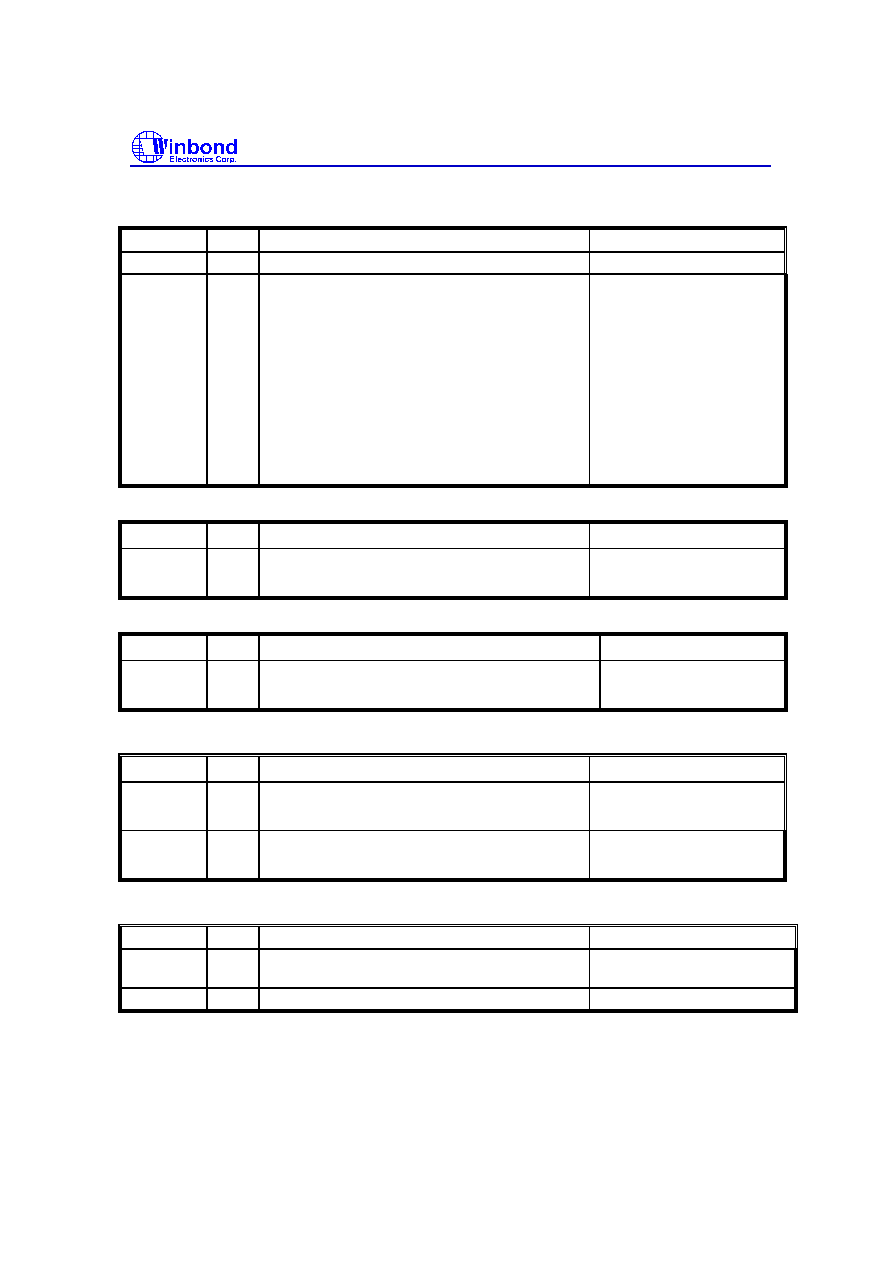
W83877ATF
Publication Release Date: April 1998
- 27 -
Version 0.51
(16) Dumpreg
PHASE
R/W
D7
D6
D5
D4
D3
D2
D1
D0
REMARKS
Command
W
0
0
0
0
1
1
1
0
Registers placed in FIFO
Result
R
R
R
R
R
R
R
R
R
R
-------------------- PCN-Drive 0-----------------
-------------------- PCN-Drive 1 ----------------
-------------------- PCN-Drive 2-----------------
-------------------- PCN-Drive 3 ----------------
-------- SRT ----------- | -------- HUT ----------
------------ HLT -------------------------------------| ND
-------------------- SC/EOT --------------------
LOCK 0 D3 D2 D1 D0 GAP WG
0 EIS EFIFO POLL| --- FIFOTHR ---- |
--------------------PRETRK ---------------------
(17) Perpendicular Mode
PHASE
R/W
D7
D6
D5
D4
D3
D2
D1
D0
REMARKS
Command
W
0
0
0
1
0
0
1
0
Command code
W
OW
0
D3
D2
D1
D0
GAP
WG
(18) Lock
PHASE
R/W
D7
D6
D5
D4
D3
D2
D1
D0
REMARKS
Command
W
LOCK
0
0
1
0
1
0
0
Command code
Result
R
0
0
0
LOCK
0
0
0
0
(19) Sense Drive Status
PHASE
R/W
D7
D6
D5
D4
D3
D2
D1
D0
REMARKS
Command
W
0
0
0
0
0
1
0
0
Command code
W
0
0
0
0
0
HDS
DS1
DS0
Result
R
---------------- ST3 -------------------------
Status information about
disk drive
(20) Invalid
PHASE
R/W
D7
D6
D5
D4
D3
D2
D1
D0
REMARKS
Command
W
------------- Invalid Codes -----------------
Invalid codes (no operation -
FDC goes into standby state)
Result
R
-------------------- ST0 ----------------------
ST0 = 80H

W83877ATF
Publication Release Date: April 1998
- 28 -
Version 0.51
2.2 Register Descriptions
There are several status, data, and control registers in W83877ATF. These registers are defined
below:
ADDRESS
REGISTER
OFFSET
READ
WRITE
base address + 0
base address + 1
base address + 2
base address + 3
SA REGISTER
SB REGISTER
TD REGISTER
DO REGISTER
TD REGISTER
base address + 4
MS REGISTER
DR REGISTER
base address + 5
DT (FIFO) REGISTER
DT (FIFO) REGISTER
base address + 7
DI REGISTER
CC REGISTER
2.2.1 Status Register A (SA Register) (Read base address + 0)
This register is used to monitor several disk interface pins in PS/2 and Model 30 modes. In PS/2
mode, the bit definitions for this register are as follows:
1
2
3
4
5
6
7
0
WP
INDEX
HEAD
TRAK0
STEP
DRV2
INIT PENDING
DIR
INIT PENDING (Bit 7):
This bit indicates the value of the floppy disk interrupt output.
DRV2 (Bit 6):
0
A second drive has been installed
1
A second drive has not been installed
STEP (Bit 5):
This bit indicates the complement of STEP output.
TRAK0 (Bit 4):
This bit indicates the value of TRAK0 input.
HEAD (Bit 3):
This bit indicates the complement of HEAD output.
0
side 0
1
side 1
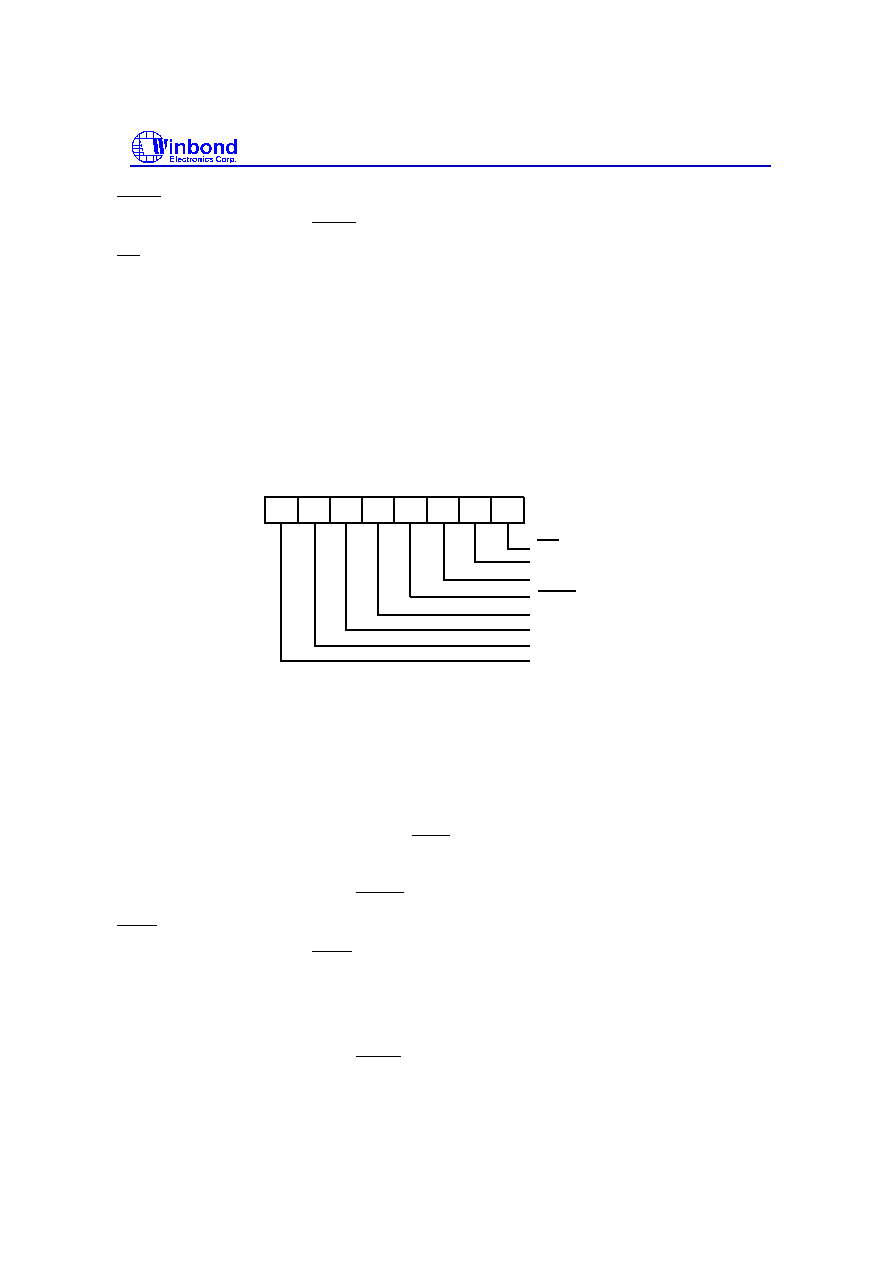
W83877ATF
Publication Release Date: April 1998
- 29 -
Version 0.51
INDEX (Bit 2):
This bit indicates the value of INDEX output.
WP (Bit 1):
0
disk is write-protected
1
disk is not write-protected
DIR (Bit 0)
This bit indicates the direction of head movement.
0
outward direction
1
inward direction
In PS/2 Model 30 mode, the bit definitions for this register are as follows:
1
2
3
4
5
6
7
0
WP
INDEX
HEAD
TRAK0
STEP F/F
DRQ
INIT PENDING
DIR
INIT PENDING (Bit 7):
This bit indicates the value of the floppy disk interrupt output.
DRQ (Bit 6):
This bit indicates the value of DRQ output pin.
STEP F/F (Bit 5):
This bit indicates the complement of latched STEP output.
TRAK0 (Bit 4):
This bit indicates the complement of TRAK0 input.
HEAD (Bit 3):
This bit indicates the value of HEAD output.
0
side 1
1
side 0
INDEX (Bit 2):
This bit indicates the complement of INDEX output.
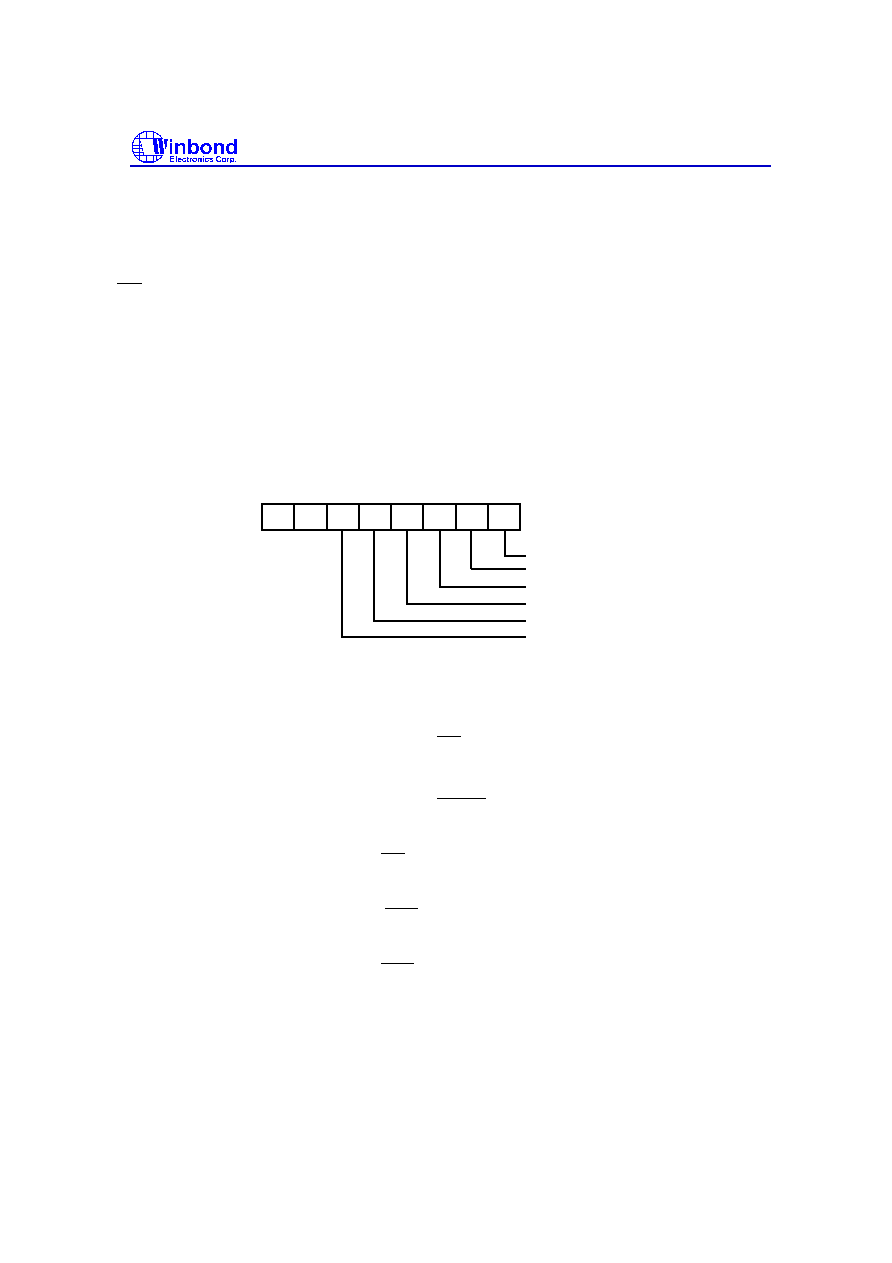
W83877ATF
Publication Release Date: April 1998
- 30 -
Version 0.51
WP (Bit 1):
0
disk is not write-protected
1
disk is write-protected
DIR (Bit 0)
This bit indicates the direction of head movement.
0
inward direction
1
outward direction
2.2.2 Status Register B (SB Register) (Read base address + 1)
This register is used to monitor several disk interface pins in PS/2 and Model 30 modes. In PS/2
mode, the bit definitions for this register are as follows:
1
2
3
4
5
6
7
0
MOT EN A
WE
RDATA Toggle
WDATA Toggle
Drive SEL0
MOT EN B
1
1
Drive SEL0 (Bit 5):
This bit indicates the status of DO REGISTER bit 0 (drive select bit 0).
WDATA Toggle (Bit 4):
This bit changes state at every rising edge of the WD output pin.
RDATA Toggle (Bit 3):
This bit changes state at every rising edge of the RDATA output pin.
WE (Bit 2):
This bit indicates the complement of the WE output pin.
MOT EN B (Bit 1)
This bit indicates the complement of the MOB output pin.
MOT EN A (Bit 0)
This bit indicates the complement of the MOA output pin.
In PS/2 Model 30 mode, the bit definitions for this register are as follows:
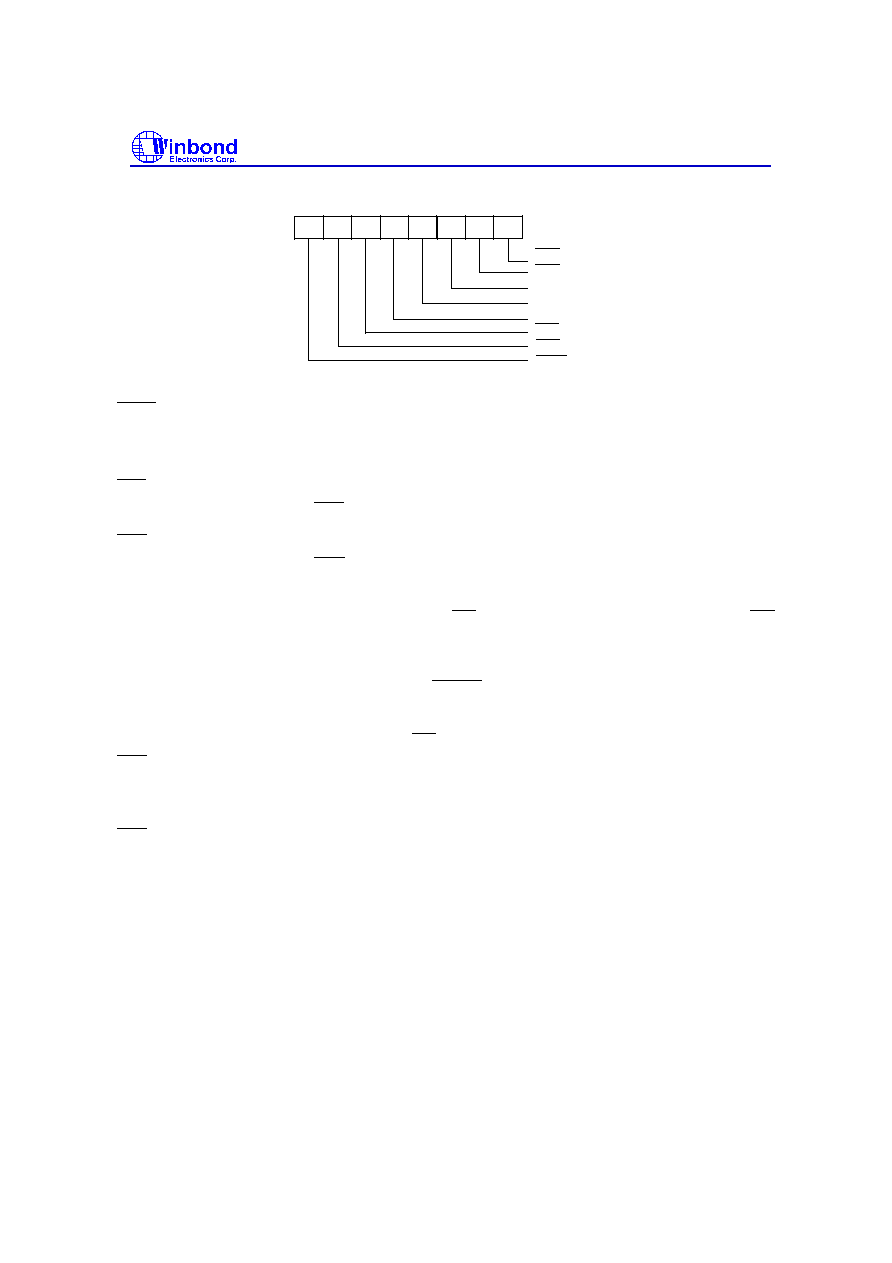
W83877ATF
Publication Release Date: April 1998
- 31 -
Version 0.51
1
2
3
4
5
6
7
0
DSC
DSD
WE F/F
RDATA F/F
DSA
DSB
DRV2
WD F/F
DRV2 (Bit 7):
0 A second drive has been installed
1 A second drive has not been installed
DSB (Bit 6):
This bit indicates the status of DSB output pin.
DSA (Bit 5):
This bit indicates the status of DSA output pin.
WD F/F(Bit 4):
This bit indicates the complement of the latched WD output pin at every rising edge of the WD
output pin.
RDATA F/F(Bit 3):
This bit indicates the complement of the latched RDATA output pin .
WE F/F (Bit 2):
This bit indicates the complement of latched WE output pin.
DSD (Bit 1):
0 Drive D has been selected
1 Drive D has not been selected
DSC (Bit 0):
0 Drive C has been selected
1 Drive C has not been selected

W83877ATF
Publication Release Date: April 1998
- 32 -
Version 0.51
2.2.3 Digital Output Register (DO Register) (Write base address + 2)
The Digital Output Register is a write-only register controlling drive motors, drive selection, DRQ/IRQ
enable, and FDC resetting. All the bits in this register are cleared by the MR pin. The bit definitions
are as follows:
7
6
5
4
3
2
1-0
Drive Select: 00 select drive A
01 select drive B
10 select drive C
11 select drive D
Floppy Disk Controller Reset
Active low resets FDC
DMA and INT Enable
Active high enable DRQ/IRQ
Motor Enable A. Motor A on when active high
Motor Enable B. Motor B on when active high
Motor Enable C. Motor C on when active high
Motor Enable D. Motor D on when active high
2.2.4 Tape Drive Register (TD Register) (Read base address + 3)
This register is used to assign a particular drive number to the tape drive support mode of the data
separator. This register also holds the media ID, drive type, and floppy boot drive information of the
floppy disk drive. In normal floppy mode, this register includes only bit 0 and 1. The bit definitions are
as follows:
1
2
3
4
5
6
7
0
Tape sel 0
Tape sel 1
X
X
X
X
X
X
If three mode FDD function is enabled (EN3MODE = 1 in CR9), the bit definitions are as follows:
1
2
3
4
5
6
7
0
Floppy boot drive 0
Floppy boot drive 1
Drive type ID0
Drive type ID1
Media ID0
Media ID1
Tape Sel 0
Tape Sel 1

W83877ATF
Publication Release Date: April 1998
- 33 -
Version 0.51
Media ID1 Media ID0 (Bit 7, 6):
These two bits are read only. These two bits reflect the value of CR8 bit 3, 2.
Drive type ID1 Drive type ID0 (Bit 5, 4):
These two bits reflect two of the bits of CR7. Which two bits are reflected depends on the last drive
selected in the DO REGISTER.
Floppy Boot drive 1, 0 (Bit 3, 2):
These two bits reflect the value of CR8 bit 1, 0.
Tape Sel 1, Tape Sel 0 (Bit 1, 0):
These two bits assign a logical drive number to the tape drive. Drive 0 is not available as a tape
drive
,
and is reserved as the floppy disk boot drive.
TAPE SEL 1
TAPE SEL 0
DRIVE SELECTED
0
0
None
0
1
1
1
0
2
1
1
3
2.2.5 Main Status Register (MS Register) (Read base address + 4)
The Main Status Register is used to control the flow of data between the microprocessor and the
controller. The bit definitions for this register are as follows:
FDD 0 Busy, (D0B = 1), FDD number 0 is in the SEEK mode.
FDD 1 Busy, (D1B = 1), FDD number 1 is in the SEEK mode.
FDC Busy, (CB). A read or write command is in the process when CB = HIGH.
Non-DMA mode, the FDC is in the non-DMA mode, this bit is set only during the
execution phase in non-DMA mode.
Transition to LOW state indicates execution phase has ended.
DATA INPUT/OUTPUT, (DIO). If DIO= HIGH then transfer is from Data Register to the processor.
If DIO = LOW then transfer is from processor to Data Register.
Request for Master (RQM). A high on this bit indicates Data Register is ready to send or receive data to or from the processor.
7
6
5
4
3
2
1
0
FDD 2 Busy, (D2B = 1), FDD number 2 is in the SEEK mode.
FDD 3 Busy, (D3B = 1), FDD number 3 is in the SEEK mode.
2.2.6 Data Rate Register (DR Register) (Write base address + 4)
The Data Rate Register is used to set the transfer rate and write precompensation. The data rate of
the FDC is programmed by the CC REGISTER for PC-AT and PS/2 Model 30 and PS/2 mode, and
not by the DR REGISTER. The real data rate is determined by the most recent write to either of the
DR REGISTER or CC REGISTER.

W83877ATF
Publication Release Date: April 1998
- 34 -
Version 0.51
1
2
3
4
5
6
7
0
DRATE0
DRATE1
PRECOMP0
PRECOMP1
PRECOMP2
POWER DOWN
S/W RESET
0
S/W RESET (Bit 7):
This bit is the software reset bit.
POWER-DOWN (Bit 6):
0 FDC in normal mode
1 FDC in power-down mode
PRECOMP2 PRECOMP1 PRECOMP0 (Bit 4, 3, 2):
These three bits select the value of write precompensation. The following tables show the
precompensation values for the combination of these bits.
PRECOM
PRECOMPENSATION DELAY
2 1 0
250K - 1Mbps
2 Mbps Tape drive
0 0 0
Default Delays
Default Delays
0 0 1
41.67 nS
20.8nS
0 1 0
83.34 nS
41.17nS
0 1 1
125.00 nS
62.5nS
1 0 0
166.67 nS
83.3nS
1 0 1
208.33 nS
104.2nS
1 1 0
250.00 nS
125.00nS
1 1 1
0.00 nS (disabled)
0.00nS (disabled)
DATA RATE
DEFAULT PRECOMPENSATION DELAYS
250 KB/S
125 nS
300 KB/S
125 nS
500 KB/S
125 nS
1 MB/S
41.67 nS
2 MB/S
20.8 nS

W83877ATF
Publication Release Date: April 1998
- 35 -
Version 0.51
DRATE1 DRATE0 (Bit 1, 0):
These two bits select the data rate of the FDC and reduced write current control.
00 500 KB/S (MFM), 250 KB/S (FM), RWC = 1.
01 300 KB/S (MFM), 150 KB/S (FM), RWC = 0.
10 250 KB/S (MFM), 125 KB/S (FM), RWC = 0.
11 1 MB/S (MFM), Illegal (FM), RWC = 1.
The 2MB/S data rate for Tape drive is only supported by setting 01 to DRATE1 and DRATE0 bits, as
well as setting 10 to DRTA1 and DRTA0 bits
,
which are two of the Configuration CR2D. Please refer
to the function of CR2D and the data rate table for individual data rates setting.
2.2.7 FIFO Register (R/W base address + 5)
The Data Register consists of four status registers in a stack
,
with only one register presented to the
data bus at a time. This register stores data, commands, and parameters
,
and provides diskette-drive
status information. Data bytes are passed through the data register to program or obtain results after
a command. In the W83877ATF, this register defaults to FIFO disabled mode after reset. The FIFO
can change its value and enable its operation through the CONFIGURE command.
Status Register 0 (ST0)
7-6
5
4
3
2
1-0
US1, US0 Drive Select:
00 Drive A selected
01 Drive B selected
10 Drive C selected
11 Drive D selected
HD Head address:
1 Head selected
0 Head selected
NR Not Ready:
1 Drive is not ready
0 Drive is ready
EC Equipment Check:
1 When a fault signal is received from the FDD or the track
0 signal fails to occur after 77 step pulses
0 No error
SE Seek end:
1 seek end
0 seek error
IC Interrupt Code:
00 Normal termination of command
01 Abnormal termination of command
10 Invalid command issue
11 Abnormal termination because the ready signal from FDD changed state during command execution
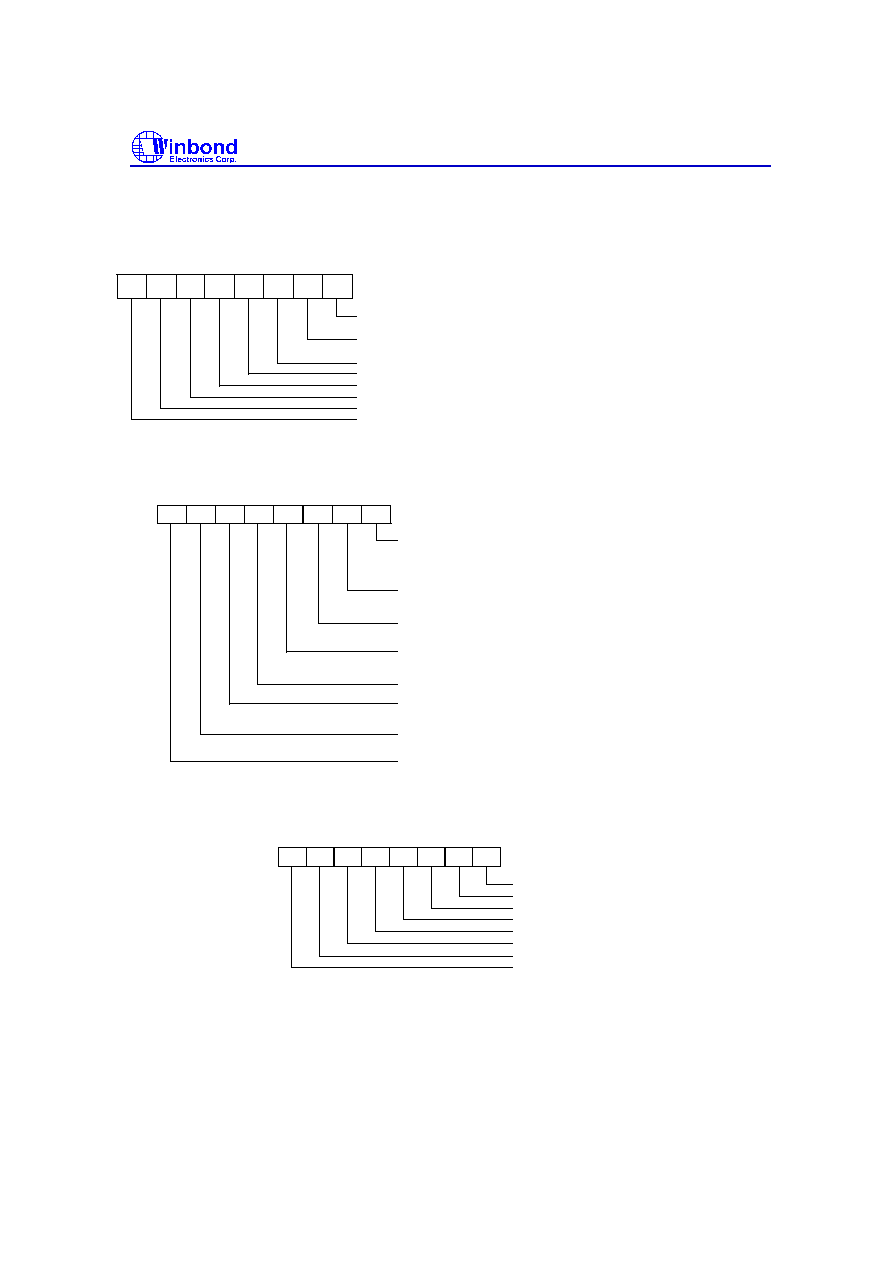
W83877ATF
Publication Release Date: April 1998
- 36 -
Version 0.51
Status Register 1 (ST1)
Missing Address Mark. 1 When the FDC cannot detect the data address mark
or the data address mark has been deleted.
NW (Not Writable). 1 If a write Protect signal is detected from the diskette drive during
execution of write data.
ND (No DATA). 1 If specified sector cannot be found during execution of a read, write or verifly data.
Not used. This bit is always 0.
OR (Over Rum). 1 If the FDC is not serviced by the host system within a certain time interval during data transfer.
DE (data Error).1 When the FDC detects a CRC error in either the ID field or the data field.
Not used. This bit is always 0.
EN (End of track). 1 When the FDC tries to access a sector beyond the final sector of a cylinder.
0
1
2
3
4
5
6
7
Status Register 2 (ST2)
1
2
3
4
5
6
7
0
BC (Bad Cylinder)
MD (Missing Address Mark in Data Field).
1 If the FDC cannot find a data address mark
(or the address mark has been deleted)
when reading data from the media
0 No error
1 Bad Cylinder
0 No error
SN (Scan Not satisfied)
1 During execution of the Scan command
0 No error
SH (Scan Equal Hit)
1 During execution of the Scan command, if the equal condition is satisfied
0 No error
WC (Wrong Cylinder)
1 Indicates wrong Cylinder
DD (Data error in the Data field)
1 If the FDC detects a CRC error in the data field
0 No error
CM (Control Mark)
1 During execution of the read data or scan command
0 No error
Not used. This bit is always 0
Status Register 3 (ST3)
1
2
3
4
5
6
7
0
US0 Unit Select 0
US1 Unit Select 1
HD Head Address
TS Two-Side
TO Track 0
RY Ready
WP Write Protected
FT Fault
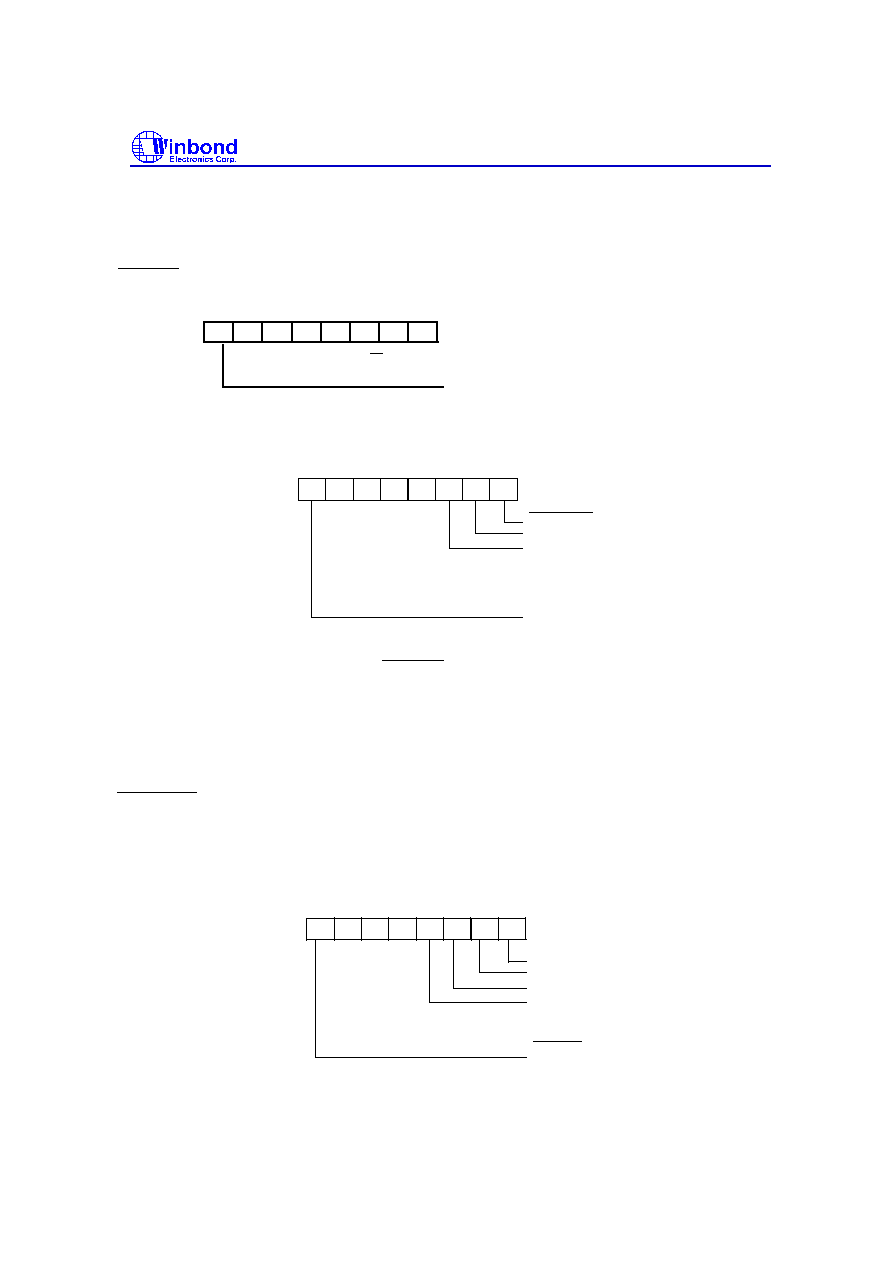
W83877ATF
Publication Release Date: April 1998
- 37 -
Version 0.51
2.2.8 Digital Input Register (DI Register) (Read base address + 7)
The Digital Input Register is an 8-bit read-only register used for diagnostic purposes. In a PC/XT or
AT only Bit 7 is checked by the BIOS. When the register is read, Bit 7 shows the complement of
DSKCHG
,
while other bits of the data bus remain in tri-state. Bit definitions are as follows:
x
x
x
x
x
x
x
x
0
1
2
3
4
5
6
7
Reserved for the hard disk controller
During a read of this register, these bits are in tri-state
DSKCHG
In the PS/2 mode, the bit definitions are as follows:
1
2
3
4
5
6
7
0
HIGH DENS
DRATE0
DRATE1
DSKCHG
1
1
1
1
DSKCHG (Bit 7):
This bit indicates the complement of the DSKCHG input.
Bit 6-3: These bits are always a logic 1 during a read.
DRATE1 DRATE0 (Bit 2, 1):
These two bits select the data rate of the FDC. Refer to the DR register bits 1 and 0 for the settings
corresponding to the individual data rates.
HIGH DENS (Bit 0):
0 500 KB/S or 1 MB/S data rate (high density FDD)
1 250 KB/S or 300 KB/S data rate
In the PS/2 Model 30 mode, the bit definitions are as follows:
1
2
3
4
5
6
7
0
DRATE0
DRATE1
DSKCHG
NOPREC
DMAEN
0
0
0
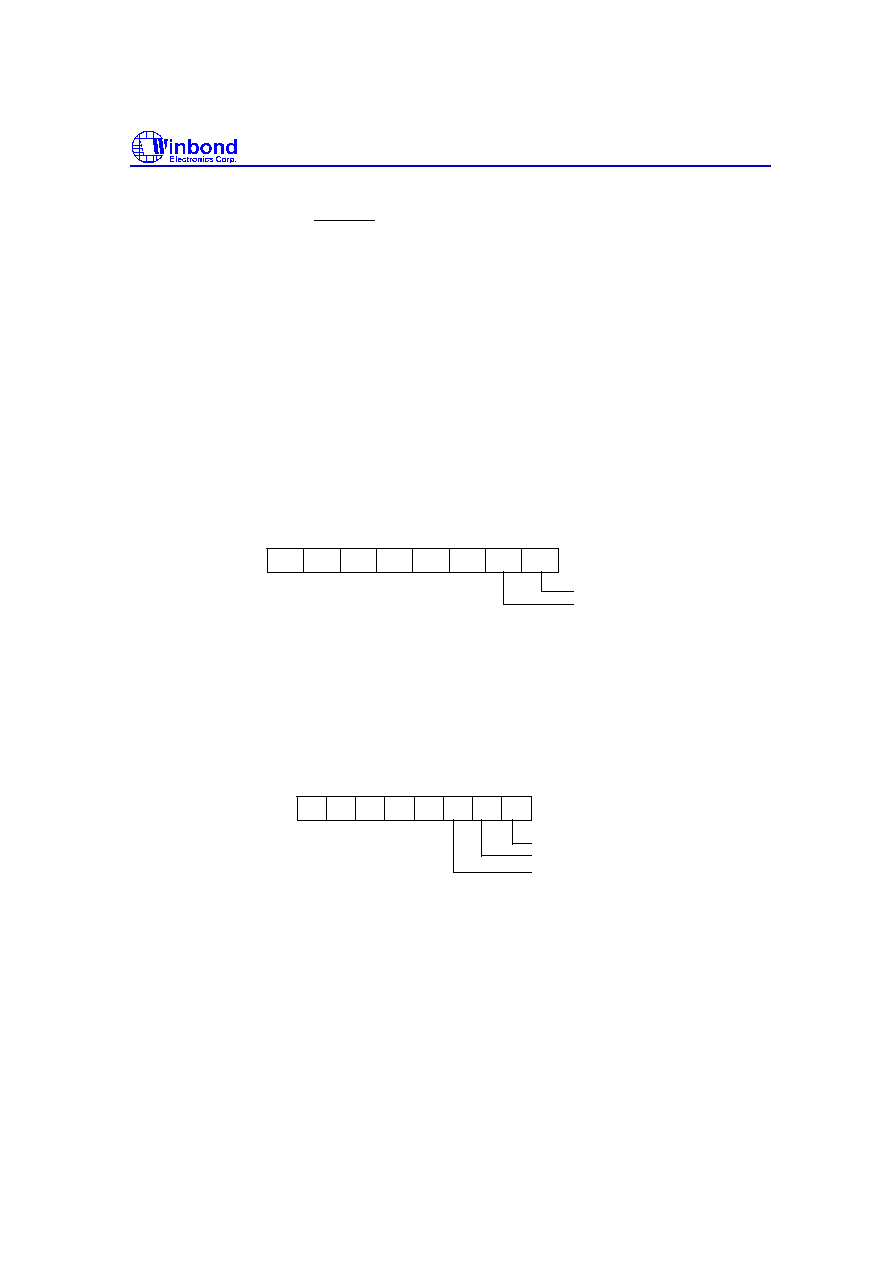
W83877ATF
Publication Release Date: April 1998
- 38 -
Version 0.51
DSKCHG (Bit 7):
This bit indicates the status of DSKCHG input.
Bit 6-4: These bits are always a logic 1 during a read.
DMAEN (Bit 3):
This bit indicates the value of DO REGISTER bit 3.
NOPREC (Bit 2):
This bit indicates the value of CC REGISTER NOPREC bit.
DRATE1 DRATE0 (Bit 1, 0):
These two bits select the data rate of the FDC.
2.2.9 Configuration Control Register (CC Register) (Write base address + 7)
This register is used to control the data rate. In the PC/AT and PS/2 mode, the bit definitions are as
follows:
x
x
x
x
x
x
DRATE0
DRATE1
0
1
2
3
4
5
7
6
X: Reserved
Bit 7-2: Reserved. These bits should be set to 0.
DRATE1 DRATE0 (Bit 1, 0):
These two bits select the data rate of the FDC.
In the PS/2 Model 30 mode, the bit definitions are as follows:
1
2
3
4
5
6
7
0
DRATE0
DRATE1
NOPREC
X
X
X
X
X
X
:
Reserved
Bit 7-3: Reserved. These bits should be set to 0.
NOPREC (Bit 2):
This bit indicates no precompensation. It has no function and can be set by software.
DRATE1 DRATE0 (Bit 1, 0):
These two bits select the data rate of the FDC.

W83877ATF
Publication Release Date: April 1998
- 39 - Version 0.51
3.0 UART PORT
3.1 Universal Asynchronous Receiver/Transmitter (UART A, UART B)
The UARTs are used to convert parallel data into serial format on the transmit side
,
and convert serial
data to parallel format on the receiver side. The serial format, in order of transmission and reception,
is a start bit, followed by five to eight data bits, a parity bit (if programmed) and one, one and a half
(five-bit format only) or two stop bits. The UARTs are capable of handling divisors of 1 to 65535 and
producing a 16x clock for driving the internal transmitter logic. Provisions are also included to use this
16x clock to drive the receiver logic. The UARTs also support the MIDI data rate. Furthermore, the
UARTs also include complete modem control capability
,
and a processor interrupt system that may
be software trailed to the computing time required to handle the communication link. The UARTs
have a FIFO mode to reduce the number of interrupts presented to the CPU. In each UART, there are
16-byte FIFOs for both receive and transmit mode.

W83877ATF
Publication Release Date: April 1998
- 40 - Version 0.51
3.2 Register Address
TABLE 3-1 UART Register Bit Map
Bit Number
Register Address Base
0
1
2
3
4
5
6
7
8
BDLAB = 0
Receiver
Buffer
Register
(Read Only)
RBR
RX Data
Bit 0
RX Data
Bit 1
RX Data
Bit 2
RX Data
Bit 3
RX Data
Bit 4
RX Data
Bit 5
RX Data
Bit 6
RX Data
Bit 7
8
BDLAB = 0
Transmitter
Buffer Register
(Write Only)
TBR
TX Data
Bit 0
TX Data
Bit 1
TX Data
Bit 2
TX Data
Bit 3
TX Data
Bit 4
TX Data
Bit 5
TX Data
Bit 6
TX Data
Bit 7
9
BDLAB = 0
Interrupt Control
Register
ICR
RBR Data
Ready
Interrupt
Enable
(ERDRI)
TBR
Empty
Interrupt
Enable
(ETBREI)
USR
Interrupt
Enable
(EUSRI)
HSR
Interrupt
Enable
(EHSRI)
0
0
0
0
A
Interrupt Status
Register
(Read Only)
ISR "0" if Interrupt
Pending
Interrupt
Status
Bit (0)
Interrupt
Status
Bit (1)
Interrupt
Status
Bit (2)**
0
0
FIFOs
Enabled
**
FIFOs
Enabled
**
A
UART FIFO
Control
Register
(Write Only)
UFR
FIFO
Enable
RCVR
FIFO
Reset
XMIT
FIFO
Reset
DMA
Mode
Select
Reserved
Reversed
RX
Interrupt
Active Level
(LSB)
RX
Interrupt
Active Level
(MSB)
B
UART Control
Register
UCR
Data
Length
Select
Bit 0
(DLS0)
Data
Length
Select
Bit 1
(DLS1)
Multiple
Stop Bits
Enable
(MSBE)
Parity
Bit
Enable
(PBE)
Even
Parity
Enable
(EPE)
Parity
Bit Fixed
Enable
PBFE)
Set
Silence
Enable
(SSE)
Baud rate
Divisor
Latch
Access Bit
(BDLAB)
C
Handshake
Control
Register
HCR
Data
Terminal
Ready
(DTR)
Request
to
Send
(RTS)
Loopback
RI
Input
IRQ
Enable
Internal
Loopback
Enable
0
0
0
D
UART Status
Register
USR
RBR Data
Ready
(RDR)
Overrun
Error
(OER)
Parity Bit
Error
(PBER)
No Stop
Bit
Error
(NSER)
Silent
Byte
Detected
(SBD)
TBR
Empty
(TBRE)
TSR
Empty
(TSRE)
RX FIFO
Error
Indication
(RFEI) **
E
Handshake
Status Register
HSR
CTS
Toggling
(TCTS)
DSR
Toggling
(TDSR)
RI Falling
Edge
(FERI)
DCD
Toggling
(TDCD)
Clear
to Send
(CTS)
Data Set
Ready
(DSR)
Ring
Indicator
(RI)
Data Carrier
Detect
(DCD)
F
User Defined
Register
UDR
Bit 0
Bit 1
Bit 2
Bit 3
Bit 4
Bit 5
Bit 6
Bit 7
8
BDLAB = 1
Baudrate Divisor
Latch Low
BLL
Bit 0
Bit 1
Bit 2
Bit 3
Bit 4
Bit 5
Bit 6
Bit 7
9
BDLAB = 1
Baudrate Divisor
Latch High
BHL
Bit 8
Bit 9
Bit 10
Bit 11
Bit 12
Bit 13
Bit 14
Bit 15
*: Bit 0 is the least significant bit. The least significant bit is the first bit serially transmitted or received.
**: These bits are always 0 in 16450 mode.

W83877ATF
Publication Release Date: April 1998
- 41 - Version 0.51
3
.2.1 UART Control Register (UCR) (Read/Write)
The UART
Control Register controls and defines the protocol for asynchronous data communications,
including data length, stop bit, parity, and baud rate selection.
1
2
3
4
5
6
7
0
Data length select bit 0 (DLS0)
Data length select bit 1(DLS1)
Multiple stop bits enable (MSBE)
Parity bit enable (PBE)
Even parity enable (EPE)
Parity bit fixed enable (PBFE)
Set silence enable (SSE)
Baudrate divisor latch access bit (BDLAB)
Bit 7: BDLAB. When this bit is set to a logical 1, designers can access the divisor (in 16-bit binary
format) from the divisor latches of the baud rate generator during a read or write operation.
When this bit is reset, the Receiver Buffer Register, the Transmitter Buffer Register, or the
Interrupt Control Register can be accessed.
Bit 6: SSE. A logical 1 forces the Serial Output (SOUT) to a silent state (a logical 0). Only SOUT is
affected by this bit; the transmitter is not affected.
Bit 5: PBFE. When PBE and PBFE of UCR are both set to a logical 1,
(1) if EPE is a logical 1, the parity bit is fixed as a logical 0 to transmit and check.
(2) if EPE is a logical 0, the parity bit is fixed as a logical 1 to transmit and check.
Bit 4: EPE. This bit describes the number of logic 1's in the data word bits and parity bit only when bit
3 is programmed. When this bit is set, an even number of logic 1's are sent or checked. When
the bit is reset, an odd number of logic 1's are sent or checked.
Bit 3: PBE. When this bit is set, the position between the last data bit and the stop bit of the SOUT
will be stuffed with the parity bit at the transmitter. For the receiver, the parity bit in the same
position as the transmitter will be detected.
Bit 2: MSBE. This bit defines the number of stop bits in each serial character that is transmitted or
received.
(1) If MSBE is set to a logical 0, one stop bit is sent and checked.
(2) If MSBE is set to a logical 1, and data length is 5 bits, one and a half stop bits are sent and
checked.
(3) If MSBE is set to a logical 1, and data length is 6, 7, or 8 bits, two stop bits are sent and
checked.
Bits 0 and 1: DLS0, DLS1. These two bits define the number of data bits that are sent or checked in
each serial character.

W83877ATF
Publication Release Date: April 1998
- 42 - Version 0.51
TABLE 3-2 WORD LENGTH DEFINITION
DLS1
DLS0
DATA LENGTH
0
0
5 bits
0
1
6 bits
1
0
7 bits
1
1
8 bits
3.2.2 UART Status Register (USR) (Read/Write)
This 8-bit register provides information about the status of the data transfer during communication.
1
2
3
4
5
6
7
0
RBR Data ready (RDR)
Overrun error (OER)
Parity bit error (PBER)
No stop bit error (NSER)
Silent byte detected (SBD)
Transmitter Buffer Register empty (TBRE)
Transmitter Shift Register empty (TSRE)
RX FIFO Error Indication (RFEI)
Bit 7: RFEI. In 16450 mode, this bit is always set to a logic 0. In 16550 mode, this bit is set to a logic
1 when there is at least one parity bit error, but no stop bit error or silent byte detected in the
FIFO. In 16550 mode, this bit is cleared by reading from the USR if there are no remaining
errors left in the FIFO.
Bit 6: TSRE. In 16450 mode, when TBR and TSR are both empty, this bit will be set to a logical 1. In
16550 mode, if the transmit FIFO and TSR are both empty, it will be set to a logical 1. Other
than
in these two cases, this bit will be reset to a logical 0.
Bit 5: TBRE. In 16450 mode, when a data character is transferred from TBR to TSR, this bit will be
set to a logical 1. If ETREI of ICR is a logical 1, an interrupt will be generated to notify the CPU
to write the next data. In 16550 mode, this bit will be set to a logical 1 when the transmit FIFO
is empty. It will be reset to a logical 0 when the CPU writes data into TBR or FIFO.
Bit 4: SBD. This bit is set to a logical 1 to indicate that received data are kept in silent state for a full
word time, including start bit, data bits, parity bit, and stop bits. In 16550 mode, it indicates the
same condition for the data on top of the FIFO. When the CPU reads USR, it will clear this bit
to a logical 0.
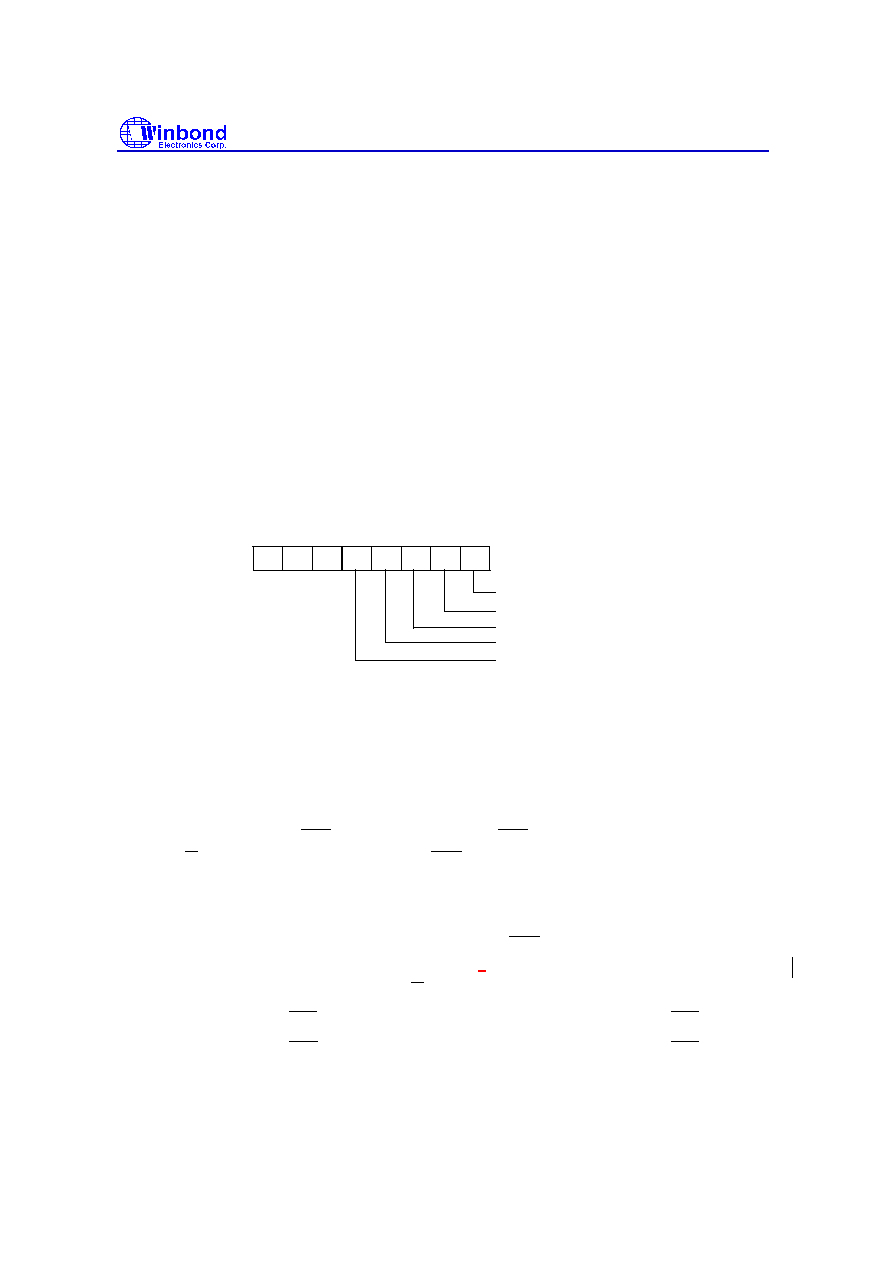
W83877ATF
Publication Release Date: April 1998
- 43 - Version 0.51
Bit 3: NSER. This bit is set to a logical 1 to indicate that the received data have no stop bit. In 16550
mode, it indicates the same condition for the data on top of the FIFO. When the CPU reads
USR, it will clear this bit to a logical 0.
Bit 2: PBER. This bit is set to a logical 1 to indicate that the parity bit of the eceived data is wrong. In
16550 mode, it indicates the same condition for the data on top of the FIFO. When the CPU
reads USR, it will clear this bit to a logical 0.
Bit 1: OER. This bit is set to a logical 1 to indicate that received data have been overwritten by the
next received data before they were read by the CPU. In 16550 mode, it indicates the same
condition instead of FIFO full. When the CPU reads USR, it will clear this bit to a logical 0.
Bit 0: RDR. This bit is set to a logical 1 to indicate received data are ready to be read by the CPU in
the RBR or FIFO. After no data are left in the RBR or FIFO, the bit will be reset to a logical 0.
3.2.3 Handshake Control Register (HCR) (Read/Write)
This register controls the pins of the UART used for handshaking peripherals such as modem, and
controls the diagnostic mode of the UART.
0
0
0
0
1
2
3
4
5
6
7
Data terminal ready (DTR)
Request to send (RTS)
Loopback RI input
IRQ enable
Internal loopback enable
Bit 4: When this bit is set to a logical 1, the UART enters diagnostic mode by an internal loopback, as
follows:
(1) SOUT is forced to a logical 1, and SIN is isolated from the communication link instead of
the TSR.
(2) Modem output pins are set to their inactive state.
(3) Modem input pins are isolated from the communication link and connect internally as DTR
(bit 0 of HCR)
DSR, RTS ( bit 1 of HCR)
CTS, Loopback RI input ( bit 2 of HCR)
RI and IRQ enable ( bit 3 of HCR)
DCD.
Aside from the above connections, the UART operates normally. This method allows the
CPU to test the UART in a convenient way.
Bit 3: The UART interrupt output is enabled by setting this bit to a logic 1. In the diagnostic mode this
bit is internally connected to the modem control input DCD .
Bit 2: This bit is used only in the diagnostic mode.
In the diagnostic mode this bit is internally
connected to the modem control input RI .
Bit 1: This bit controls the RTS output. The value of this bit is inverted and output to RTS .
Bit 0: This bit controls the DTR output. The value of this bit is inverted and output to DTR .
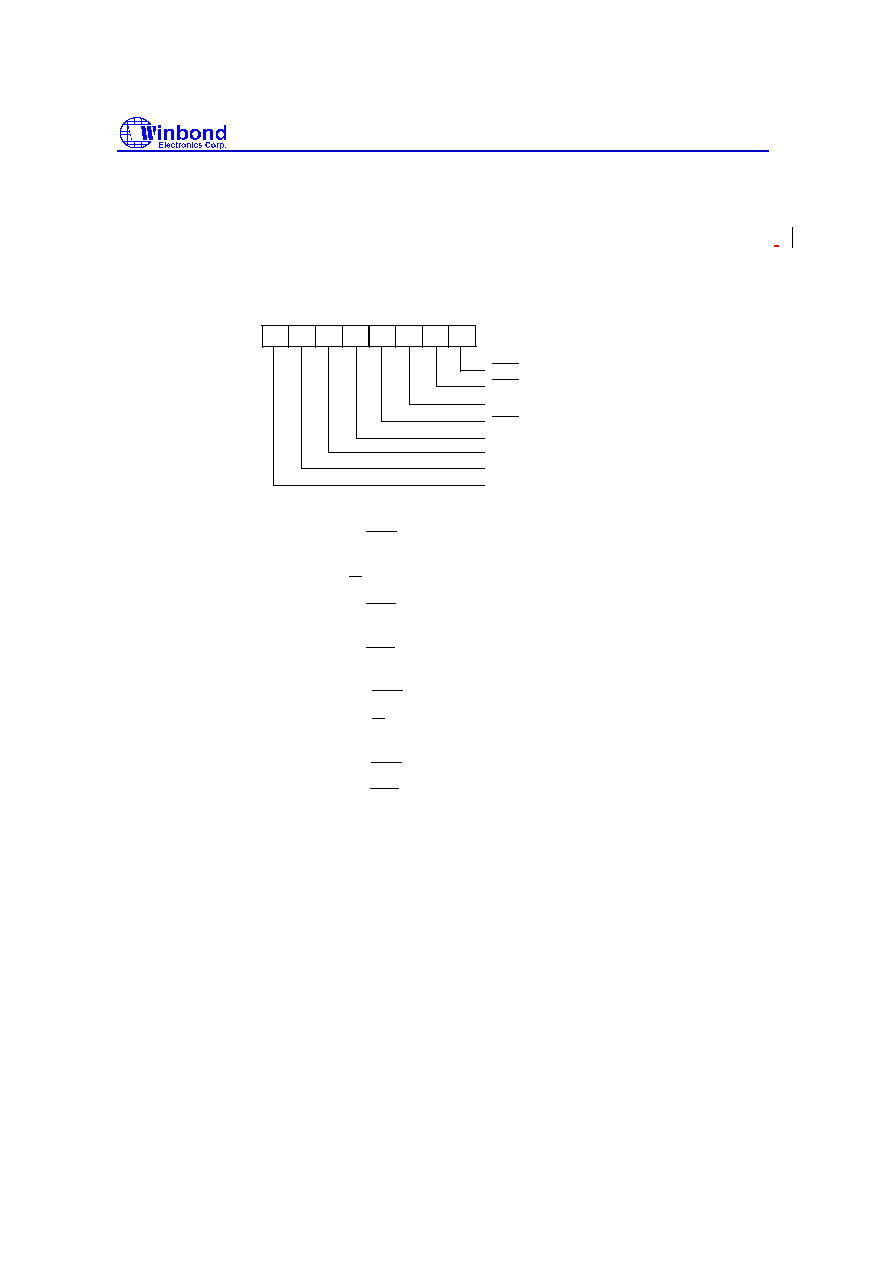
W83877ATF
Publication Release Date: April 1998
- 44 - Version 0.51
3.2.4 Handshake Status Register (HSR) (Read/Write)
This register reflects the current state of four input pins for handshake peripherals such as a modem
,
and records changes on these pins.
1
2
3
4
5
6
7
0
RI falling edge (FERI)
Clear to send (CTS)
Data set ready (DSR)
Ring indicator (RI)
Data carrier detect (DCD)
CTS toggling (TCTS)
DSR toggling (TDSR)
DCD toggling (TDCD)
Bit 7: This bit is the opposite of the DCD input. This bit is equivalent to bit 3 of HCR in loopback
mode.
Bit 6: This bit is the opposite of the RI input. This bit is equivalent to bit 2 of HCR in loopback mode.
Bit 5: This bit is the opposite of the DSR input. This bit is equivalent to bit 0 of HCR in loopback
mode.
Bit 4: This bit is the opposite of the CTS input. This bit is equivalent to bit 1 of HCR in loopback
mode.
Bit 3: TDCD. This bit indicates that the DCD pin has changed state after HSR was read by the CPU.
Bit 2: FERI. This bit indicates that the RI pin has changed from low to high state after HSR was read
by the CPU.
Bit 1: TDSR. This bit indicates that the DSR pin has changed state after HSR was read by the CPU.
Bit 0: TCTS. This bit indicates that the CTS pin has changed state after HSR was read by the CPU.
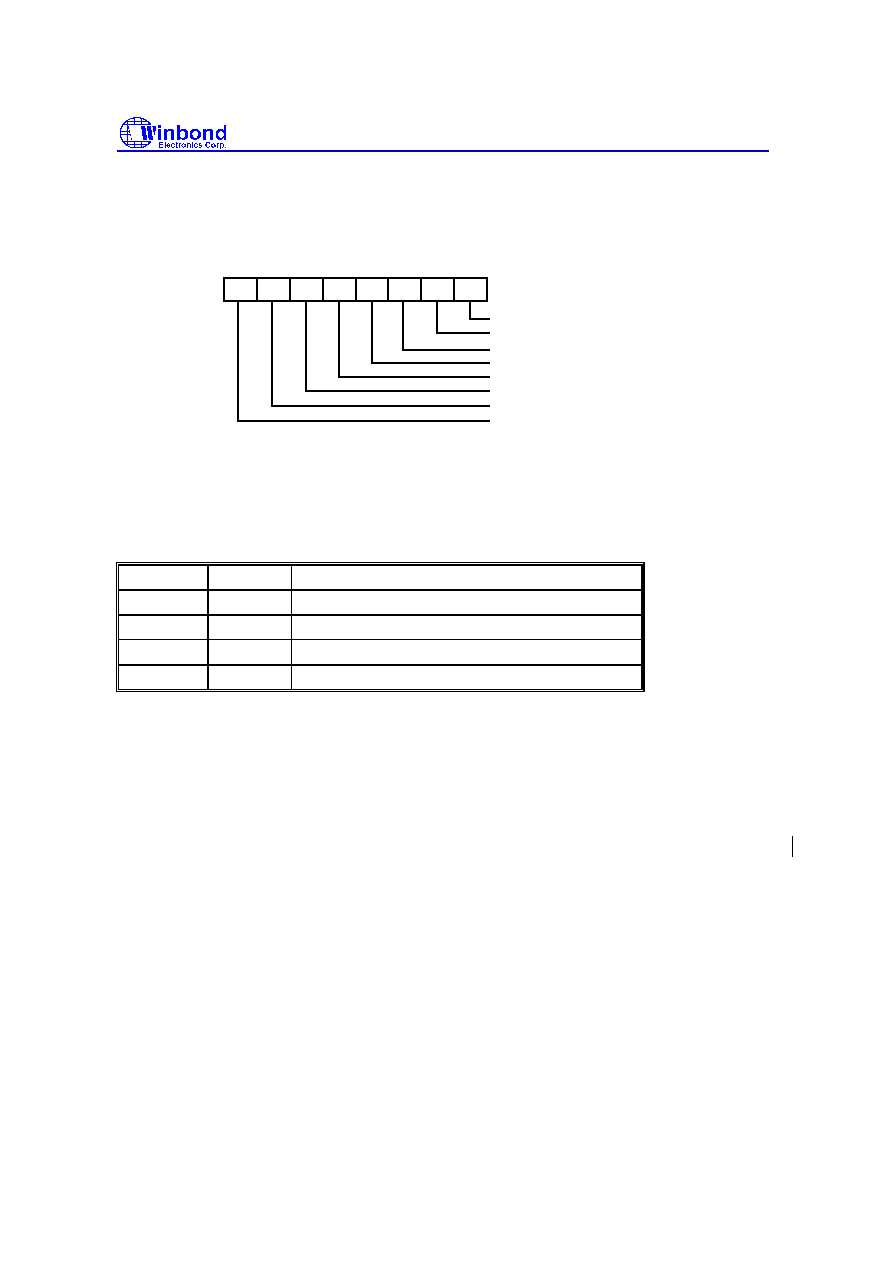
W83877ATF
Publication Release Date: April 1998
- 45 - Version 0.51
3.2.5 UART FIFO Control Register (UFR) (Write only)
This register is used to control the FIFO functions of the UART.
1
2
3
4
5
6
7
0
FIFO enable
Receiver FIFO reset
Transmitter FIFO reset
DMA mode select
Reserved
Reserved
RX interrupt active level (LSB)
RX interrupt active level (MSB)
Bit 6, 7: These two bits are used to set the active level for the receiver FIFO interrupt. For example, if
the interrupt active level is set as 4 bytes, once there are more than 4 data characters in the
receiver FIFO, the interrupt will be activated to notify the CPU to read the data from the FIFO.
TABLE 3-3 FIFO TRIGGER LEVEL
BIT 7
BIT 6
RX FIFO INTERRUPT ACTIVE LEVEL (BYTES)
0
0
01
0
1
04
1
0
08
1
1
14
Bit 4, 5: Reserved
Bit 3: When this bit is programmed to logic 1, the DMA mode will change from mode 0 to mode 1 if
UFR bit 0 = 1.
Bit 2: Setting this bit to a logical 1 resets the TX FIFO counter logic to initial state. This bit will clear to
a logical 0 by itself after being set to a logical 1.
Bit 1: Setting this bit to a logical 1 resets the RX FIFO counter logic to initial state. This bit will clear to
a logical 0 by itself after being set to a logical 1.
Bit 0: This bit enables the 16550 (FIFO) mode of the UART. This bit should be set to a logical 1
before other bits of UFR are programmed.

W83877ATF
Publication Release Date: April 1998
- 46 - Version 0.51
3.2.6 Interrupt Status Register (ISR) (Read only)
This register reflects the UART interrupt status, which is encoded by different interrupt sources into 3
bits.
1
2
3
4
5
6
7
0
0 if interrupt pending
Interrupt Status bit 0
Interrupt Status bit 1
Interrupt Status bit 2
FIFOs enabled
FIFOs enabled
0
0
Bit 7, 6: These two bits are set to a logical 1 when UFR bit 0 = 1.
Bit 5, 4: These two bits are always logic 0.
Bit 3: In 16450 mode, this bit is 0. In 16550 mode, both bit 3 and 2 are set to a logical 1 when a
time-
out interrupt is pending.
Bit 2, 1: These two bits identify the priority level of the pending interrupt, as shown in the table below.
Bit 0: This bit is a logical 1 if there is no interrupt pending. If one of the interrupt sources has
occurred, this bit will be set to a logical 0.
TABLE 3-4 INTERRUPT CONTROL FUNCTION
ISR
INTERRUPT SET AND FUNCTION
Bit
3
Bit
2
Bit
1
Bit
0
Interrupt
priority
Interrupt Type
Interrupt Source
Clear Interrupt
0
0
0
1
-
-
No Interrupt pending
-
0
1
1
0
First
UART Receive
Status
1. OER = 1 2. PBER =1
3. NSER = 1 4. SBD = 1
Read USR
0
1
0
0
Second
RBR Data Ready
1. RBR data ready
2. FIFO interrupt active level
reached
1. Read RBR
2. Read RBR until FIFO
data under active level
1
1
0
0
Second
FIFO Data Timeout
Data present in RX FIFO for 4
characters period of time since last
access of RX FIFO.
Read RBR
0
0
1
0
Third
TBR Empty
TBR empty
1. Write data into TBR
2. Read ISR (if priority is
third)
0
0
0
0
Fourth
Handshake status
1. TCTS = 1 2. TDSR = 1
3. FERI = 1 4. TDCD = 1
Read HSR
** Bit 3 of ISR is enabled when bit 0 of UFR is logical 1.

W83877ATF
Publication Release Date: April 1998
- 47 - Version 0.51
3.2.7 Interrupt Control Register (ICR) (Read/Write)
This 8-bit register allows the five types of controller interrupts to activate the interrupt output signal
separately. The interrupt system can be totally disabled by resetting bits 0 through 3 of the Interrupt
Control Register (ICR). A selected interrupt can be enabled by setting the appropriate bits of this
register to a logical 1.
0
0
0
1
2
3
4
5
6
7
0
0
RBR data ready interrupt enable (ERDRI)
TBR empty interrupt enable (ETBREI)
UART receive status interrupt enable (EUSRI)
Handshake status interrupt enable (EHSRI)
Bit 7-4: These four bits are always logic 0.
Bit 3: EHSRI. Setting this bit to a logical 1 enables the handshake status register interrupt.
Bit 2: EUSRI. Setting this bit to a logical 1 enables the UART status register interrupt.
Bit 1: ETBREI. Setting this bit to a logical 1 enables the TBR empty interrupt.
Bit 0: ERDRI. Setting this bit to a logical 1 enables the RBR data ready interrupt.
3.2.8 Programmable Baud Generator (BLL/BHL) (Read/Write)
Two 8-bit registers, BLL and BHL, compose a programmable baud generator that uses 24 MHz to
generate a 1.8461 MHz frequency and divides it by a divisor from 1 to 2
16
-1. The output frequency of
the baud generator is the baud rate multiplied by 16, and this is the base frequency for the transmitter
and receiver. The table below illustrates the use of the baud generator with a frequency of 1.8461
MHz. In high-speed UART mode (refer to CR0C bit7 and CR0C bit6), the programmable baud
generator directly uses 24 MHz and the same divisor as the normal speed divisor. In high-speed
mode, the data transmission rate can be as high as 1.5M bps.

W83877ATF
Publication Release Date: April 1998
- 48 - Version 0.51
3.2.9 User-defined Register (UDR) (Read/Write)
This is a temporary register that can be accessed and defined by the user.
TABLE 3-5 BAUD RATE TABLE
BAUD RATE USING 24 MHZ TO GENERATE 1.8461 MHZ
Desired Baud Rate
Decimal divisor used to
generate 16X clock
Percent error difference between
desired and actual
50
2304
**
75
1536
**
110
1047
0.18%
134.5
857
0.099%
150
768
**
300
384
**
600
192
**
1200
96
**
1800
64
**
2000
58
0.53%
2400
48
**
3600
32
**
4800
24
**
7200
16
**
9600
12
**
19200
6
**
38400
3
**
57600
2
**
115200
1
**
230400
4
Note 1
**
460800
2
Note 1
**
921600
1
Note 1
**
1.5M
1
Note 2
0%
Note 1: Only use in high speed mode, when FASTA/FASTB bits are set (refer to CR19 bit1 and CR19 bit0).
Note 2: Only use in high speed mode, when TURA/TURB bits are set (refer to CR0C bit7 and bit6).
** The percentage error for all baud rates, except where indicated otherwise, is 0.16%

W83877ATF
Publication Release Date: April 1998
- 49 - Version 0.51
3.3 IR Port
In the W83877AF includes two serial ports, that is
,
UART A and UART B. The second serial port,
UART B, also has built-in Infrared (IR) functions which include IrDA 1.0 SIR, IrDA 1.1 MIR (1.152M
bps), IrDA FIR (4M bps), SHARP ASK-IR, and remote control (that support NEC, RC-5, advanced
RC-5, and RECS-80 protocol).
4.3.1 Advanced UART B Register Description
When bank select enable bit (ENBNKSEL, in CR2C.bit3) is set, UART B will be switched to Advanced
UART B, and eight Register Sets can be accessed. These Register Sets control enhanced UART B,
IR function switching such as SIR, MIR, or FIR. Also
,
a superior traditional UART B function can be
used, such as 32-byte transmitter/receiver FIFO, non-encoding IRQ identify status register, and
automatic flow control. The MIR/FIR and remote control registers are also defined in these Register
Sets. The
structure of he Register Sets is shown below.
Set 0
Reg 7
Reg 6
Reg 5
Reg 4
BDL/SSR
Reg 2
Reg 1
Reg 0
Set 1
Set 3
Set 4
Set 5
Set 6
Set 7
Set 2
All in one Reg
to Select SSR
*Set 0, 1 are legacy/Advanced UART Registers
*Set 2~7 are Advanced UART Registers
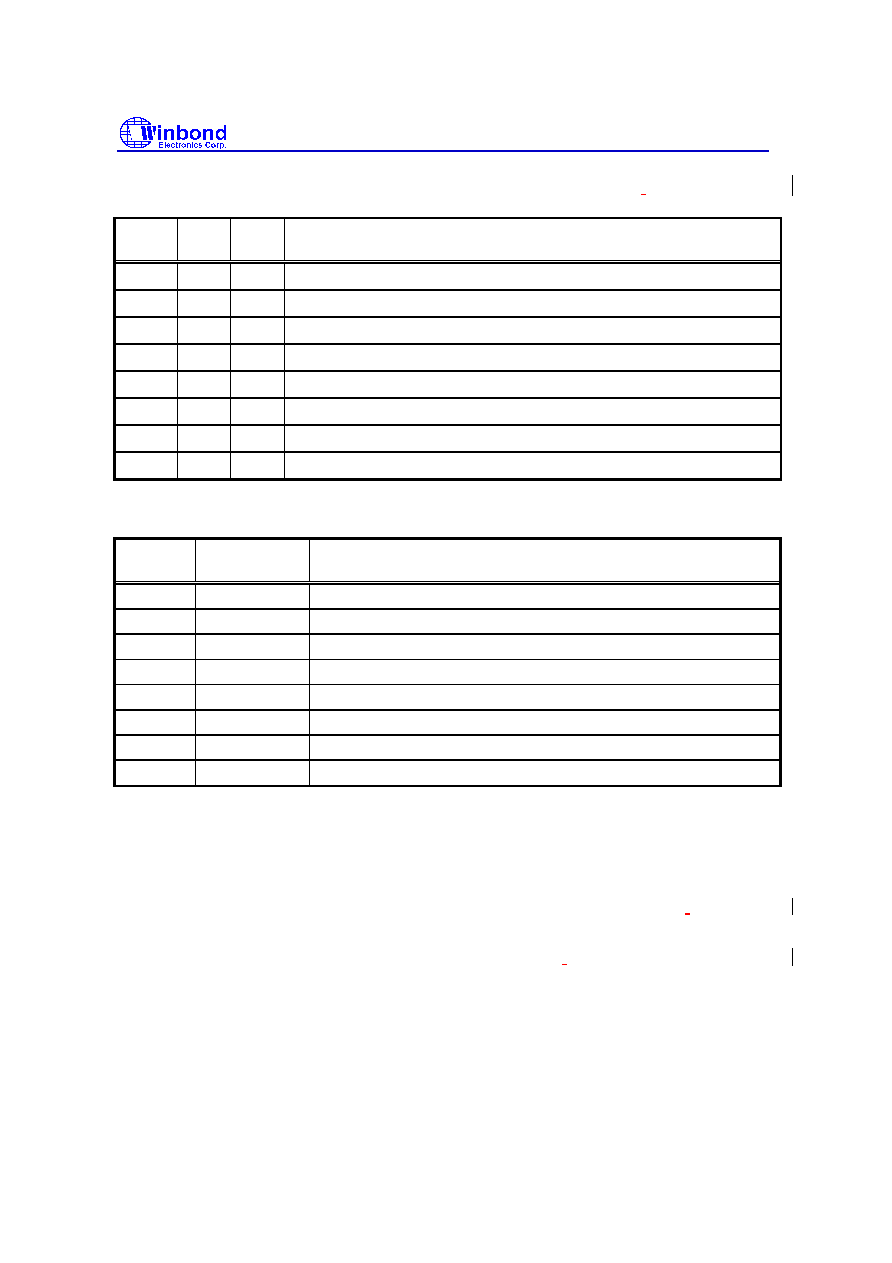
W83877ATF
Publication Release Date: April 1998
- 50 - Version 0.51
All Set s registers have a common register which is
Sets Select Register (SSR)
,
in order to switch to
any
Set when configuring this register. The summary description of these Sets is shown below.
Set
UART
IR
Mode
Sets Description
0
� �
� �
Legacy/Advanced UART Control and Status Registers.
1
� �
� �
Legacy Baud Rate Divisor Register.
2
� �
Advanced UART Control and Status Registers.
3
� �
Version ID
and Mapped Control Registers.
4
� �
Transmitter/Receiver/Timer Counter Registers
and IR Control Registers.
5
� �
Flow Control
and IR Control and Frame Status FIFO Registers.
6
� �
IR Physical Layer Control Registers
7
� �
Remote Control
and IR front-end Module Selection Registers.
4.3.2 Set0-Legacy/Advanced UART Control and Status Registers
Address
Offset
Register Name
Register Description
0
RBR/TBR Receiver/Transmitter Buffer Registers
1
ICR
Interrupt Control Register
2
ISR/UFR
Interrupt Status
or UART FIFO Control Register
3
UCR/SSR
UART Control
or Sets Select Register
4
HCR
Handshake Control Register
5
USR
UART Status Register
6
HSR
Handshake Status Register
7
UDR/ESCR User Defined Register
4.3.2.1 Set0.Reg0 - Receiver/Transmitter Buffer Registers (RBR/TBR) (Read/Write)
Receiver Buffer Register is read only and Transmitter Buffer Register is write only. These registers
are described the ame as legacy UART.
In legacy UART, this port only supports PIO mode. In dvanced UART, if setup to MIR/FIR/Remote IR,
this port will support DMA handshake function. Two DMA channels can be used, that is
,
one TX DMA
channel and another RX DMA channel. Therefore, single DMA channel is also supported when the bit
of D_CHSW (DMA Channel Swap, in Set2.Reg2.Bit3) is set and the TX/RX DMA channel is swapped.
Note that two DMA channels are defined in config register CR2A
,
which selects DMA channel or
disables DMA channel. If RX DMA channel is enabled and TX DMA channel is disabled, then the
single DMA channel will be selected.
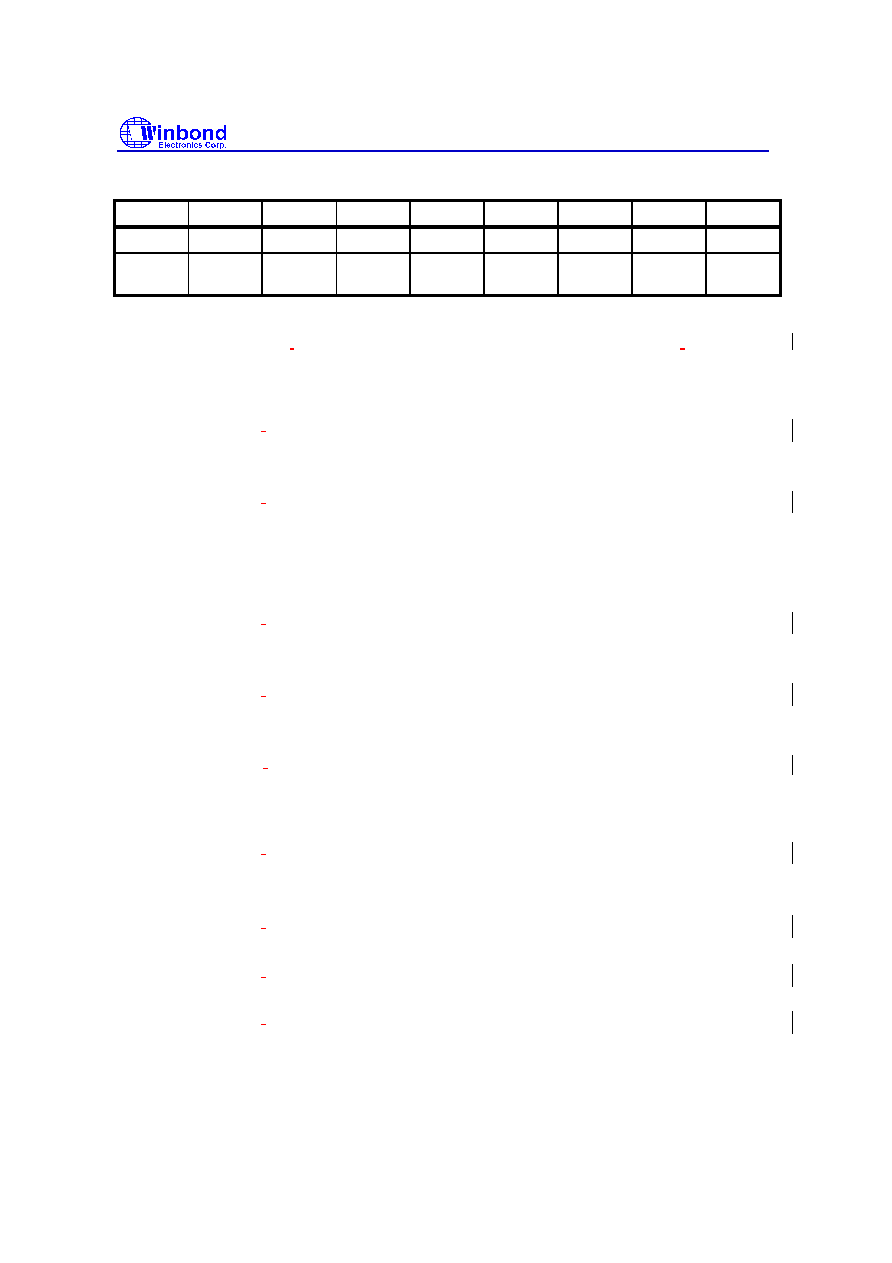
W83877ATF
Publication Release Date: April 1998
- 51 - Version 0.51
4.3.2.2 Set0.Reg1 - Interrupt Control Register (ICR)
Mode
B7
B6
B5
B4
B3
B2
B1
B0
UART
0
0
0
0
EHSRI
EUSRI
ETBREI
ERDRI
Advanced
UART
ETMRI
EFSFI
ETXTHI
EDMAI
EHSRI
EUSRI/
TXURI
ETBREI
ERXTHI
Where UART is used to Legacy UART, and the functions for these bits are defined in the previous
UART, the traditional SIR or ASK-IR based on the legacy UART also has the same definitions. The
advanced UART functions
,
including Advanced SIR/ASK-IR, MIR, FIR, or Remote IR
,
are described
as follows.
Bit 7:
ETMRI - Enable Timer Interrupt
Write to 1
,
enable timer interrupt.
Bit 6:
MIR, FIR mode:
EFSFI - Enable Frame Status FIFO Interrupt
Write to 1
,
enable frame status FIFO interrupt.
Advanced SIR/ASK-IR, Remote IR:
Not used.
Bit 5:
Advanced SIR/ASK-IR, MIR, FIR, Remote IR:
ETXTHI - Enable Transmitter Threshold Interrupt
Write to 1
,
enable transmitter threshold interrupt.
Bit 4:
MIR, FIR, Remote IR:
EDMAI - Enable DMA Interrupt.
Write to 1
,
enable DMA interrupt.
Bit 3:
Advanced UART/SIR/ASK-IR, MIR, FIR, Remote IR:
EHSRI - Enable HSR (Handshake Status Register) Interrupt
Write to 1
,
enable handshake status register interrupt. Note that the bit IRHSSL (Infrared
Handshake Select) should be set to 1, then this bit EHSRI is effective.
Bit 2:
Advanced SIR/ASK-IR:
EUSRI - Enable USR (UART Status Register) Interrupt
Write to 1
,
enable UART status register interrupt.
MIR, FIR, Remote Controller:
EHSRI/ETXURI - Enable USR Interrupt or Enable Transmitter Underrun Interrupt
Write to 1
,
enable USR interrupt or enable transmitter underrun interrupt.
Bit 1:
ETBREI - Enable TBR (Transmitter Buffer Register) Empty Interrupt
Write to 1
,
enable transmitter buffer register empty interrupt.
Bit 0:
ERBRI - Enable RDR (Receiver Buffer Register) Interrupt
Write to 1
,
enable receiver buffer register interrupt.
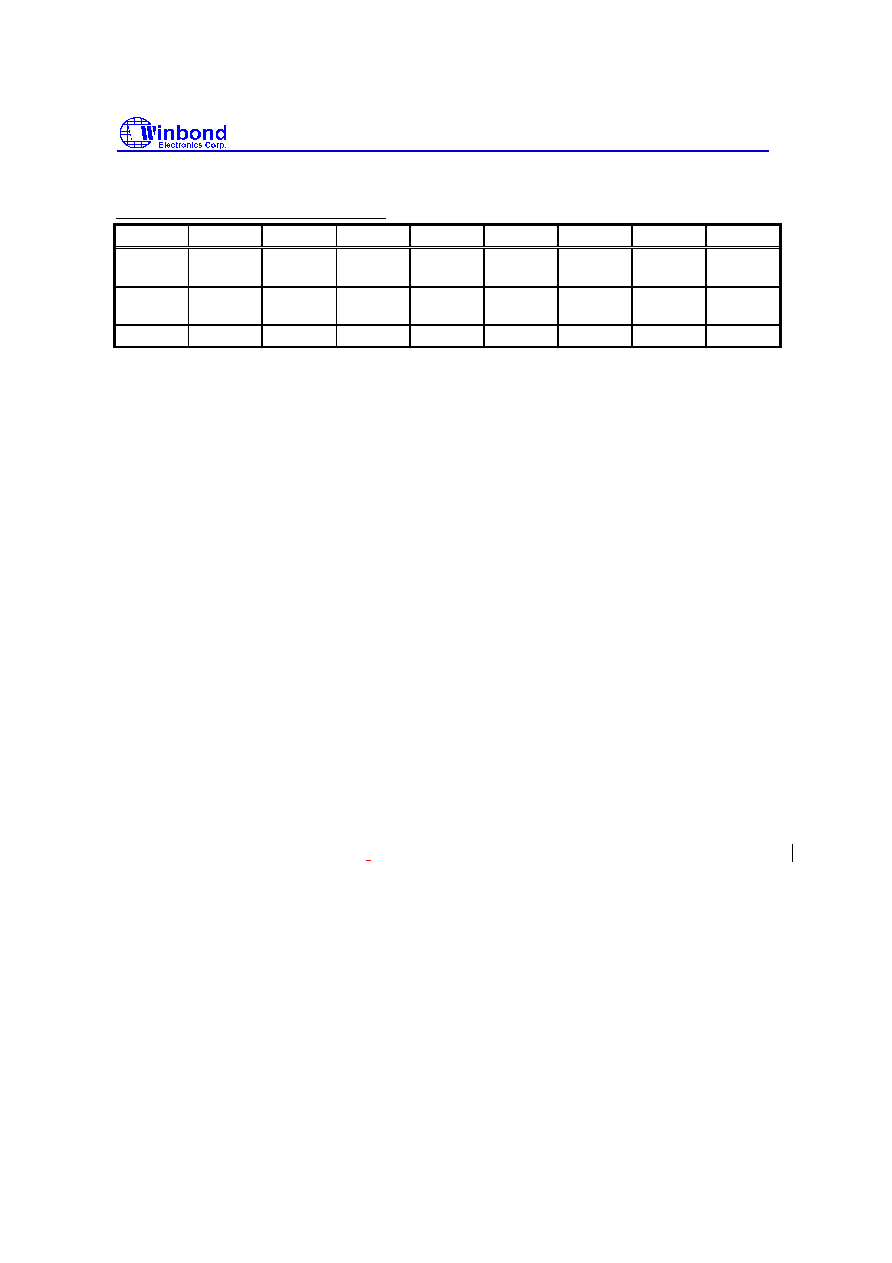
W83877ATF
Publication Release Date: April 1998
- 52 - Version 0.51
4.3.2.3 Set0.Reg2 - Interrupt Status Register/UART FIFO Control Register (ISR/UFR)
(1) Interrupt Status Register: (Write Only)
Mode
B7
B6
B5
B4
B3
B2
B1
B0
Legacy
UART
FIFO
Enable
FIFO
Enable
0
0
IID2
IID1
IID0
IP
Advanced
UART
TMR_I
FSF_I
TXTH_I
DMA_I
HS_I
USR_I/
FEND_I
TXEMP_I RXTH_I
Reset Value
0
0
1
0
0
0
1
0
Legacy UART: Same as previous register defined.
Advanced UART:
Bit 7:
TMR_I - Timer Interrupt.
Set to 1 when timer counts to 0. This bit will be affected by (1) the timer registers are
defined in Set4.Reg0 and Set4.Reg1, (2) EN_TMR(Enable Timer, in Set4.Reg2.Bit0)
should be set to 1, (3) ENTMR_I (Enable Timer Interrupt, in Set0.Reg1.Bit7) should be
set to 1.
Bit 6:
MIR, FIR modes:
FSF_I - Frame Status FIFO Interrupt.
Set to 1 when Frame Status FIFO is equal to or larger than the threshold level
or Frame
Status FIFO time-out occurs. Clear to 0 when Frame Status FIFO is below the threshold
level.
Advanced UART/SIR/ASK-IR, Remote IR modes:
Not used.
Bit 5:
TXTH_I - Transmitter Threshold Interrupt.
Set to 1 if the TBR (Transmitter Buffer Register) FIFO is below the threshold level. Clear
to 0 if the TBR (Transmitter Buffer Register) FIFO is below the threshold level.
Bit 4:
MIR, FIR, Remote IR modes:
DMA_I - DMA Interrupt.
Set to 1 if the DMA controller 8237A sends a TC (Terminal Count) to I/O device which
may be a Transmitter TC or a Receiver TC. Clear to 0 when this register is read.
Bit 3:
HS_I - Handshake Status Interrupt.
Set to 1 when the Handshake Status Register has a toggle. Clear to 0 when Handshake
Status Register (HSR) is read. Note that in all IR modes including SIR, ASK-IR, MIR,
FIR, and Remote Control
,
IR are defaulted to inactive except set IR Handshake Status
Enable (IRHS_EN) to 1.
Bit 2:
Advanced UART/SIR/ASK-IR modes:
USR_I - UART Status Interrupt.
Set to 1 when overrun, or parity bit, or stop bit, or silent byte detected error in the UART
Status Register (USR) is set to 1. Clear to 0 when USR is read.
MIR, FIR modes:
FEND_I - Frame End Interrupt.
Set to 1 when (1) a frame has a grace end to be detected where the frame signal is
defined in the physical layer of IrDA version 1.1 (2) abort signal or illegal signal has been
detected during receiving valid data. Clear to 0 when this register is read.
Remote Controller mode:

W83877ATF
Publication Release Date: April 1998
- 53 - Version 0.51
Not used.
Bit 1:
TXEMP_I - Transmitter Empty.
Set to 1 when transmitter (or, say, FIFO + Transmitter) is empty. Clear to 0 when this
register is read.
Bit 0:
RXTH_I - Receiver Threshold Interrupt.
Set to 1 when (1) the Receiver Buffer Register (RBR) is equal to
or larger than the
threshold level, (2) RBR occurs time-out if the receiver buffer register has valid data and
below the threshold level. Clear to 0 when RBR is less than threshold level from reading
RBR.
(2) UART FIFO Control Register (UFR):
Mode
Bit 7
Bit 6
Bit 5
Bit 4
Bit 3
Bit 2
Bit 1
Bit 0
Legacy
UART
RXFTL1
(MSB)
RXFTL0
(LSB)
0
0
0
TXF_RST RXF_RST EN_FIFO
Advanced
UART
RXFTL1
(MSB)
RXFTL0
(LSB)
TXFTL1
(MSB)
TXFTL0
(LSB)
0
TXF_RST RXF_RST EN_FIFO
Reset Value
0
0
0
0
0
0
0
0
Legacy UART: The definition of this register is same as Legacy UART mode.
Advanced UART:
Bit 7, 6:
RXFTL1, 0 - Receiver FIFO Threshold Level
Definition is same as Legacy UART, that is to determine the RXTH_I to become 1 when
the Receiver FIFO Threshold Level is equal or larger than the defined value shownbelow.
RXFTL1, 0
(Bit 7, 6)
RX FIFO Threshold Level
(FIFO Size: 16-byte)
RX FIFO Threshold Level
(FIFO Size: 32-byte)
00
1
1
01
4
4
10
8
16
11
14
26
Note that the FIFO Size is referred to SET2.Reg4.
Bit 5, 4:
TXFTL1, 0 - Transmitter FIFO Threshold Level
To determine the TXTH_I (Transmitter Threshold Level Interrupt) is set to 1 when the
Transmitter Threshold Level is less than the programmed value shown as follows.

W83877ATF
Publication Release Date: April 1998
- 54 - Version 0.51
TXFTL1, 0
(Bit 5, 4)
TX FIFO Threshold Level
(FIFO Size: 16-byte)
TX FIFO Threshold Level
(FIFO Size: 32-byte)
00
1
1
01
3
7
10
9
17
11
13
25
Bit 3 ~0
Same Legacy UART mode
4.3.2.4 Set0.Reg3 - UART Control Register/Set Select Register (UCR/SSR):
These two registers share the same address. In any Set,
Set Select Register (SSR) can be
programmed to desired Set, but UART Control Register can be programmed only in Set 0 and Set 1,
that is, in other Sets programming this register will have no effect. The mapping of entry Set and
programming value is shown as follows.
SSR Bits
Selected
7
6
5
4
3
2
1
0
Hex Value
Set
0
�
�
�
�
�
�
�
� �
Set 0
1
Any value but not used in SET 2~7
� �
Set1
1
1
1
0
0
0
0
0
0xE0
Set 2
1
1
1
0
0
1
0
0
0xE4
Set 3
1
1
1
0
1
0
0
0
0xE8
Set 4
1
1
1
1
1
1
0
0
0xEC
Set 5
1
1
1
1
0
0
0
0
0xF0
Set 6
1
1
1
1
0
1
0
0
0xF4
Set 7
UART Control Register: Defined legacy UART.
4.3.2.5 Set0.Reg4 - Handshake Control Register (HCR)
Mode
B7
B6
B5
B4
B3
B2
B1
B0
Legacy
UART
0
0
0
XLOOP
EN_IRQ
LP_RI
RTS
DTR
Advanced
UART
AD_MD2 AD_MD1 AD_MD0 SIR_PLS TX_WT EN_DMA
RTS
DTR
Reset Value
0
0
0
0
0
0
0
0

W83877ATF
Publication Release Date: April 1998
- 55 - Version 0.51
Legacy UART Register: These registers are defined the same as in the previous description.
Advanced UART Register:
Bit 7~5
Advanced UART/SIR/ASK-IR, MIR, FIR, Remote Controller modes:
AD_MD2~0 - Advanced UART/Infrared mode Select.
These registers are active when Advanced UART Select (ADV_SL, in Set2.Reg2.Bit0) is
set to 1. Operational mode selection is defined as follows. When the backward operation
occurs these register will be reset to 0 and backward legacy UART mode.
AD_MD2~0
(Bit 7, 6, 5)
Selected Mode
000
Advanced
UART
001
Low speed
MIR (0.576M bps)
010
Advanced
ASK-IR
011
Advanced
SIR
100
High Speed
MIR (1.152M bps)
101
FIR (4M bps)
110
Consumer IR
111
Reserved
Bit 4:
MIR, FIR modes:
SIR_PLS - Send Infrared Pulse
Write to 1 then automatically sends a 2
�
s infrared pulse after physical frame end
,.
In
order to notify SIR that the high speed infrared is still in process when this pulse is sent.
This bit will be automatically cleared by hardware.
Other modes:
Not used.
Bit 3:
MIR, FIR modes:
TX_WT - Transmission Waiting
If this bit sets to 1, the transmitter will wait for TX FIFO to reach threshold level or
transmitter time-out which avoids short data bytes to want to transmit, before beginning to
transmit data from TX FIFO. This is in order to avoid Underrun.
Other modes:
Not used.
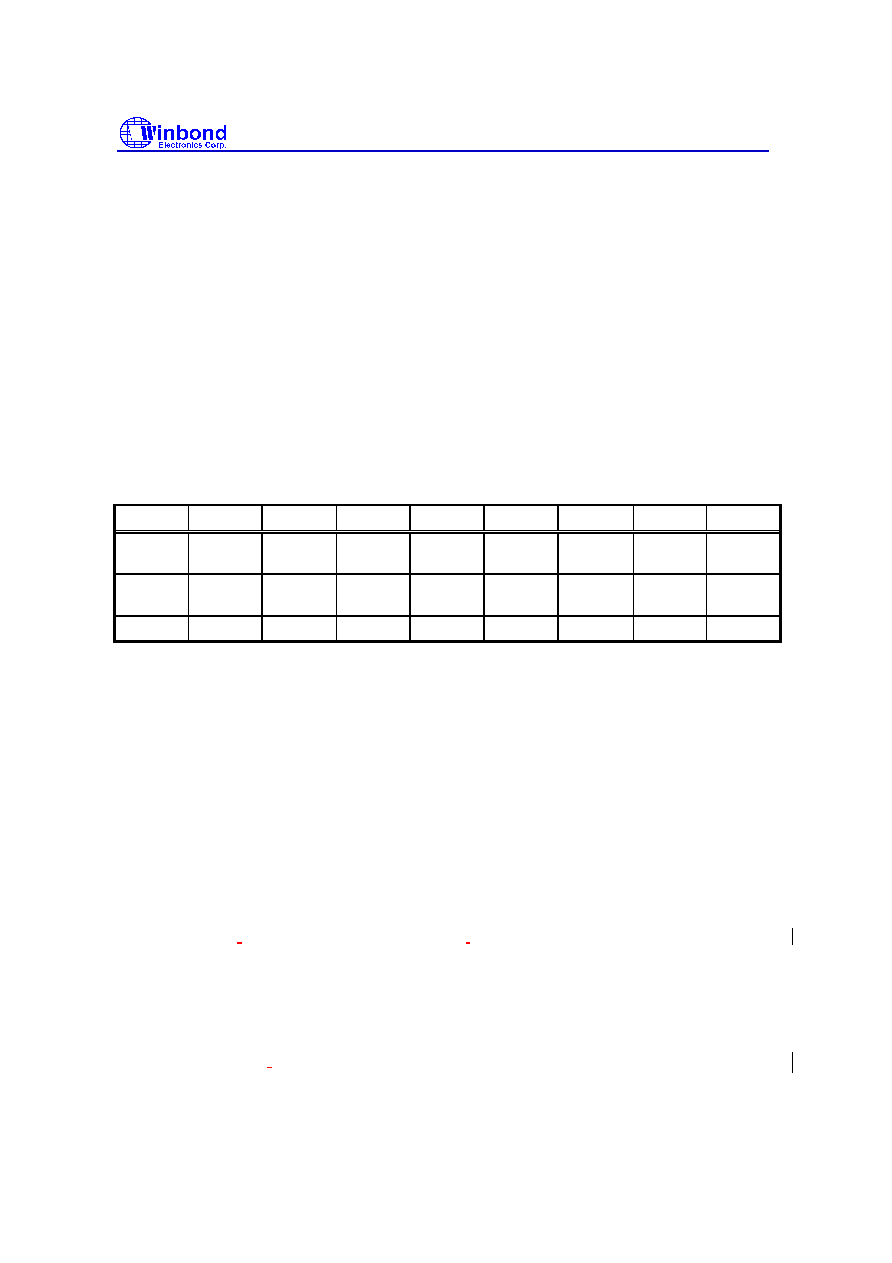
W83877ATF
Publication Release Date: April 1998
- 56 - Version 0.51
Bit 2:
MIR, FIR modes:
EN_DMA - Enable DMA
Enable DMA function to transmit or receive. Before using this, the DMA channel should
be select. If RX DMA channel is set and TX DMA channel is disabled, then the single
DMA channel is used. In the single channel system, the bit of D_CHSW (DMA channel
swap, in Set 2.Reg2.Bit3) will determine RX DMA channel or TX DMA channel.
Other modes:
Not used.
Bit 1, 0:
RTS, DTR
Functional definitions are the same as in legacy UART mode.
4.3.2.6 Set0.Reg5 - UART Status Register (USR)
Mode
B7
B6
B5
B4
B3
B2
B1
B0
Legacy
UART
RFEI
TSRE
TBRE
SBD
NSER
PBER
OER
RDR
Advanced
UART
LB_INFR
TSRE
TBRE
MX_LEX PHY_ERR CRC_ERR
OER
RDR
Reset Value
0
0
0
0
0
0
0
0
Legacy UART Register: These registers are defined the same as in the previous description.
Advanced UART Register:
Bit 7:
MIR, FIR modes:
LB_INFR - Last Byte In Frame End
Set to 1 when the last byte of a frame is in the FIFO bottom. This bit indicates that one
frame is separated from another frame when RX FIFO has more than one frame.
Bit 6, 5: Same as legacy UART description.
Bit 4:
MIR, FIR modes:
MX_LEX - Maximum Frame Length Exceed
Set to 1 when frame length from the receiver has exceeded the programmed frame
length
,
which is in SET4.Reg6 and Reg5.
If this bit is set to 1, the receiver will not receive
any data to RX FIFO.
Bit 3:
MIR, FIR modes:
PHY_ERR - Physical Layer Error
Set to 1 when an illegal data symbol is received, where the illegal data symbol is defined
in physical layer of IrDA version 1.1. When this bit is set to 1, the decoder of receiver will
be aborted
,
and a frame end signal is set to 1.
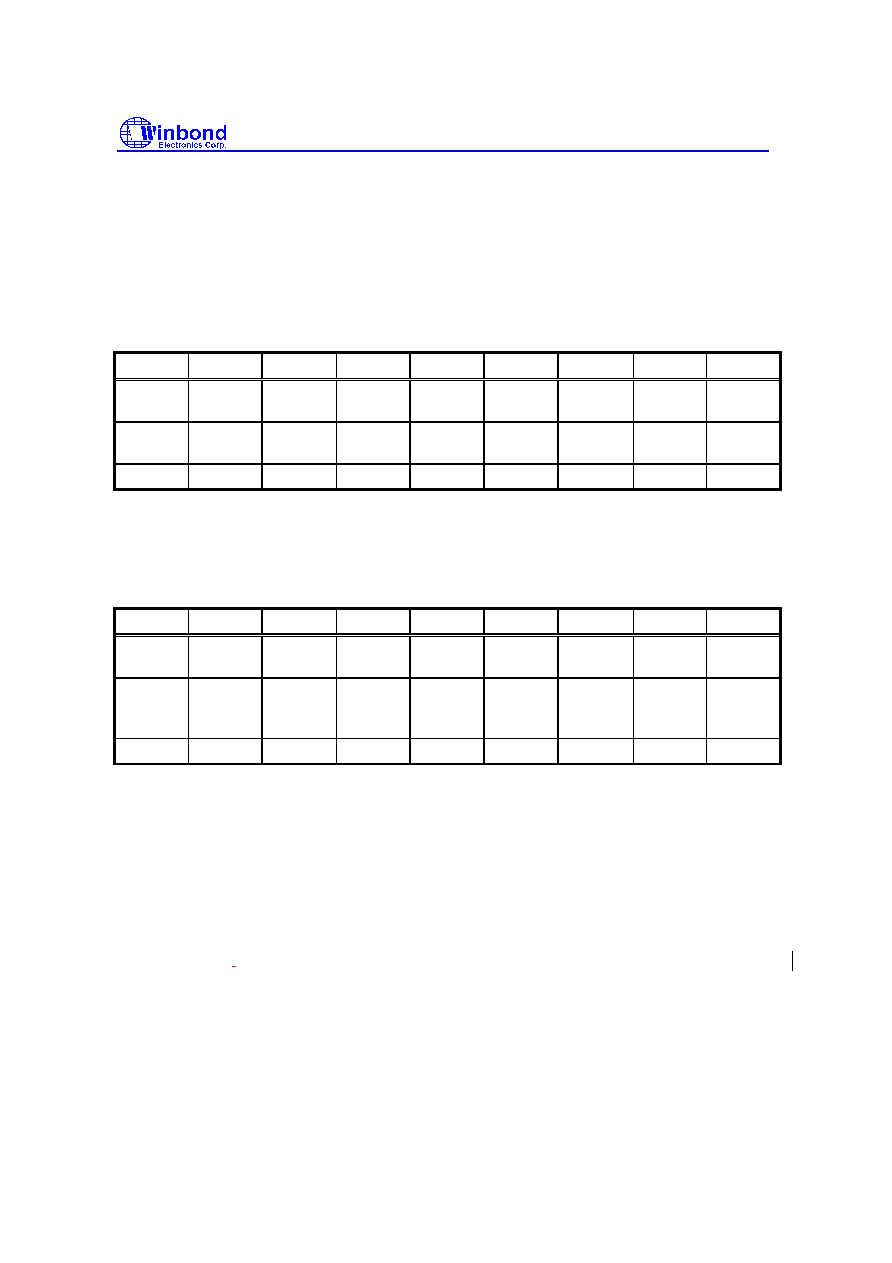
W83877ATF
Publication Release Date: April 1998
- 57 - Version 0.51
Bit 2:
MIR, FIR modes:
CRC_ERR - CRC Error
Set to 1 when an attached CRC is error.
Bit 1, 0:
OER - Overrun Error, RDR - RBR Data Ready
Definitions are same as for legacy UART.
4.3.2.7 Set0.Reg6 - Handshake Status Register (HSR)
Mode
B7
B6
B5
B4
B3
B2
B1
B0
Legacy
UART
DCD
RI
DSR
CTS
TDCD
FERI
TDSR
TCTS
Advanced
UART
DCD
RI
DSR
CTS
TDCD
FERI
TDSR
TCTS
Reset Value
0
0
0
0
0
0
0
0
Legacy/Advanced UART Register: These registers are defined the same as in the previous
description.
4.3.2.8 Set0.Reg7 - User Defined Register (UDR/AUDR)
Mode
Bit 7
Bit 6
Bit 5
Bit 4
Bit 3
Bit 2
Bit 1
Bit 0
Legacy
UART
Bit 7
Bit 6
Bit 5
Bit 4
Bit 3
Bit 2
Bit 1
Bit 0
Advanced
UART
FLC_ACT UNDRN RX_BSY/
RX_IP
LST_FE/
RX_PD
S_FEND
0
LB_SF
RX_TO
Reset Value
0
0
0
0
0
0
0
0
Legacy UART Register: These registers are defined the same as in the previous description.
Advanced UART Register:
Bit 7
MIR, FIR modes:
FLC_ACT - Flow Control Active
Set to 1 when flow control occurs. Clear to 0 when this register is read. Note that this will
be affected by Set5.Reg2 which controls the SIR mode switches to MIR/FIR mode or
when
MIR/FIR mode operated in DMA function switches to SIR mode.
Bit 6
MIR, FIR modes:
UNDRN - Underrun
Set to 1 when transmitter is empty
and not set S_FEND (in this register bit 3) operated in
PIO mode or not TC (Terminal Count) operated in DMA mode. Clear to 0 when write to 1.

W83877ATF
Publication Release Date: April 1998
- 58 - Version 0.51
Bit 5
MIR, FIR modes:
RX_BSY - Receiver Busy
Set to 1 when receiver is busy or active in process.
Remote IR mode:
RX_IP - Receiver in Process
Set to 1 when receiver is in process.
Bit 4:
MIR, FIR modes:
LST_FE - Lost Frame End
Set to 1 when a frame end for an entire frame is lost. Clear to 0 when read this register.
Remote IR modes:
RX_PD - Receiver Pulse Detected
Set to 1 when one or more than one remote pulses are detected. Clear to 0 when read
this register.
Bit 3
MIR, FIR modes:
S_FEND - Set a Frame End
Write to 1 when wanting to terminate the frame; that is, the procedure of PIO command is
An Entire Frame = Write Frame Data (First) + Write S_FEND (Last)
This bit should be set to 1, if used in PIO mode, to avoid transmitter underrun. Note that
this bit S_FEND is set to 1, that is, equivalent to TC (Terminal Count) in DMA mode.
This bit should therefore be set to 0 in DMA mode.
Bit 2:
Reserved.
Bit 1:
MIR, FIR modes:
LB_SF - Last Byte Stay in FIFO
Set to 1 that indicates one or more than one frame end still stay in receiver FIFO.
Bit 0:
MIR, FIR, Remote IR modes:
RX_TO - Receiver FIFO or Frame Status FIFO time-out
Set to 1 when receiver FIFO
or frame status FIFO occurs time-out
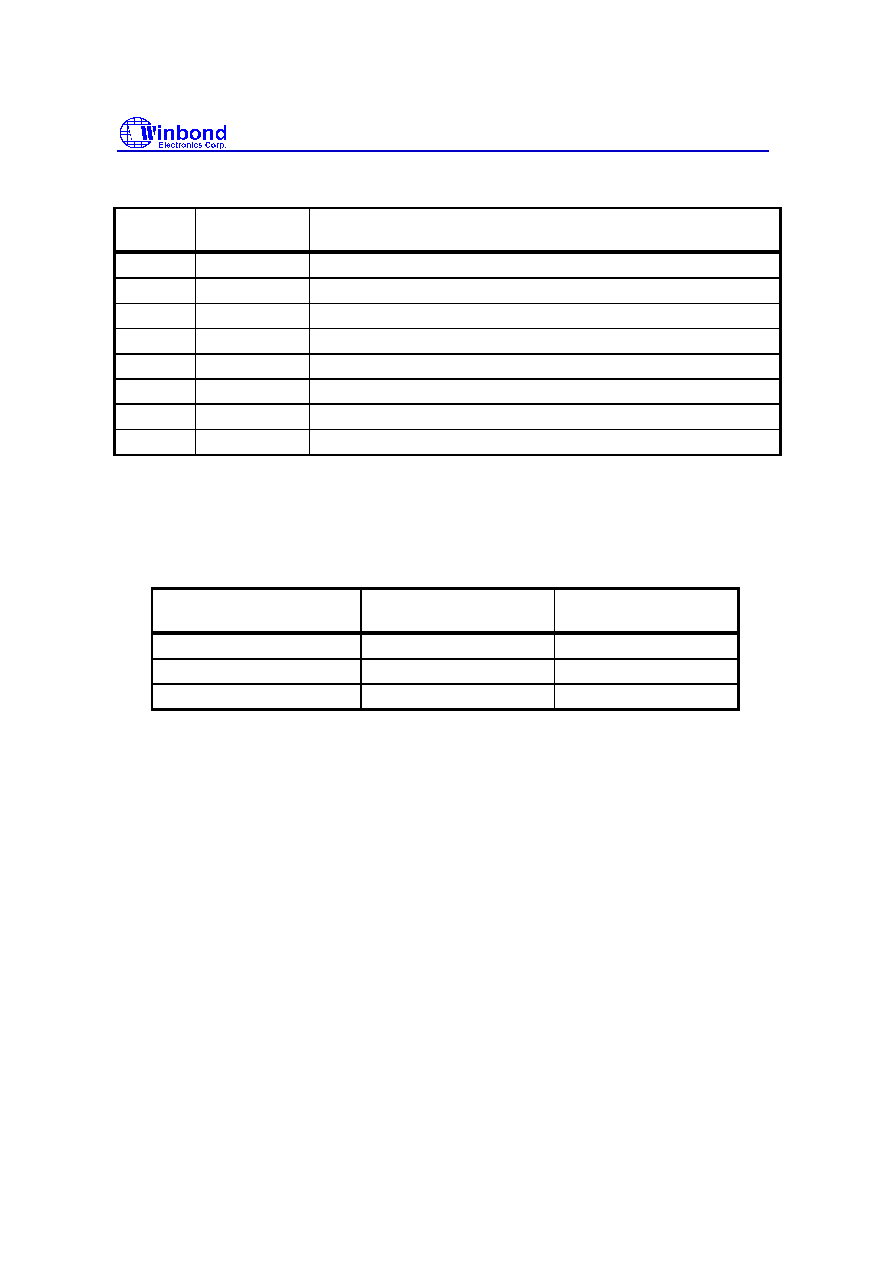
W83877ATF
Publication Release Date: April 1998
- 59 - Version 0.51
4.3.3 Set1 - Legacy Baud Rate Divisor Register
Address
Offset
Register Name
Register Description
0
BLL
Baud Rate Divisor Latch (Low Byte)
1
BHL
Baud Rate Divisor Latch (High Byte)
2
ISR/UFR
Interrupt Status
or UART FIFO Control Register
3
UCR/SSR
UART Control
or Sets Select Register
4
HCR
Handshake Control Register
5
USR
UART Status Register
6
HSR
Handshake Status Register
7
UDR/ESCR User Defined Register
4.3.3.1 Set1.Reg0~1 - Baud Rate Divisor Latch (BLL/BHL)
The two registers of BLL and BHL are baud rate divisor latch in the legacy UART/SIR/ASK-IR mode.
Read/Write these registers, if set in Advanced UART mode, will occur backward operation, that is, will
go to legacy UART mode and clear some register values shown in the table below.
Set & Register
Advanced Mode
DIS_BACK=
�
Legacy Mode
DIS_BACK=0
Set 0.Reg 4
Bit 7~5
-
Set 2.Reg 2
Bit 0, 5, 7
Bit 5, 7
Set 4.Reg 3
Bit 2, 3
-
Note that DIS_BACK=1 (Disable Backward operation) in legacy UART/SIR/ASK-IR mode will not
affect any register which can operate legacy SIR/ASK-IR.
4.3.3.2 Set1.Reg 2~7
These registers are defined the same as the Set 0 registers.

W83877ATF
Publication Release Date: April 1998
- 60 - Version 0.51
4.3.4 Set2 - Interrupt Status or UART FIFO Control Register (ISR/UFR)
These registers are only used in advanced modes.
Address
Offset
Register Name
Register Description
0
ABLL
Advanced Baud Rate Divisor Latch (Low Byte)
1
ABHL
Advanced Baud Rate Divisor Latch (High Byte)
2
ADCR1
Advanced UART Control Register 1
3
SSR
Sets Select Register
4
ADCR2
Advanced UART Control Register 2
5
Reserved
-
6
TXFDTH
Transmitter FIFO Depth
7
RXFDTH
Receiver FIFO Depth
4.3.4.1 Reg0, 1 - Advanced Baud Rate Divisor Latch (ABLL/ABHL)
The two registers are the same as the legacy UART baud rate divisor latch in SET 1. Reg0~1. When
using advanced UART/SIR/ASK-IR mode operation, these registers should be programmed to set
baud rate. This is to prevent a backward operation occurring.
4.3.4.2 Reg2 - Advanced UART Control Register 1 (ADCR1)
Mode
Bit 7
Bit 6
Bit 5
Bit 4
Bit 3
Bit 2
Bit 1
Bit 0
Advanced
UART
BR_OUT
-
EN_LOUT D_CHSW ALOOP DMATHL DMA_F
ADV_SL
Reset Value
0
0
0
0
0
0
0
0
Bit 7:
BR_OUT - Baud Rate Clock Output
Write to 1 enables the programmed baud rate clock to output to DTR pin. This bit is the
only test baud rate divisor.
Bit 6:
Reserved, write 0.
Bit 5:
EN_LOUT - Enable Loopback Output
Write to 1 enables output of transmitter data to IRTX pin during doing loopback
operation. Setting this bit can check output data with internal data.
Bit 4:
D_CHSW - DMA TX/RX Channel Swap
If using signal DMA channel in MIR/FIR mode, then the DMA channel can be swapped.
D_CHSW
DMA Channel Selected
0
Receiver (Default)
1
Transmitter
Write to 1 enables output data during the ALOOP=1.
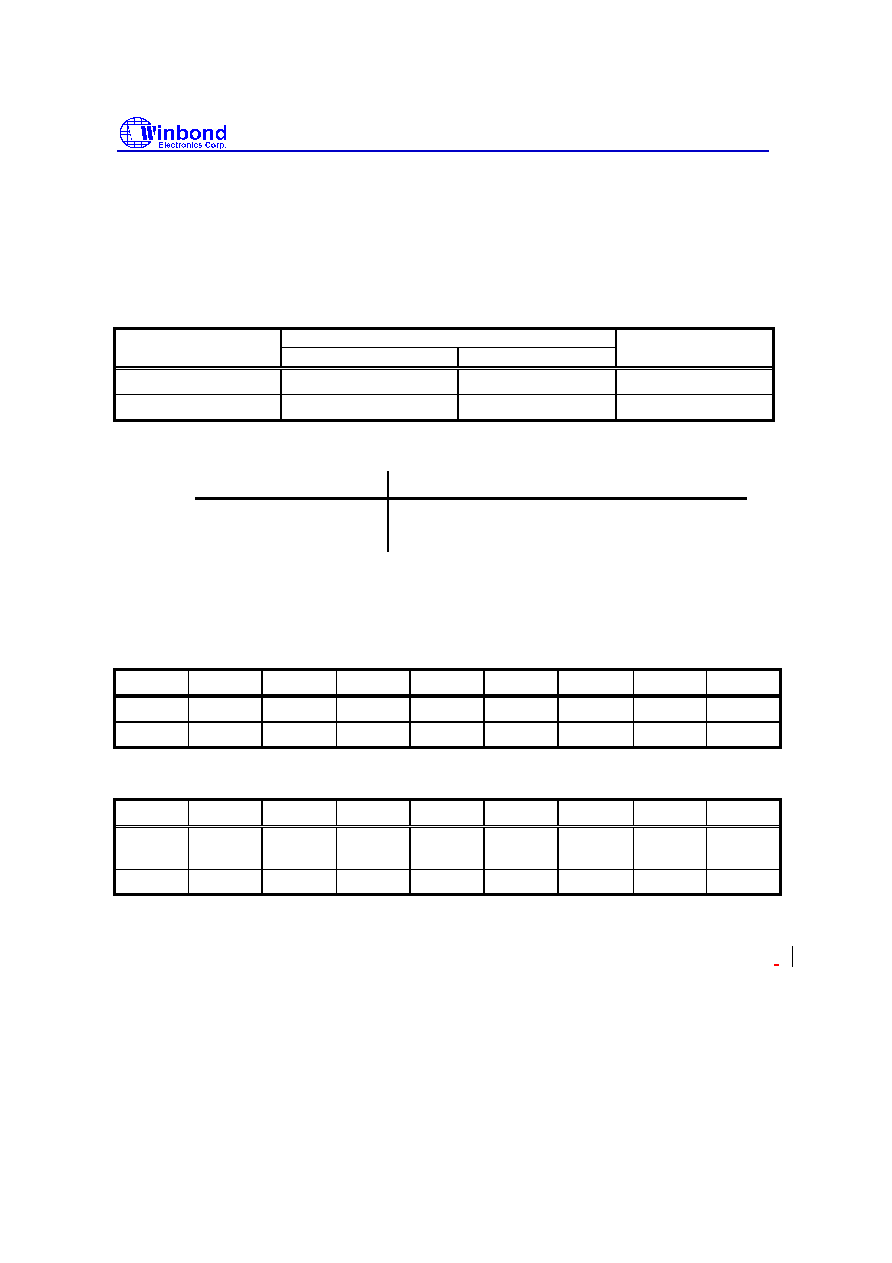
W83877ATF
Publication Release Date: April 1998
- 61 - Version 0.51
Bit 3:
ALOOP - All mode Loopback
Write to 1 enables loopback in all modes.
Bit 2:
DMATHL - DMA Threshold Level
Sets DMA threshold level as shown in the table below.
DMATHL
TX FIFO Threshold
RX FIFO Threshold
16-Byte
32-Byte
(16/32-Byte)
0
13
13
4
1
23
7
10
Bit 1:
DMA_F - DMA Fairness
DMA_F
Function Description
0
DMA request (DREQ) is forced inactive after 10.5us
1
No effect on DMA request.
Bit 0:
ADV_SL - Advanced mode Select
Write to 1 selects advanced mode.
4.3.4.3 Reg3 - Sets Select Register (SSR)
Reading this register returns E0
16
. Write it to select other register Set.
Reg.
Bit 7
Bit 6
Bit 5
Bit 4
Bit 3
Bit 2
Bit 1
Bit 0
SSR
SSR7
SSR6
SSR5
SSR4
SSR3
SSR2
SRR1
SRR0
default Value
1
1
1
0
0
0
0
0
4.3.4.4 Reg4 - Advanced UART Control Register 2 (ADCR2)
Mode
Bit 7
Bit 6
Bit 5
Bit 4
Bit 3
Bit 2
Bit 1
Bit 0
Advanced
UART
DIS_BAC
K
-
PR_DIV1 PR_DIV0 RX_FSZ1 RX_FSZ0 TX_FSZ1 TXFSZ0
Reset Value
0
0
0
0
0
0
0
0
Bit 7:
DIS_BACK - Disable Backward Operation
Write to 1, read
or write BLL or BHL (Baud rate Divisor Latch Register, in Set1.Reg0~1)
,
will disable backward legacy UART mode. When using legacy SIR/ASK-IR mode, this bit
should be set to 1 to avoid backward operation.
Bit 6:
Reserved, write 0.

W83877ATF
Publication Release Date: April 1998
- 62 - Version 0.51
Bit 5, 4:
PR_DIV1~0 - Pre-Divisor 1~0.
These bits select pre-divisor for external input clock 24M Hz. The clock through the pre-
divisor then inputs to baud rate divisor of UART.
PR_DIV1~0
Pre-divisor
Max. Baud Rate
00
13.0
115.2K bps
01
1.625
921.6K bps
10
6.5
230.4K bps
11
1
1.5M bps
Bit 3, 2:
RX_FSZ1~0 - Receiver FIFO Size 1~0
These bits setup receiver FIFO size when FIFO is enabled.
RX_FSZ1~0
RX FIFO Size
00
16-Byte
01
32-Byte
1X
Reserved
Bit 2, 0:
TX_FSZ1~0 - Transmitter FIFO Size 1~0
These bits setup transmitter FIFO size when FIFO is enabled.
TX_FSZ1~0
TX FIFO Size
00
16-Byte
01
32-Byte
1X
Reserved
4.3.4.5 Reg6 - Transmitter FIFO Depth (TXFDTH) (Read Only)
Mode
Bit 7
Bit 6
Bit 5
Bit 4
Bit 3
Bit 2
Bit 1
Bit 0
Advanced
UART
0
0
TXFD5
TXFD4
TXFD3
TXFD2
TXFD1
TXFD1
Reset Value
0
0
0
0
0
0
0
0
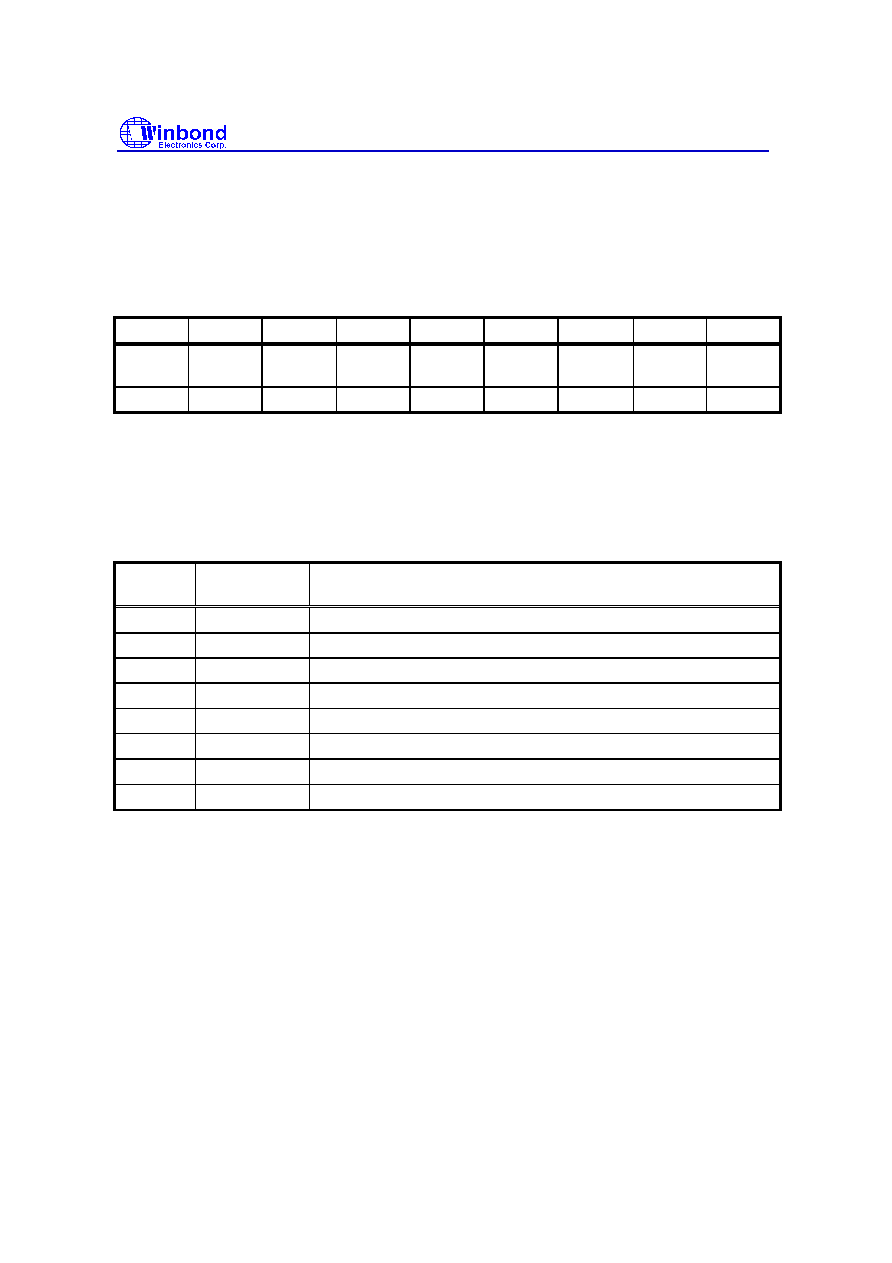
W83877ATF
Publication Release Date: April 1998
- 63 - Version 0.51
Bit 7~6:
Reserved, Read 0.
Bit 5~0:
Reading these bits will return the current transmitter FIFO depth, that is, how many bytes
there are in the transmitter FIFO.
4.3.4.6 Reg7 - Receiver FIFO Depth (RXFDTH) (Read Only)
Mode
Bit 7
Bit 6
Bit 5
Bit 4
Bit 3
Bit 2
Bit 1
Bit 0
Advanced
UART
0
0
RXFD5
RXFD4
RXFD3
RXFD2
RXFD1
RXFD1
Reset Value
0
0
0
0
0
0
0
0
Bit 7~6:
Reserved, Read 0.
Bit 5~0:
Read these bits will return the current receiver FIFO depth, that is, how many bytes there
are in the receiver FIFO.
4.3.5 Set3 - Version ID and Mapped Control Registers
Address
Offset
Register Name
Register Description
0
AUID
Advanced UART ID
1
MP_UCR
Mapped UART Control Register
2
MP_UFR
Mapped UART FIFO Control Register
3
SSR
Sets Select Register
4
Reversed
-
5
Reserved
-
6
Reserved
-
7
Reserved
-
4.3.5.1 Reg0 - Advanced UART ID (AUID)
This register is read only. Indicates advanced UART version ID. Read it and return 1X
16
.
4.3.5.2 Reg1 - Mapped UART Control Register (MP_UCR)
Read only. Reading this register that returns UART Control Register value of Set 0.
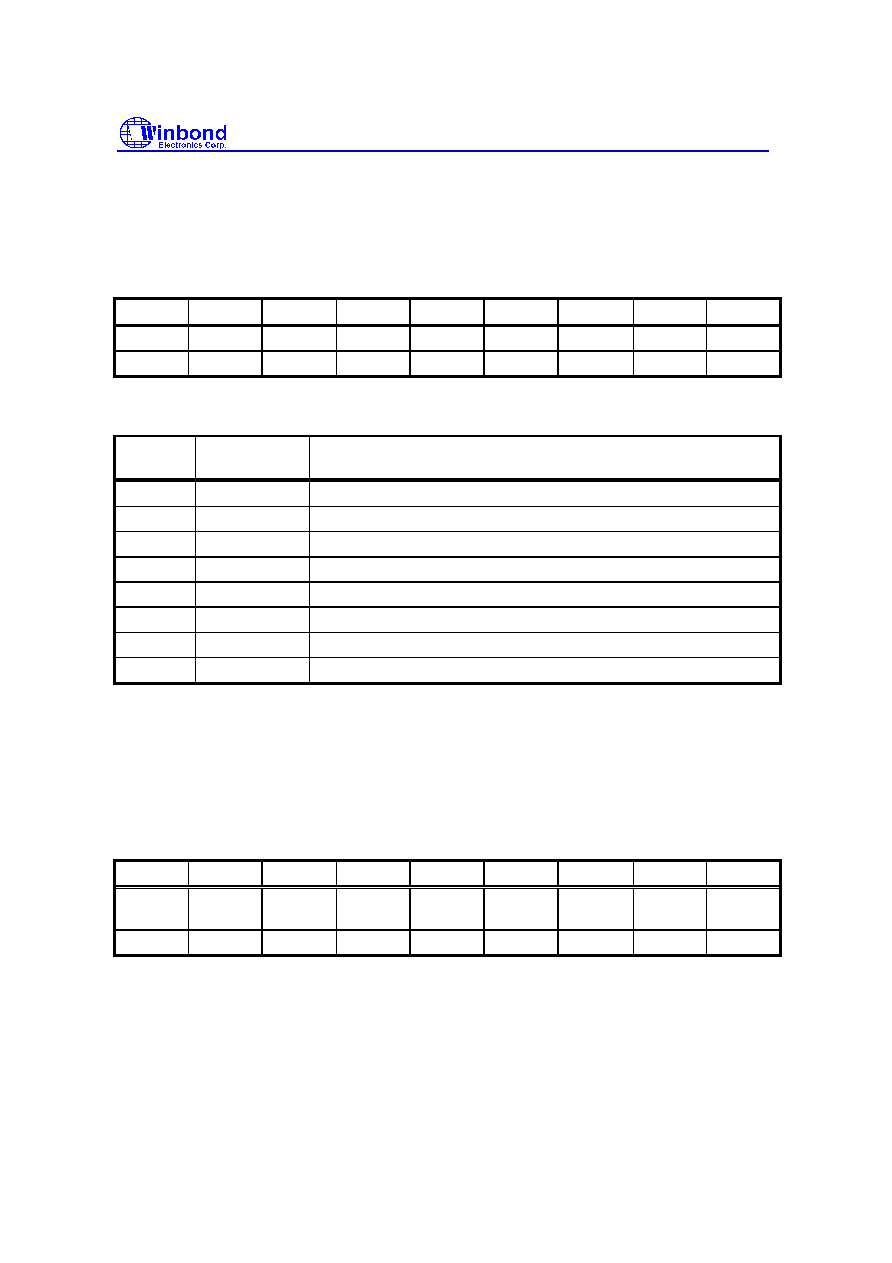
W83877ATF
Publication Release Date: April 1998
- 64 - Version 0.51
4.3.5.3 Reg2 - Mapped UART FIFO Control Register (MP_UFR)
Read only. Reading this register returns UART FIFO Control Register (UFR) value of SET 0.
4.3.5.4 Reg3 - Sets Select Register (SSR)
Reading this register returns E4
16
. Write it to select other register Set.
Reg.
Bit 7
Bit 6
Bit 5
Bit 4
Bit 3
Bit 2
Bit 1
Bit 0
SSR
SSR7
SSR6
SSR5
SSR4
SSR3
SSR2
SRR1
SRR0
default Value
1
1
1
0
0
1
0
0
4.3.6 Set4 - TX/RX/Timer counter registers and IR control registers.
Address
Offset
Register Name
Register Description
0
TMRL
Timer Value Low Byte
1
TMRH
Timer Value High Byte
2
IR_MSL
Infrared mode Select
3
SSR
Sets Select Register
4
TFRLL
Transmitter Frame Length Low Byte
5
TFRLH
Transmitter Frame Length High Byte
6
RFRLL
Receiver Frame Length Low Byte
7
RFRLH
Receiver Frame Length High Byte
4.3.6.1 Set4.Reg0, 1 - Timer Value Register (TMRL/TMRH)
This is a 12-bit timer with resolution of 1 ms, that is, the programmed maximum time is 2
12
-1 ms. The
timer is a down-counter. The timer starts down count when the bit EN_TMR (Enable Timer) of
Set4.Reg2. is set to 1. When the timer down counts to
zero and EN_TMR=1, the TMR_I is set to 1.
When the counter down counts to zero, a new initial value will be re-loaded into timer counter.
4.3.6.2 Set4.Reg2 - Infrared mode Select (IR_MSL)
Mode
Bit 7
Bit 6
Bit 5
Bit 4
Bit 3
Bit 2
Bit 1
Bit 0
Advanced
UART
-
-
-
-
IR_MSL1 IR_MSL0 TMR_TST EN_TMR
Reset Value
0
0
0
0
0
0
0
0

W83877ATF
Publication Release Date: April 1998
- 65 - Version 0.51
Bit 7~4:
Reserved, write to 0.
Bit 3, 2:
IR_MSL1, 0 - Infrared mode Select
Select legacy UART or SIR or ASK-IR mode. Note that using legacy SIR/ASK-IR should set
DIS_BACK=1 to avoid backward operation when programming baud rate. Mode selected is
shown below. Note that to avoid legacy backward operation, the bit of DIS_BACK (Disable
Backward, in Set2.Reg4. Bit7) should be set to 1 when legacy ASK-IR mode or legacy SIR
mode is selected.
IR_MSL1, 0
Operation Mode Selected
00
Legacy
UART
01
Reserved
10
Legacy
ASK-IR
11
Legacy
SIR
Bit 1:
TMR_TST - Timer Test
Write to 1 will cause reading the TMRL/TMRH will return the programmed values of
TMRL/TMRH, that is, it does not return down count counter value. This bit is for test timer
register.
Bit 0:
EN_TMR - Enable Timer
Write to 1 enables the timer.
4.3.6.3 Set4.Reg3 - Set Select Register (SSR)
Reading this register returns E8
16
. A write to this register selects other Set.
Reg.
Bit 7
Bit 6
Bit 5
Bit 4
Bit 3
Bit 2
Bit 1
Bit 0
SSR
SSR7
SSR6
SSR5
SSR4
SSR3
SSR2
SRR1
SRR0
default Value
1
1
1
1
1
0
0
0
4.3.6.4 Set4.Reg4, 5 - Transmitter Frame Length (TFRLL/TFRLH)
Reg.
Bit 7
Bit 6
Bit 5
Bit 4
Bit 3
Bit 2
Bit 1
Bit 0
TFRLL
bit 7
bit 6
bit 5
bit 4
bit3
bit 2
bit 1
bit 0
Reset Value
0
0
0
0
0
0
0
0
TFRLH
-
-
-
bit 12
bit 11
bit 10
bit 9
bit 8
Reset Value
-
-
-
0
0
0
0
0
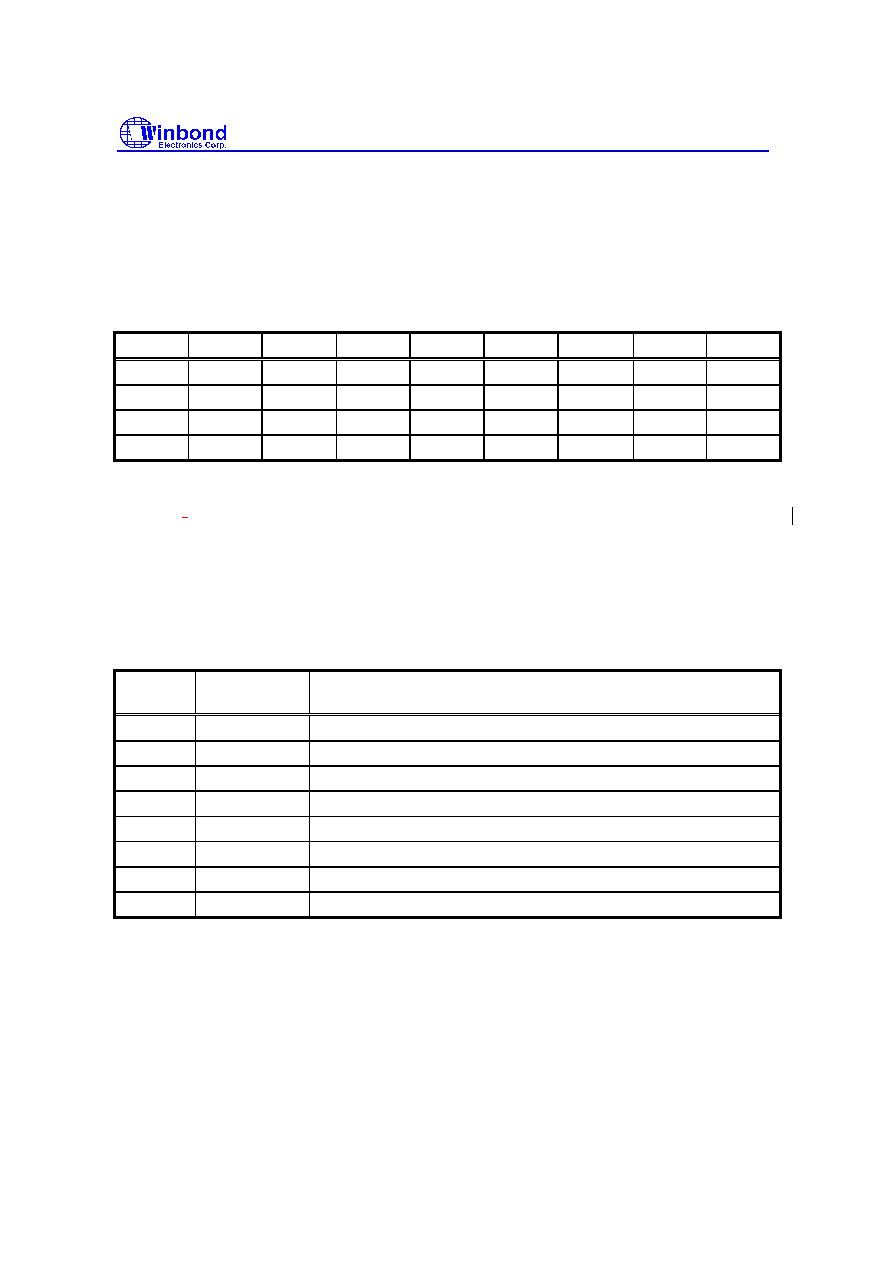
W83877ATF
Publication Release Date: April 1998
- 66 - Version 0.51
These are 13-bit registers. A write to these registers will cause the transmitter frame length of a
package be programmed. These registers are only used in APM=1 (automatic package mode,
Set5.Reg4.bit5). When APM=1, the physical layer will split data stream to a programmed frame
length if the transmitted data is larger than the programmed frame length. When these registers are
read, they will return the number of bytes which have not been transmitted from a frame length
programmed.
4.3.6.5 Set4.Reg6, 7 - Receiver Frame Length (RFRLL/RFRLH)
Reg.
Bit 7
Bit 6
Bit 5
Bit 4
Bit 3
Bit 2
Bit 1
Bit 0
RFRLL
bit 7
bit 6
bit 5
bit 4
bit 3
bit 2
bit 1
bit 0
Reset Value
0
0
0
0
0
0
0
0
RFRLH
-
-
-
bit 12
bit 11
bit 10
bit 9
bit 8
Reset Value
-
-
-
0
0
0
0
0
These are 13-bit registers which combine to form a 13-bit up counter. By programming these
registers,
the receiver frame length will be limited to the programmed frame length. If the received
frame length is larger than the programmed receiver frame length, the bit of MX_LEX (Maximum
Length Exceed) will be set to 1. Simultaneously, the receiver will not receive any data to RX FIFO
until the next start flag in the next frame, which is defined in the physical layer IrDA 1.1, is reached;
the received data then begins to write to RX FIFO. Reading these registers will return the number of
received data bytes from the receiver for a frame.
4.3.7 Set 5 - Flow control and IR control and Frame Status FIFO registers
Address
Offset
Register Name
Register Description
0
FCBLL
Flow Control Baud Rate Divisor Latch Register (Low Byte)
1
FCBHL
Flow Control Baud Rate Divisor Latch Register (High Byte)
2
FC_MD
Flow Control Mode Operation
3
SSR
Sets Select Register
4
IRCFG1
Infrared Config Register
5
FS_FO
Frame Status FIFO Register
6
RFRLFL
Receiver Frame Length FIFO Low Byte
7
RFRLFH
Receiver Frame Length FIFO High Byte
4.3.7.1 Set5.Reg0, 1 - Flow Control Baud Rate Divisor Latch Register (FCDLL/ FCDHL)
If flow control occurs from MIR/FIR mode change to SIR mode, then the pre-programming baud rate
of FCBLL/FCBHL is loaded to advanced baud rate divisor latch (ADBLL/ADBHL).

W83877ATF
Publication Release Date: April 1998
- 67 - Version 0.51
4.3.7.2 Set5.Reg2 - Flow Control mode Operation (FC_MD)
These registers control flow control mode operation as shown in the table below.
Reg.
Bit 7
Bit 6
Bit 5
Bit 4
Bit 3
Bit 2
Bit 1
Bit 0
FC_MD FC_MD2 FC_MD1 FC_MD0
-
FC_DSW EN_FD EN_BRFC EN_FC
Reset Value
0
0
0
0
0
0
0
0
Bit 7~5
FC_MD2 - Flow Control mode
When flow control state occurs, these bits will be loaded to AD_MD2~0 of advanced HSR
(Handshake Status Register). These three bits are defined the same as AD_MD2~0.
Bit 4:
Reserved, write 0.
Bit 3:
FC_DSW - Flow Control DMA Channel Swap
Write to 1, when flow control state occurs enables DMA channel of both transmitter and
receiver to be swapped.
FC_DSW
Next Mode After Flow Control Occurred
0
Receiver Channel
1
Transmitter Channel
Bit 2:
EN_FD - Enable Flow DMA Control
Write to 1 enables use of DMA channel when flow control has occurred.
Bit 1:
EN_BRFC - Enable Baud Rate Flow Control
Write to 1 enables FC_BLL/FC_BHL (Flow Control Baud Rate Divider Latch, in
Set5.Reg1~0) to be loaded to advanced baud rate divisor latch (ADBLL/ADBHL, in
Set2.Reg1~0).
Bit 0:
EN_FC - Enable Flow Control
Write to 1 allows use of flow control function and activation of bit 7~1 of this register.
4.3.7.3 Set5.Reg3 - Sets Select Register (SSR)
A write to this register will change Set of register. Reading this register will return EC
16
.
Reg.
Bit 7
Bit 6
Bit 5
Bit 4
Bit 3
Bit 2
Bit 1
Bit 0
SSR
SSR7
SSR6
SSR5
SSR4
SSR3
SSR2
SRR1
SRR0
default Value
1
1
1
0
1
1
0
0
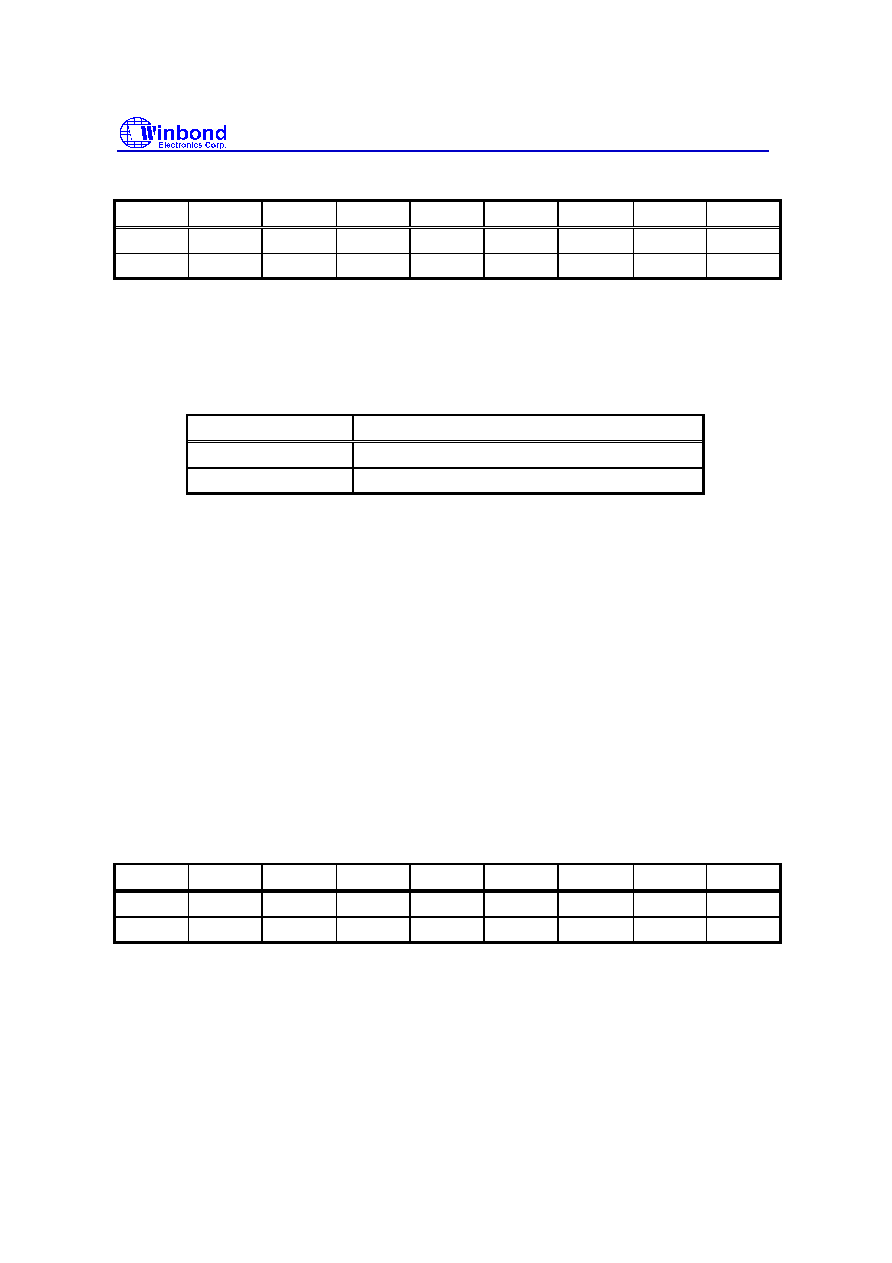
W83877ATF
Publication Release Date: April 1998
- 68 - Version 0.51
4.3.7.4 Set5.Reg4 - Infrared Config Register 1 (IRCFG1)
Reg.
Bit 7
Bit 6
Bit 5
Bit 4
Bit 3
Bit 2
Bit 1
Bit 0
IRCFG1
-
FSF_TH FEND_M AUX_RX
-
-
IRHSSL IR_FULL
Reset Value
0
0
0
0
0
0
0
0
Bit 7:
Reserved, write 0.
Bit 6:
FSF_TH - Frame Status FIFO Threshold
Set this bit to determine the frame status FIFO threshold level and to generate the
FSF_I. The threshold level values are defined as follows.
FSF_TH
Status FIFO Threshold Level
0
2
1
4
Bit 5:
FEND_MD - Frame End mode
Write to 1 enables hardware automatically to split same length frame defined Set4.Reg4
and Set4.Reg5, i.e., TFRLL/TFRLH.
Bit 4:
AUX_RX - Auxiliary Receiver Pin
Write to 1 selects IRRX input pin. (Refer to Set7.Reg7.Bit5)
Bit 3~2:
Reserved, write 0.
Bit 1:
IRHSSL - Infrared Handshake Status Select
Write to 0 brings the HSR (Handshake Status Register) into normal operation the same
as UART. Write to 1 disables HSR; reading HSR will then return 30
16
.
Bit 0:
IR_FULL - Infrared Full Duplex Operation
Write to 0 will cause IR function to operate in half duplex. Write to 1 will cause IR
function to operate in full duplex.
4.3.7.5 Set5.Reg5 - Frame Status FIFO Register (FS_FO)
This register are indicated the FIFO bottom of frame status.
Reg.
Bit 7
Bit 6
Bit 5
Bit 4
Bit 3
Bit 2
Bit 1
Bit 0
FS_FO
FSFDR
LST_FR
-
MX_LEX PHY_ERR CRC_ERR RX_OV
FSF_OV
Reset Value
0
0
0
0
0
0
0
0
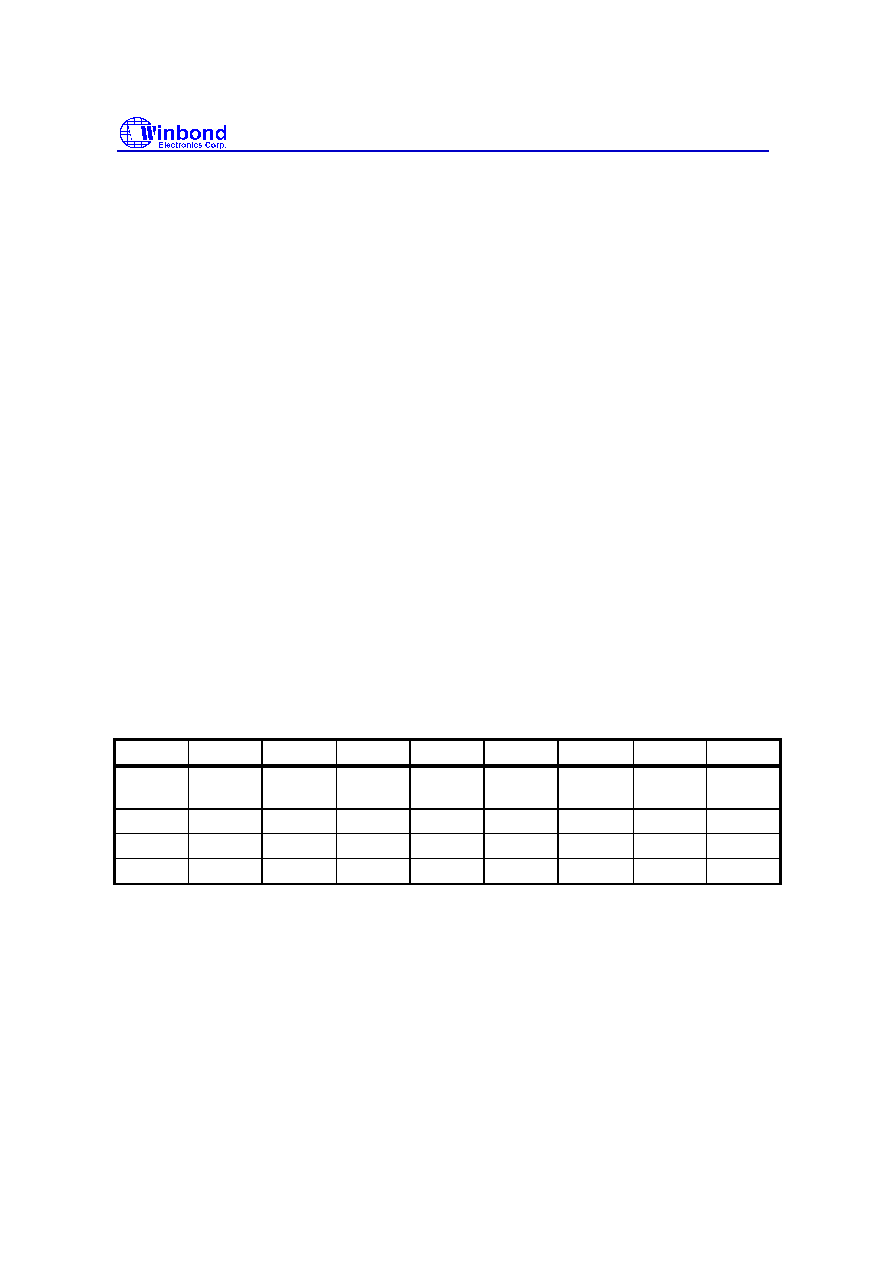
W83877ATF
Publication Release Date: April 1998
- 69 - Version 0.51
Bit 7:
FSFDR - Frame Status FIFO Data Ready
Indicates that there is valid data in frame status FIFO bottom.
Bit 6:
LST_FR - Lost Frame
Set to 1 when one or more than one frame has been lost.
Bit 5:
Reserved.
Bit 4:
MX_LEX - Maximum Frame Length Exceed
Set to 1 when programmed maximum frame length defined Set4.Reg6 and Set4.Reg7 are
exceeded. This bit is frame status FIFO bottom. Reading this bit will return a valid value
when FSFDR=1 (Frame Status FIFO Data Ready).
Bit 3:
PHY_ERR - Physical Error
During receiving data, any physical layer error, defined IrDA 1.1, will be set to 1 in this bit.
This bit is frame status FIFO bottom. Reading this bit will return a valid value when
FSFDR=1 (Frame Status FIFO Data Ready).
Bit 2:
CRC_ERR - CRC Error
Set to 1 when a bad CRC is received in a frame. This CRC belongs to physical layer
defined in IrDA 1.1. This bit is frame status FIFO bottom. Reading this bit will return a valid
value when FSFDR=1 (Frame Status FIFO Data Ready).
Bit 1:
RX_OV - Received Data Overrun
Set to 1 when Received data in FIFO overrun occurs.
Bit 0:
FSF_OV - Frame Status FIFO Overrun
Set to 1 When frame status FIFO overrun occurs.
4.3.7.5 Set5.Reg6, 7 - Receiver Frame Length FIFO (RFLFL/RFLFH) or Lost Frame Number
(LST_NU)
Reg.
Bit 7
Bit 6
Bit 5
Bit 4
Bit 3
Bit 2
Bit 1
Bit 0
RFLFL/
LST_NU
Bit 7
Bit 6
Bit 5
Bit 4
Bit 3
Bit 2
Bit 1
Bit 0
Reset Value
0
0
0
0
0
0
0
0
RFLFH
-
-
-
Bit 12
Bit 11
Bit 10
Bit 9
Bit 8
Reset Value
0
0
0
0
0
0
0
0
Receiver Frame Length FIFO (RFLFL/RFLFH):
These registers are 13-bit. Reading these registers will return received frame length. When read the
register of
RFLFH will pop-up another frame status and frame length if FSFDR=1 (Set5.Reg4.Bit7).
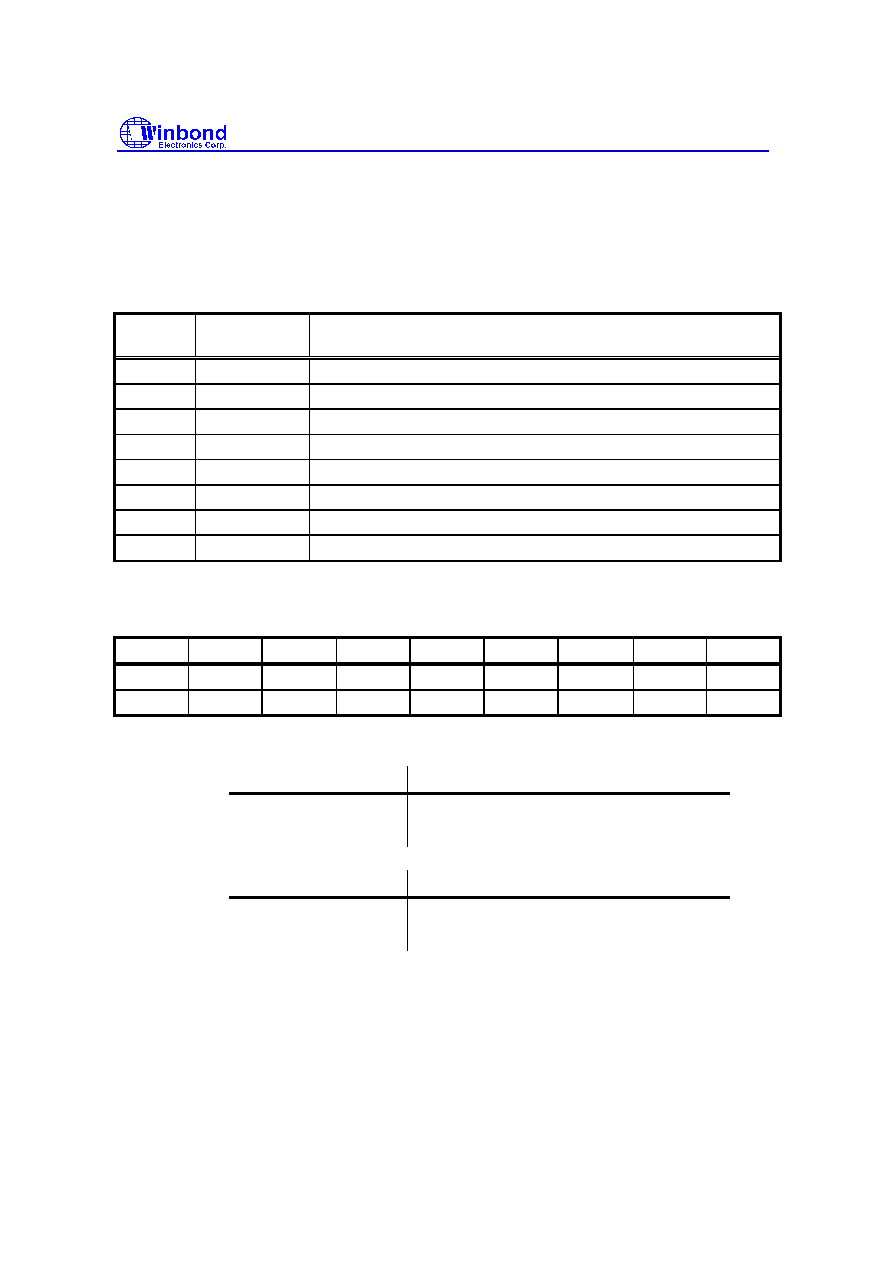
W83877ATF
Publication Release Date: April 1998
- 70 - Version 0.51
Lost Frame Number (LST_NU):
When LST_FR=1 (Set5.Reg4. Bit6), Reg6 is replaced to LST_NU, that is 8-bit register and read
RFLFH will return 0. When read the register of
RFLFH will pop-up another frame status and frame
length if FSFDR=1 (Set5.Reg4.Bit7).
4.3.8 Set6 - IR Physical Layer Control Registers
Address
Offset
Register Name
Register Description
0
IR_CFG2
Infrared Config Register 2
1
MIR_PW
MIR (1.152M bps or 0.576M bps) Pulse Width
2
SIR_PW
SIR Pulse Width
3
SSR
Sets Select Register
4
HIR_FNU
High Speed Infrared Flag Number
5
Reserved
-
6
Reserved
-
7
Reserved
-
4.3.8.1 Set6.Reg0 - Infrared Config Register 2 (IR_CFG2)
This register config ASK-IR, MIR, FIR operation function.
Reg.
Bit 7
Bit 6
Bit 5
Bit 4
Bit 3
Bit 2
Bit 1
Bit 0
IR_CFG2 SHMD_N SHDM_N FIR_CRC MIR_CRC
-
INV_CRC DIS_CRC
-
Reset Value
0
0
1
0
0
0
0
0
Bit 7:
SHMD_N - ASK-IR Modulation Disable
SHMD_N
Modulation Mode
0
SOUT modulate 500K Hz Square Wave
1
Re-rout SOUT
Bit 6:
SHDM_N - ASK-IR Demodulation Disable
SHDM_N
Demodulation Mode
0
Demodulation 500K Hz
1
Re-rout SIN
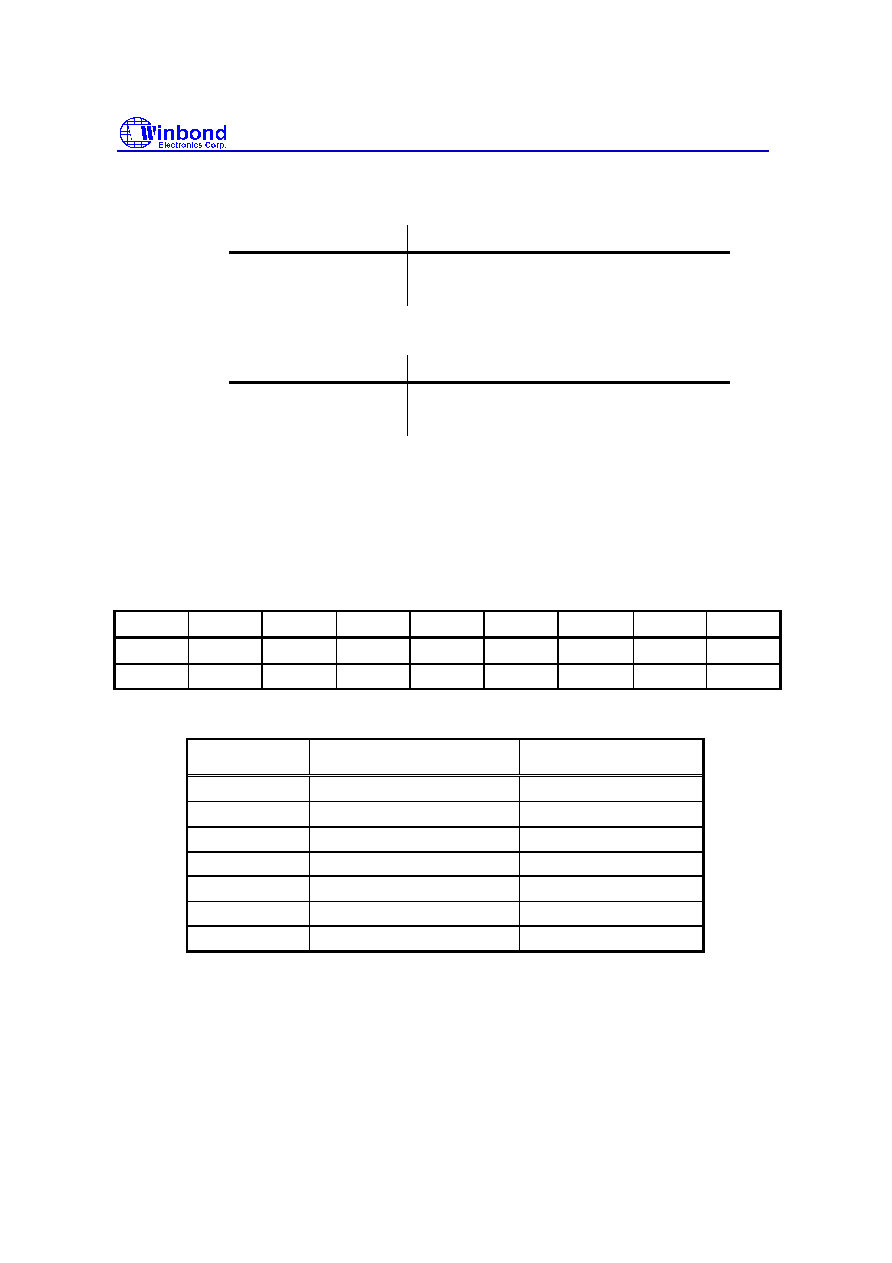
W83877ATF
Publication Release Date: April 1998
- 71 - Version 0.51
Bit 5:
FIR_CRC - FIR (4M bps) CRC Type
FIR_CRC
CRC Type
0
16-bit CRC
1
32-bit CRC
Note that the 16/32-bit CRC are defined in IrDA 1.1 physical layer.
Bit 4:
MIR_CRC - MIR (1.152M/0.576M bps) CRC Type
MIR_CRC
CRC Type
0
16-bit CRC
1
32-bit CRC
Bit 2:
INV_CRC - Inverting CRC
Write to 1 causes CRC inverted output in physical layer.
Bit 1:
DIS_CRC - Disable CRC
Write to 1 causes the transmitter not to transmit CRC in physical layer.
Bit 0:
Reserved, write 1.
4.3.8.2 Set6.Reg1 - MIR (1.152M/0.576M bps) Pulse Width
Reg.
Bit 7
Bit 6
Bit 5
Bit 4
Bit 3
Bit 2
Bit 1
Bit 0
MIR_PW
-
-
-
M_PW4
M_PW3
M_PW2
M_PW1
M_PW0
Reset Value
0
0
0
0
1
0
1
0
This 5-bit register is set MIR output pulse width.
M_PW4~0
MIR Pulse Width
(1.152M bps)
MIR Output Width
(0.576M bps)
00000
0 ns
0 ns
00001
20.83 ns
41.66 ns
00010
41.66 (==20.83*2) ns
83.32 (==41.66*2) ns
...
...
...
k
10
20.83*k
10
ns
41.66*k
10
ns
...
...
...
11111
645 ns
1290 ns
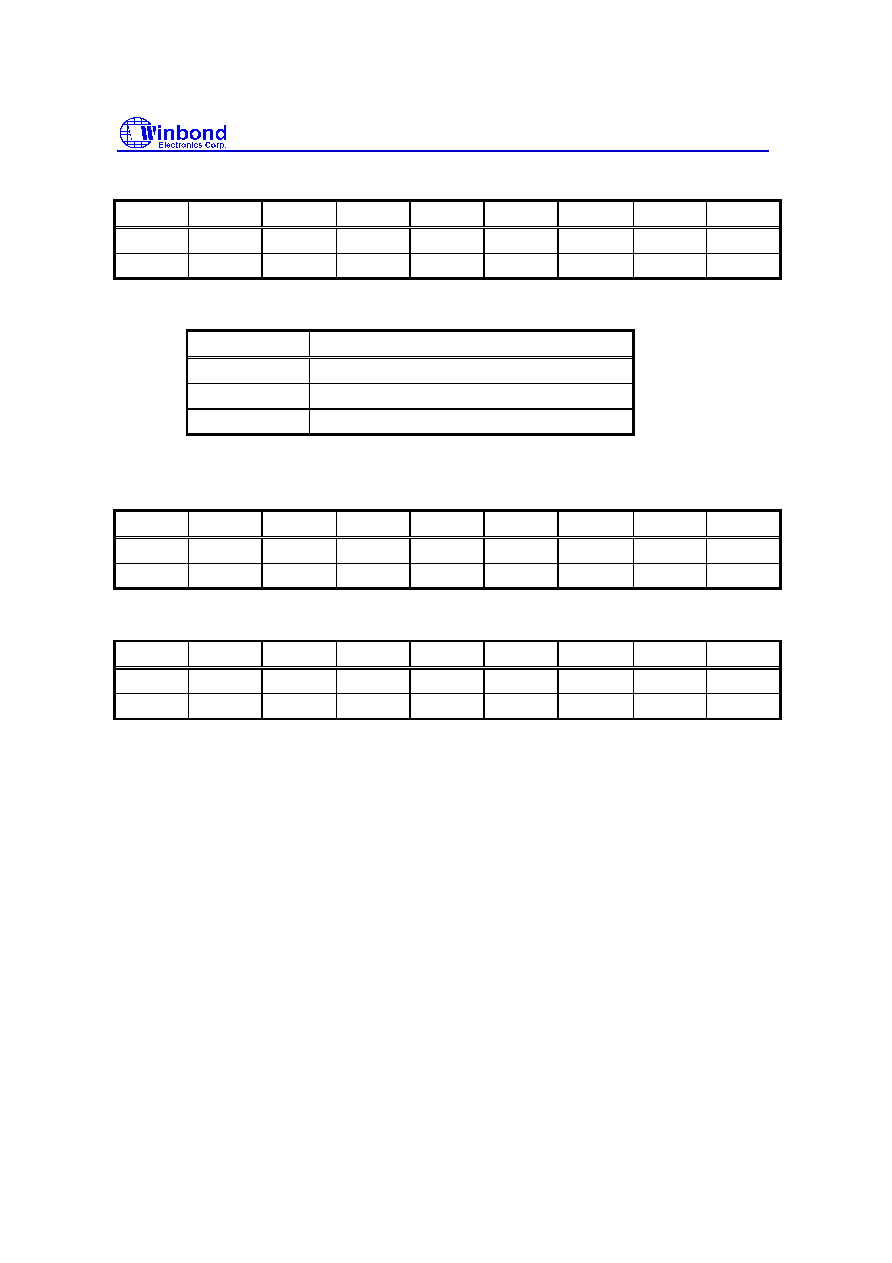
W83877ATF
Publication Release Date: April 1998
- 72 - Version 0.51
4.3.8.3 Set6.Reg2 - SIR Pulse Width
Reg.
Bit 7
Bit 6
Bit 5
Bit 4
Bit 3
Bit 2
Bit 1
Bit 0
SIR_PW
-
-
-
S_PW4
S_PW3
S_PW2
S_PW1
S_PW0
Reset Value
0
0
0
0
0
0
0
0
This 5-bit register is set SIR output pulse width.
S_PW4~0
SIR Output Pulse Width
00000
3/16 bit time of UART
01101
1.6 us
Others
1.6 us
4.3.8.4 Set6.Reg3 - Set Select Register
A write to this register will result in going to other Set. Reading this register returns F0
16
.
Reg.
Bit 7
Bit 6
Bit 5
Bit 4
Bit 3
Bit 2
Bit 1
Bit 0
SSR
SSR7
SSR6
SSR5
SSR4
SSR3
SSR2
SRR1
SRR0
default Value
1
1
1
1
0
0
0
0
4.3.8.5 Set6.Reg4 - High Speed Infrared Beginning Flag Number (HIR_FNU)
Reg.
Bit 7
Bit 6
Bit 5
Bit 4
Bit 3
Bit 2
Bit 1
Bit 0
HIR_FNU M_FG3
M_FG2
M_FG1
M_FG0
F_FL3
F_FL2
F_FL1
F_FL0
Reset Value
0
0
1
0
1
0
1
0
Bit 7~4:
M_FG3~0 - MIR beginning Flag Number
These bits define the number of transmitter
Start Flag of MIR. Note that the number of
MIR start flag should be equal to or more than
two which is defined in IrDA 1.1 physical
layer. The default value is 2.
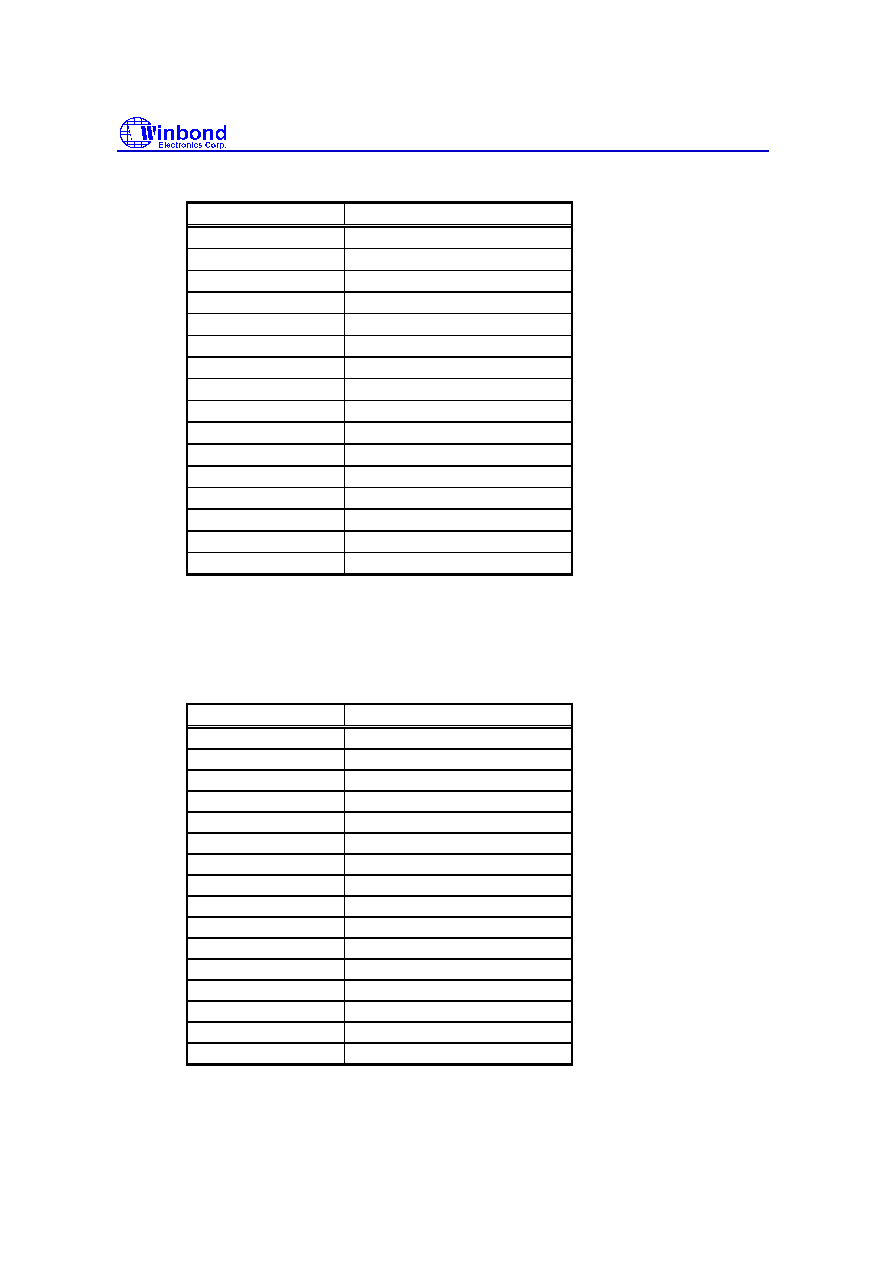
W83877ATF
Publication Release Date: April 1998
- 73 - Version 0.51
M_FG3~0
Beginning Flag Number
0000
Reserved
0001
1
0010
2 (Default)
0011
3
0100
4
0101
5
0110
6
0111
8
1000
10
1001
12
1010
16
1011
20
1100
24
1101
28
1110
32
1111
Reserved
Bit 3~0:
F_FG3~0 - FIR Beginning Flag Number
These bits define the number of transmitter
Preamble Flag in FIR. Note that the number
of FIR start flag should be equal to
sixteen which is defined in IrDA 1.1 physical layer.
The default value is 16.
M_FG3~0
Beginning Flag Number
0000
Reserved
0001
1
0010
2
0011
3
0100
4
0101
5
0110
6
0111
8
1000
10
1001
12
1010
16 (Default)
1011
20
1100
24
1101
28
1110
32
1111
Reserved
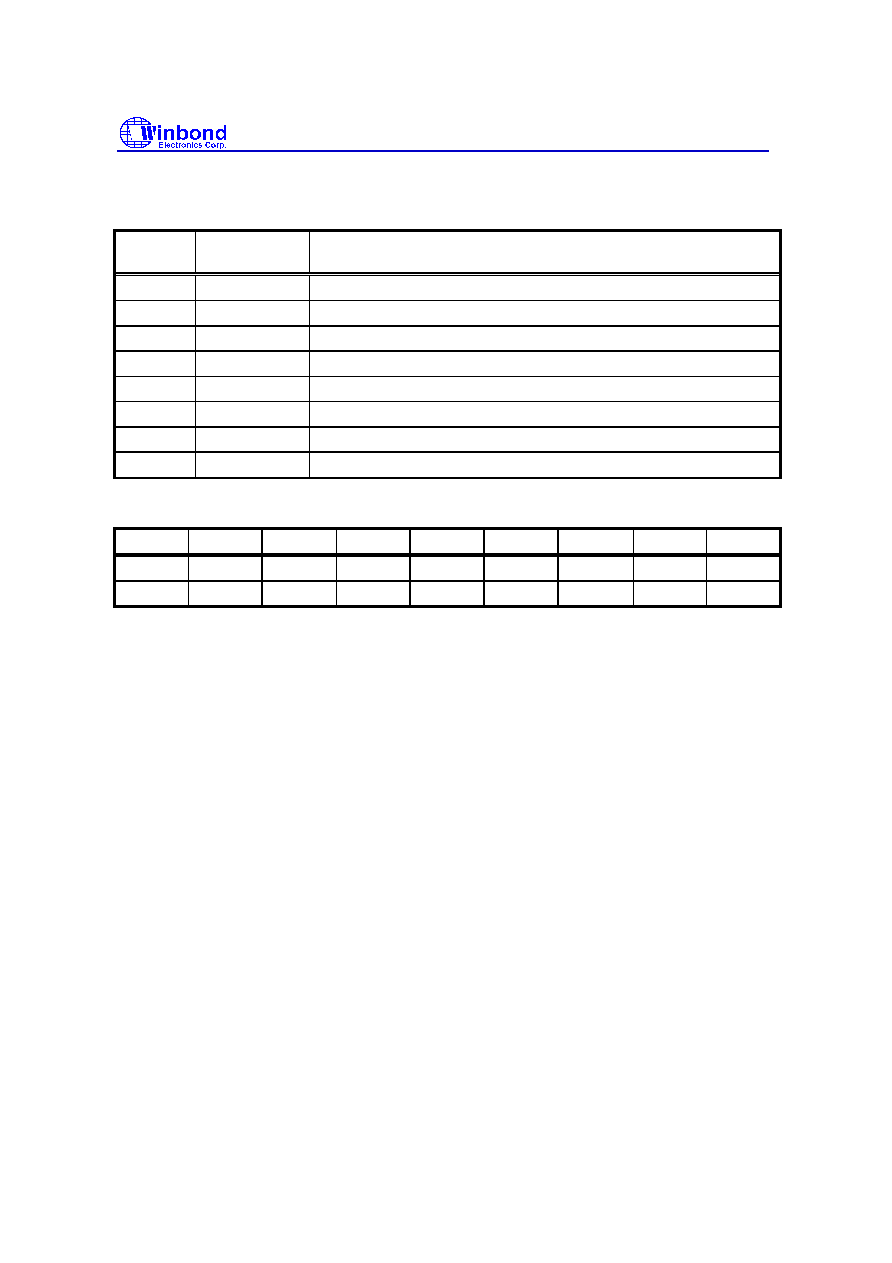
W83877ATF
Publication Release Date: April 1998
- 74 - Version 0.51
4.3.9 Set7 - Remote control and IR module selection registers
Address
Offset
Register Name
Register Description
0
RIR_RXC
Remote Infrared Receiver Control
1
RIR_TXC
Remote Infrared Transmitter Control
2
RIR_CFG
Remote Infrared Config Register
3
SSR
Sets Select Register
4
IRM_SL1
Infrared Module (Front End) Select 1
5
IRM_SL2
Infrared Module Select 2
6
IRM_SL3
Infrared Module Select 3
7
IRM_CR
Infrared Module Control Register
4.3.9.1 Set7.Reg0 - Remote Infrared Receiver Control (RIR_RXC)
Reg.
Bit 7
Bit 6
Bit 5
Bit 4
Bit 3
Bit 2
Bit 1
Bit 0
RIR_RXC RX_FR2 RX_FR1 RX_FR0 RX_FSL4 RX_FSL3 RX_FSL2 RX_FSL1 RX_FSL0
default Value
0
0
1
0
1
0
0
1
This register defines frequency ranges of receiver remote IR.
Bit 7~5:
RX_FR2~0 - Receiver Frequency Range 2~0.
These bits select the input frequency of the receiver ranges. For the input signal, that is
through a band pass filter, i.e., the frequency of the input signal is located at this defined
range then the signal will be received.
Bit 4~0:
RX_FSL4~0 - Receiver Frequency Select 4~0.
Select the receiver operation frequency.

W83877ATF
Publication Release Date: April 1998
- 75 - Version 0.51
Table: Low Frequency range select of receiver.
RX_FR2~0 (Low Frequency)
001
010
011
RX_FSL4~0
Min.
Max.
Min.
Max.
Min.
Max.
00010
26.1
29.6
24.7
31.7
23.4
34.2
00011
28.2
32.0
26.7
34.3
25.3
36.9
00100
29.4
33.3
27.8
35.7
26.3
38.4
00101
30.0
34.0
28.4
36.5
26.9
39.3
00110
31.4
35.6
29.6
38.1
28.1
41.0
00111
32.1
36.4
30.3
39.0
28.7
42.0
01000
32.8
37.2
31.0
39.8
29.4
42.9
01001
33.6*
38.1*
31.7
40.8
30.1
44.0
01011
34.4
39.0
32.5
41.8
30.8
45.0
01100
36.2
41.0
34.2
44.0
32.4
47.3
01101
37.2
42.1
35.1
45.1
33.2
48.6
01111
38.2
43.2
36.0
46.3
34.1
49.9
10000
40.3
45.7
38.1
49.0
36.1
52n.7
10010
41.5
47.1
39.2
50.4
37.2
54.3
10011
42.8
48.5
40.4
51.9
38.3
56.0
10101
44.1
50.0
41.7
53.6
39.5
57.7
10111
45.5
51.6
43.0
55.3
40.7
59.6
11010
48.7
55.2
46.0
59.1
43.6
63.7
11011
50.4
57.1
47.6
61.2
45.1
65.9
11101
54.3
61.5
51.3
65.9
48.6
71.0
Note that the other non-defined values are reserved.
Table: High Frequency range select of receiver
RX_FR2~0 (High Frequency)
001
RX_FSL4~0
Min.
Max.
00011
355.6
457.1
01000
380.1
489.8
01011
410.3
527.4
Note that the other non-defined values are reserved.
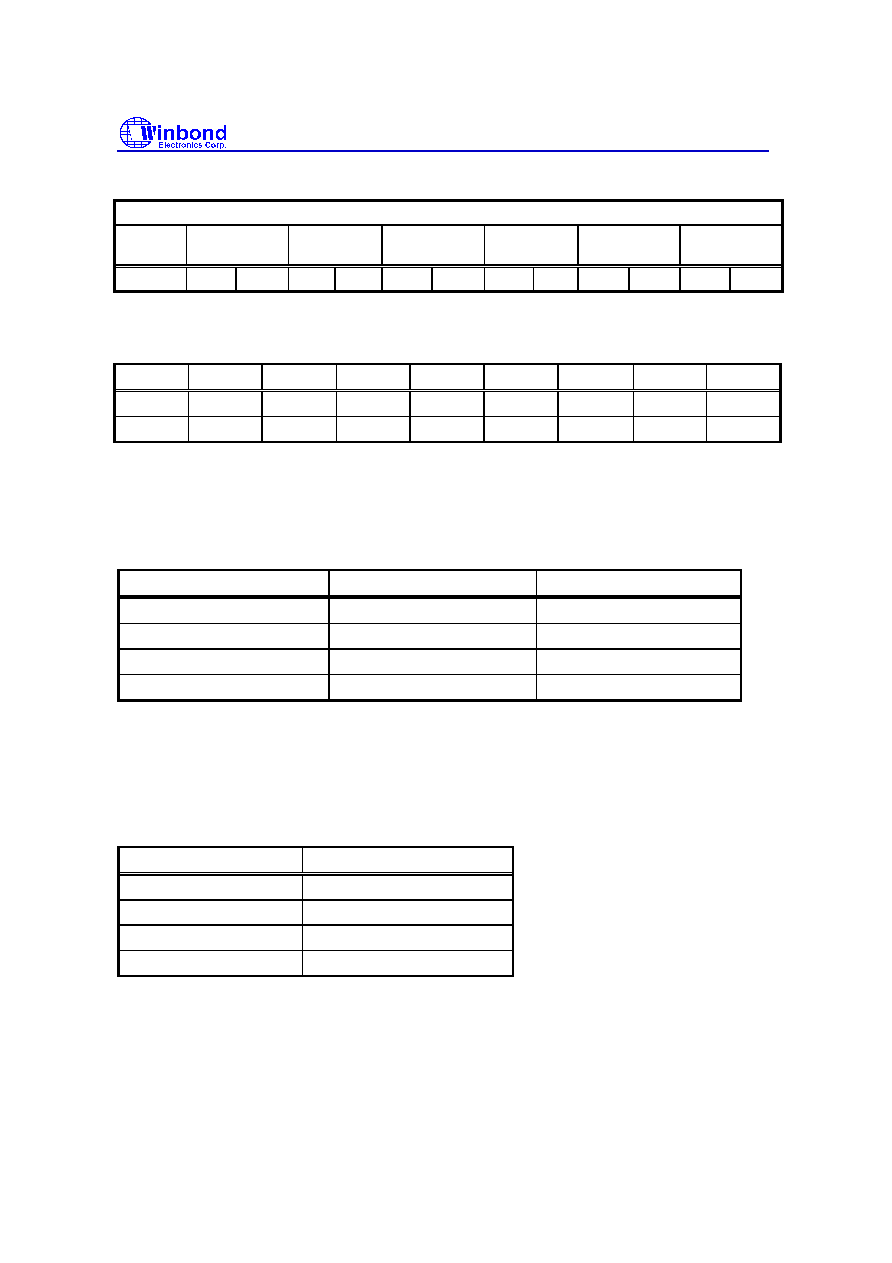
W83877ATF
Publication Release Date: April 1998
- 76 - Version 0.51
Table: SHARP ASK-IR receiver frequency range select.
RX_FSL4~0 (SHARP ASK-IR)
RX_FR2~
0
001
010
011
100
101
110
-
480.0* 533.3* 457.1 564.7 436.4 600.0 417.4 640.0 400.0 685.6 384.0 738.5
Note that the other non-defined values are reserved.
4.3.9.1 Set7.Reg1 - Remote Infrared Transmitter Control (RIR_TXC)
Reg.
Bit 7
Bit 6
Bit 5
Bit 4
Bit 3
Bit 2
Bit 1
Bit 0
RIR_TXC TX_PW2 TX_PW1 TX_PW0 TX_FSL4 TX_FSL3 TX_FSL2 TX_FSL1 TX_FSL0
default Value
0
1
1
0
1
0
0
1
This Register defines the transmitter frequency and pulse width of remote IR.
Bit 7~5:
TX_PW2~0 - Transmitter Pulse Width 2~ 0.
Selects the transmission pulse width.
TX_PW2~0
Low Frequency
High Frequency
010
6
�
s
0.7
�
s
011
7
�
s
0.8
�
s
100
9
�
s
0.9
�
s
101
10.6
�
s
1.0
�
s
Note that the other non-defined TX_PW are reserved.
Bit 4~0:
TX_FSL4~0 - Transmitter Frequency Select 4~0.
Selects the transmission frequency.
Table: Low frequency selected.
TX_FSL4~0
Low Frequency
00011
30K Hz
00100
31K HZ
...
...
11101
56K Hz
Note that the other non-defined TX_FSL4~0 are reserved.

W83877ATF
Publication Release Date: April 1998
- 77 - Version 0.51
Table: High frequency selected.
TX_FSL4~0
High Frequency
00011
400K Hz
01000
450K Hz
01011
480K Hz
Note that the other non-defined TX_FSL4~0 are reserved.
4.3.9.2 Set7.Reg2 - Remote Infrared Config Register (RIR_CFG)
Reg.
Bit 7
Bit 6
Bit 5
Bit 4
Bit 3
Bit 2
Bit 1
Bit 0
RIR_CFG P_PNB
SMP_M
RXCFS
-
TX_CFS
RX_DM TX_MM1 TX_MM0
default Value
0
0
0
0
0
0
0
0
Bit 7:
P_PNB: Programming Pulse Number Coding.
Write to 1 causes programming pulse number coding to be selected. The code format is
defined as follows.
B7 B6 B5 B4
B2 B1 B0
B3
Bit value
(Number of bits) - 1
If the bit value is set to 0, then the high pulse will be transmitted/received. If the bit value
is set to 1, then no energy will be transmitted/received.
Bit 6:
SMP_M - Sampling mode.
To choose receiver sampling mode.
Write to 0 causes T-period sampling to be used, so that the T-period is programmed
UART baud rate.
Write to 1 causes direct use of programmed baud rate to do over-sampling.
Bit 5:
RXCFS - Receiver Carry Frequency Select
RXCFS
Selected Frequency
0
30K ~ 56K Hz
1
400K ~ 480K Hz
Bit 4:
Reserved, write 0.
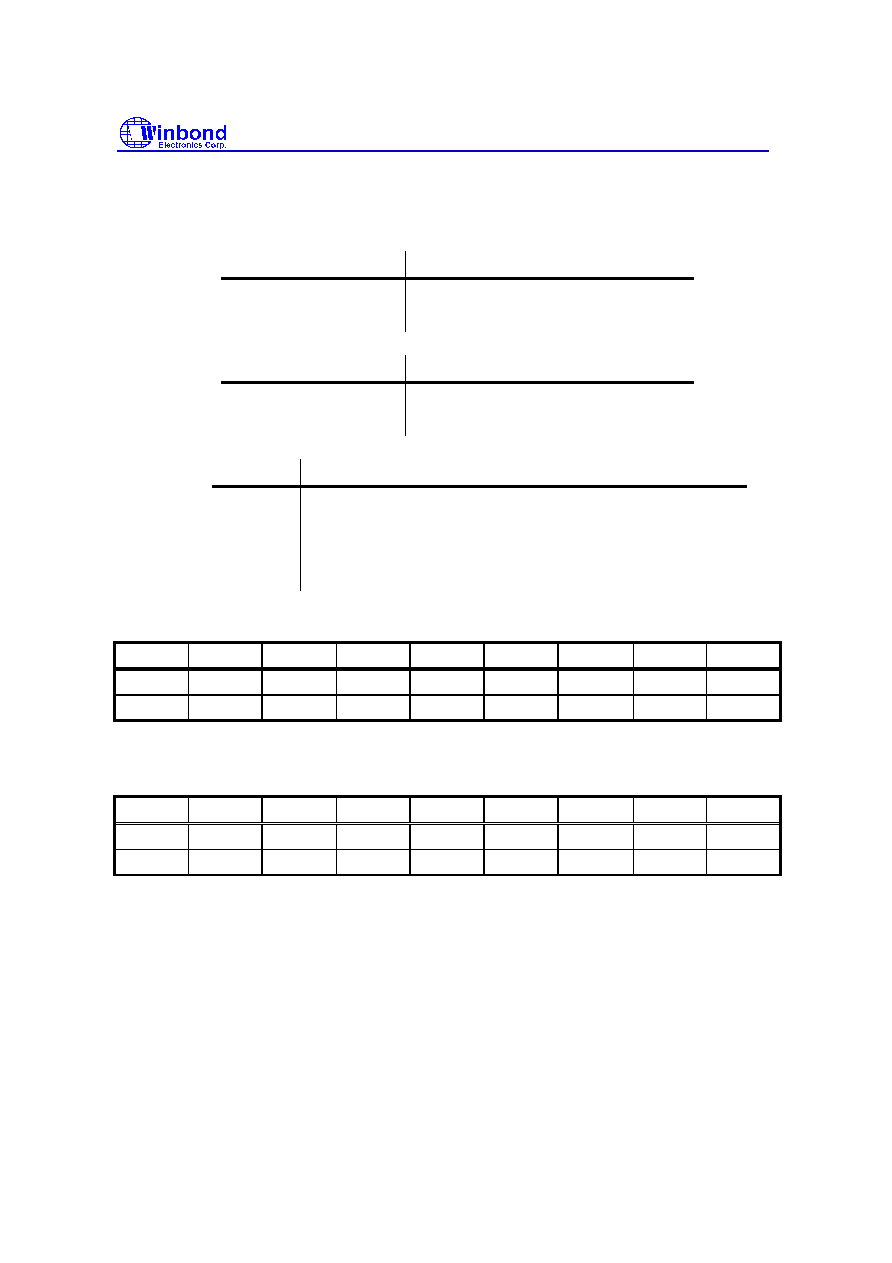
W83877ATF
Publication Release Date: April 1998
- 78 - Version 0.51
Bit 3:
TX_CFS - Transmitter Carry Frequency Select.
Sets low speed or high speed transmitter carry frequency.
TX_FCS
Selected Frequency
0
30K ~ 56K Hz
1
400K ~ 480K Hz
Bit 2:
RX_DM - Receiver Demodulation mode.
RX_DM
Demodulation Mode
0
Enables internal decoder
1
Disables internal decoder
Bit 1~0:
TX_MM1~0 - Transmitter Modulation mode 1~0
TX_MM1~0
TX Modulation Mode
00
Continuously sends pulse for logic 0
01
8 pulses for logic 0 and no pulse for logic 1.
10
6 pulses for logic 0 and no pulse for logic 1
11
Reserved.
4.3.9.3 Set7.Reg3 - Sets Select Register (SSR)
Reg.
Bit 7
Bit 6
Bit 5
Bit 4
Bit 3
Bit 2
Bit 1
Bit 0
SSR
Bit 7
Bit 6
Bit 5
Bit 4
Bit 3
Bit 2
Bit 1
Bit 0
default Value
1
1
1
1
0
1
0
0
Reading this register returns F4
16
. A write to this register causes switch to other Set.
4.3.9.4 Set7.Reg4 - Infrared Module (Front End) Select 1 (IRM_SL1)
Reg.
Bit 7
Bit 6
Bit 5
Bit 4
Bit 3
Bit 2
Bit 1
Bit 0
IRM_SL1 IR_MSP SIR_SL2 SIR_SL1 SIR_SL0
-
AIR_SL2 AIR_SL1 AIR_SL0
default Value
0
0
0
0
0
0
0
0

W83877ATF
Publication Release Date: April 1998
- 79 - Version 0.51
Bit 7:
IR_MSP - IR mode Select Pulse
Write to 1 causes the transmitter (IRTX) to send a 64
�
s pulse to setup a special IR front-
end operational mode. When IR front-end module uses
mode select pin (MD) and
transmitter IR pulse (IRTX) to switch high speed IR (such as FIR or MIR) or low speed IR
(SIR or ASK-IR), this bit should be used.
Bit 6~4:
SIR_SL2~0 - SIR (Serial IR) mode select.
These bits are to program the operational mode of the SIR front-end module. These
values of SIR_SL2~0 will automatically load to pins of IR_SL2~0, respectively, when (1)
AM_FMT=1 (Automatic Format, in Set7.Reg7.Bit7), (2) the mode of Advanced UART is
set to SIR (AD_MD2~0, in Set0.Reg4.Bit7~0).
Bit 3:
Reserved, write 0.
Bit 2~0:
AIR_SL2~0 - ASK-IR mode Select.
These bits will setup the operational mode of ASK-IR front-end module when AM_FMT=1
and AD_MD2~0 are set to ASK-IR mode. These values will automatically load to
IR_SL2~0, respectively.
4.3.9.5 Set7.Reg5 - Infrared module (Front End) Select 2 (IRM_SL2)
Reg.
Bit 7
Bit 6
Bit 5
Bit 4
Bit 3
Bit 2
Bit 1
Bit 0
IRM_SL2
-
FIR_SL2 FIR_SL1 FIR_SL0
-
MIR_SL2 MIR_SL1 MIR_SL0
default Value
0
0
0
0
0
0
0
0
Bit 7:
Reserved, write 0.
Bit 6~4:
FIR_SL2~0 - FIR mode select.
These bits setup the operational mode of FIR front-end module when AM_FMT=1 and
AD_MD2~0 set to FIR mode. These values will automatically load to IR_SL2~0,
respectively.
Bit 3:
Reserved, write 0.
Bit 2~0:
MIR_SL2~0 - MIR mode Select.
These bits setup the MIR operational mode when AM_FMT=1
and AD_MD2~0 set to
MIR mode. These values will be automatically loaded to IR_SL2~0, respectively.
4.3.9.6 Set7.Reg6 - Infrared module (Front End) Select 3 (IRM_SL3)
Reg.
Bit 7
Bit 6
Bit 5
Bit 4
Bit 3
Bit 2
Bit 1
Bit 0
IRM_SL3
-
LRC_SL2 LRC_SL1 LRC_SL0
-
HRC_SL2 HRC_SL1 HRC_SL0
default Value
0
0
0
0
0
0
0
0
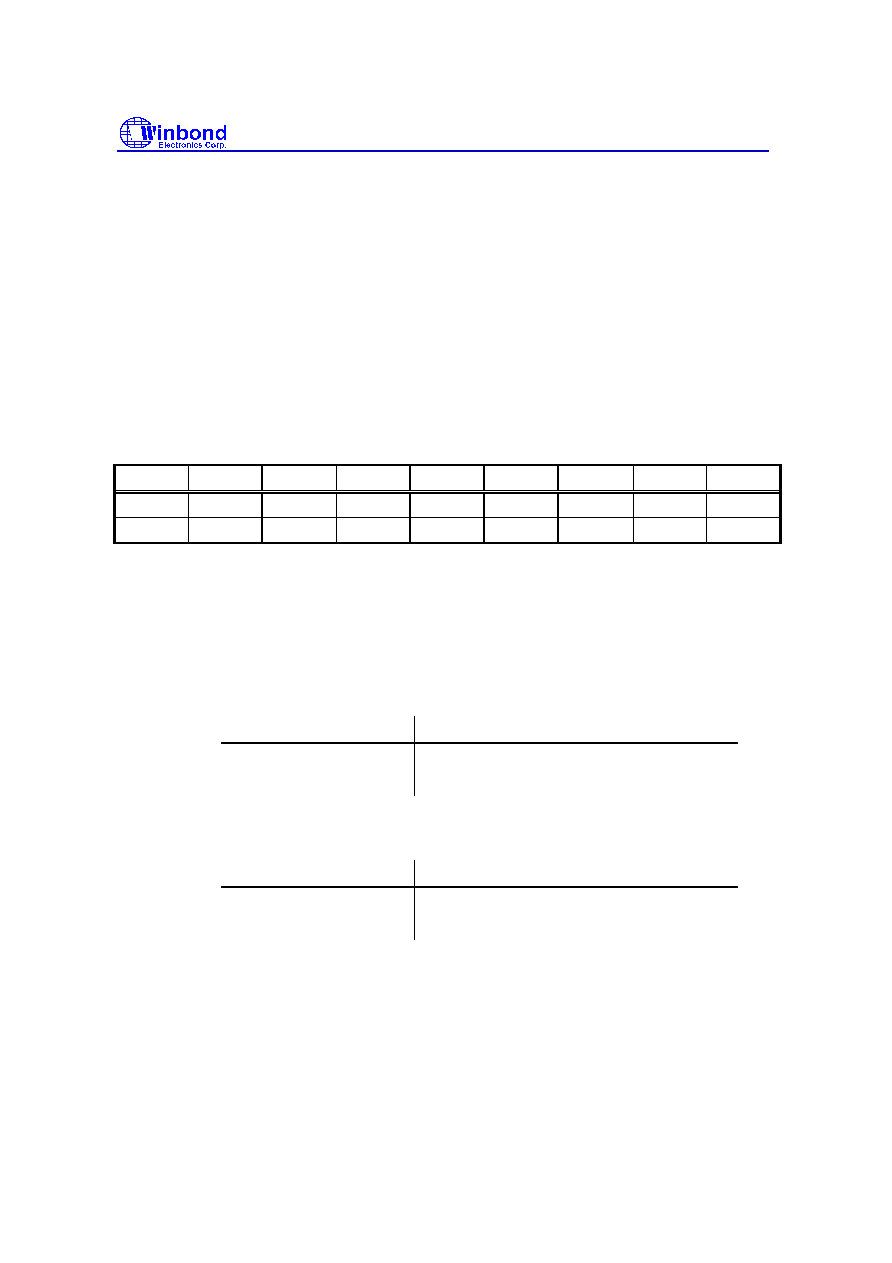
W83877ATF
Publication Release Date: April 1998
- 80 - Version 0.51
Bit 7:
Reserved, write 0.
Bit 6~4:
LRC_SL2~0 - Low Speed Remote IR mode select.
These bits setup the operational mode of
low speed remote IR front-end module when
AM_FMT=1 and AD_MD2~0 set to Remote IR mode. These values will automatically
load to IR_SL2~0, respectively.
Bit 3:
Reserved, write 0.
Bit 2~0:
HRC_SL2~0 - High Speed Remote IR Mode Select.
These bits setup the operational mode of
high speed remote IR front-end module when
AM_FMT=1 and .AD_MD2~0 set to Remote IR mode. These values will automatically
load to IR_SL2~0, respectively.
4.3.9.7 Set7.Reg7 - Infrared module Control Register (IRM_CR)
Reg.
Bit 7
Bit 6
Bit 5
Bit 4
Bit 3
Bit 2
Bit 1
Bit 0
IRM_CR AM_FMT IRX_MSL IRSL0D
RXINV
TXINV
-
-
-
default Value
0
0
0
0
0
0
0
0
Bit 7:
AM_FMT - Automatic Format
Write to 1 enables automatic format IR front-end module. This bit will affect the output of
IR_SL2~0, which is referred by IR front-end module selection (Set7.Reg4~6)
Bit 6:
IRX_MSL - IR Receiver module Select
Select the receiver input path from the IR front end module if IR module has a separated
high speed and low speed receiver path. If the IR module has only one receiving path,
then this bit should be set to 0.
IRX_MSL
Receiver Pin selected
0
IRRX (Low/High Speed)
1
IRRXH (High Speed)
Bit 5:
IRSL0D - Direction of IRSL0 Pin
Select function for IRRXH or IRSL0 because they share a common pin with different
input/output direction.
IRSL0_D
Function
0
IRRXH (I/P)
1
IRSL0 (O/P)
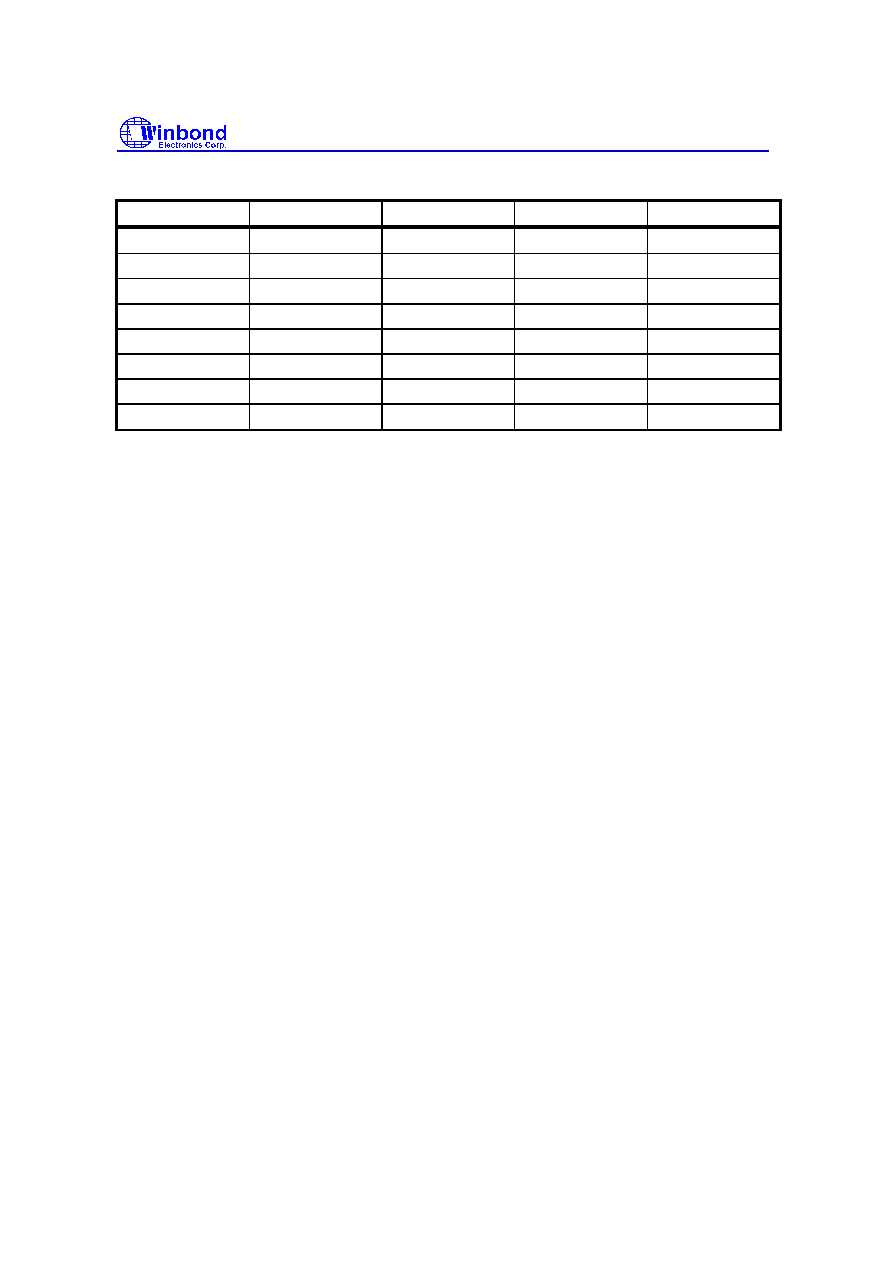
W83877ATF
Publication Release Date: April 1998
- 81 - Version 0.51
Table: IR receiver input pin selection
IRSL0D
IRX_MSL
AUX_RX
High Speed IR
Selected IR Pin
0
0
0
X
IRRX
0
0
1
X
IRRXH
0
1
X
0
IRRX
0
1
X
1
IRRXH
1
0
0
X
IRRX
1
0
1
X
Reserved
1
1
X
0
IRRX
1
1
X
1
Reserved
Note that (1) AUX_RX is defined in Set5.Reg4.Bit4, (2) high speed IR includes MIR (1.152M or
0.576M bps) and FIR (4M bps), (3) IRRX is the input of the low speed or high speed IR receiver,
IRRXH is the input of the high speed IR receiver.
Bit 4:
RXINV - Receiving Signal Invert
Write to 1 inverts the receiving signal.
Bit 3:
TXINV - Transmitting Signal Invert
Write to 1 inverts the transmitting signal.
Bit 2~0:
Reserved, write 0.

W83877ATF
Publication Release Date: April 1998
- 82 - Version 0.51
4.0 PARALLEL PORT
4.1 Printer Interface Logic
The parallel port of the W83877ATF makes possible the attachment of various devices that accept
eight bits of parallel data at standard TTL level. The W83877ATF supports an IBM XT/AT compatible
parallel port (SPP), bi-directional parallel port (BPP), Enhanced Parallel Port (EPP), Extended
Capabilities Parallel Port (ECP), Extension FDD mode (EXTFDD), and Extension 2FDD mode
(EXT2FDD) on the parallel port. Refer to the configuration registers for more information on disabling,
power-down, and on selecting the mode of operation.
Table 4-1 shows the pin definitions for different modes of the parallel port.
TABLE 4-1-A Parallel Port Connnector and Pin Definition for SPP/EPP/ECP Modes
HOST
CONNECTOR
PIN NUMBER
OF W83877ATF
PIN
ATTRIBUTE
SPP
EPP
ECP
1
19
O
nSTB
nWrite
nSTB, HostClk
2-9
9-14,16-17
I/O
PD<0:7>
PD<0:7>
PD<0:7>
10
26
I
nACK
Intr
nACK, PeriphClk
11
24
I
BUSY
nWait
BUSY, PeriphAck
2
12
27
I
PE
PE
PEerror, nAckReverse
2
13
28
I
SLCT
Select
SLCT, Xflag
14
20
O
nAFD
nDStrb
nAFD, HostAck
2
15
29
I
nERR
nError
nFault
1
, nPeriphRequest
2
16
21
O
nINIT
nInit
nINIT
1
, nReverseRqst
2
17
22
O
nSLIN
nAStrb
nSLIN
1
, ECPMode
2
Notes:
n<name > : Active Low
1. Compatible Mode
2. High Speed Mode
3. For more information, refer to the IEEE 1284 standard.
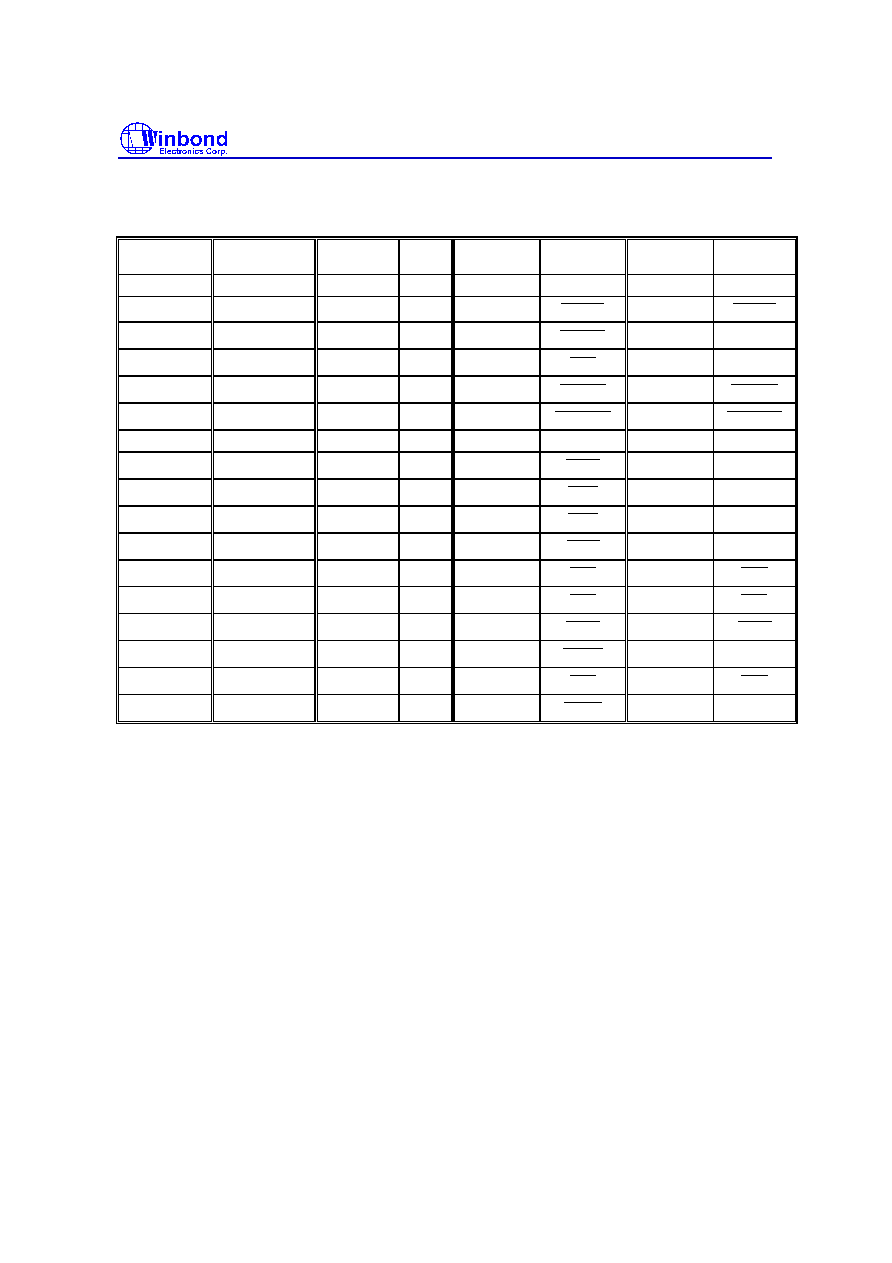
W83877ATF
Publication Release Date: April 1998
- 83 - Version 0.51
TABLE 4-1-B Parallel Port Connector and Pin Definition for EXTFDD and EXT2FDD Modes
HOST
CONNECTOR
PIN NUMBER
OF W83877ATF
PIN
ATTRIBUTE
SPP
PIN
ATTRIBUTE
EXT2FDD
PIN
ATTRIBUTE
EXTFDD
1
19
O
nSTB
---
---
---
---
2
9
I/O
PD0
I
INDEX2
I
INDEX2
3
10
I/O
PD1
I
TRAK02
I
4
11
I/O
PD2
I
WP2
I
5
12
I/O
PD3
I
RDATA2
I
RDATA2
6
13
I/O
PD4
I
DSKCHG2
I
DSKCHG2
7
14
I/O
PD5
---
---
---
---
8
15
I/O
PD6
OD
MOA2
---
---
9
16
I/O
PD7
OD
DSA2
---
---
10
26
I
nACK
OD
DSB2
OD
11
24
I
BUSY
OD
MOB2
OD
12
27
I
PE
OD
WD2
OD
WD2
13
28
I
SLCT
OD
WE2
OD
WE2
14
20
O
nAFD
OD
RWC2
OD
RWC2
15
29
I
nERR
OD
NERR2
OD
16
21
O
nINIT
OD
DIR2
OD
DIR2
17
22
O
nSLIN
OD
STEP2
OD

W83877ATF
Publication Release Date: April 1998
- 84 - Version 0.51
4.2 Enhanced Parallel Port (EPP)
TABLE 4-2 PRINTER MODE AND EPP REGISTER ADDRESS
A2
A1
A0
REGISTER
NOTE
0
0
0
Data port (R/W)
1
0
0
1
Printer status buffer (Read)
1
0
1
0
Printer control latch (Write)
1
0
1
0
Printer control swapper (Read)
1
0
1
1
EPP address port (R/W)
2
1
0
0
EPP data port 0 (R/W)
2
1
0
1
EPP data port 1 (R/W)
2
1
1
0
EPP data port 2 (R/W)
2
1
1
1
EPP data port 2 (R/W)
2
Notes:
1. These registers are available in all modes.
2. These registers are available only in EPP mode.
4.2.1 Data Swapper
The system microprocessor can read the contents of the printer's data latch by reading the data
swapper.
4.2.2 Printer Status Buffer
The system microprocessor can read the printer status by reading the address of the printer status
buffer. The bit definitions are as follows:
1
1
1
2
3
5
4
6
7
0
TMOUT
ERROR
SLCT
PE
BUSY
ACK
Bit 7: This signal is active during data entry, when the printer is off-line during printing, when the print
head is changing position, or during an error state. When this signal is active, the printer is
busy and cannot accept data.
Bit 6: This bit represents the current state of the printer's
ACK
signal. A 0 means the printer has
received a character and is ready to accept another. Normally, this signal will be active for
approximately 5
microseconds before
BUSY
stops.
Bit 5: A 1 means the printer has detected the end of paper.
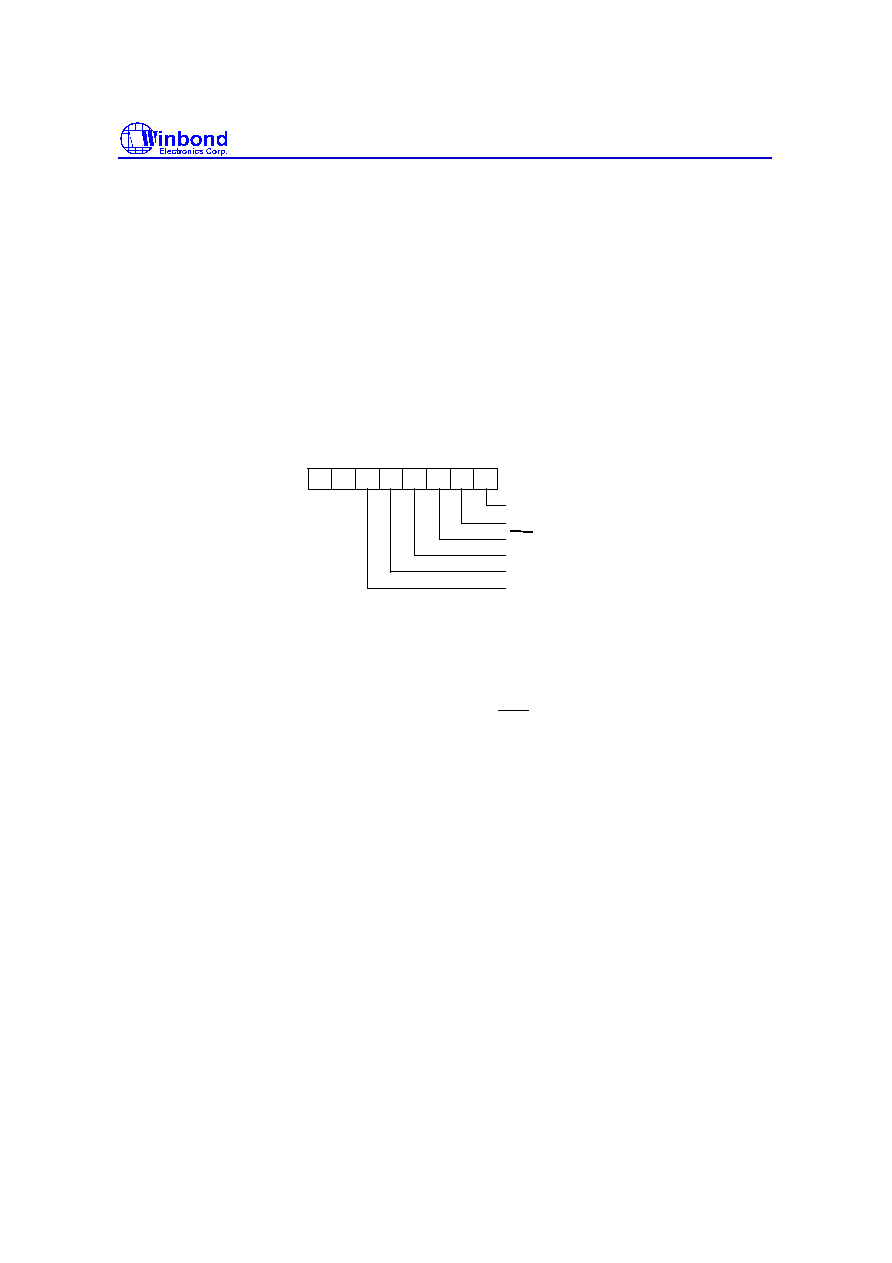
W83877ATF
Publication Release Date: April 1998
- 85 - Version 0.51
Bit 4: A 1 means the printer is selected.
Bit 3: A 0 means the printer has encountered an error condition.
Bit 1, 2: These two bits are not implemented and are logic one during a read of the status register.
Bit 0: This bit is valid in EPP mode only. It indicates that a 10
�
S time-out has occurred on the EPP
bus. A logic 0 means that no time-out error has occurred; a logic 1 means that a time-out error
has been detected. Writing a logic 1 to this bit will clear the time-out status bit; writing a logic 0
has no effect.
4.2.3 Printer Control Latch and Printer Control Swapper
The system microprocessor can read the contents of the printer control latch by reading the printer
control swapper. Bit definitions are as follows:
1
1
1
2
3
4
5
6
7
0
STROBE
AUTO FD
SLCT IN
IRQ ENABLE
DIR
INIT
Bit 7, 6: These two bits are a logic one during a read. They can be written.
Bit 5: Direction control bit
When this bit is a logic 1, the parallel port is in input mode (read); when it is a logic 0, the
parallel port is in output mode (write). This bit can be read and written. In SPP mode, this bit is
invalid and fixed at zero.
Bit 4: A 1 in this position allows an interrupt to occur when
ACK
changes from low to high.
Bit 3: A 1 in this bit position selects the printer.
Bit 2: A 0 starts the printer (50 microsecond pulse, minimum).
Bit 1: A 1 causes the printer to line-feed after a line is printed.
Bit 0: A 0.5 microsecond minimum high active pulse clocks data into the printer. Valid data must be
present for a minimum of 0.5 microseconds before and after the strobe pulse.
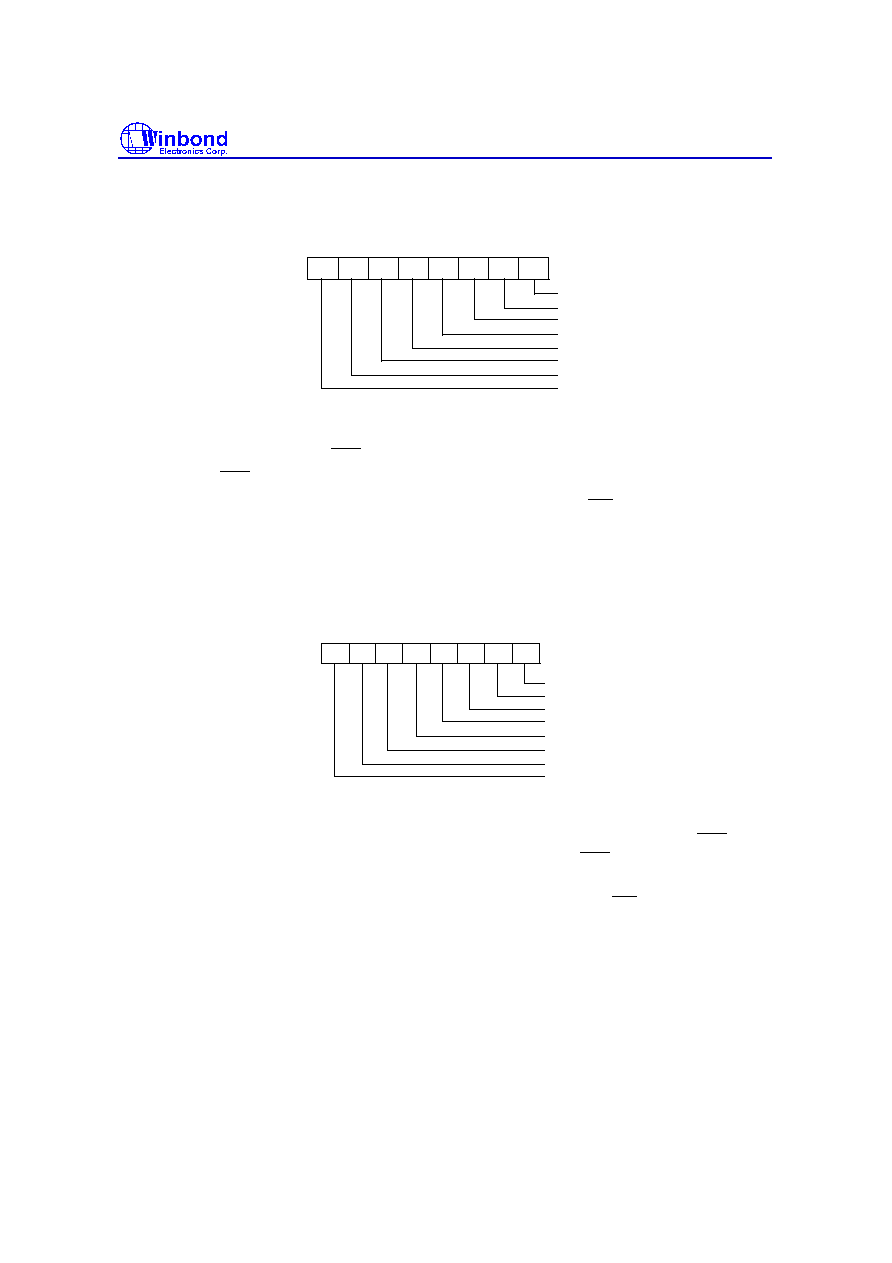
W83877ATF
Publication Release Date: April 1998
- 86 - Version 0.51
4
.2.4 EPP Address Port
The address port is available only in EPP mode. Bit definitions are as follows:
1
2
3
4
5
6
7
0
PD0
PD1
PD2
PD3
PD5
PD4
PD6
PD7
The contents of DB0-DB7 are buffered (non-inverting) and output to ports PD0-PD7 during a write
operation. The leading edge of IOW
c
auses an EPP address write cycle to be performed, and the
trailing edge of IOW
latches the data for the duration of the EPP write cycle.
PD0-PD7 ports are read during a read operation. The leading edge of IOR
causes an EPP address
read cycle to be performed and the data to be output to the host CPU.
4.2.5 EPP Data Port 0-3
These four registers are available only in EPP mode. Bit definitions of each data port are as follows:
1
2
3
4
5
6
7
0
PD0
PD1
PD2
PD3
PD4
PD5
PD6
PD7
When accesses are made to any EPP data port, the contents of DB0-DB7 are buffered (non-
inverting) and output to the ports PD0-PD7 during a write operation. The leading edge of IOW
causes
an EPP data write cycle to be performed, and the trailing edge of IOW
latches the data for the
duration of the EPP write cycle.
During a read operation, ports PD0-PD7 are read, and the leading edge of
IOR
causes an EPP read
cycle to be performed and the data to be output to the host CPU.
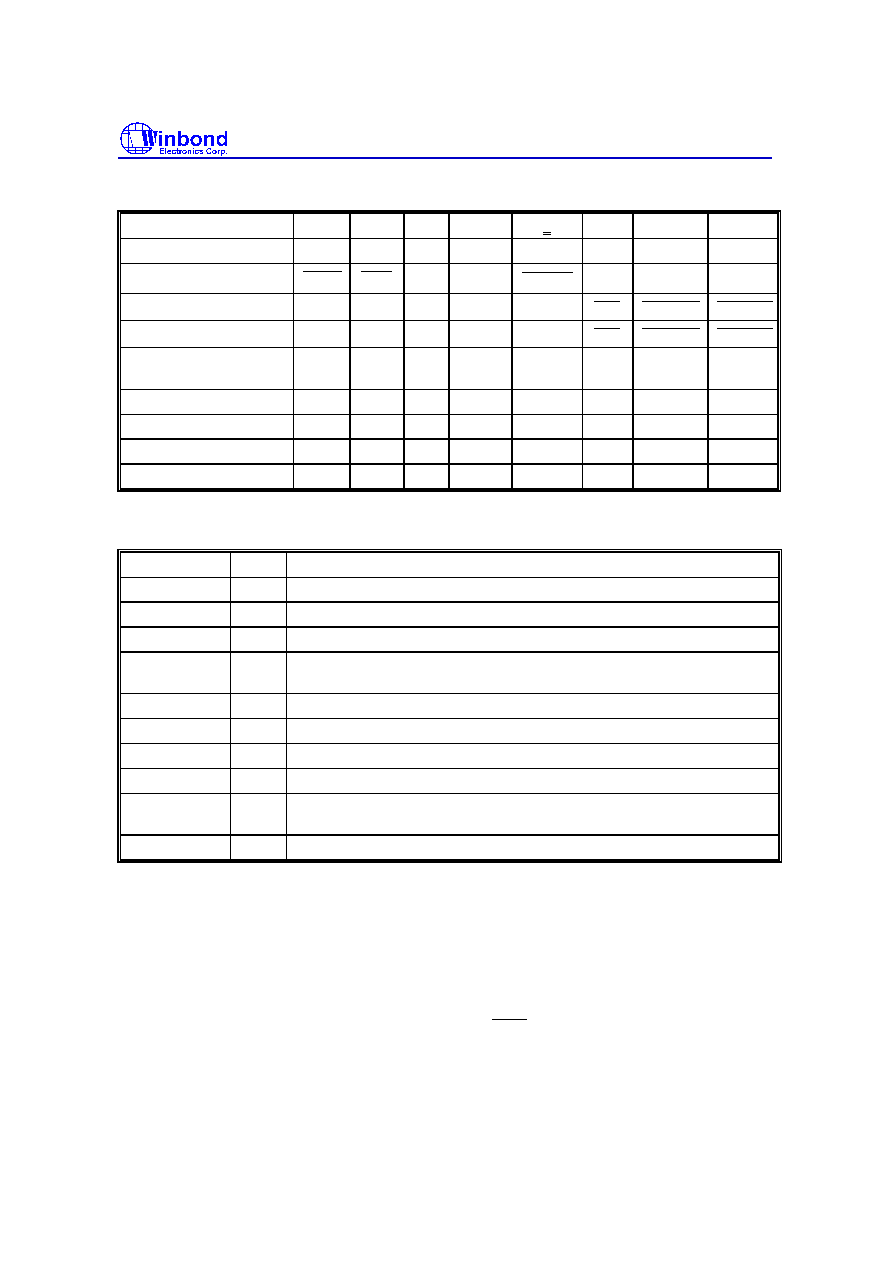
W83877ATF
Publication Release Date: April 1998
- 87 - Version 0.51
4
.2.6 Bit Map of Parallel Port and EPP Registers
REGISTER
7
6
5
4
3
2
1
0
Data Port (R/W)
PD7
PD6
PD5
PD4
PD3
PD2
PD1
PD0
Status Buffer (Read)
BUSY
ACK
PE
SLCT
ERROR
1
1
TMOUT
Control Swapper (Read)
1
1
1
IRQEN
SLIN
INIT
AUTOFD
STROBE
Control Latch (Write)
1
1
DIR
IRQ
SLIN
INIT
AUTOFD
STROBE
EPP Address Port
(R/W)
PD7
PD6
PD5
PD4
PD3
PD2
PD1
PD0
EPP Data Port 0 (R/W)
PD7
PD6
PD5
PD4
PD3
PD2
PD1
PD0
EPP Data Port 1 (R/W)
PD7
PD6
PD5
PD4
PD3
PD2
PD1
PD0
EPP Data Port 2 (R/W)
PD7
PD6
PD5
PD4
PD3
PD2
PD1
PD0
EPP Data Port 3 (R/W)
PD7
PD6
PD5
PD4
PD3
PD2
PD1
PD0
4.2.7 EPP Pin Descriptions
EPP NAME
TYPE
EPP DESCRIPTION
nWrite
O
Denotes an address or data read or write operation.
PD<0:7>
I/O
Bi-directional EPP address and data bus.
Intr
I
Used by peripheral device to interrupt the host.
nWait
I
Inactive to acknowledge that data transfer is completed. Active to
indicate that the device is ready for the next transfer.
PE
I
Paper end; same as SPP mode.
Select
I
Printer selected status; same as SPP mode.
nDStrb
O
This signal is active low. It denotes a data read or write operation.
nError
I
Error; same as SPP mode.
nInits
O
This signal is active low. When it is active, the EPP device is reset to its
initial operating mode.
nAStrb
O
This signal is active low. It denotes an address read or write operation.
4.2.8 EPP Operation
When the EPP mode is selected in the configuration register, the standard and bi-directional modes
are also available. The PDx bus is in the standard or bi-directional mode when no EPP read, write, or
address cycle is currently being executed. In this condition all output signals are set by the SPP
Control Port and the direction is controlled by DIR of the Control Port.
A watchdog timer is required to prevent system lockup. The timer indicates that more than 10
�
S
have elapsed from the start
of the EPP
cycle to the time
WAIT
is de-asserted. The current EPP cycle
is aborted when a time-out occurs. The time-out condition is indicated in Status bit 0.

W83877ATF
Publication Release Date: April 1998
- 88 - Version 0.51
EPP Operation
The EPP operates on a two-phase cycle. First, the host selects the register within the device for
subsequent operations. Second, the host performs a series of read and/or write byte operations to the
selected register. Four operations are supported on the EPP: Address Write, Data Write, Address
Read, and Data Read. All operations on the EPP device are performed asynchronously.
EPP Version 1.9 Operation
The EPP read/write operation can be completed under the following conditions:
a. If the nWait is active low, when the read cycle (nWrite inactive high, nDStrb/nAStrb active low) or
write cycle (nWrite active low, nDStrb/nAStrb active low) starts, the read/write cycle proceeds
normally and will be completed when nWait goes inactive high.
b. If nWait is inactive high, the read/write cycle will not start. It must wait until nWait changes to
active low, at which time it will start as described above.
EPP Version 1.7 Operation
The EPP read/write cycle can start without checking whether nWait is active or inactive. Once the
read/write cycle starts, however, it will not terminate until nWait changes from active low to inactive
high.
4.3 Extended Capabilities Parallel (ECP) Port
This
port is software and hardware compatible with existing parallel ports, so it may be used in a
standard printer mode if ECP is not required. It provides an automatic high burst-bandwidth channel
that supports DMA for ECP in both the forward (host to peripheral) and reverse (peripheral to host)
directions.
Small FIFOs are used in both forward and reverse directions to improve the maximum bandwidth
requirement. The size of the FIFO is 16 bytes. The ECP port supports an automatic handshake for
the standard parallel port to improve compatibility mode transfer speed.
The ECP port supports run-length-encoded (RLE) decompression (required) in the hardware.
Compression is accomplished by counting identical bytes and transmitting an RLE byte that indicates
how many times the next byte is to be repeated. The hardware support for compression is optional.
For more information about the ECP Protocol, refer to the Extended Capabilities Port Protocol and
ISA Interface Standard.
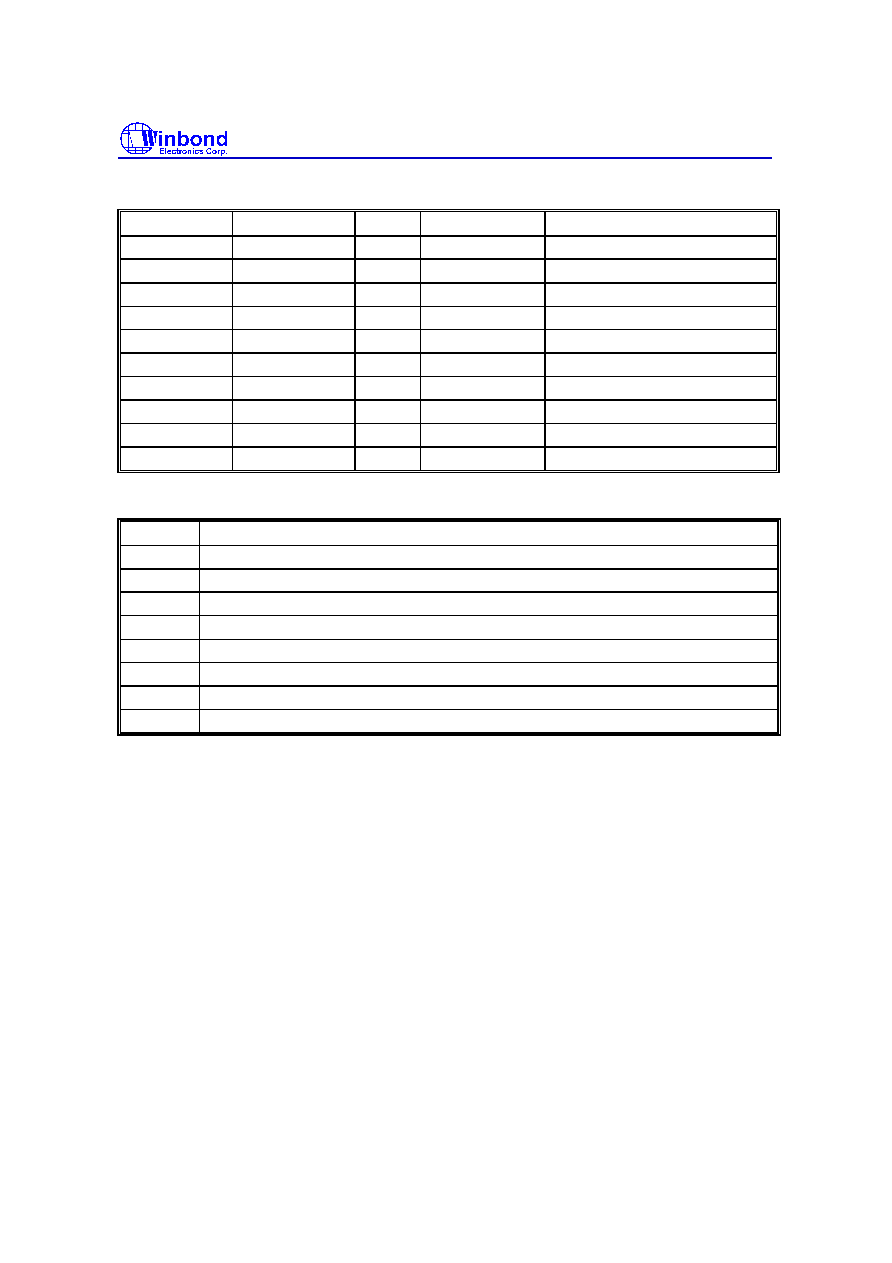
W83877ATF
Publication Release Date: April 1998
- 89 - Version 0.51
4.3.1 ECP Register and Mode Definitions
NAME
ADDRESS
I/O
ECP MODES
FUNCTION
data
Base+000h
R/W
000-001
Data Register
ecpAFifo
Base+000h
R/W
011
ECP FIFO (Address)
dsr
Base+001h
R
All
Status Register
dcr
Base+002h
R/W
All
Control Register
cFifo
Base+400h
R/W
010
Parallel Port Data FIFO
ecpDFifo
Base+400h
R/W
011
ECP FIFO (DATA)
tFifo
Base+400h
R/W
110
Test FIFO
cnfgA
Base+400h
R
111
Configuration Register A
cnfgB
Base+401h
R/W
111
Configuration Register B
ecr
Base+402h
R/W
All
Extended Control Register
Note: The base addresses are specified by CR23, which are determined by configuration register or hardware setting.
MODE
DESCRIPTION
000
SPP mode
001
PS/2 Parallel Port mode
010
Parallel Port Data FIFO mode
011
ECP Parallel Port mode
100
EPP mode (If this option is enabled in the CR9 and CR0 to select ECP/EPP mode)
101
Reserved
110
Test mode
111
Configuration mode
Note: The mode selection bits are bit 7-5 of the Extended Control Register.
4.3.2 Data and ecpAFifo Port
Modes 000 (SPP) and 001 (PS/2) (Data Port)
During a write operation, the Data Register latches the contents of the data bus on the rising edge of
the input. The contents of this register are output to the PD0-PD7 ports. During a read operation,
ports PD0-PD7 are read and output to the host. The bit definitions are as follows:
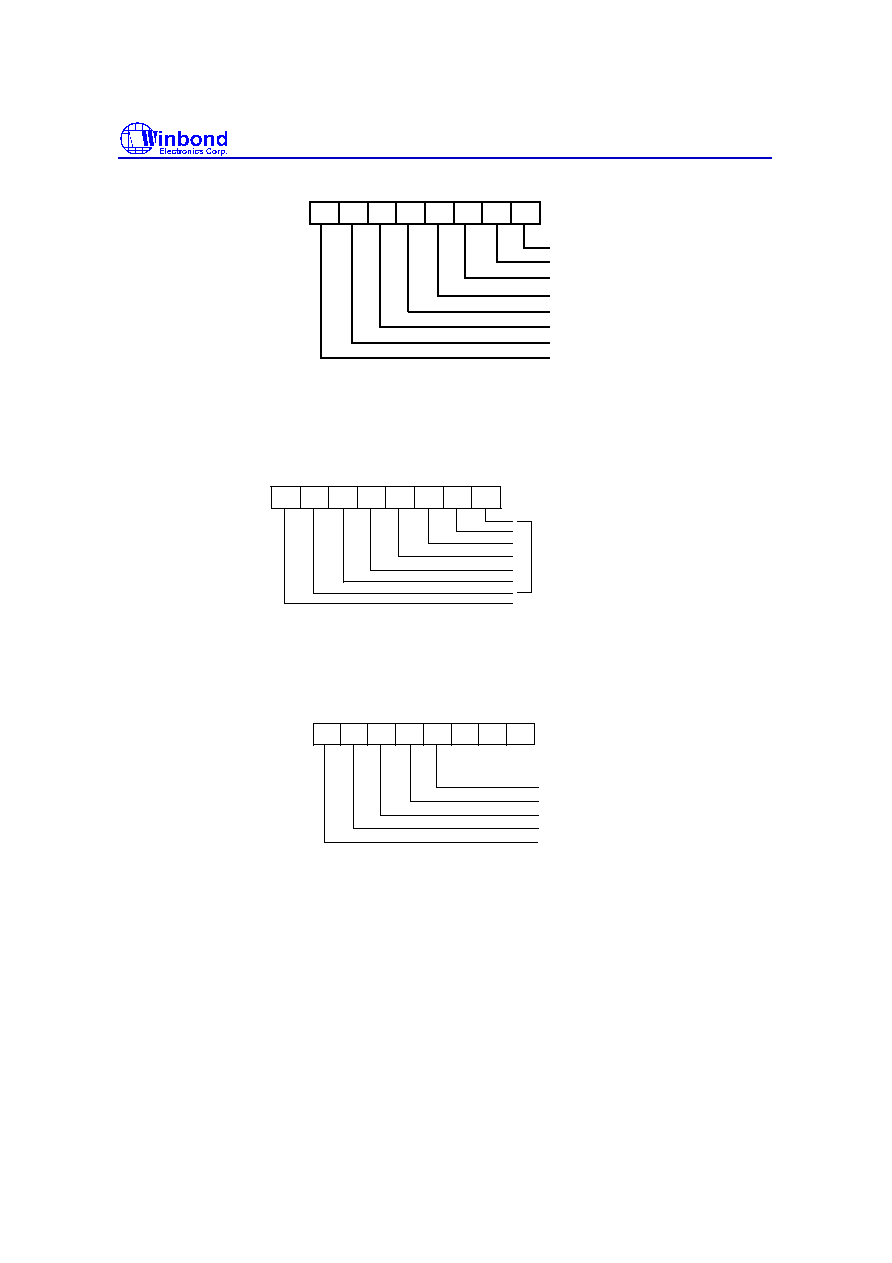
W83877ATF
Publication Release Date: April 1998
- 90 - Version 0.51
7 6 5 4 3 2 1 0
PD0
PD1
PD2
PD3
PD4
PD5
PD6
PD7
Mode 011 (ECP FIFO-Address/RLE)
A data byte written to this address is placed in the FIFO and tagged as an ECP Address/RLE. The
hardware at the ECP port transmits this byte to the peripheral automatically. The operation of this
register is defined only for the forward direction. The bit definitions are as follows:
7 6 5 4 3 2 1 0
Address or RLE
Address/RLE
4.3.3 Device Status Register (DSR)
These bits are at low level during a read of the Printer Status Register. The bits of this status register
are defined as follows:
7 6 5 4 3 2 1 0
nFault
Select
PError
nAck
nBusy
1
1
1
Bit 7: This bit reflects the complement of the Busy input.
Bit 6: This bit reflects the nAck input.
Bit 5: This bit reflects the PError input.
Bit 4: This bit reflects the Select input.
Bit 3: This bit reflects the nFault input.
Bit 2-0: These three bits are not implemented and are always logic one during a read.

W83877ATF
Publication Release Date: April 1998
- 91 - Version 0.51
4.3.4 Device Control Register (DCR)
The bit definitions are as follows:
7 6 5 4 3 2 1 0
1
1
Strobe
Autofd
nInit
Select In
Direction
AckInt En
Bit 6, 7: These two bits are logic one during a read and cannot be written.
Bit 5: This bit has no effect and the direction is always out if mode = 000 or mode = 010. Direction is
valid in all other modes.
0 the parallel port is in output mode.
1 the parallel port is in input mode.
Bit 4: Interrupt request enable. When this bit is set to a high level, it may be used to enable interrupt
requests from the parallel port to the CPU due to a low to high transition on the
ACK
input.
Bit 3: This bit is inverted and output to the SLIN
output.
0 The printer is not selected.
1 The printer is selected.
Bit 2: This bit is output to the
INIT
output.
Bit 1: This bit is inverted and output to the
AFD
output.
Bit 0: This bit is inverted and output to the
STB
output.
4.3.5 cFifo (Parallel Port Data FIFO) Mode = 010
This mode is defined only for the forward direction. The standard parallel port protocol is used by a
hardware handshake to the peripheral to transmit bytes written or DMAed from the system to this
FIFO. Transfers to the FIFO are byte aligned.
4.3.6 ecpDFifo (ECP Data FIFO) Mode = 011
When the direction bit is 0, bytes written or DMAed from the system to this FIFO are transmitted by a
hardware handshake to the peripheral using the ECP parallel port protocol. Transfers to the FIFO are
byte aligned.
When the direction bit is 1, data bytes from the peripheral are read under automatic hardware
handshake from ECP into this FIFO. Reads or DMAs from the FIFO will return bytes of ECP data to
the system.
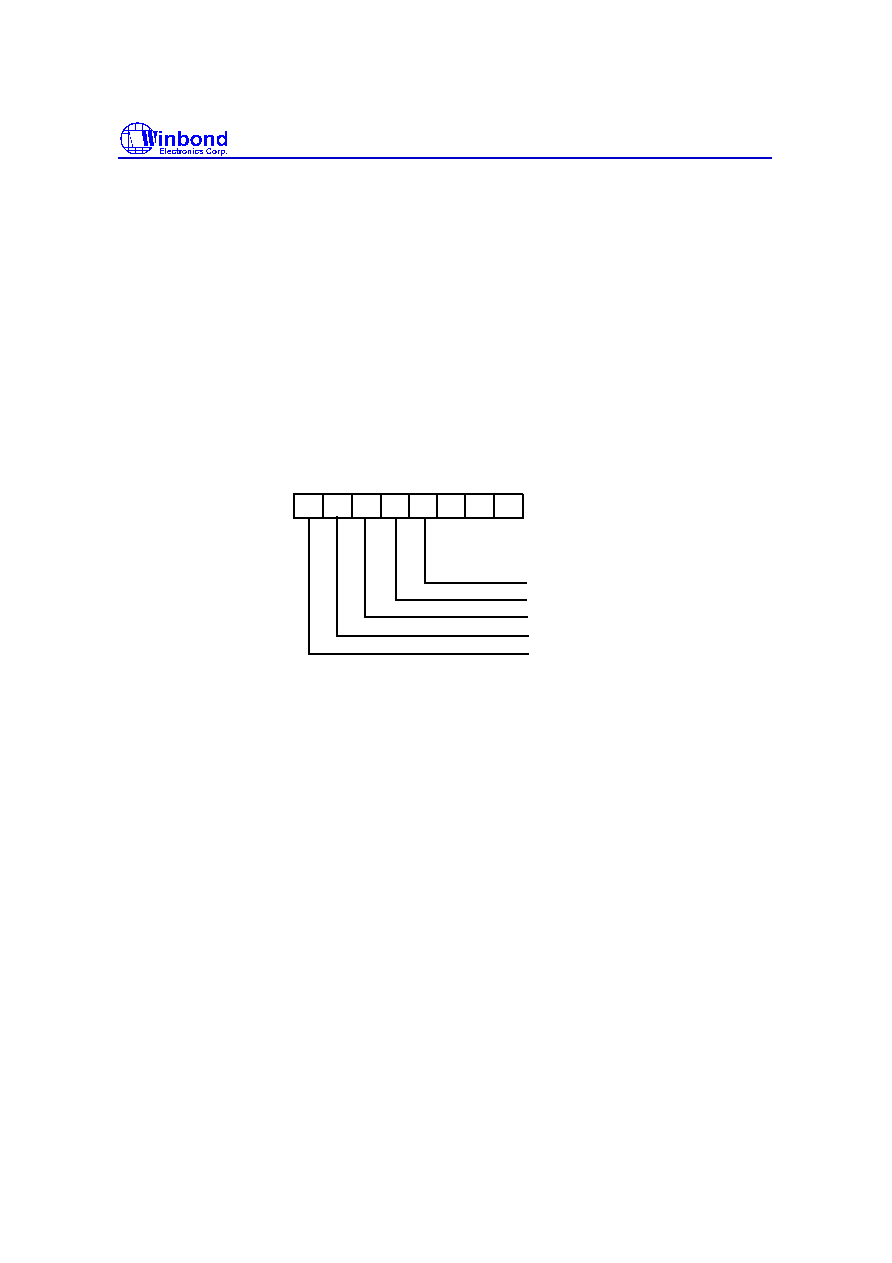
W83877ATF
Publication Release Date: April 1998
- 92 - Version 0.51
4.3.7 tFifo (Test FIFO Mode) Mode = 110
Data bytes may be read, written, or DMAed to or from the system to this FIFO in any direction.
Data in the tFIFO will not be transmitted to the parallel port lines. However, data in the tFIFO may be
displayed on the parallel port data lines.
4.3.8 cnfgA (Configuration Register A) Mode = 111
This register is a read-only register. When it is read, 10H is returned. This indicates to the system that
this is an 8-bit implementation.
4.3.9 cnfgB (Configuration Register B) Mode = 111
The bit definitions are as follows:
7 6 5 4 3 2 1 0
1 1 1
intrValue
compress
IRQx 0
IRQx 1
IRQx 2
Bit 7: This bit is read-only. It is at low level during a read. This means that this chip does not support
hardware RLE compression.
Bit 6: Returns the value on the ISA IRQ line to determine possible conflicts.
Bit 5-3: Reflect the IRQ resource assigned for ECP port.
cnfgB[5:3]
IRQ resource
000
reflect other IRQ resources selected by PnP register (default)
001
IRQ7
010
IRQ9
011
IRQ10
100
IRQ11
101
IRQ14
110
IRQ15
111
IRQ5
Bit 2-0: These five bits are at high level during a read and can be written
.
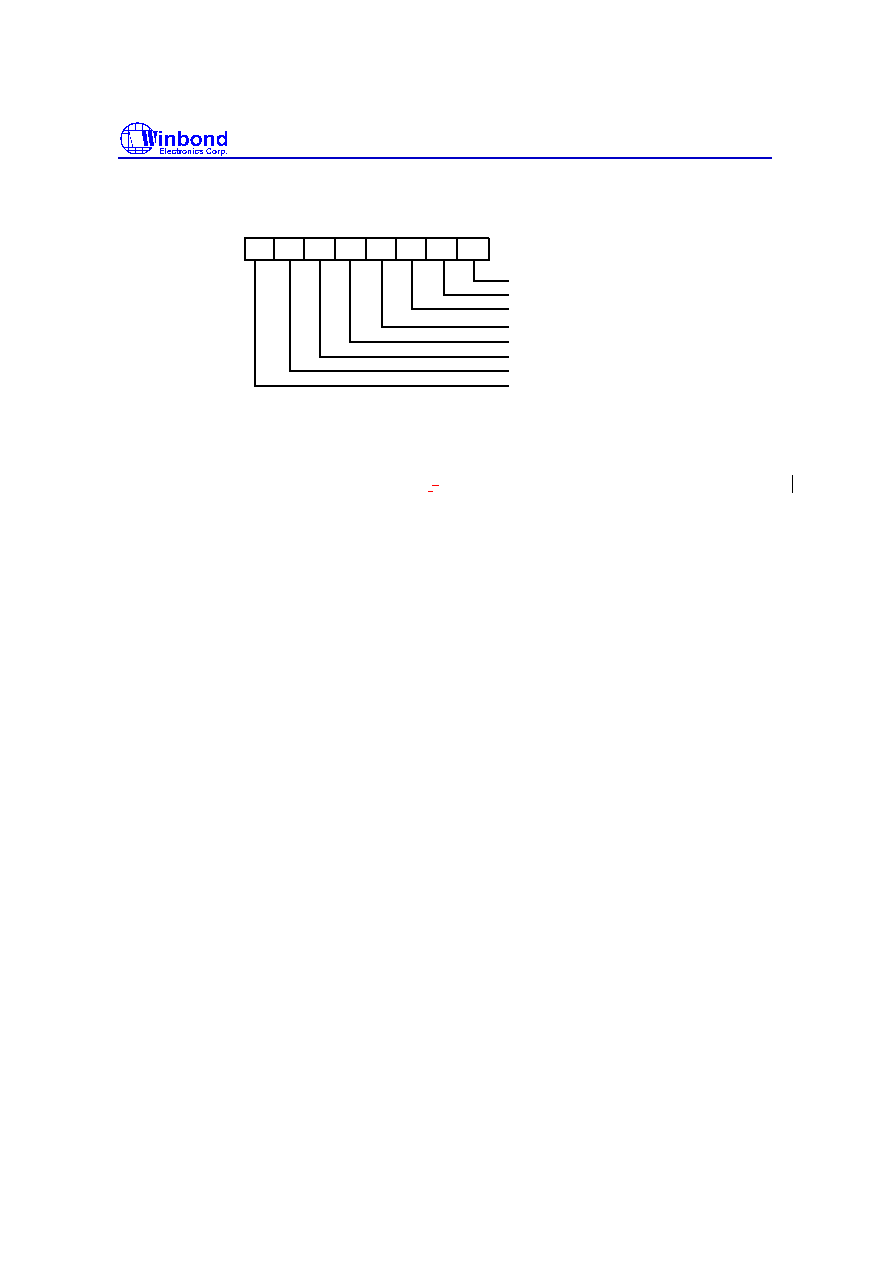
W83877ATF
Publication Release Date: April 1998
- 93 - Version 0.51
4.3.10 ecr (Extended Control Register) Mode = all
This register controls the extended ECP parallel port functions. The bit definitions are follows:
7 6 5 4 3 2 1 0
Empty
Full
Service Intr
DMA En
nErrIntr En
MODE
MODE
MODE
Bit 7-5: These bits are read/write and select the mode.
000
Standard Parallel Port mode. The FIFO is reset in this mode.
001
PS/2 Parallel Port mode. This is the same as 000 except that direction may be
used to tri-state the data lines
,
and reading the data register returns the value on
the data lines and not the value in the data register.
010
Parallel Port FIFO mode. This is the same as 000 except that bytes are written or
DMAed to the FIFO. FIFO data are automatically transmitted using the standard
parallel port protocol. This mode is useful only when direction is 0.
011
ECP Parallel Port Mode. When the direction is 0 (forward direction), bytes placed
into the ecpDFifo and bytes written to the ecpAFifo are placed in a single FIFO and
transmitted automatically to the peripheral using ECP Protocol. When the direction
is 1 (reverse direction) bytes are moved from the ECP parallel port and packed into
bytes in the ecpDFifo.
100
Selects EPP Mode. In this mode, EPP is active if the EPP supported option is
selected.
101
Reserved.
110
Test Mode. The FIFO may be written and read in this mode, but the data will not be
transmitted on the parallel port.
111
Configuration Mode. The confgA and confgB registers are accessible at 0x400 and
0x401 in this mode.
Bit 4: Read/Write (Valid only in ECP Mode)
1
Disables the interrupt generated on the asserting edge of nFault.
0
Enables an interrupt pulse on the high to low edge of nFault. If nFault is asserted
(interrupt) an interrupt will be generated and this bit is written from a 1 to 0.
Bit 3: Read/Write
1
Enables DMA.
0
Disables DMA unconditionally.
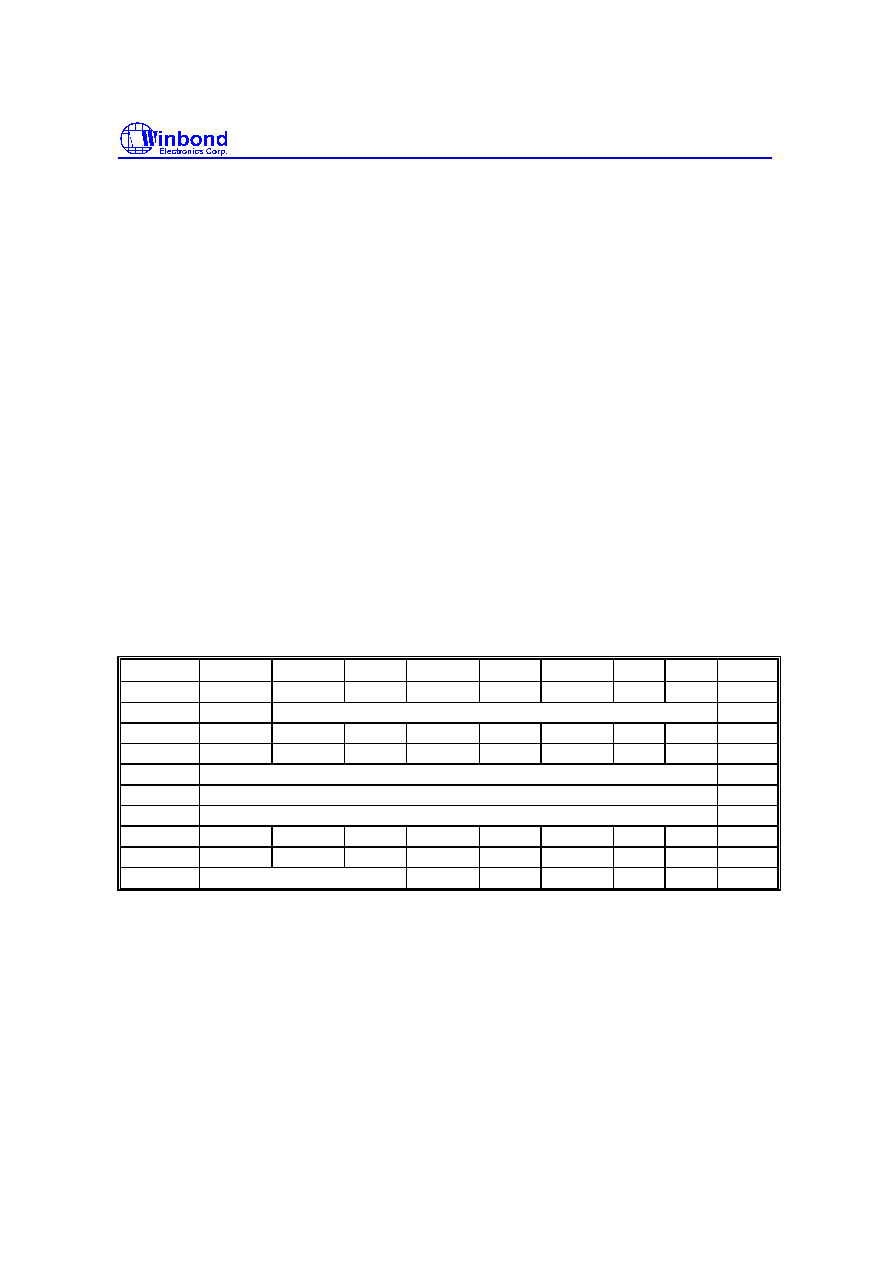
W83877ATF
Publication Release Date: April 1998
- 94 - Version 0.51
Bit 2: Read/Write
1
Disables DMA and all of the service interrupts.
0
Enables one of the following cases of interrupts. When one of the service interrupts
has occurred, the serviceIntr bit is set to a 1 by hardware. This bit must be reset to
0 to re-enable the interrupts. Writing a 1 to this bit will not cause an interrupt.
(a) dmaEn = 1:
During DMA this bit is set to a 1 when terminal count is reached.
(b) dmaEn = 0 direction = 0:
This bit is set to 1 whenever there are writeIntr Threshold or more bytes free in the
FIFO.
(c) dmaEn = 0 direction = 1:
This bit is set to 1 whenever there are readIntr Threshold or more valid bytes to be
read from the FIFO.
Bit 1: Read only
0
The FIFO has at least 1 free byte.
1
The FIFO cannot accept another byte or the FIFO is completely full.
Bit 0: Read only
0
The FIFO contains at least 1 byte of data.
1
The FIFO is completely empty.
4.3.11 Bit Map of ECP Port Registers
D7
D6
D5
D4
D3
D2
D1
D0
NOTE
data
PD7
PD6
PD5
PD4
PD3
PD2
PD1
PD0
ecpAFifo
Addr/RLE
Address or RLE field
2
dsr
nBusy
nAck
PError
Select
nFault
1
1
1
1
dcr
1
1
Directio
ackIntEn
SelectIn
nInit
autofd
strobe
1
cFifo
Parallel Port Data FIFO
2
ecpDFifo
ECP Data FIFO
2
tFifo
Test FIFO
2
cnfgA
0
0
0
1
0
0
0
0
cnfgB
compress
intrValue
1
1
1
1
1
1
ecr
MODE
nErrIntrEn
dmaEn
serviceIntr
full
empty
Notes:
1. These registers are available in all modes.
2. All FIFOs use one common 16-byte FIFO.

W83877ATF
Publication Release Date: April 1998
- 95 - Version 0.51
4
.3.12 ECP Pin Descriptions
NAME
TYPE
DESCRIPTION
nStrobe (HostClk)
O
The nStrobe registers data or address into the slave on the
asserting edge during write operations. This signal
handshakes with Busy.
PD<7:0>
I/O
These signals contains address or data or RLE data.
nAck (PeriphClk)
I
This signal indicates valid data driven by the peripheral when
asserted. This signal handshakes with nAutofd in reverse.
Busy (PeriphAck)
I
This signal deasserts to indicate that the peripheral can
accept data. It indicates whether the data lines contain ECP
command information or data in the reverse direction. When
in reverse direction, normal data are transferred when Busy
(PeriphAck) is high and an 8-bit command is transferred when
it is low.
PError (nAckReverse)
I
This signal is used to acknowledge a change in the direction
of the transfer (asserted = forward). The peripheral drives this
signal low to acknowledge nReverseRequest. The host relies
upon nAckReverse to determine when it is permitted to drive
the data bus.
Select (Xflag)
I
Indicates printer on line.
nAutoFd (HostAck)
O
Requests a byte of data from the peripheral when it is
asserted. This signal indicates whether the data lines contain
ECP address or data in the forward direction. When in forward
direction, normal data are transferred when nAutoFd
(HostAck) is high and an 8-bit command is transferred when it
is low.
nFault (nPeriphRequest)
I
Generates an error interrupt when it is asserted. This signal is
valid only in the forward direction. The peripheral is permitted
(but not required) to drive this pin low to request a reverse
transfer during ECP Mode.
nInit (nReverseRequest)
O
This signal sets the transfer direction (asserted = reverse,
deasserted = forward). This pin is driven low to place the
channel in the reverse direction.
nSelectIn (ECPMode)
O
This signal is always deasserted in ECP mode.

W83877ATF
Publication Release Date: April 1998
- 96 - Version 0.51
4.3.13 ECP Operation
The host must negotiate on the parallel port to determine if the peripheral supports the ECP protocol
before ECP operation. After negotiation, it is necessary to initialize some of the port bits. The
following are required:
(a) Set direction = 0, enabling the drivers.
(b) Set strobe = 0, causing the nStrobe signal to default to the deasserted state.
(c) Set autoFd = 0, causing the nAutoFd signal to default to the deasserted state.
(d) Set mode = 011 (ECP Mode)
ECP address/RLE bytes or data bytes may be sent automatically by writing the ecpAFifo or ecpDFifo,
respectively.
Mode Switching
Software will execute P1284 negotiation and all operation prior to a data transfer phase under
programmed I/O control (mode 000 or 001). Hardware provides an automatic control line handshake,
moving data between the FIFO and the ECP port only in the data transfer phase (mode 011 or 010).
If the port is in mode 000 or 001, it may switch to any other mode. If the port is not in mode 000 or
001
,
it can only be switched into mode 000 or 001. The direction can be changed only in mode 001.
When in extended forward mode, the software should wait for the FIFO to be empty before switching
back to mode 000 or 001. In ECP reverse mode the software waits for all the data to be read from the
FIFO before changing back to mode 000 or 001.
Command/Data
ECP mode allows the transfer of normal 8-bit data or 8-bit commands. In the forward direction,
normal data are transferred when HostAck is high and an 8-bit command is transferred when HostAck
is low. The most significant bits of the command indicate whether it is a run-length count (for
compression) or a channel address.
In the reverse direction, normal data are transferred when PeriphAck is high and an 8-bit command is
transferred when PeriphAck is low. The most significant bit of the command is always zero.
Data Compression
The W83877ATF supports run length encoded (RLE) decompression in hardware and can transfer
compressed data to a peripheral. Note that odd (RLE) compression in hardware is not supported. In
order to transfer data in ECP mode, the compression count is written to the ecpAFifo and the data
byte is written to the ecpDFifo.
4.3.14 FIFO Operation
The FIFO threshold is set in configuration register 5. All data transfers to or from the parallel port can
proceed in DMA or Programmed I/O (non-DMA) mode, as indicated by the selected mode. The FIFO
is used by selecting the Parallel Port FIFO mode or ECP Parallel Port Mode. After a reset, the FIFO
is disabled.

W83877ATF
Publication Release Date: April 1998
- 97 - Version 0.51
4.3.15 DMA Transfers
DMA transfers are always to or from the ecpDFifo, tFifo, or CFifo. The DMA uses the standard PC
DMA services. The ECP requests DMA transfers from the host by activating the PDRQ pin. The DMA
will empty or fill the FIFO using the appropriate direction and mode. When the terminal count in the
DMA controller is reached, an interrupt is generated and serviceIntr is asserted, which will disable the
DMA.
4.3.16 Programmed I/O (NON-DMA) Mode
The ECP or parallel port FIFOs can also be operated using interrupt driven programmed I/O.
Programmed I/O transfers are to the ecpDFifo at 400H and ecpAFifo at 000H
,
or from the ecpDFifo
located at 400H, or to/from the tFifo at 400H. The host must set the direction, state, dmaEn = 0 and
serviceIntr = 0 in the programmed I/O transfers.
The ECP requests programmed I/O transfers from the host by activating the IRQ pin. The
programmed I/O will empty or fill the FIFO using the appropriate direction and mode.
4.4 Extension FDD Mode (EXTFDD)
In this mode, the W83877ATF changes the printer interface pins to FDC input/output pins, allowing
the user to install a second floppy disk drive (FDD B) through the DB-25 printer connector. The pin
assignments for the FDC input/output pins are shown in Table 5-1.
After the printer interface is set to EXTFDD mode, the following occur:
(1) Pins MOB and DSB will be forced to inactive state.
(2) Pins DSKCHG, RDATA , WP, TRAK0, INDEX will be logically ORed with pins PD4-PD0 to
serve as input signals to the FDC.
(3) Pins PD4-PD0 each will have an internal resistor of about 1K ohm to serve as pull-up resistor for
FDD open drain/collector output.
(4) If the parallel port is set to EXTFDD mode after the system has booted DOS or another operating
system, a warm reset is needed to enable the system to recognize the extension floppy drive.
4.5 Extension 2FDD Mode (EXT2FDD)
In this mode, the W83877ATF changes the printer interface pins to FDC input/output pins, allowing
the user to install two external floppy disk drives through the DB-25 printer connector to replace
internal floppy disk drives A and B. The pin assignments for the FDC input/output pins are shown in
Table 5-1.
After the printer interface is set to EXTFDD mode, the following occur:
(1) Pins MOA , DSA , MOB, and DSB will be forced to inactive state.
(2) Pins DSKCHG, RDATA , WP, TRAK0, and INDEX will be logically ORed with pins PD4-PD0 to
serve as input signals to the FDC.
(3) Pins PD4-PD0 each will have an internal resistor of about 1K ohm to serve as pull-up resistor for
FDD open drain/collector output.
(4) If the parallel port is set to EXT2FDD mode after the system has booted DOS or another operating
system, a warm reset is needed to enable the system to recognize the extension floppy drive.

W83877ATF
Publication Release Date: April 1998
- 98 - Version 0.51
5.0 PLUG AND PLAY CONFIGURATION
A powerful new plug-and-play function has been built into the W83877ATF to help simplify the task of
setting up a computer environment. With appropriate support from BIOS manufacturers, the system
designer can freely allocate Winbond I/O devices (i.e., the FDC, PRT and UART ) in the PC's I/O
space (100H - 3FFH). In addition, the W83877ATF also provides 8 interrupt requests and 3 DMA
pairs for designers to assign in interfacing FDCs, UARTs, and PRTs. Hence this powerful I/O chip
offers greater flexibility for system designers.
The PnP feature is implemented through a set of Extended Function Registers (CR20 to 29). Details
on configuring these registers are given in Section 8. The default values of these PnP-related
registers set the system to a configuration compatible with environments designed with previous
Winbond I/O chips.
6.0 ACPI /LEGACY FEATURE AND AUTO POWER MANAGEMENT
6.1 ACPI/Legacy power management
W83877ATF supports both ACPI and legacy power management models. For the ACPI power
management, the SCI pin is dedicated to the SCI interrupt signal for the SCI interrupt handler; For
the legacy power management, the SMI pin is dedicated to the SMI interrupt signal for the SMI
interrupt handler.
Two register blocks are used for the ACPI/Legacy power management. They are the PM1 and GPE
register blocks. Their base addresses are held in the W83877ATF configuration registers CR33 and
CR34 respectively. Configuration registers CR40 to CR45 are for the legacy power management. The
above configuration registers hold the interrupt event enable and status bits of the SMI interrupts.
Control over the routing of SCI and SMI interrupts to the output pins is also contained in the above
registers.
One 24-bit power management timer is also implemented. It provides an accurate time value used by
the system software to measure and profile system idleness.
6.2 Device(auto) power management
W83877ATF also provides the auto power management function for each device within it. They are
the printer port, FDC, UART A, and UART B devices in W83877ATF respectively. Device idle and
trap status are provided to indicate the device's working/sleeping state. Device idle timer with
programmable initial value is provided for each device, which enters the powerdown state when the
powerdown conditions are met. Any access to certain registers and external event input will wake up
the devices. The global stand-by timer deals with the other logic part excluding the printer port, FDC,
UART A , and UART B devices. The global stand-by timer reloads and counts down as soon as the 4
devices enter the powerdown mode and W83877ATF enters the powerdown mode as soon as it
expires. Once any device is awakened, the global stand-by is also awakened. The initial count values
of the devices are held in the configuration registers CR35 to CR39.

W83877ATF
Publication Release Date: April 1998
- 99 - Version 0.51
7.0 SERIAL IRQ
W83877ATF supports a serial IRQ scheme. This allows a signal line to be used to report the legacy
ISA interrupt requests. Because more than one device may need to share the signal serial IRQ signal
line, an open drain signal scheme is used. The clock source is the PCI clock. The serial interrupt is
transfered on the IRQSER signal, one cycle consisting of three frames types: a start frame, several
IRQ/Data frame, and one Stop frame. The serial interrupt scheme adheres to the
Serial IRQ
Specification for PCI System, Version 6.0.
Timing Diagrams For IRQSER Cycle
Start Frame timing with source sampled a low pulse on IRQ1
SL
or
H
H
R
T
S
R
T
S
S
R
R
T
T
IRQ2 FRAME
IRQ1 FRAME
IRQ0 FRAME
START FRAME
START
1
IRQ1
IRQ1
None
None
Host Controller
H=Host Control
SL=Slave Control
R=Recovery
T=Turn-around
S=Sample
PCICLK
IRQSER
Drive Source
1. Start Frame pulse can be 4-8 clocks wide.
Stop Frame Timing with Host using 17 IRQSER sampling period
T
S
R
T
S
S
R
R
T
NEXT CYCLE
STOP FRAME
IRQ14
STOP
1
IRQ15
None
None
Host Controller
H=Host Control
I=Idle
R=Recovery
T=Turn-around
S=Sample
PCICLK
IRQSER
Drive
1. Stop pulse is 2 clocks wide for Quiet mode, 3 clocks wide for Continuous mode.
FRAME
IRQ15
FRAME
IOCHCK
FRAME
I
2
H
R
T
START
3
2. There may be none, one or more Idle states during the Stop Frame.
3. The next IRQSER cycle's Start Frame pulse may or may not start immediately after the turn-around clock of the Stip Frame.

W83877ATF
Publication Release Date: April 1998
- 100 - Version 0.51
7.1 Start Frame
There are two modes of operation for the IRQSER Start frame: Quiet mode and Continuous mode.
In the Quiet mode, the peripheral drives the SERIRQ signal active low for one clock, and then tri-
states it. This brings all the states machines of the peripherals from idle to active states. The host
controller will then take over driving IRQSER signal low in the next clock and will continue driving the
IRQSER low for programmable 3 to 7 clock periods. This makes the total number of clocks low for 4
to 8 clock periods. After these clocks, the host controller will drive the IRQSER high for one clock and
then tri-stated.
In the Continuous mode, only the host controller initiates the START frame to update IRQ/Data line
information. The host controller drives the IRQSER signal low for 4 to 8 period clocks. Upon reset, the
IRQSER signal is defaulted to the Continuous mode for the host controller to initiate the first Start
frame.
7.2 IRQ/Data Frame
Once the start frame has been initiated, all the peripherals must start counting frames based on the
rsing edge of the start pulse. Each IRQ/Data Frame is three clocks: Sample phase, Recovery phase,
and Turn-around phase.
During the Sample phase, the peripheral drives SERIRQ low if the corresponding IRQ should be
active. If the corresponding IRQ is inactive, then IRQSER must be left tri-stated. During the Recovery
phase, the peripheral device drives the IRQSER high. During the Turn-around phase, the peripheral
device left the IRQSER tri-stated.
The IRQ/Data Frame has a number of specific order, as shown in Table 7-1.
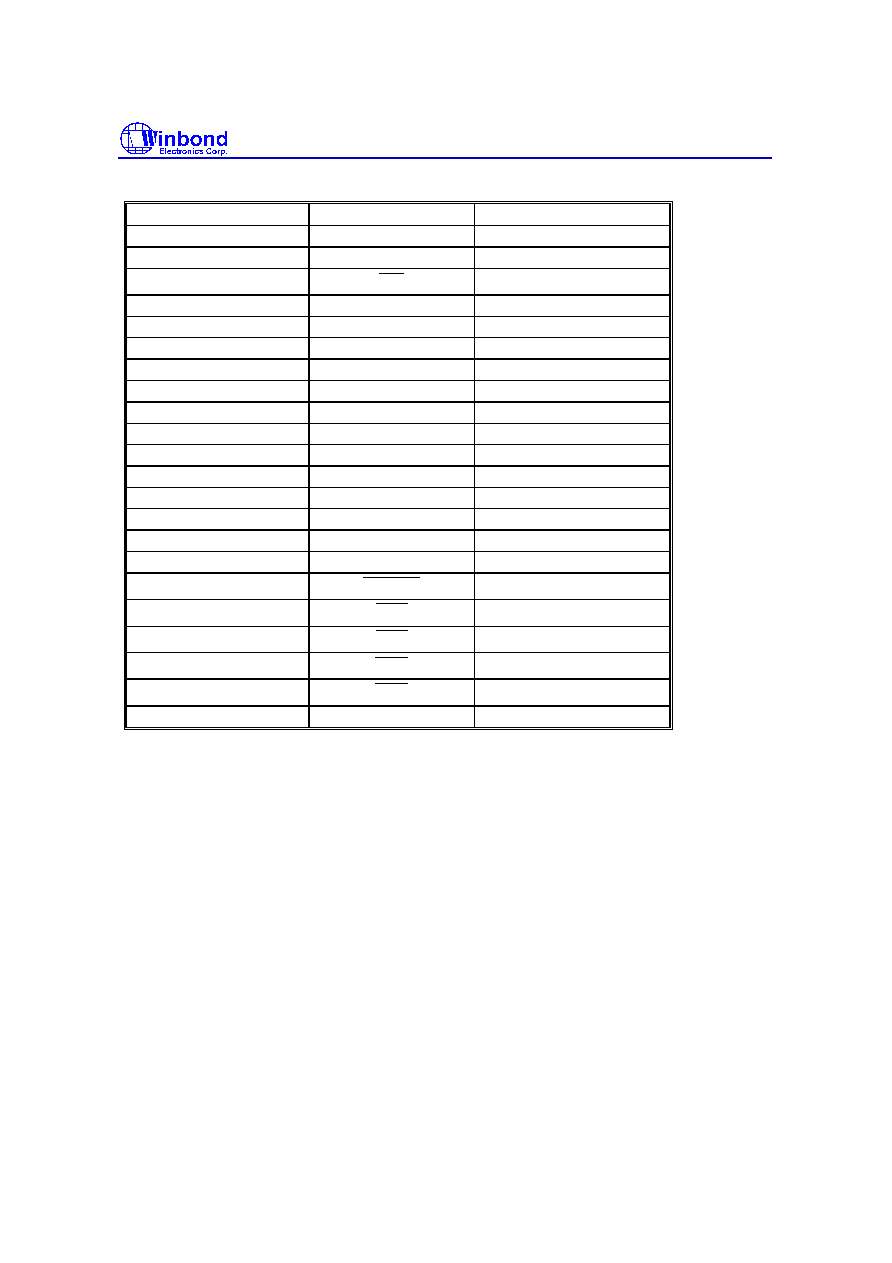
W83877ATF
Publication Release Date: April 1998
- 101 - Version 0.51
Table 7-1 IRQSER Sampling periods
IRQ/Data Frame
Signal Sampled
# of clocks past Start
1
IRQ0
2
2
IRQ1
5
3
SMI
8
4
IRQ3
11
5
IRQ4
14
6
IRQ5
17
7
IRQ6
20
8
IRQ7
23
9
IRQ8
26
10
IRQ9
29
11
IRQ10
32
12
IRQ11
35
13
IRQ12
38
14
IRQ13
41
15
IRQ14
44
16
IRQ15
47
17
IOCHCK
50
18
INTA
53
19
INTB
56
20
INTC
59
21
INTD
62
32:22
Unassigned
95
7.3 Stop Frame
After all IRQ/Data Frames have beencompleted, the host controller will terminate IRQSER by a Stop
frame. Only the host controller can initiate the Stop frame by driving IRQSER low for 2 or 3 clocks. If
the Stop Frame is low for 2 clocks, the next IRQSER cycle's Sample mode is the Quiet mode. If the
Stop Frame is low for 3 clocks, the next IRQSER cycle's Sample mode is the Continuous mode.
7.4 Reset and Initialization
After MR reset, IRQSER Slaves are put into the Continuous(Idle) mode. The Host Controller is
responsibe for starting the initial IRQSER Cycle to collect system's IRQ/Data default values. The
system then follows with the Continuous/Quiet mode protocol (Stop Frame pulse width) for
subsequent IRQSER cycles. It's the Host Controller's responsibility to provide the default values to
8259's and other system logic before the first IRQSER cycle is performed. For IRQSER system
suspend, insertion, or removal application, the Host controller should be programmed into
Continuous(Idle) mode first. This is to guarantee IRQSER bus in the Idle state before the system
configuration changes.
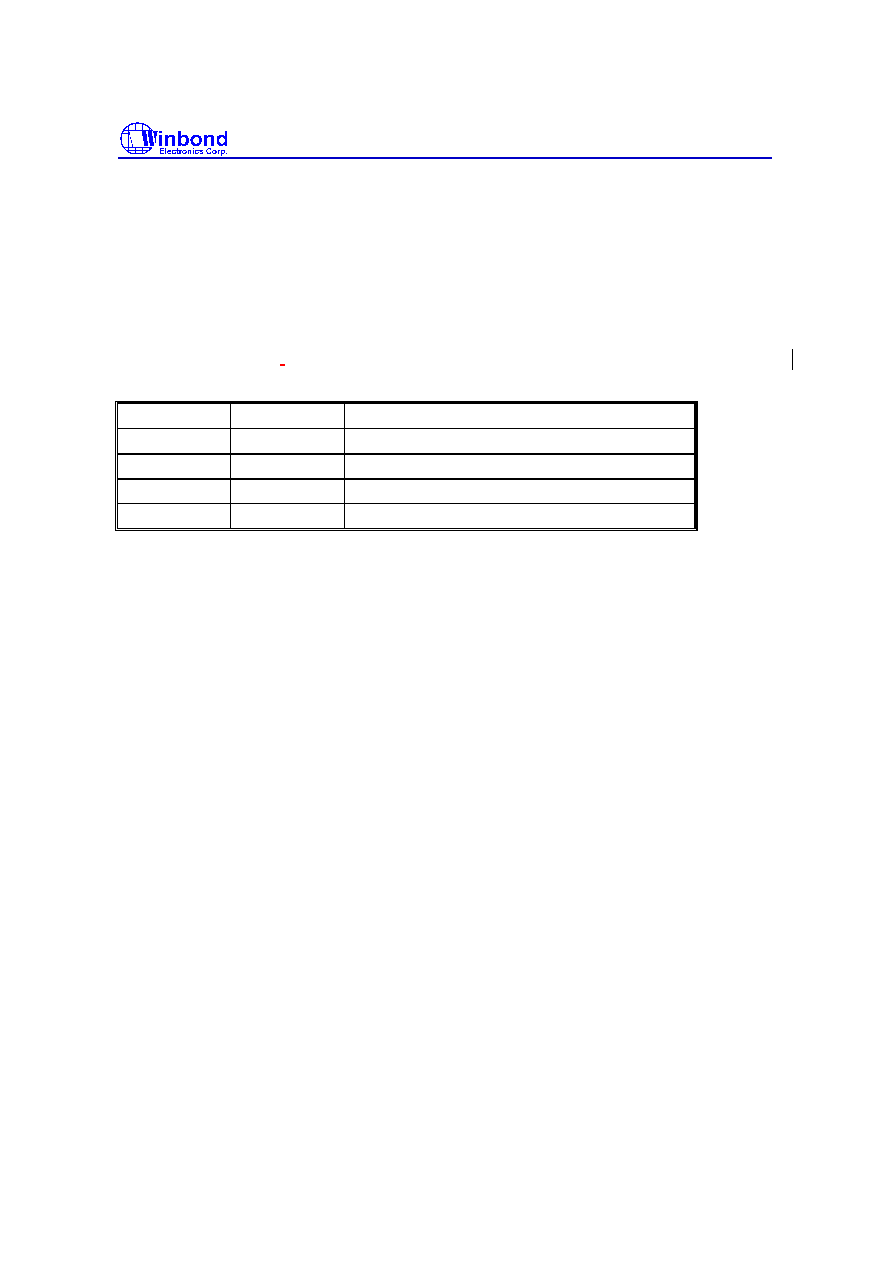
W83877ATF
Publication Release Date: April 1998
- 102 - Version 0.51
8.0 EXTENDED FUNCTION REGISTERS
The W83877ATF provides many configuration registers for setting up different types of
configurations. After power-on reset, the state of the hardware setting of each pin will be latched by
the relevant configuration register to allow the W83877ATF to enter the proper operating
configuration. To protect the chip from invalid reads or writes, the configuration registers cannot be
accessed by the user.
There are four ways to enable the configuration registers to be read or written. HEFERE (CR0C bit 5)
and HEFRAS (CR16 bit 0) can be used to select one out of these four methods of entering the
Extended Function mode
,
as follows:
HEFRAS
HEFERE
address and value
0
0
write 88H to the location 250H
0
1
write 89H to the location 250H (power-on default)
1
0
write 86H to the location 3F0H twice
1
1
write 87H to the location 3F0H twice
First, a specific value must be written once (88H/89H) or twice (86H/87H) to the Extended Functions
Enable Register (I/O port address 250H or 3F0H). Second, an index value (00H-19H, 20H-29H, 2CH-
2DH, 31H-3AH, 40H-45H) must be written to the Extended Functions Index Register (I/O port address
251H or 3F0H) to identify which configuration register is to be accessed. The designer can then
access the desired configuration register through the Extended Functions Data Register (I/O port
address 252H or 3F1H).
After programming of the configuration register is finished, an additional value should be written to
EFERs to exit the Extended Function mode, to prevent unintentional access to those configuration
registers. In the case of EFER at 250H, this additional value can be any value other than 88H if
HEFERE = 0 and 89H if HEFERE = 1. While EFER is at 3F0H, this additional value must be AAH.
The designer can also set bit 6 of CR9 (LOCKREG) to high to protect the configuration registers
against accidental accesses.
The configuration registers can be reset to their default or hardware settings only by a cold reset (pin
MR = 1). A warm reset will not affect the configuration registers.
8.1 Extended Functions Enable Registers (EFERs)
After a power-on reset, the W83877ATF enters the default operating mode. Before the W83877ATF
enters the extended function mode, a specific value must be programmed into the Extended Function
Enable Register (EFER) so that the extended function register can be accessed. The Extended
Function Enable Registers are write-only registers. On a PC/AT system, their port addresses are
250H or 3F0H (as described in the above section).
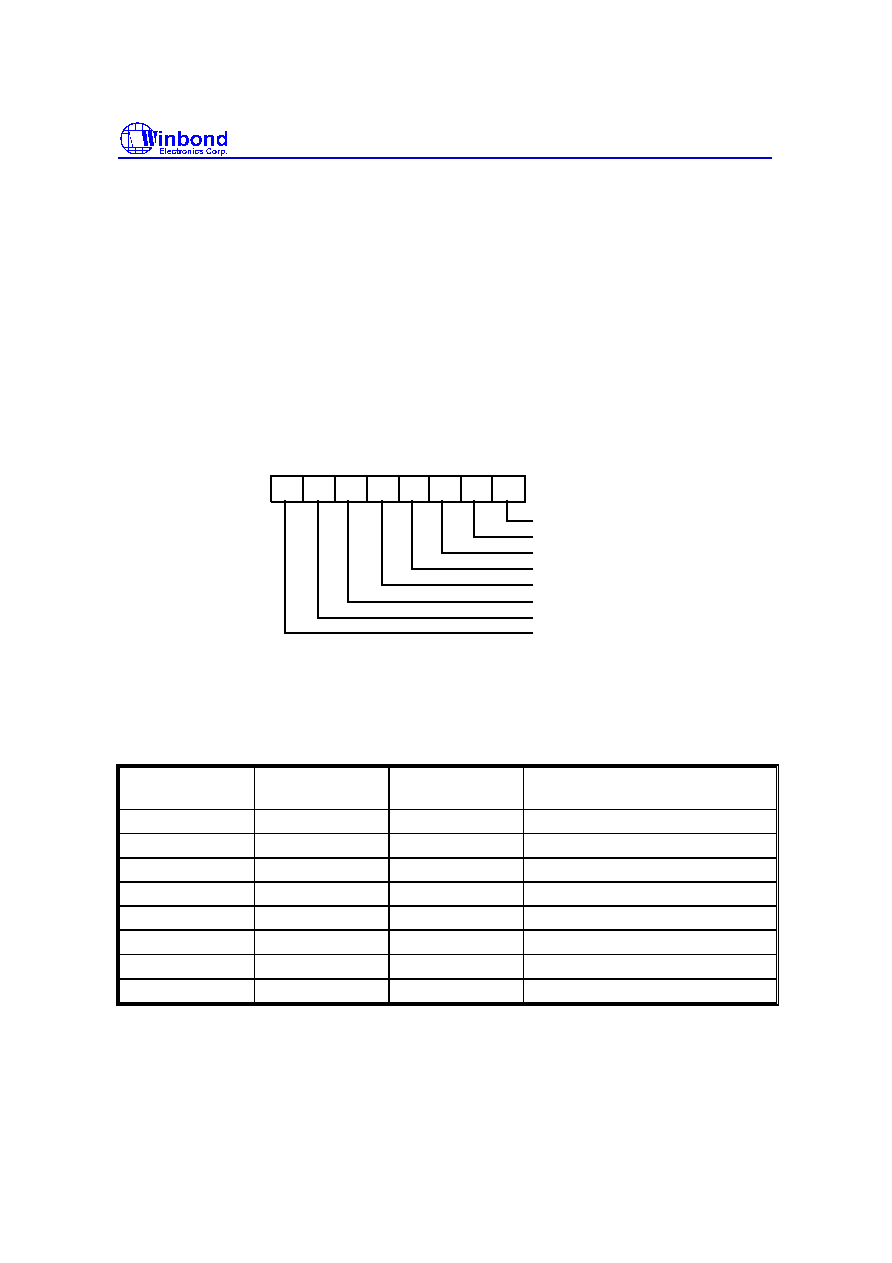
W83877ATF
Publication Release Date: April 1998
- 103 - Version 0.51
8.2 Extended Function Index Registers (EFIRs), Extended Function Data Registers
(EFDRs)
After the extended function mode is entered, the Extended Function Index Register (EFIR) must be
loaded with an index value (0H, 1H, 2H, ..., or 29H) to access Configuration Register 0 (CR0),
Configuration Register 1 (CR1), Configuration Register 2 (CR2), and so forth through the Extended
Function Data Register (EFDR). The EFIRs are write-only registers with port address 251H or 3F0H
(as described in section 8.0) on PC/AT systems; the EFDRs are read/write registers with port address
252H or 3F1H (as described in section 8.0) on PC/AT systems. The function of each configuration
register is described below.
8.2.1 Configuration Register 0 (CR0), default = 00H
When the device is in Extended Function mode and EFIR is 0H, the CR0 register can be accessed
through EFDR. The bit definitions for CR0 are as follows:
7 6 5 4 3 2 1 0
IPD
reserved
reserved
reserved
reserved
reserved
PRTMODS0
PRTMODS1
Bit 7-bit 4: Reserved.
PRTMOD1 PRTMOD0 (Bit 3, 2):
These two bits and PRTMOD2 (CR9 bit 7) determine the parallel port mode of the W83877ATF (as
shown in the following Table 8-1).
Table 8-1
PRTMODS2
(BIT 7 OF CR9)
PRTMODS1
(BIT 3 OF CR0)
PRTMODS0
(BIT 2 OF CR0)
0
0
0
Normal
0
0
1
EXTFDC
0
1
0
Reserved
0
1
1
EXT2FDD
1
0
0
Reserved
1
0
1
EPP/SPP
1
1
0
ECP
1
1
1
ECP/EPP

W83877ATF
Publication Release Date: April 1998
- 104 - Version 0.51
00
Normal Mode (Default), PRTMOD2 = 0
Default state after power-on reset. In this mode, the W83877ATF is fully compatible
with the SPP and BPP mode.
01
Extension FDD Mode (EXTFDD), PRTMOD2 = 0
10
Reserved, PRTMOD2 = 0
11
Extension 2FDD Mode (EXT2FDD), PRTMOD2 = 0
00
Reserved, PRTMOD2 = 1
01
EPP Mode and SPP Mode, PRTMOD2 = 1
10
ECP Mode, PRTMOD2 = 1
11
ECP Mode and EPP Mode, PRTMOD2 = 1
Bit 1: Reserved.
IPD (Bit 0):
This bit is used to select the W83877ATF's legacy power-down functions. When the bit 0 is set to 1,
the W83877ATF will stop its clock internally and enter power-down (IPD) mode immediately. The
W83877ATF will not leave the power-down mode until either a system power-on reset from the MR
pin
occurs, or until this bit is reset to 0 to program the chip back to power-on state.
8.2.2 Configuration Register 1 (CR1), default = 00H
When the device is in Extended Function mode and EFIR is 01H, the CR1 register can be accessed
through EFDR. The bit definitions are as follows:
7 6 5 4 3 2 1 0
reserved
reserved
reserved
reserved
reserved
reserved
reserved
ABCHG
ABCHG (Bit 7):
This bit enables the FDC AB Change Mode. Default to be enabled at power-on reset.
0
Drives A and B assigned as usual
1
Drive A and drive B assignments exchanged
Bit 6-bit 0: Reserved.
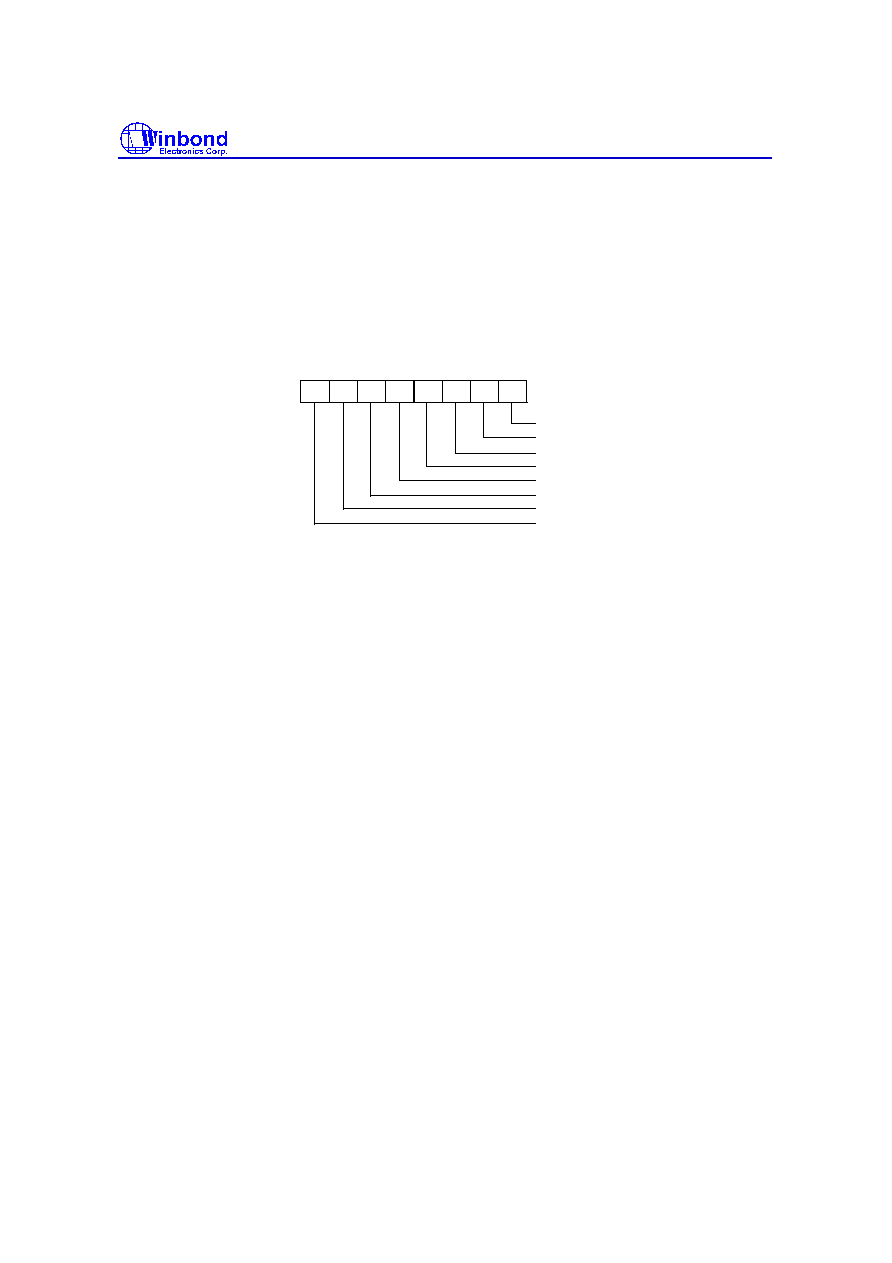
W83877ATF
Publication Release Date: April 1998
- 105 - Version 0.51
8.2.3 Configuration Register 2 (CR2), default = 00H
When the device is in Extended Function mode and EFIR is 02H, the CR2 register can be accessed
through EFDR. This register is reserved.
8.2.4 Configuration Register 3 (CR3), default = 30H
When the device is in Extended Function mode and EFIR is 03H, the CR3 register can be accessed
through EFDR. The bit definitions are as follows:
7 6 5 4 3 2 1 0
SUBMIDI
SUAMIDI
reserved
reserved
reserved
EPPVER
reserved
reserved
Bit 7-bit 6: Reserved.
EPPVER (Bit 5):
This bit selects the EPP version of parallel port:
0 Selects the EPP 1.9 version
1 Selects the EPP 1.7 version (default)
Bit 4: Reserved.
Bit 3-bit 2: Reserved.
SUAMIDI (Bit 1):
This bit selects the clock divide rate of UARTA.
0 Disables MIDI support, UARTA clock = 24 MHz divided by 13 (default)
1 Enables MIDI support, UARTA clock = 24 MHz divided by 12
SUBMIDI (Bit 0):
This bit selects the clock divide rate of UARTB.
0 Disables MIDI support, UARTB clock = 24 MHz divided by 13 (default)
1 Dnables MIDI support, UARTB clock = 24 MHz divided by 12
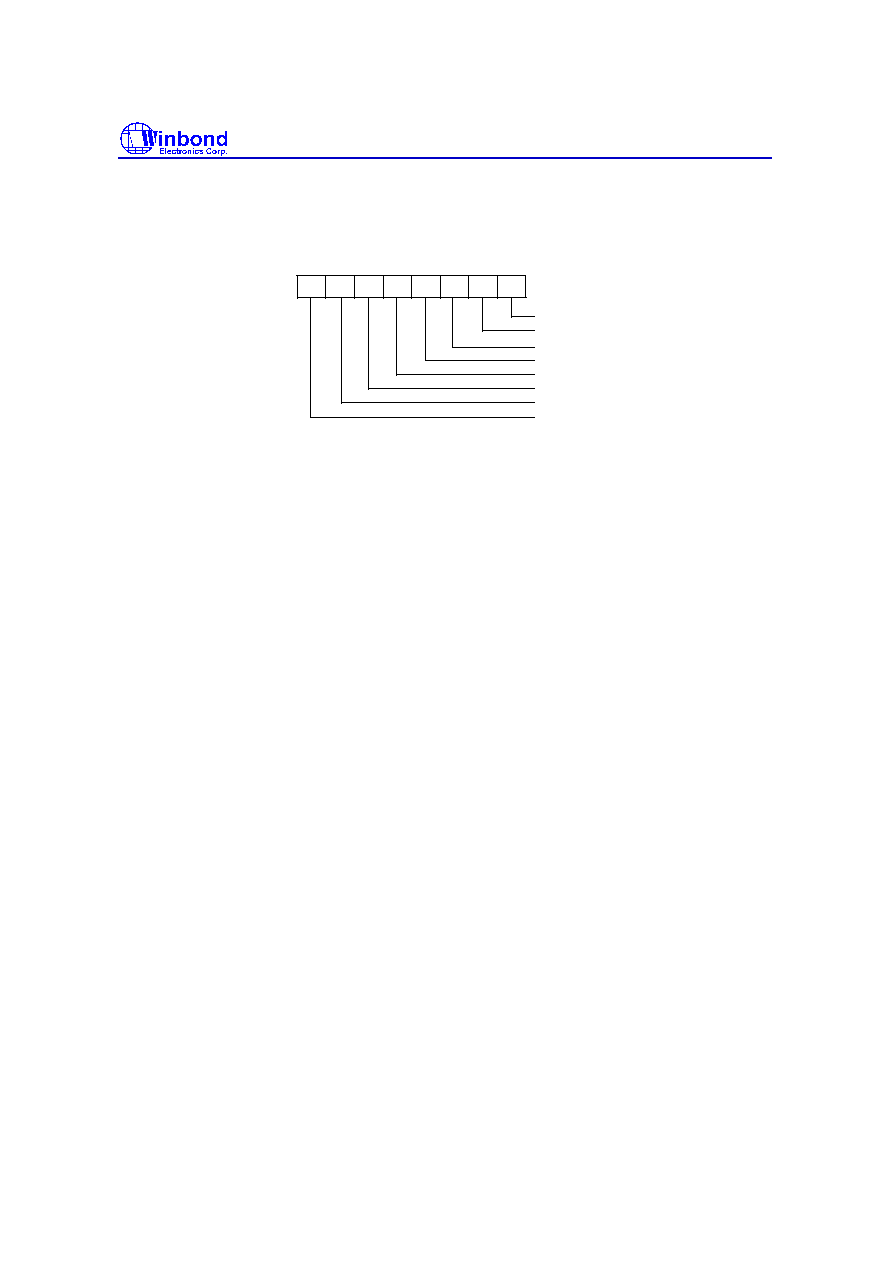
W83877ATF
Publication Release Date: April 1998
- 106 - Version 0.51
8.2.5 Configuration Register 4 (CR4), default = 00H
When the device is in Extended Function mode and EFIR is 04H, the CR4 register can be accessed
through EFDR. The bit definitions are as follows:
7 6 5 4 3 2 1 0
URBTRI
URATRI
reserved
PRTTRI
URBPWD
URAPWD
reserved
PRTPWD
PRTPWD (Bit 7):
0 Supplies power to the parallel port (default)
1 Puts the parallel port in power-down mode
Bit 6: Reserved.
URAPWD (Bit 5):
0 Supplies power to COMA (default)
1 Puts COMA in power-down mode
URBPWD (Bit 4):
0 Supplies power to COMB (default)
1 Puts COMB in power-down mode
PRTTRI (Bit 3):
This bit enables or disables the tri-state outputs of parallel port in power-down mode.
0 The output pins of the parallel port will not be tri-stated when parallel port is in power-
down mode. (default)
1 The output pins of the parallel port will be tri-stated when parallel port is in power-
down mode.
Bit 2: Reserved.
URATRI (Bit 1):
This bit enables or disables the tri-state outputs of UARTA in power-down mode.
0 The output pins of UARTA will not be tri-stated when UARTA is in power-down mode.
1 The output pins of UARTA will be tri-stated when UARTA is in power-down mode.
URBTRI (Bit 0):
This bit enables or disables the tri-state outputs of UARTB in power-down mode.
0 The output pins of UARTB will not be tri-stated when UARTB is in power-down mode.
1 The output pins of UARTB will be tri-stated when UARTB is in power-down mode.
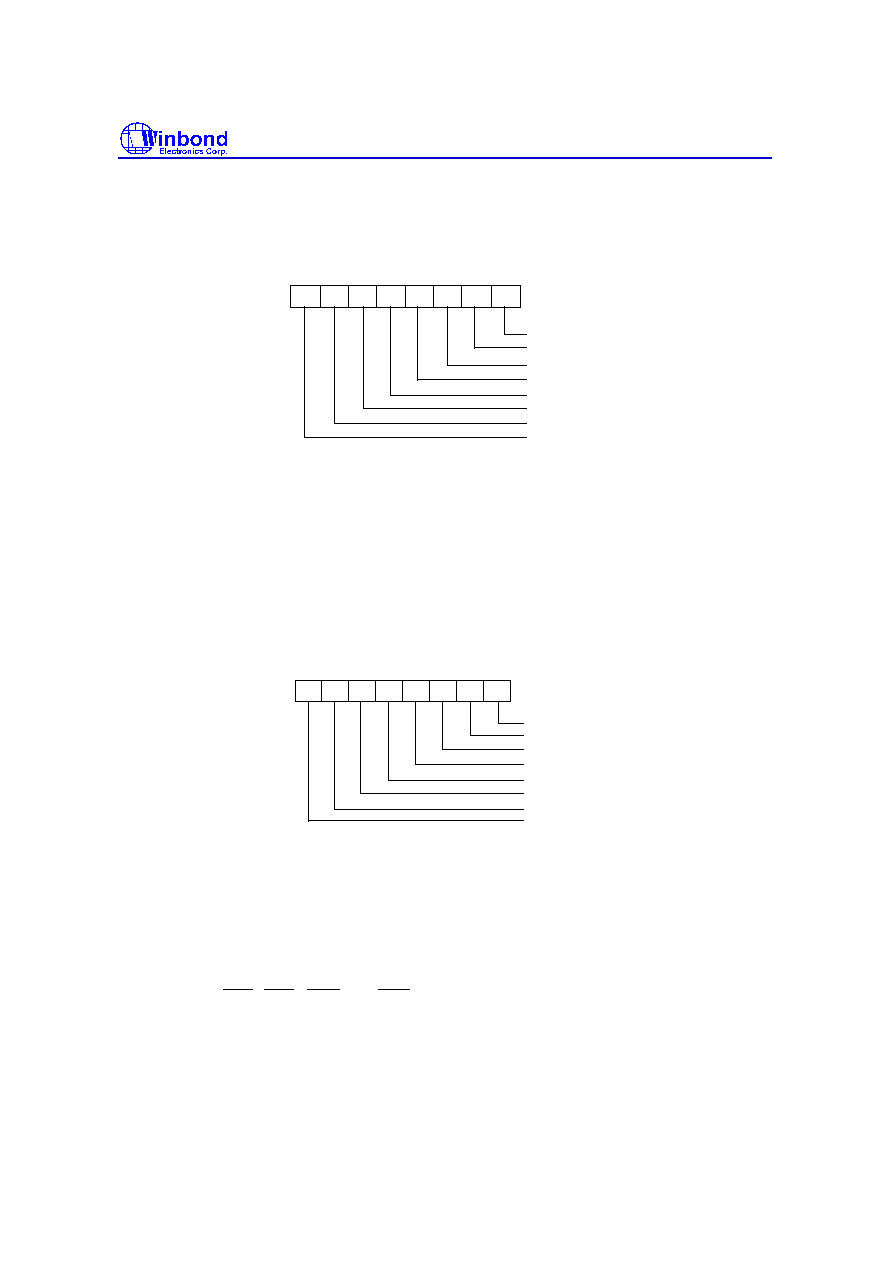
W83877ATF
Publication Release Date: April 1998
- 107 - Version 0.51
8.2.6 Configuration Register 5 (CR5), default = 00H
When the device is in Extended Function mode and EFIR is 05H, the CR5 register can be accessed
through EFDR. The bit definitions are as follows:
7 6 5 4 3 2 1
0
ECPFTHR0
ECPFTHR1
ECPFTHR2
reserved
reserved
reserved
reserved
ECPFTHR3
Bit 7- bit 4: Reserved
ECPFTHR3-0 (bit 3-0): These four bits define the FIFO threshold for the ECP mode parallel port. The
default value is 0000 after power-up.
8.2.7 Configuration Register 6 (CR6), default = 00H
When the device is in Extended Function mode and EFIR is 06H, the CR6 register can be accessed
through EFDR. The bit definitions are as follows:
7 6 5 4 3 2 1 0
FDCTRI
reserved
FDCPWD
FIPURDWM
SEL4FDD
reserved
reserved
reserved
Bit 7- bit 6: Reserved
SEL4FDD (Bit 5): Selects four FDD mode
0 Selects two FDD mode (default, see Table 8-2)
1 Selects four FDD mode
DSA , DSB ,
MOA and MOB output pins are encoded as show in Table 8-3 to select
four drives.
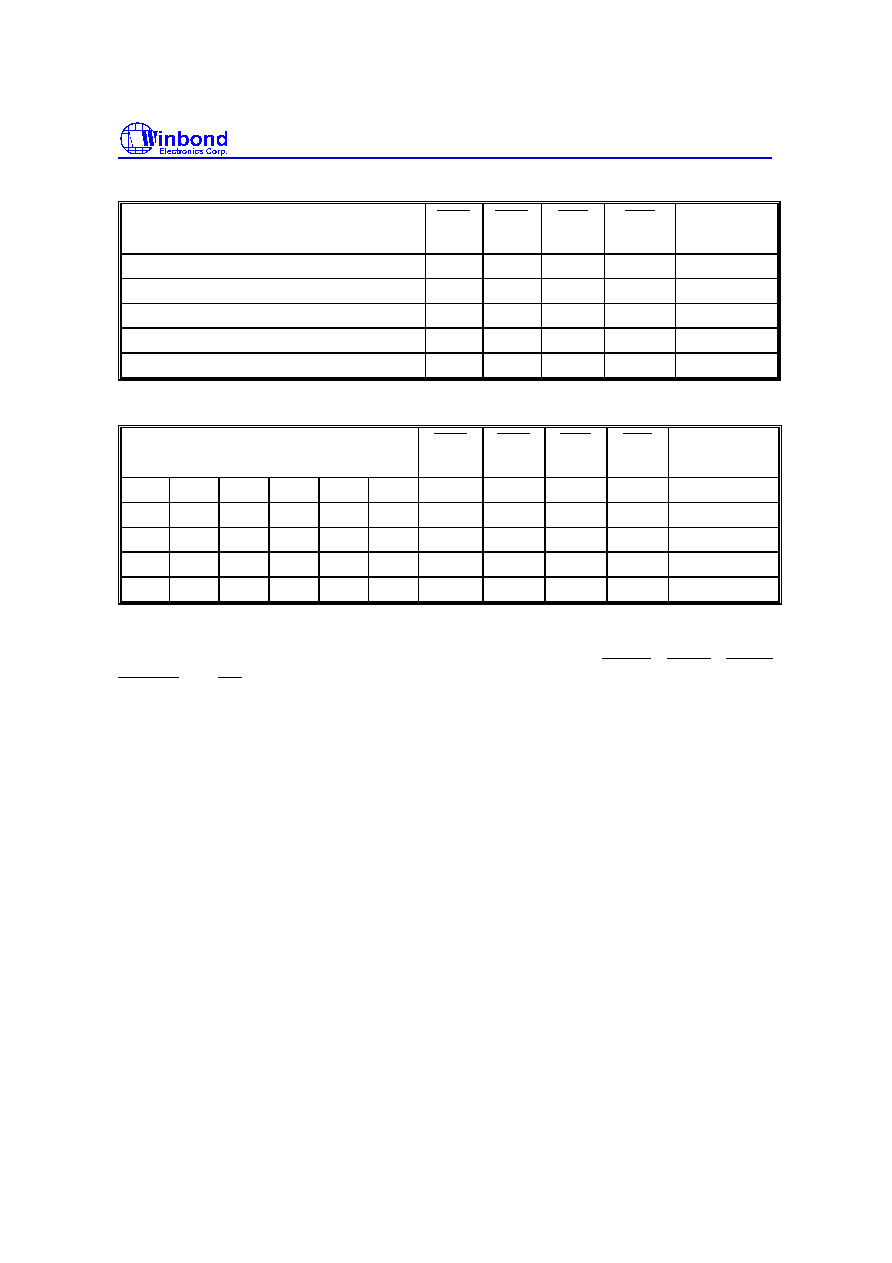
W83877ATF
Publication Release Date: April 1998
- 108 - Version 0.51
Table 8-2
DO REGISTER ( 3F2H )
MOB MOA
DSB
DSA
DRIVE
Bit 7 Bit 6 Bit 5 Bit 4 Bit 1 Bit 0
SELECTED
0
0
0
0
0
0
1
1
1
1
--
0
0
0
1
0
0
1
0
1
0
FDD A
0
0
1
0
0
1
0
1
0
1
FDD B
0
1
0
0
0
1
1
1
1
1
--
1
0
0
0
1
1
1
1
1
1
--
Table 8-3
DO REGISTER ( 3F2H )
MOB
MOA
DSB
DSA
DRIVE
Bit 7 Bit 6 Bit 5 Bit 4 Bit 1 Bit 0
SELECTED
0
0
0
0
X
X
1
1
x
x
--
0
0
0
1
0
0
0
0
0
0
FDD A
0
0
1
0
0
1
0
0
0
1
FDD B
0
1
0
0
1
0
0
0
1
0
FDD C
1
0
0
0
1
1
0
0
1
1
FDD D
FIPURDWN (Bit 4):
This bit controls the internal pull-up resistors of the FDC input pins RDATA , INDEX , TRAK0,
DSKCHG , and WP.
0 The internal pull-up resistors of FDC are turned on. (default)
1 The internal pull-up resistors of FDC are turned off.
FDCPWD (Bit 3):
This bit controls the power to the FDC.
0 Power is supplied to the FDC. (default)
1 Puts the FDC in power-down mode.
Bit 2: Reserved.
FDCTRI (Bit 1):
This bit enables or disables the tri-state outputs of the FDC in power-down mode.
0 The output pins of the FDC will not be tri-stated when FDC is in power-down mode.
1 The output pins of the FDC will be tri-stated when FDC is in power-down mode.
Bit 0: Reserved.
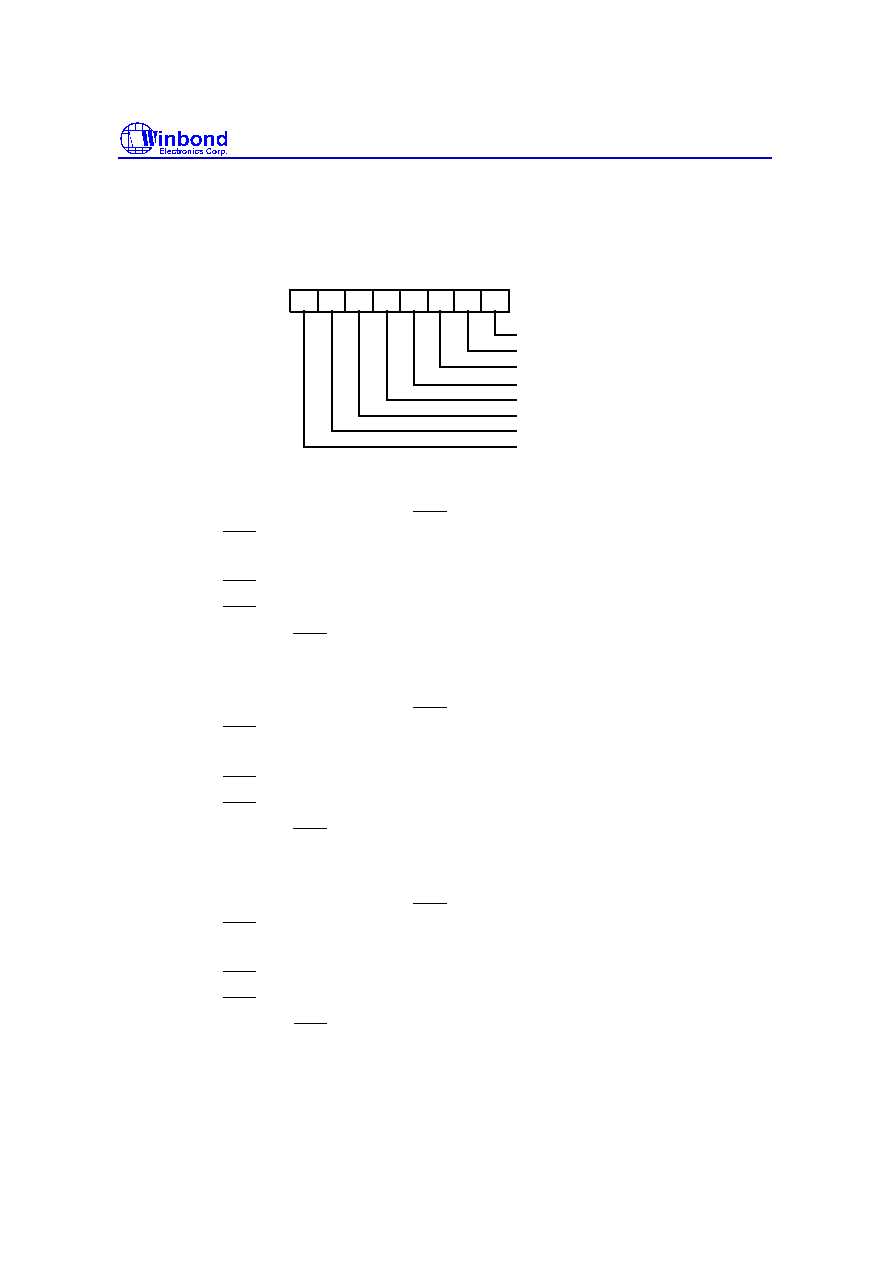
W83877ATF
Publication Release Date: April 1998
- 109 - Version 0.51
8.2.8 Configuration Register 7 (CR7), default = 00H
When the device is in Extended Function mode and EFIR is 07H, the CR7 register can be accessed
through EFDR. The bit definitions are as follows:
7 6 5 4 3 2 1 0
FDD A type 0
FDD A type 1
FDD B type 0
FDD B type 1
FDD C type 0
FDD C type 1
FDD D type 0
FDD D type 1
FDD D type 1, 0 (Bit 7, 6):
These two bits select the type of FDD D.
00 Selects normal mode. When RWC = 0, the data transfer rate is 250 Kb/s. When
RWC = 1, the data transfer rate is 500 Kb/s.
Three mode FDD select (EN3MODE = 1):
01 RWC = 0, selects 1.2 MB high-density FDD.
10 RWC = 1, selects 1.44 MB high-density FDD.
11 Don't care RWC, selects 720 KB double-density FDD.
FDD C type 1, 0 (Bit 5, 4):
These two bits select the type of FDD C.
00 Selects normal mode. When RWC = 0, the data transfer rate is 250 kb/s. When
RWC = 1, he data transfer rate is 500 kb/s.
Three mode FDD select (EN3MODE = 1):
01 RWC = 0, selects 1.2 MB high-density FDD.
10 RWC = 1, selects 1.44 MB high-density FDD.
11 Don't care RWC, selects 720 KB double-density FDD.
FDD B type 1, 0 (Bit 3, 2):
These two bits select the type of FDD B.
00 Selects normal mode. When
RWC = 0, the data transfer rate is 250 Kb/s. When
RWC = 1, the data transfer rate is 500 Kb/s.
Three mode FDD select (EN3MODE = 1):
01 RWC = 0, selects 1.2 MB high-density FDD.
10 RWC = 1, selects 1.44 MB high-density FDD.
11 Don't care
RWC, selects 720 KB double-density FDD.

W83877ATF
Publication Release Date: April 1998
- 110 - Version 0.51
FDD A type 1, 0 (Bit 1, 0):
These two bits select the type of FDD A.
00 Selects normal mode. When RWC = 0, the data transfer rate is 250 Kb/s. When
RWC = 1, the data transfer rate is 500 Kb/s.
Three mode FDD select (EN3MODE = 1):
01 RWC = 0, selects 1.2 MB high-density FDD.
10 RWC = 1, selects 1.44 MB high-density FDD.
11 Don't care RWC
,
selects 720 KB double-density FDD.
8.2.9 Configuration Register 8 (CR8), default = 00H
When the device is in Extended Function mode and EFIR is 08H, the CR8 register can be accessed
through EFDR. The bit definitions are as follows:
7 6 5 4 3 2 1 0
Floppy Boot Drive 0
Floppy Boot Drive 1
Media ID 0
Media ID 1
DISFDDWR
reserved
reserved
SWWP
Bit 7 - bit 6: Reserved.
DISFDDWR (Bit 5):
This bit enables or disables FDD write data.
0 Enables FDD write
1 Disables FDD write (forces pins WE, WD to stay high)
Once this bit is set high, the FDC operates normally, but because pin WE
is inactive, the FDD will not
write data to diskettes. For example, if a diskette is formatted with DISFDDWR = 1, after the format
command has been executed, messages will be displayed that appear to indicate that the format is
complete. If the diskette is removed from the disk drive and inserted again, however, typing the DIR
command will reveal that the contents of the diskette have not been modified and the diskette was
not actually reformatted.

W83877ATF
Publication Release Date: April 1998
- 111 - Version 0.51
Because as the operating system (e.g., DOS) reads the diskette files, it keeps the files in memory. If
there is a write operation, DOS will write data to the diskette and memory simultaneously. When DOS
wants to read the diskette, it will first search the files in memory. If DOS finds the file in memory, it
will not issue a read command to read the diskette. When DISFDDWR = 1, DOS still writes data to
the diskette and memory, but only the data in memory are updated. If a read operation is performed,
data are read from memory first, and not from the diskette. The action of removing the diskette from
the drive and inserting it again forces the DSKCHG pin active. DOS will then read the contents of the
diskette and will show that the contents have not been modified. The same holds true with write
commands.
This disable FDD write function allows users to protect diskettes against computer viruses by ensuring
that no data are written to the diskette.
SWWP (Bit 4):
0 Normal, use
WP
to determine whether the FDD is write-protected or not
1 FDD is always write-protected
Media ID 1 Media ID 0 (Bit 3, 2):
These two bits hold the media ID bit 1, 0 for three mode
Floppy Boot Drive 1 Floppy Boot Drive 0 (Bit 1, 0)
These two bits hold the value of floppy boot drive 1 and drive 0 for three mode
8.2.10 Configuration Register 9 (CR9),
default = 0DH
When the device is in Extended Function mode and EFIR is 09H, the CR9 register can be accessed
through EFDR. The bit definitions are as follows:
7 6 5 4 3 2 1 0
CHIP ID0
CHIP ID1
CHIP ID2
CHIP ID3
reserved
LOCKREG
EN3MODE
PRTMODS2
PRTMODS2 (Bit 7):
This bit and PRTMODS1, PRTMODS0 (bits 3, 2 of CR0) select the operating mode of the
W83877ATF. Refer to the descriptions of CR0.
LOCKREG (Bit 6):
This bit enables or disables the reading and writing of all configuration registers.
0 Enables the reading and writing of CR0-CR45
1 Disables the reading and writing of CR0-CR45 (locks W83877ATF extension
functions)
EN3MODE (Bit 5):
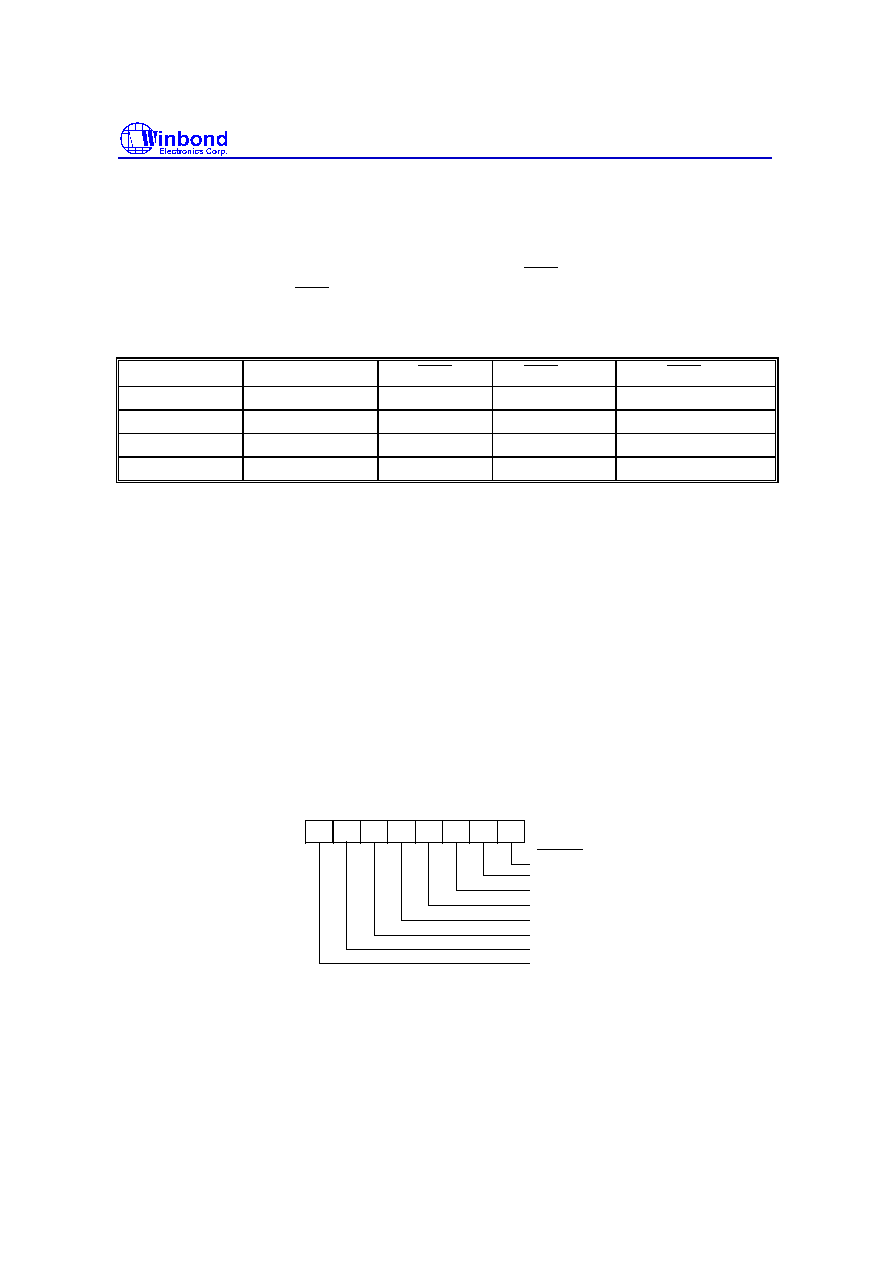
W83877ATF
Publication Release Date: April 1998
- 112 - Version 0.51
This bit enables or disables three mode FDD selection. When this bit is high, it enables the read/write
3F3H register.
0 Disables 3 mode FDD selection
1 Enables 3 mode FDD selection
When three mode FDD function is enabled, the value of RWC depends on bit 5 and bit 4 of
TDR(3F3H). The values of RWC and their meaning are shown in Table 8-4.
Table 8-4
BIT 5 OF TDR
BIT 4 OF TDR
RWC
RWC = 0
RWC = 1
0
0
Normal
250K bps
500K bps
0
1
0
1.2 M FDD
X
1
0
1
X
1.4M FDD
1
1
X
X
X
Bit 4: Reserved.
CHIP ID 3, CHIP ID 2, CHIP ID 1, CHIP ID 0 (Bit 3-bit 0):
These four bits are read-only bits that contain chip identification information. The value is 0DH for
W83877ATF during a read.
8.2.11 Configuration Register A (CR0A),
default = 00H
When the device is in Extended Function mode and EFIR is 0AH, the CRA register can be accessed
through EFDR. This register is reserved.
8.2.12 Configuration Register B (CR0B), default = 0CH
When the device is in Extended Function mode and EFIR is 0BH, the CRB register can be accessed
through EFDR. The bit definitions are as follows:
1
2
3
4
5
6
7
0
DRV2EN
INVERTZ
IDENT
ENIFCHG
MFM
RXW4C
TXW4C
reserved
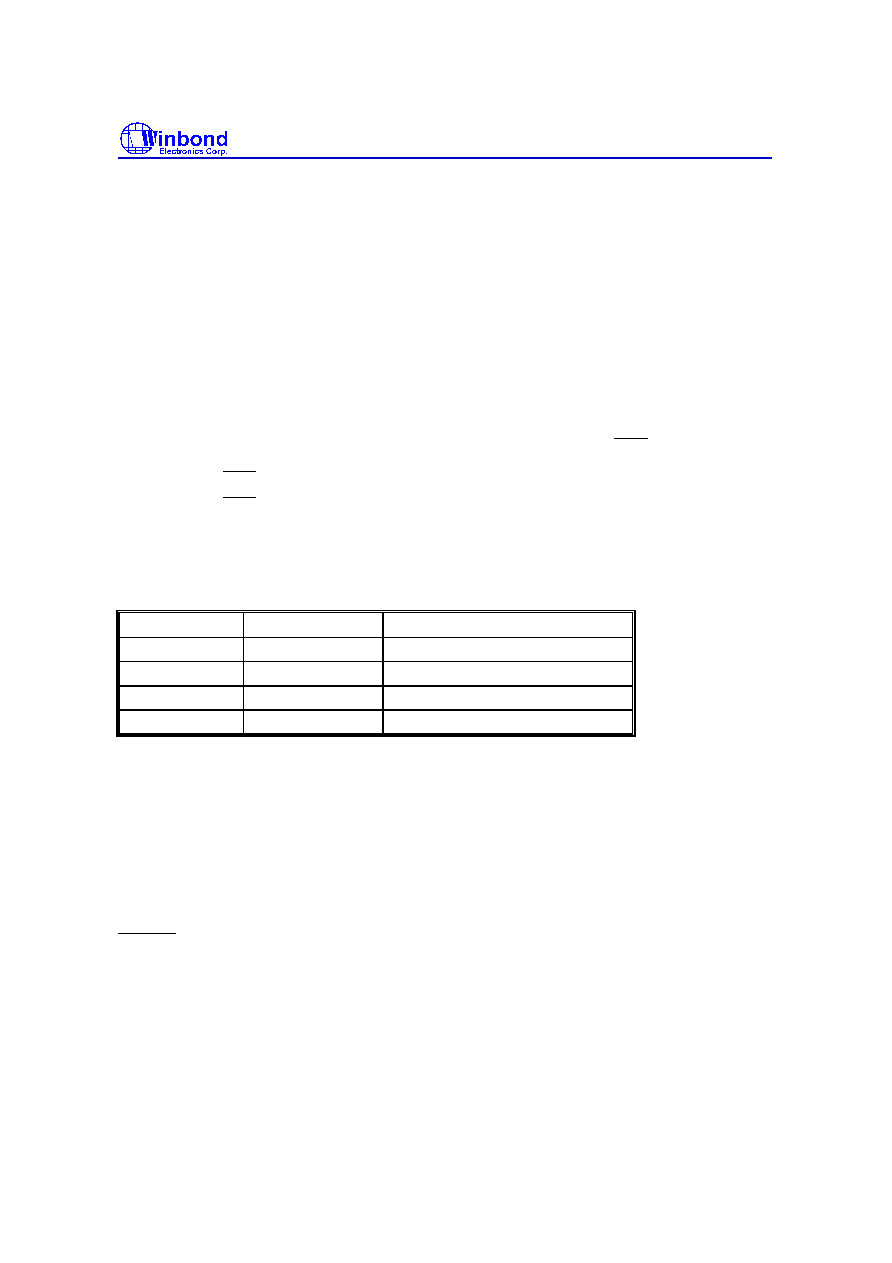
W83877ATF
Publication Release Date: April 1998
- 113 - Version 0.51
Bit 7: Reserved.
TXW4C (Bit 6):
This bit is active high. When active, the IR controller will wait for a 4-character period of time from the
end of last receiving before it can start transmitting data.
RXW4C (Bit 5):
This bit is active high. When active, the IR controller will wait for a 4-character period of time from the
end of last transmitting before it can start receiving data.
ENIFCHG (Bit 4):
This bit is active high. When active, it enables host interface mode change, which is determined by
IDENT (Bit 3) and MFM (Bit 2).
IDENT (Bit 3):
This bit indicates the type of drive being accessed and changes the level on RWC (pin 87).
0 RWC will be active low for high data rates (typically used for 3.5" drives)
1 RWC will be active high for high data rates (typically used for 5.25" drives)
When hardware reset or ENIFCHG is a logic 1, IDENT and MFM select one of three interface modes,
as shown in Table 8-5.
Table 8-5
IDENT
MFM
INTERFACE
0
0
Model 30 mode
0
1
PS/2 mode
1
0
AT mode
1
1
AT mode
MFM (Bit 2):
This bit and IDENT select one of the three interface modes (PS/2 mode, Model 30, or PC/AT mode).
INTVERTZ (Bit 1):
This bit determines the polarity of all FDD interface signals.
0 FDD interface signals are active low
1 FDD interface signals are active high
DRV2EN (Bit 0): PS/2 mode only
When this bit is a logic 0, indicates a second drive is installed and is reflected in status register A.
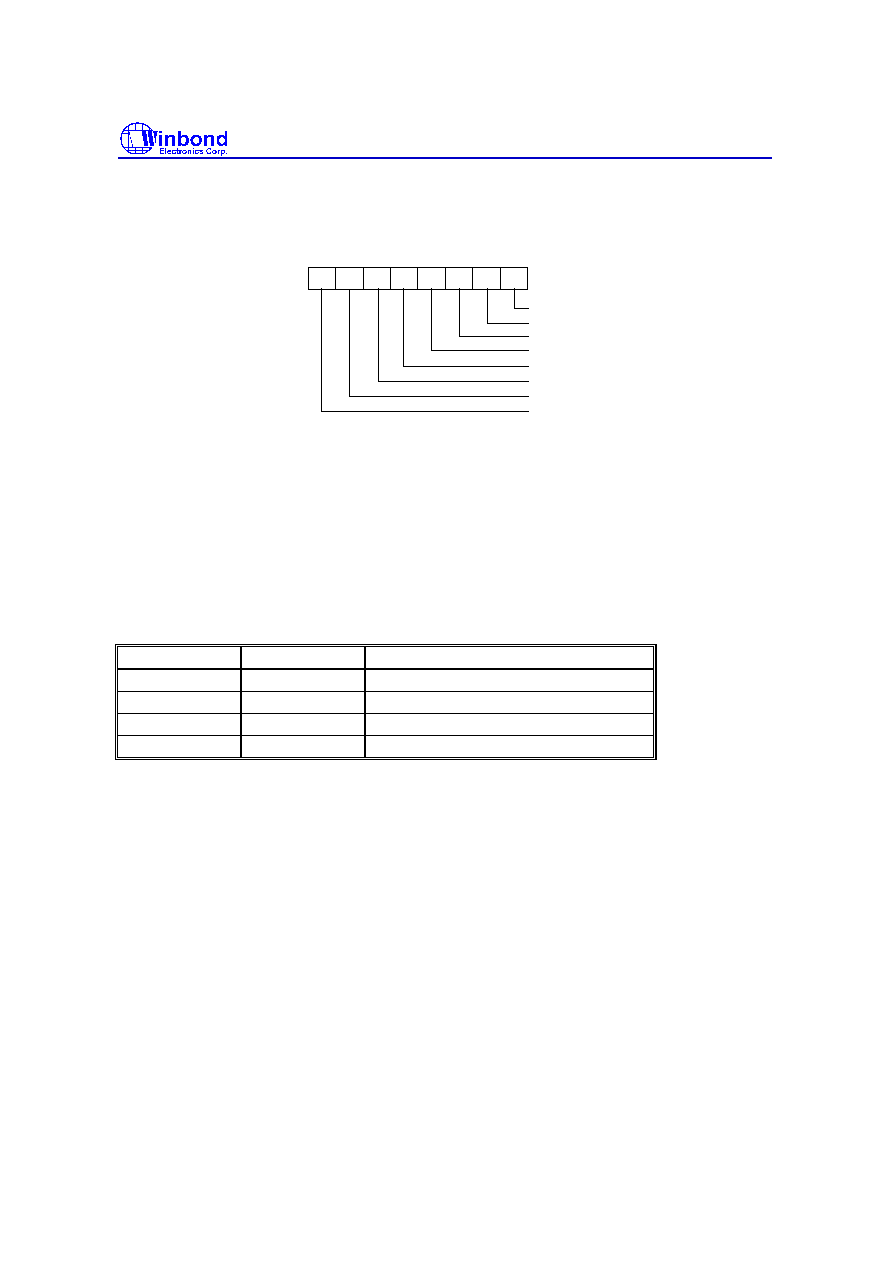
W83877ATF
Publication Release Date: April 1998
- 114 - Version 0.51
8.2.13 Configuration Register C (CR0C), default = 28H
When the device is in Extended Function mode and EFIR is 0CH, the CR0C register can be accessed
through EFDR. The bit definitions are as follows:
1
2
3
4
5
6
7
0
TX2INV
RX2INV
reserved
URIRSEL
reserved
HEFERE
TURB
TURA
TURA (Bit 7):
0 the clock source of UART A is 1.8462 MHZ (24 MHz divide 13) (default)
1 the clock source of UART A is 24 MHz, it can make the baudrate of UART A up to 1.5
MHz
TURB (Bit 6):
0 the clock source of UART B is 1.8462 MHz (24 MHz divide 13) (default)
1 the clock source of UART B is 24 MHz, it can make the baudrate of UART A up to 1.5
MHz
HEFERE (Bit 5): this bit combines with HEFRAS (CR16 bit 0) to define how to enable Extended
Function Registers.
HEFRAS
HEFERE
address and value
0
0
write 88H to the location 250H
0
1
write 89H to the location 250H (default)
1
0
write 86H to the location 3F0H twice
1
1
write 87H to the location 3F0H twice
The default value of HEFERE is 1.
Bit 4: Reserved.
URIRSEL (Bit 3):
0 select UART B as IR function.
1 select UART B as normal function.
The default value of URIRSEL is 1.
Bit 2: Reserved.
RX2INV (Bit 1):
0 the SINB pin of UART B function or IRRX pin of IR function in normal condition.
1 inverse the SINB pin of UART B function or IRRX pin of IR function
TX2INV (Bit 0):
0 the SOUTB pin of UART B function or IRTX pin of IR function in normal condition.
1 inverse the SOUTB pin of UART B function or IRTX pin of IR function.
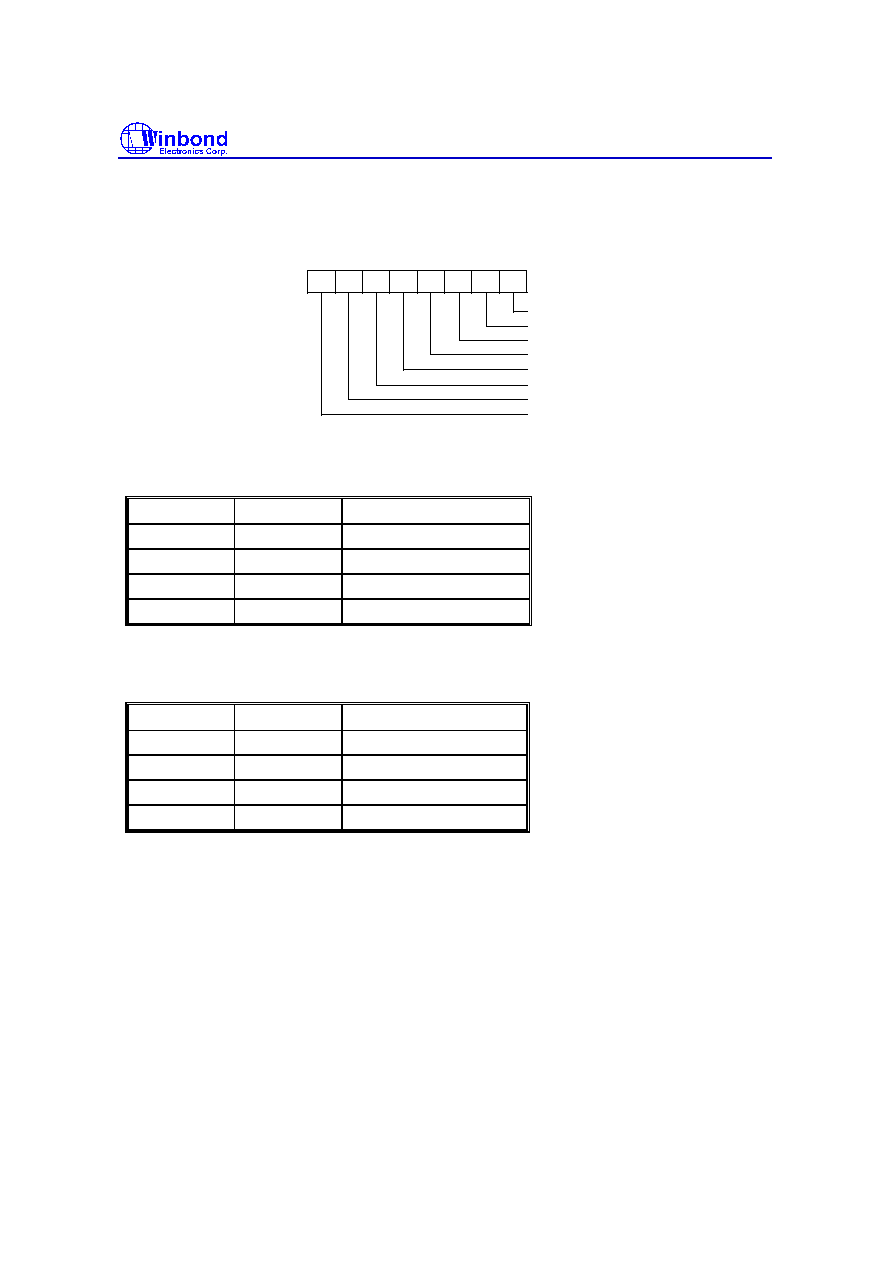
W83877ATF
Publication Release Date: April 1998
- 115 - Version 0.51
8.2.14 Configuration Register D (CR0D), default = A3H
When the device is in Extended Function mode and EFIR is 0DH, the CR0D register can be accessed
through EFDR. The bit definitions are as follows:
1
2
3
4
5
6
7
0
SIRTX1
SIRTX0
SIRRX1
SIRRX0
HDUPLX
IRMODE2
IRMODE1
IRMODE0
SIRTX1 (Bit 7): IRTX pin selection bit 1
SIRTX0 (Bit 6): IRTX pin selection bit 0
SIRTX1
SIRTX0
IRTX output on pin
0
0
disabled
0
1
IRTX1 (pin 43)
1
0
IRTX2 (pin 95)
1
1
disabled
SIRRX1 (Bit 5): IRRX pin selection bit 1
SIRRX0 (Bit 4): IRRX pin selection bit 0
SIRRX1
SIRRX0
IRRX input on pin
0
0
disabled
0
1
IRRX1 (pin 42)
1
0
IRRX2 (pin 94)
1
1
disabled
HDUPLX (Bit 3):
0 The IR function is Full Duplex.
1 The IR function is Half Duplex.
IRMODE2 (Bit 2): IR function mode selection bit 2
IRMODE1 (Bit 1): IR function mode selection bit 1
IRMODE0 (Bit 0): IR function mode selection bit 0
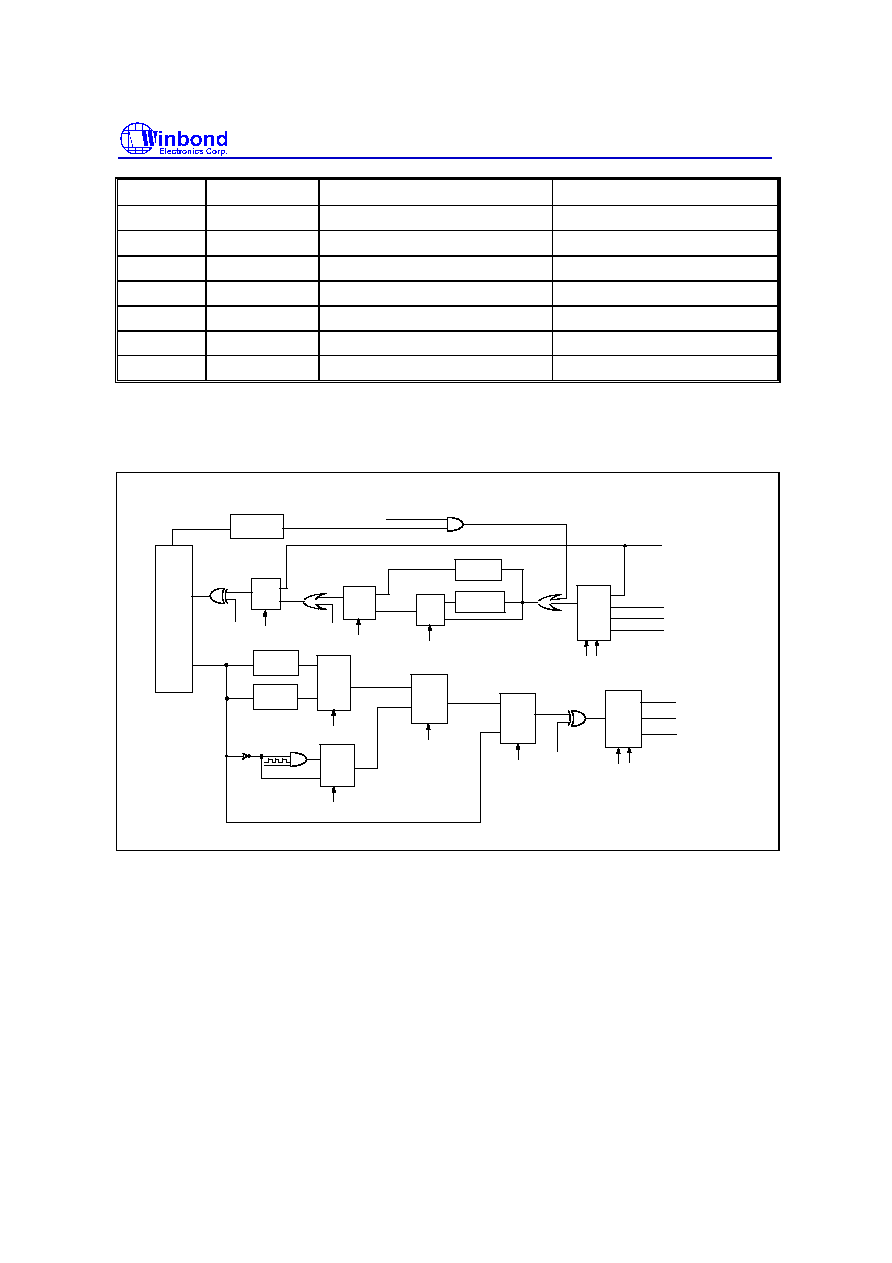
W83877ATF
Publication Release Date: April 1998
- 116 - Version 0.51
IR MODE IR FUNCTION
IRTX
IRRX
00X
Disable
tri-state
high
010*
IrDA
Active pulse 1.6
�
S
Demodulation into SINB
011*
IrDA
Active pulse 3/16 bit time
Demodulation into SINB
100
ASK-IR
Inverting IRTX pin
routed to SINB
101
ASK-IR
Inverting IRTX & 500 KHZ clock
routed to SINB
110
ASK-IR
Inverting IRTX
Demodulation into SINB
111*
ASK-IR
Inverting IRTX & 500 KHZ clock
Demodulation into SINB
Note: The notation is normal mode in the IR function.
The SIR schematic diagram for registers CRC and CRD is shown below.
1
0
1
MUX 0
1
0
01
00
10
11
11,00
01
10
1 MUX
0
1 MUX
0
1
0 MUX
IRDA Mod.
3/16
IRDA Mod.
Mod1.6u
IRDA
IRMODE0
IRMODE2
(CRD.bit2)
URIRSEL
(CRC,bit3)
Transmission
Time Frame
16550A
SIN
UART2
SOUT
RX2INV
(CRC.bit1)
URIRSEL
(CRC.bit3)
1
0 MUX
SIRRX1~0
CR0D.bit5,4
ASK_IR
SIN2
IRMODE1
(CRD.bit3)
HUPLX
IRMODE0
(CRD.bit0)
500KHZ
MUX
MUX
(CRD.bit1)
IRMODE2
(CRD.bit2)
IRMODE2,1=00
(CRD.bit0)
disable
IRTX1
IRTX2
SOUT2
NCS1
IRRX1
IRRX2
+5V
NCS0
+5V
SIRTX1~0
CRD.bit7,6
TX2INV
CRC.bit0
MUX
MUX
IR-DA
Demodulation
Demodulation
(default)
(default)
8.2.15 Configuration Register E (CR0E), Configuration Register F (CR0F)
Reserved for testing. Should be kept all 0's.

W83877ATF
Publication Release Date: April 1998
- 117 - Version 0.51
8.2.16 Configuration Register 10 (CR10), default = 00H
When the device is in Extended Function mode and EFIR is 10H, the CR10 register can be accessed
through EFDR. The bit definitions are as follows:
1
2
3
4
5
6
7
0
GIO0AD7
GIO0AD0
GIO0AD1
GIO0AD2
GIO0AD3
GIO0AD4
GIO0AD5
GIO0AD6
GIO0AD7-GIO0AD0 (Bit 7-bit 0): GIOP0 (pin 92) address bit 7 - bit 0.
8.2.17 Configuration Register 11 (CR11), default = 00H
When the device is in Extended Function mode and EFIR is 11H, the CR11 register can be accessed
through EFDR. The bit definitions are as follows:
1
2
3
4
5
6
7
0
G0CADM1
GIO0AD8
GIO0AD9
GIO0AD10
reserved
G0CADM0
reserved
reserved
G0CADM1-G0CADM0 (Bit 7, 6): GIOP0 address bit compare mode selection
G0CADM1
G0CADM0
GIOP0 pin
0
0
compare GIO0AD10-GIO0AD0 with SA10-SA0
0
1
compare GIO0AD10-GIO0AD1 with SA10-SA1
1
0
compare GIO0AD10-GIO0AD2 with SA10-SA2
1
1
compare GIO0AD10-GIO0AD3 with SA10-SA3
Bit 5-bit 3: Reserved
GIO0AD10-GIO0AD8 (Bit 2-bit 0): GIOP0 (pin 92) address bit 10-bit 8.

W83877ATF
Publication Release Date: April 1998
- 118 - Version 0.51
8.2.18 Configuration Register 12 (CR12), default = 00H
When the device is in Extended Function mode and EFIR is 12H, the CR12 register can be accessed
through EFDR. The bit definitions are as follows:
1
2
3
4
5
6
7
0
GIO1AD7
GIO1AD0
GIO1AD1
GIO1AD2
GIO1AD3
GIO1AD4
GIO1AD5
GIO1AD6
GIO1AD7-GIO1AD0 (Bit 7-bit 0): GIOP1 (pin 96) address bit 7-bit 0.
8.2.19 Configuration Register 13 (CR13), default = 00H
When the device is in Extended Function mode and EFIR is 13H, the CR13 register can be accessed
through EFDR. The bit definitions are as follows:
1
2
3
4
5
6
7
0
G1CADM1
GIO1AD8
GIO1AD9
GIO1AD10
reserved
G1CADM0
reserved
reserved
G1CADM1-G1CADM0 (bit 7, 6): GIOP1 address bit compare mode selection
G1CADM1
G1CADM0
GIOP1 pin
0
0
compare GIO1AD10-GIO1AD0 with SA10-SA0
0
1
compare GIO1AD10-GIO1AD1 with SA10-SA1
1
0
compare GIO1AD10-GIO1AD2 with SA10-SA2
1
1
compare GIO1AD10-GIO1AD3 with SA10-SA3
Bit 5- bit 3: Reserved
GIO1AD10-GIO1AD8 (Bit 2-bit 0): GIOP1 (pin 96) address bit 10-bit 8.
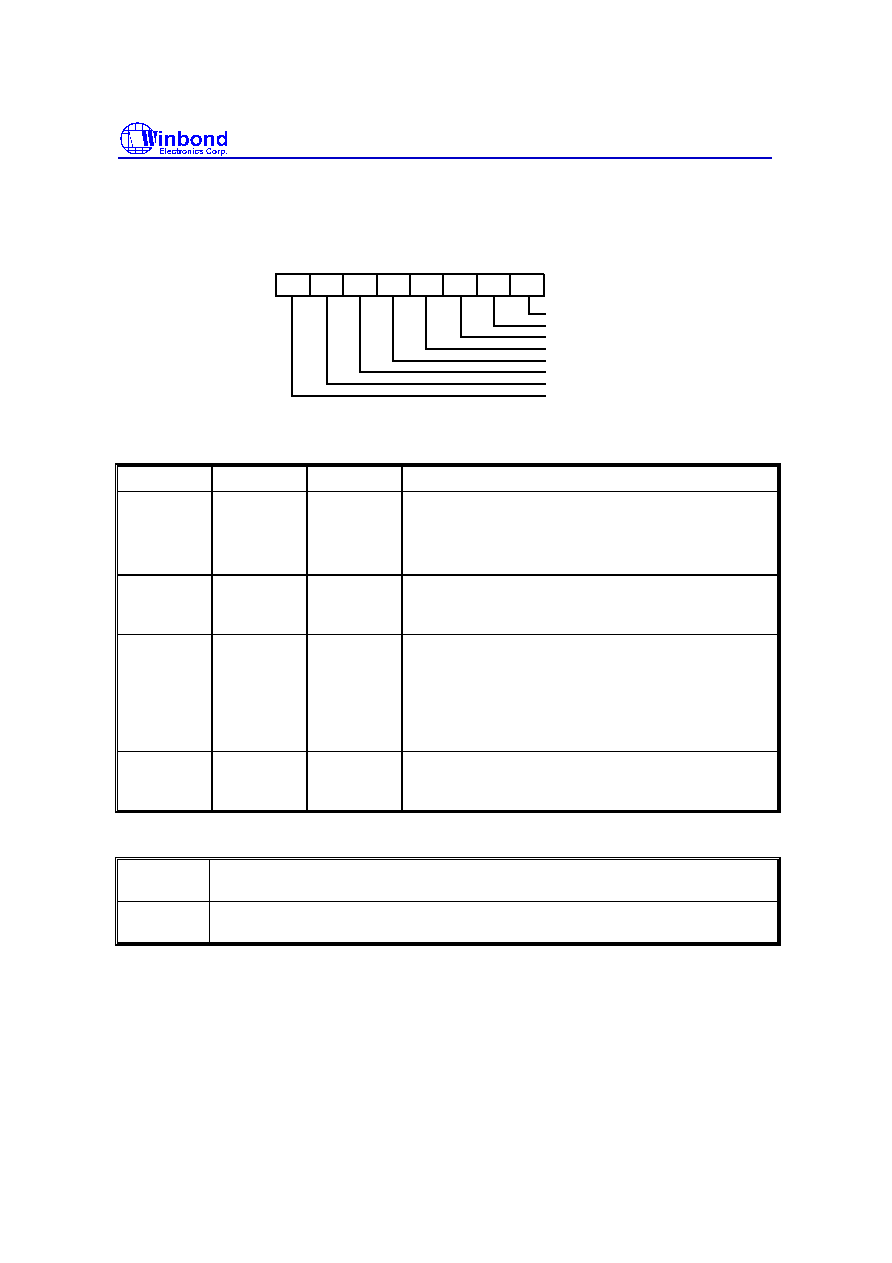
W83877ATF
Publication Release Date: April 1998
- 119 - Version 0.51
8.2.20 Configuration Register 14 (CR14), default = 00H
When the device is in Extended Function mode and EFIR is 14H, the CR14 register can be accessed
through EFDR. The bit definitions are as follows:
1
2
3
4
5
6
7
0
GDA0IPI
GDA0OPI
GCS0IOW
GCS0IOR
GIO0CSH
GIOP0MD0
GIOP0MD1
GIOP0MD2
GIOP0MD2-GIOP0MD0 (Bit 7-bit 5): GIOP0 pin mode selection
GIOP0MD2 GIOP0MD1 GIOP0MD0
GIOP0 pin
0
0
0
0
0
1
inactive (tri-state)
as a data output pin (SD0
GIOP0), when (AEN = L)
AND (NIOW = L) AND (SA10-0 = GIO0AD10-0), the
value of SD0 will be present on GIOP0
0
1
0
as a data input pin (GIOP0
SD0), when (AEN = L)
AND (NIOR = L) AND (SA10-0 = GIO0AD10-0), the
value of GIOP0 will be present on SD0
0
1
1
as a data input/output pin (GIOP0
SD0).
When (AEN = L) AND (NIOW = L) AND (SA10-0 =
GIO0AD10-0), the value of SD0 will be present on
GIOP0 When (AEN = L) AND (NIOR = L) AND (SA10-
0 = GIO0AD10-0), the value of GIOP0 will be present
on SD0
1
X
X
as a Chip Select pin, the pin will be active at (AEN =
L) AND (SA10-0 = GIO0AD10-0) OR (NIOR = L) OR
(NIOW = L)
GIO0CSH(Bit 4):
0
the Chip Select pin will be active LOW when (AEN = L) AND (SA10-0 = GIO0AD10-
0) OR (NIOR = L) OR (NIOW = L)
1
the Chip Select pin will be active HIGH when (AEN = L) AND (SA10-0 = GIO0AD10-
0) OR (NIOR = L) OR (NIOW = L)
GCS0IOR (Bit 3): See below.

W83877ATF
Publication Release Date: April 1998
- 120 - Version 0.51
GCS0IOW (Bit 2): See below.
GCS0IOR GCS0IOW
0
0
GIOP0 functions as a Chip Select pin, and will be active when
(AEN = L) AND (SA10-0 = GIO0AD10-0)
0
1
GIOP0 functions as a Chip Select pin, and will be active when
(AEN = L) AND (SA10-0 = GIO0AD10-0) AND (NIOW = L)
1
0
GIOP0 functions as a Chip Select pin, and will be active when
(AEN = L) AND (SA10-0 = GIO0AD10-0) AND (NIOR = L)
1
1
GIOP0 functions as a Chip Select pin, and will be active when
(AEN = L) AND (SA10-0 = GIO0AD10-0) AND (NIOW = L OR
NIOR = L)
GDA0OPI (Bit 1): See below.
GDA0IPI (Bit 0): See below.
GDA0OPI
GDA0IPI
0
0
GIOP0 functions as a data pin, and GIOP0
SD0, SD0
GIOP0
0
1
GIOP0 functions as a data pin, and inverse GIOP0
SD0,
SD0
GIOP0
1
0
GIOP0 functions as a data pin, and GIOP0
SD0, inverse
SD0
GIOP0
1
1
GIOP0 functions as a data pin, and inverse GIOP0
SD0, inverse
SD0
GIOP0
8.2.21 Configuration Register 15 (CR15), default = 00H
When the device is in Extended Function mode and EFIR is 15H, the CR15 register can be accessed
through EFDR. The bit definitions are as follows:
1
2
3
4
5
6
7
0
GDA0IPI
GDA0OPI
GCS0IOW
GCS0IOR
GIO0CSH
GIOP0MD0
GIOP0MD1
GIOP0MD2

W83877ATF
Publication Release Date: April 1998
- 121 - Version 0.51
GIOP1MD2-GIOP1MD0 (Bit 7-bit 5): GIOP1 pin mode selection
GIOP1MD2 GIOP1MD1 GIOP1MD0
GIOP1 pin
0
0
0
inactive (tri-state)
0
0
1
as a data output pin (SD1
GIOP1), when (AEN = L)
AND (NIOW = L) AND (SA10-0 = GIO1AD10-0), the
value of SD1 will be present on GIOP1
0
1
0
as a data input pin (GIOP1
SD1), when (AEN = L)
AND (NIOR = L) AND (SA10-0 = GIO1AD10-0), the
value of GIOP1 will be present on SD1
0
1
1
as a data input/output pin (GIOP1
SD1).
When (AEN = L) AND (NIOW = L) AND (SA10-0 =
GIO1AD10-0), the value of SD1 will be present on
GIOP1 When (AEN = L) AND (NIOR = L) AND (SA10-
0 = GIO1AD10-0), the value of GIOP1 will be present
on SD1
1
X
X
as a Chip Select pin, the pin will be active at (AEN =
L) AND (SA10-0 = GIO1AD10-0) OR (NIOR = L) OR
(NIOW = L)
GIO1CSH (Bit 4):
0
the Chip Select pin will active LOW when (AEN = L) AND (SA10-0 = GIOAD10-0)
OR (NIOR = L) OR (NIOW = L)
1
the Chip Select pin will active HIGH when (AEN = L) AND (SA10-0 = GIOAD10-0)
OR (NIOR = L) OR (NIOW = L)
GCS1IOR (Bit 3): See below.
GCS1IOW (Bit 2): See below.
GCS1IOR
GCS1IOW
0
0
GIOP1 functions as a Chip Select pin, and will be active when
(AEN = L) AND (SA10-0 = GIO1AD10-0)
0
1
GIOP1 functions as a Chip Select pin, and will be active when
(AEN = L) AND (SA10-0 = GIO1AD10-0) AND (NIOW = L)
1
0
GIOP1 functions as a Chip Select pin, and will be active when
(AEN = L) AND (SA10-0 = GIO1AD10-0) AND (NIOR = L)
1
1
GIOP1 functions as a Chip Select pin, and will be active when
(AEN = L) AND (SA10-0 = GIO1AD10-0) AND (NIOW = L OR
NIOR = L)
GDA0OPI (Bit 1): See below.
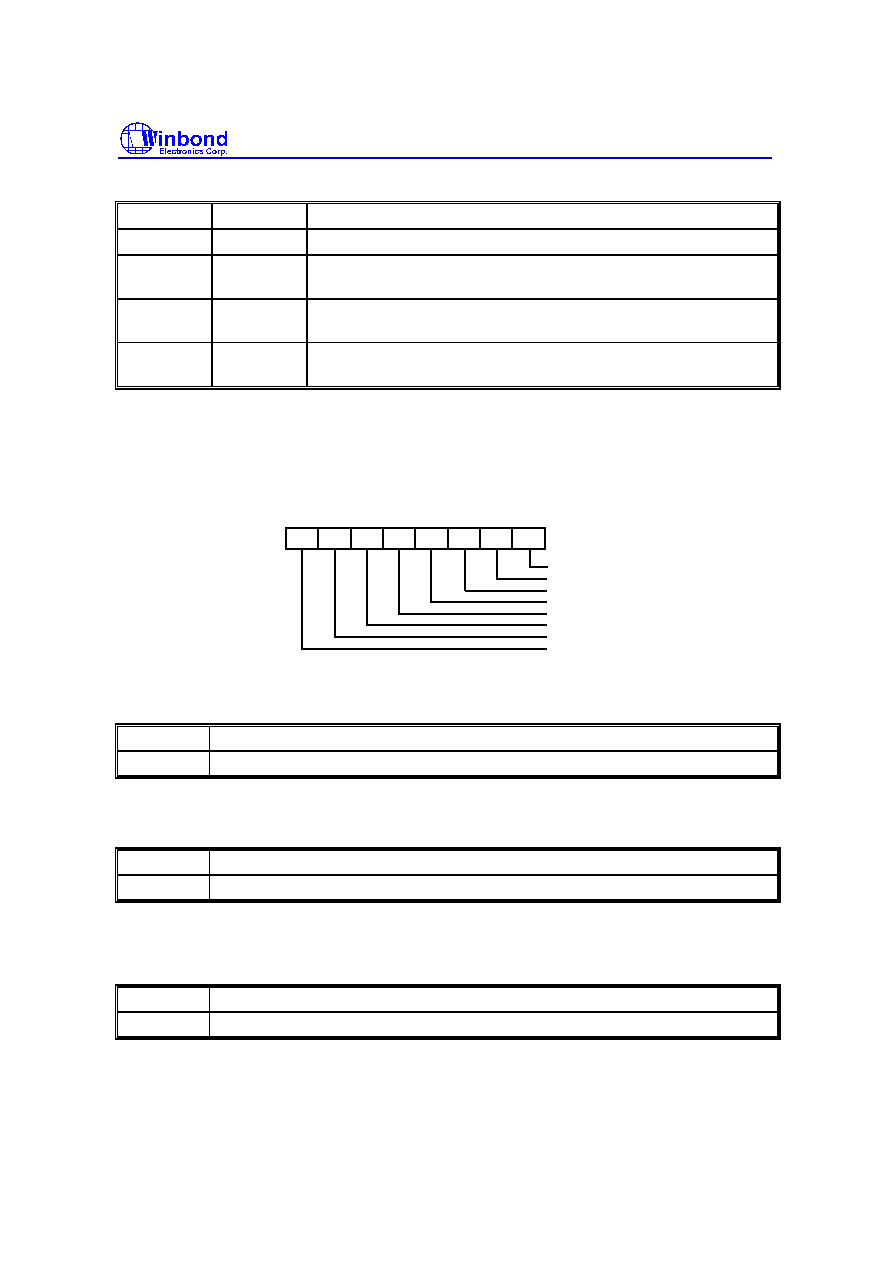
W83877ATF
Publication Release Date: April 1998
- 122 - Version 0.51
GDA1IPI (Bit 0): See below.
GDA1OPI
GDA1IPI
0
0
GIOP1 functions as a data pin, and GIOP1
SD1, SD1
GIOP1
0
1
GIOP1 functions as a data pin, and inverse GIOP1
SD1,
SD1
GIOP1
1
0
GIOP1 functions as a data pin, and GIOP1
SD1, inverse
SD1
GIOP1
1
1
GIOP1 functions as a data pin, and inverse GIOP1
SD1, inverse
SD1
GIOP1
8.2.22 Configuration Register 16 (CR16),
default = 04H
When the device is in Extended Function mode and EFIR is 16H, the CR16 register can be accessed
through EFDR. The bit definitions are as follows:
1
2
3
4
5
6
7
0
HEFRAS
reserved
PNPCVS
reserved
G0IQSEL
G1IQSEL
reserved
reserved
Bit 7-bit 6: Reserved.
G1IQSEL (Bit 5):
0
pin 96 function as IRQ_A.
1
pin 96 function as GIO1.
The corresponding power-on setting pin is NRTSB (pin 45).
G0IQSEL (Bit 4):
0
pins 92 function as IRQ_B.
1
pins 92 function as GIO0.
The corresponding power-on setting pin is NRTSB (pin 45).
Bit 3: Reserved.
PNPCVS (bit 2):
0
PnP-related registers (CR20, CR23-29) reset to be all 0s.
1
default settings for these registers.
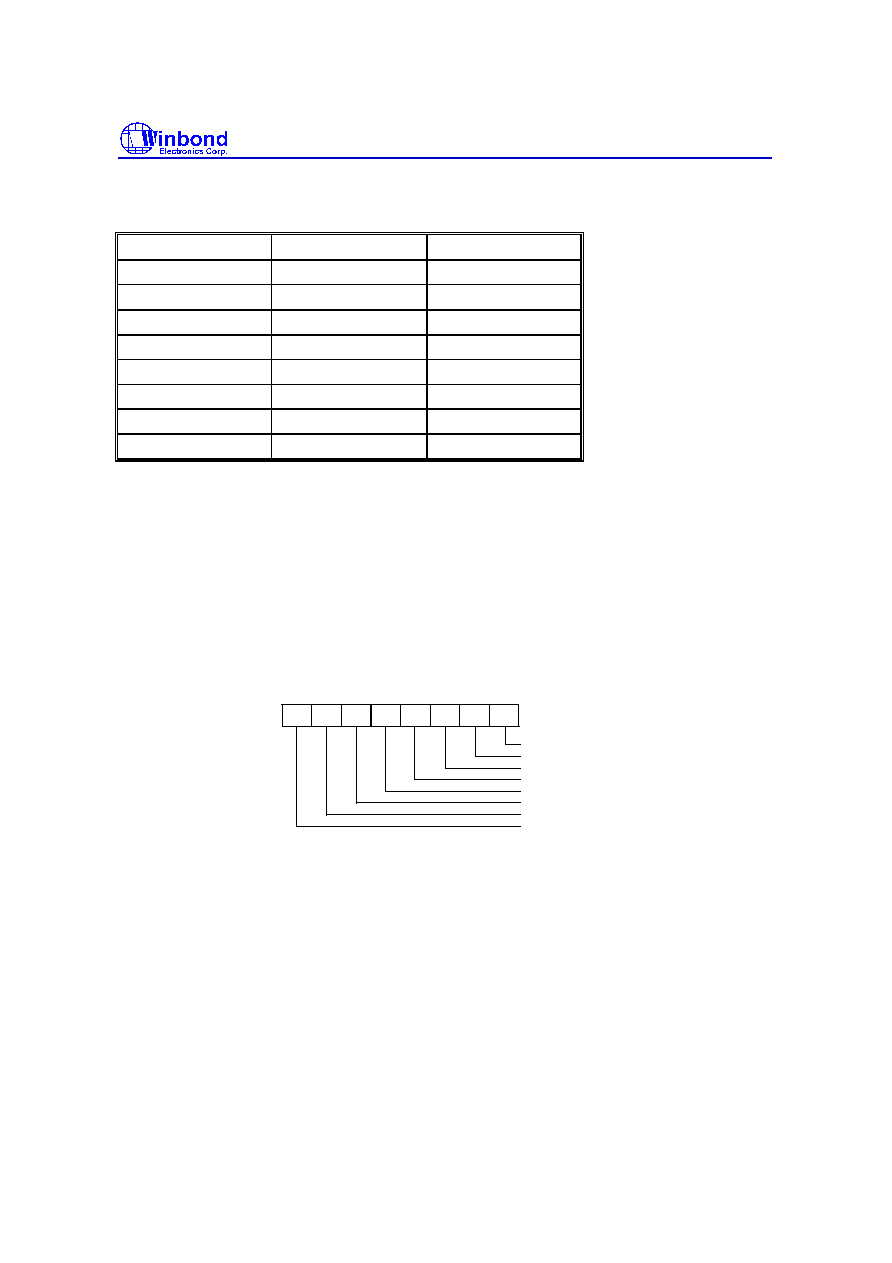
W83877ATF
Publication Release Date: April 1998
- 123 - Version 0.51
The corresponding power-on setting pin is NRTSA (pin 36).
PnP register
PNPCVS = 1
PNPCVS = 0
CR20
FCH
00H
CR23
DEH
00H
CR24
FEH
00H
CR25
BEH
00H
CR26
23H
00H
CR27
05H
00H
CR28
43H
00H
CR29
60H
00H
Note: The new value of PNPCVS must be complementary to the old one to make an effective change. For example, the user must
set PNPCVS to 1 first and then reset it to 0 to reset these PnP registers if the present value of PNPCVS is 0.
Bit 1: Reserved.
HEFRAS (Bit 0): combines with HEFERE (bit 5 of CR0C) to define how to access Extended Function
Registers (refer to bit 5 of CR0C description). The corresponding power-on setting
pin is NDTRA (pin 35).
8.2.23 Configuration Register 17 (CR17), default = 00H
When the device is in Extended Function mode and EFIR is 17H, the CR17 register can be accessed
through EFDR. The bit definitions are as follows:
1
2
3
4
5
6
7
0
DSUBLGRQ
DSUALGRQ
DSPRLGRQ
DSFDLGRQ
PRIRQOD
reserved
reserved
reserved
Bit 7-bit 5: Reserved.
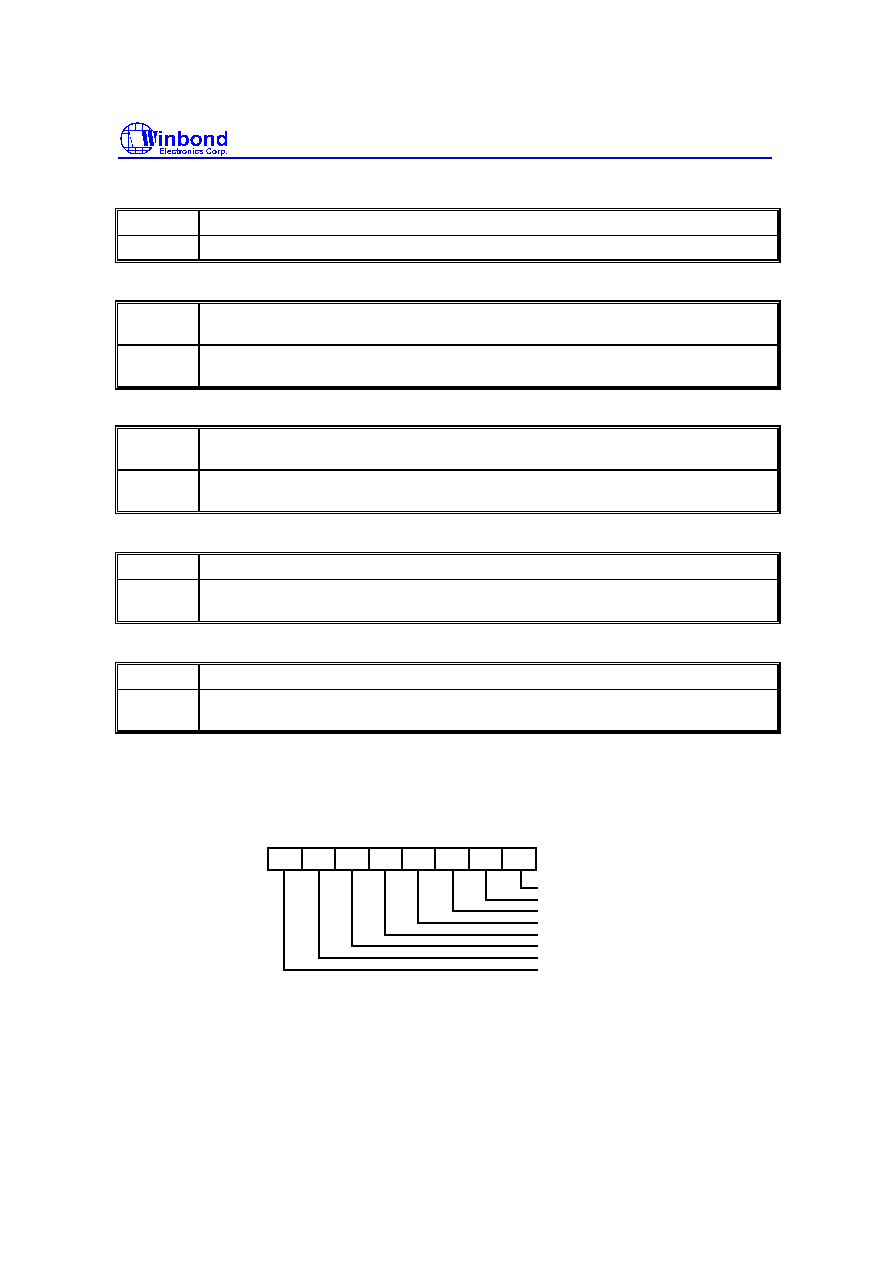
W83877ATF
Publication Release Date: April 1998
- 124 - Version 0.51
PRIRQOD (Bit 4):
0
printer IRQ ports are totem-poles in SPP mode and open-drains in ECP/EPP mode.
1
printer IRQ ports are totem-poles in all modes.
DSFDLGRQ (Bit 3):
0
enable FDC legacy mode on IRQ and DRQ selections. DO register bit 3 has effect on
selecting IRQ.
1
disable FDC legacy mode on IRQ and DRQ selections. DO register bit 3 has no effect
on selecting IRQ.
DSPRLGRQ (Bit 2):
0
enable PRT legacy mode on IRQ and DRQ selections. DCR bit 4 has effect on
selecting IRQ.
1
disable PRT legacy mode on IRQ and DRQ selections. DCR bit 4 has no effect on
selecting IRQ.
DSUALGRQ (Bit 1):
0
enable UART A legacy mode on IRQ selection. MCR bit 3 has effect on selecting IRQ.
1
disable UART A legacy mode on IRQ selection. MCR bit 3 has no effect on selecting
IRQ.
DSUBLGRQ (Bit 0):
0
enable UART B legacy mode on IRQ selection. MCR bit 3 has effect on selecting IRQ.
1
disable UART B legacy mode on IRQ selection. MCR bit 3 has no effect on selecting
IRQ.
8.2.24 Configuration Register 18 (CR18), default=00H
When the device is in Extended Function mode and EFIR is 18H, the CR18 register can be accessed
through EFDR. The bit definitions are as follows:
1
2
3
4
5
6
7
0
SHARA
SHARB
SHARC
SHARD
SHARE
SHARF
SHARG
SHARH
This register is used to select whether these interrupt request pins are in the IRQ sharing mode. While
in the IRQ sharing mode, the corresponding pin is low active for 200ns for the interrupt request and
keeps tri-stated otherwise.

W83877ATF
Publication Release Date: April 1998
- 125 - Version 0.51
SHARH (Bit 7):
0
pin IRQ_H in the legacy ISA IRQ mode.
1
pin IRQ_H in the IRQ sharing mode.
SHARG (Bit 6):
0
pin IRQ_G in the legacy ISA IRQ mode.
1
pin IRQ_G in the IRQ sharing mode.
SHARF (Bit 5):
0
pin IRQ_F in the legacy ISA IRQ mode.
1
pin IRQ_F in the IRQ sharing mode.
SHARE (Bit 4):
0
pin IRQ_E in the legacy ISA interrupt mode.
1
pin IRQ_E in the IRQ sharing mode.
SHARD (Bit 3):
0
pin IRQ_D in the legacy ISA IRQ mode.
1
pin IRQ_D in the IRQ sharing mode.
SHARC (Bit 2):
0
pin IRQ_C in the legacy ISA IRQ mode.
1
pin IRQ_C in the IRQ sharing mode.
SHARB(Bit 1):
0
pin IRQ_B in the legacy ISA IRQ mode.
1
pin IRQ_B in the IRQ sharing mode.
SHARA (Bit 0):
0
pin IRQ_A in the legacy ISA IRQ mode.
1
pin IRQ_A in the IRQ sharing mode.
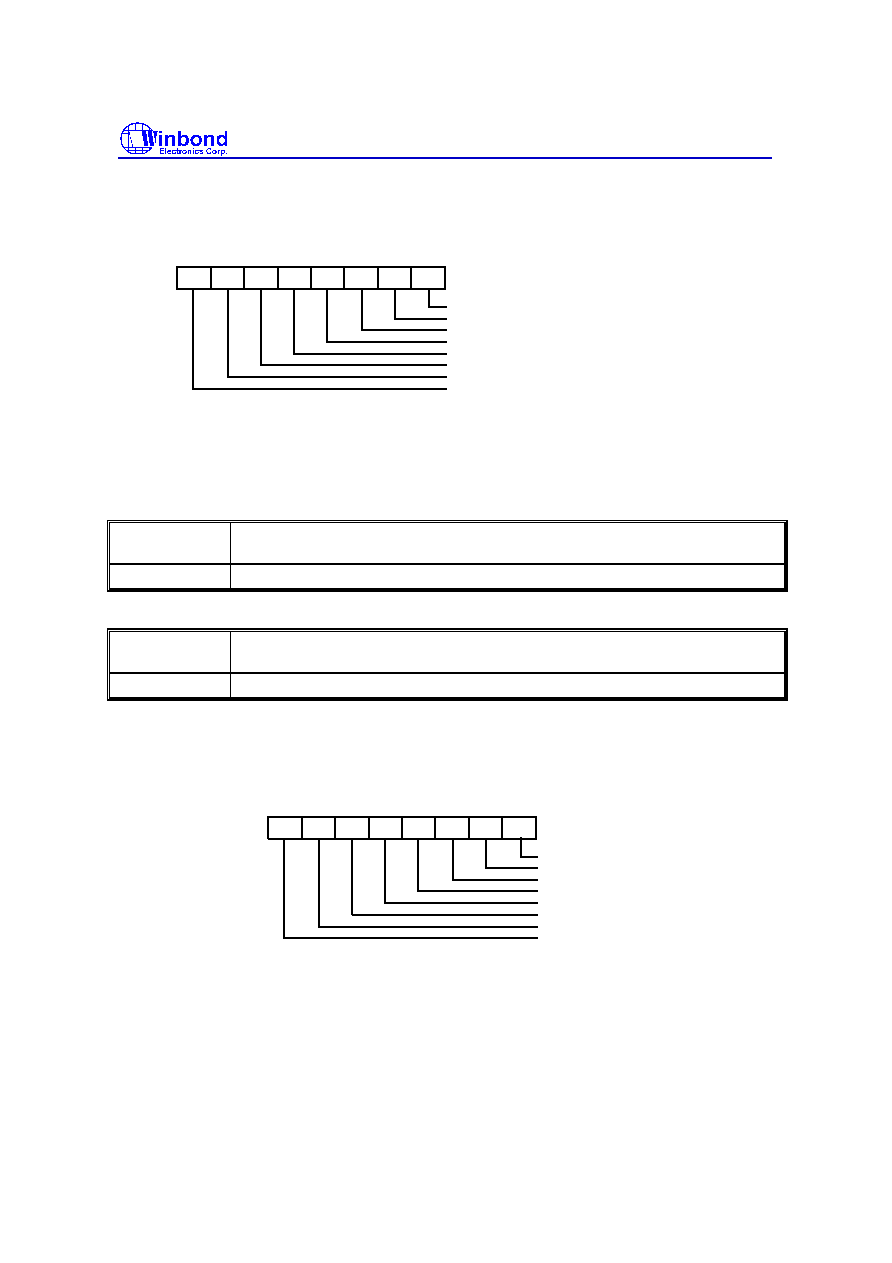
W83877ATF
Publication Release Date: April 1998
- 126 - Version 0.51
8.2.25 Configuration Register 19 (CR19), default=00H
When the device is in Extended Function mode and EFIR is 19H, the CR19 register can be accessed
through EFDR. The bit definitions are as follows:
1
2
3
4
5
6
7
0
FASTB
FASTA
reserved
reserved
reserved
reserved
reserved
reserved
This register is used for the high speed modem application. While the bit is set to logic 1, it can
increase the baudrate of UART to 921.2KBPS (the clock source of UART is 14.769MHz) for high
speed transmit/receive.
Bit 7 - bit 2: Reserved.
FASTA (Bit 1):
0
the clock source of UART A is the same as the frequency of TURA (CR0C bit 7)
and SUAMIDI (CR3 bit 1) selected.
1
the clock source of UART A is 14.769MHZ.
FASTB (Bit 0):
0
the clock source of UART B is the same as the frequency of TURB (CR0C bit 6)
and SUBMIDI (CR3 bit 0) selected.
1
the clock source of UART B is 14.769MHZ.
8.2.26 Configuration Register 20 (CR20)
When the device is in Extended Function mode and EFIR is 20H, the CR20 register can be accessed
through EFDR. Default = FCH if CR16 bit 2 = 1; default = 00H if CR16 bit 2 = 0. The bit definitions
are as follows:
1
2
3
4
5
6
7
0
reserved
reserved
FDCAD2
FDCAD3
FDCAD4
FDCAD5
FDCAD6
FDCAD7
This register is used to select the base address of the Floppy Disk Controller (FDC) from 100H-3F0H
on 16-byte boundaries. NCS = 0 and A10 = 0 are required to access the FDC registers. A[3:0] are
always decoded as 0xxxb.
FDCAD7-FDCAD2 (Bit 7-bit 2): match A[9:4]. Bit 7 = 0 and bit 6 = 0 disable this decode.
Bit 1-bit 0: Reserved, fixed at zero.
8.2.27 Configuration Register 23 (CR23)
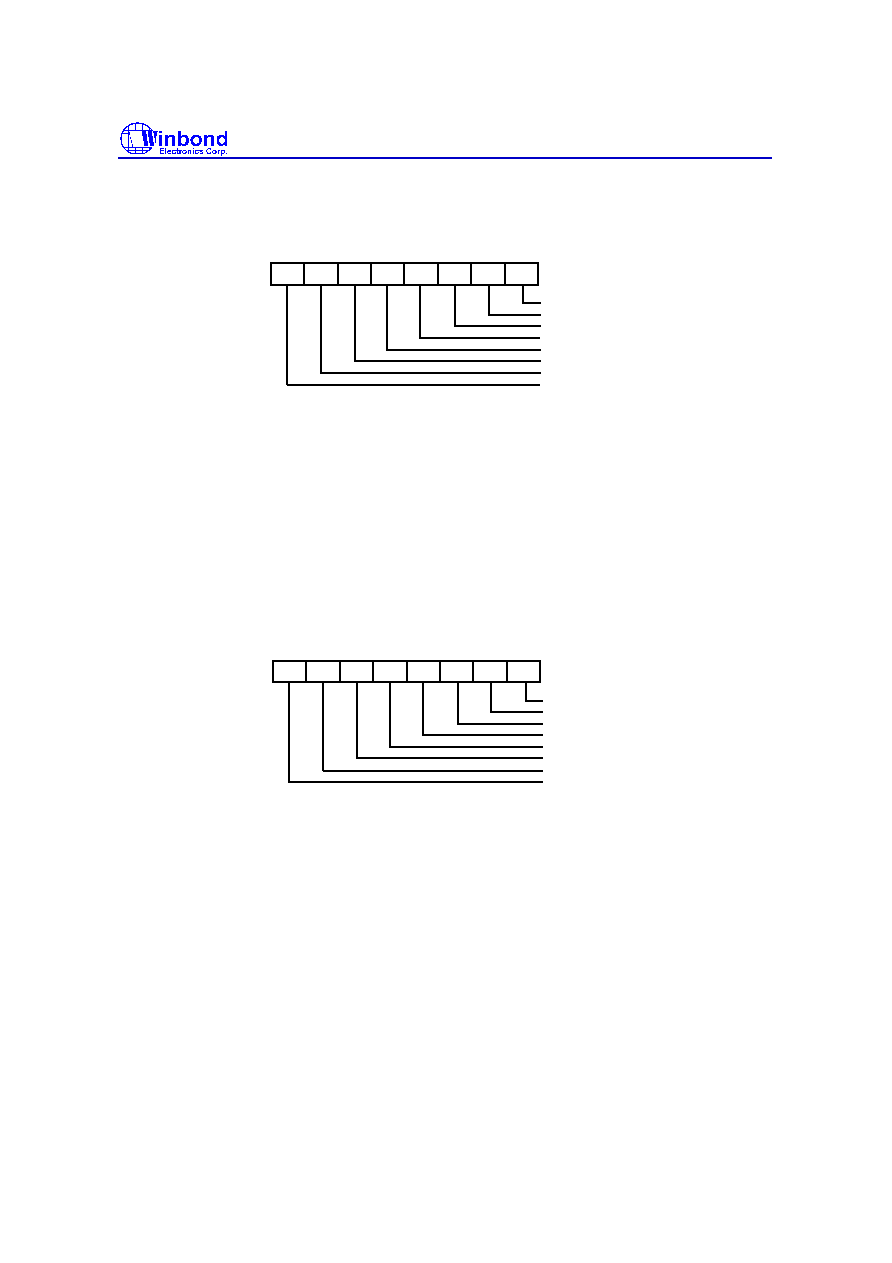
W83877ATF
Publication Release Date: April 1998
- 127 - Version 0.51
When the device is in Extended Function mode and EFIR is 23H, the CR23 register can be accessed
through EFDR. Default = DEH if CR16 bit 2 = 1; default = 00H if CR16 bit 2 = 0. The bit definitions
are as follows:
1
2
3
4
5
6
7
0
PRTAD0
PRTAD1
PRTAD2
PRTAD3
PRTAD4
PRTAD5
PRTAD6
PRTAD7
This register is used to select the base address of the parallel port. If EPP is disable, the parallel port
can be set from 100H-3FCH on 4-byte boundaries. If EPP is enable, the parallel port can be set from
100H-3F8H on 8-byte boundaries. NCS = 0 and A10 = 0 are required to access the parallel port when
in compatible, bi-directional, or EPP modes. A10 is active in ECP mode.
PRTAD7-PRTAD0 (Bit 7-bit 0): match A[9:2]. Bit 7 = 0 and bit 6 = 0 disable this decode.
8.2.28 Configuration Register 24 (CR24)
When the device is in Extended Function mode and EFIR is 24H, the CR24 register can be accessed
through EFDR. Default = FEH if CR16 bit 2 = 1; default = 00H if CR16 bit 2 = 0. The bit definitions
are as follows:
1
2
3
4
5
6
7
0
reserved
URAAD1
URAAD2
URAAD3
URAAD4
URAAD5
URAAD6
URAAD7
This register is used to select the base address of the UART A from 100H-3F8H on 8-byte
boundaries. NCS = 0 and A10 = 0 are required to access the UART A registers. A[2:0] are don't-care
conditions.
URAAD7-URAAD1 (Bit 7-bit 1): match A[9:3]. Bit 7 = 0 and bit 6 = 0 disable this decode.
Bit 0: Reserved, fixed at zero.
8.2.29 Configuration Register 25 (CR25)
When the device is in Extended Function mode and EFIR is 25H, the CR25 register can be accessed
through EFDR. Default = BEH if CR16 bit 2 = 1; default = 00H if CR16 bit 2 = 0. The bit definitions
are as follows:
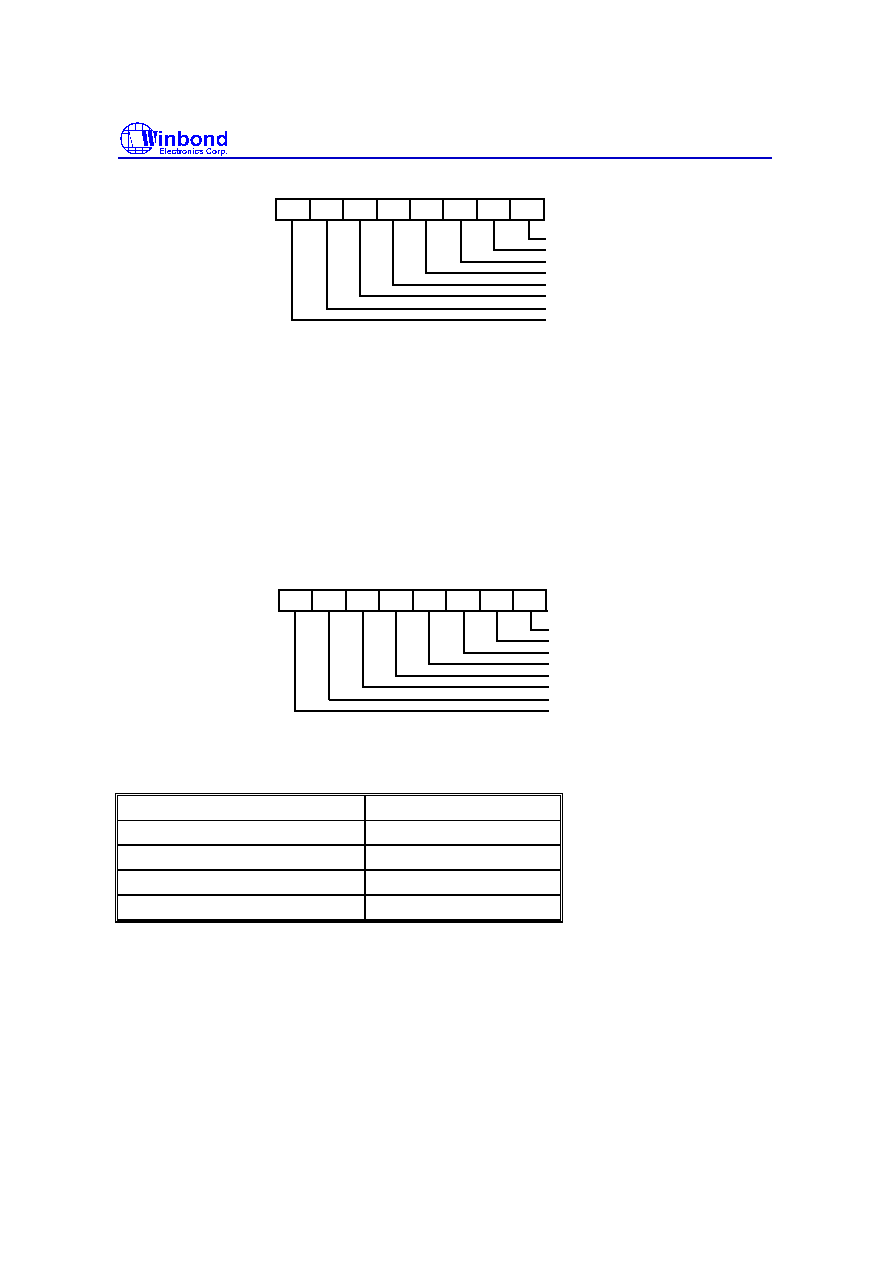
W83877ATF
Publication Release Date: April 1998
- 128 - Version 0.51
1
2
3
4
5
6
7
0
reserved
URBAD1
URBAD2
URBAD3
URBAD4
URBAD5
URBAD6
URBAD7
This register is used to select the base address of the UART B from 100H-3F8H on 8-byte
boundaries. NCS = 0 and A10 = 0 are required to access the UART B registers. A[2:0] are don't-care
conditions.
URBAD7-URBAD1 (Bit 7-bit 1): match A[9:3]. Bit 7 = 0 and bit 6 = 0 disable this decode.
Bit 0: Reserved, fixed at zero.
8.2.30 Configuration Register 26 (CR26)
When the device is in Extended Function mode and EFIR is 26H, the CR26 register can be accessed
through EFDR. Default = 23H if CR16 bit 2 = 1; default = 00H if CR16 bit 2 = 0. The bit definitions are
as follows:
1
2
3
4
5
6
7
0
PRTDQS0
PRTDQS1
PRTDQS2
PRTDQS3
FDCDQS0
FDCDQS1
FDCDQS2
FDCDQS3
FDCDQS3-FDCDQS0 (Bit 7-bit 4): Allocate DMA resource for FDC.
PRTDQS3-PRTDQS0 (Bit 3-bit 0): Allocate DMA resource for PRT.
Bit 7- bit4, Bit 3 - bit 0
DMA selected
0000
None
0001
DMA_A
0010
DMA_B
0011
DMA_C

W83877ATF
Publication Release Date: April 1998
- 129 - Version 0.51
8.2.31 Configuration Register 27 (CR27)
When the device is in Extended Function mode and EFIR is 27, the CR27 register can be accessed
through EFDR. Default = 05H if CR6 bit 2 = 1; default = 00H if CR16 bit 2 = 0. The bit definitions are
as follows:
1
2
3
4
5
6
7
0
PRTIQS0
PRTIQS1
PRTIQS2
PRTIQS3
reserved
ECPIRQx0
ECPIRQx1
ECPIRQx2
ECPIRQx2-ECPIRQx0 (Bit7-bit 5): These bits are configurable equivalents to bit[5:3] of cnfgB
register in ECP mode
,
except that cnfgB[5:3] are read-only bits. They indicate the IRQ resource
assigned for the ECP printer port. It is the software designer's responsibility to ensure that CR27[7:5]
and CR27[3:0] are consistent. For example, CR27[7:5] should be filled with 001 (select IRQ 7) if
CR27[3:0] are to be programmed as 0101 (select IRQ_E) while IRQ_E is connected to IRQ 7.
CR27[7:5]
IRQ resource
000
reflect other IRQ resources selected by CR27[3:0] (default)
001
IRQ 7
010
IRQ 9
011
IRQ 10
100
IRQ 11
101
IRQ 14
110
IRQ 15
111
IRQ 5
Bit 4: Reserved.
PRTIQS3-PRTIQS0 (Bit 3-bit 0): Select IRQ resource for the parallel port. Any unselected IRQ pin is
in tri-state.
CR27[3:0]
select IRQ pin
0000
None
0001
IRQ_A
0010
IRQ_B
0011
IRQ_C
0100
IRQ_D
0101
IRQ_E
0110
IRQ_F
0111
IRQ_G
1000
IRQ_H

W83877ATF
Publication Release Date: April 1998
- 130 - Version 0.51
While in the Serial IRQ mode (IRQMODS=1, CR31 bit2), the above selection is invalid and all the
IRQ signal pins, from IRQ_A to IRQ_H, are in tri-state. The parallel port IRQ is dedicated to the
SERIRQ pin. For the host controller to correctly sample the parallel port IRQ, the parallel port IRQ
should be programmed to appear in one of IRQ/Data Frame sampling periods.
In Serial IRQ mode, the definition of PRTIQS3-PRTIQS0 (bit 3-bit 0) is as follows:
PRTIQS3-PRTIQS0 (Bit 3-bit 0): Select the IRQ/Data Frame sampling period on the SERIRQ pin.
CR27[3:0]
IRQ/Data Frame Period
0000
None
0001
IRQ1
0010
Reserved for
SMI
0011
IRQ3
0100
IRQ4
0101
IRQ5
0110
IRQ6
0111
IRQ7
1000
IRQ8
1001
IRQ9
1010
IRQ10
1011
IRQ11
1100
IRQ12
1101
IRQ13
1110
IRQ14
1111
IRQ15
8.2.32 Configuration Register 28 (CR28)
When the device is in Extended Function mode and EFIR is 28, the CR28 register can be accessed
through EFDR. Default = 43H if CR6 bit 2 = 1; default = 00H if CR16 bit 2 = 0. The bit definitions are
as follows:
1
2
3
4
5
6
7
0
URBIQS0
URBIQS1
URBIQS2
URBIQS3
URAIQS0
URAIQS1
URAIQS2
URAIQS3
URAIQS3-URAIQS0 (Bit 7-bit 4): Allocate interrupt resource for UART A.
URBIQS3-URBIQS0 (Bit 3-bit 0): Allocate interrupt resource for UART B.
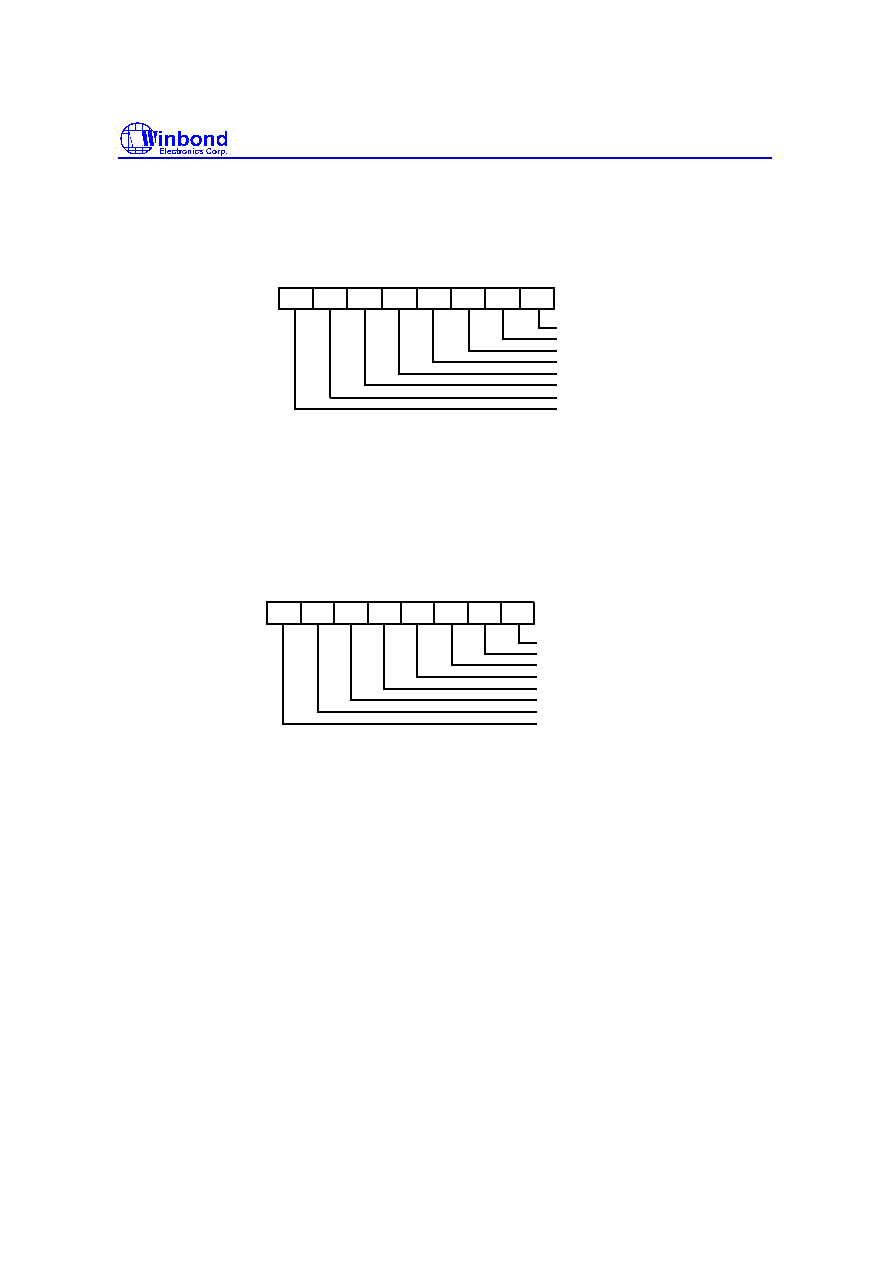
W83877ATF
Publication Release Date: April 1998
- 131 - Version 0.51
8.2.33 Configuration Register 29 (CR29)
When the device is in Extended Function mode and EFIR is 29, the CR29 register can be accessed
through EFDR. Default = 62H if CR6 bit 2 = 1; default = 00H if CR16 bit 2 = 0. The bit definitions are
as follows:
1
2
3
4
5
6
7
0
IQNIQS0
IQNIQS1
IQNIQS2
IQNIQS3
FDCIQS0
FDCIQS1
FDCIQS2
FDCIQS3
FDCIQS3-FDCIQS0 (Bit 7-bit 4): Allocate interrupt resource for FDC.
IQNIQS3-IQNIQS0 (Bit 3-bit 0): Allocate interrupt resource for IRQIN.
8.2.34 Configuration Registers (CR2A)
When the device is in Extended Function mode and EFIR is 2AH, the CR2A register can be accessed
through EFDR. This register default value is 00
16
. The bit definitions are as follows:
1
2
3
4
5
6
7
0
IRRXDRQSL0
IRRXDRQSL1
IRRXDRQSL2
IRRXDRQSL3
IRTXDRQSL0
IRTXDRQSL1
IRTXDRQSL2
IRTXDRQSL3
IRTXDRQSL (bit 7-bit 4): Transmitter DMA channel A through D selection when high speed infrared
(FIR/MIR) is used and enable DMA channel. Note that these bits is used in two DMA channels.
IRRXDRQSL(bit 3-bit 0): Receiver or Transmitter DMA channel A through selection when high speed
infrared (FIR/MIR) is used and enable DMA channel. Note that these bits act as RX DMA channel
selection if two DMA channel is used, or act as RX/TX DMA channel selection if single DMA channel
is used.
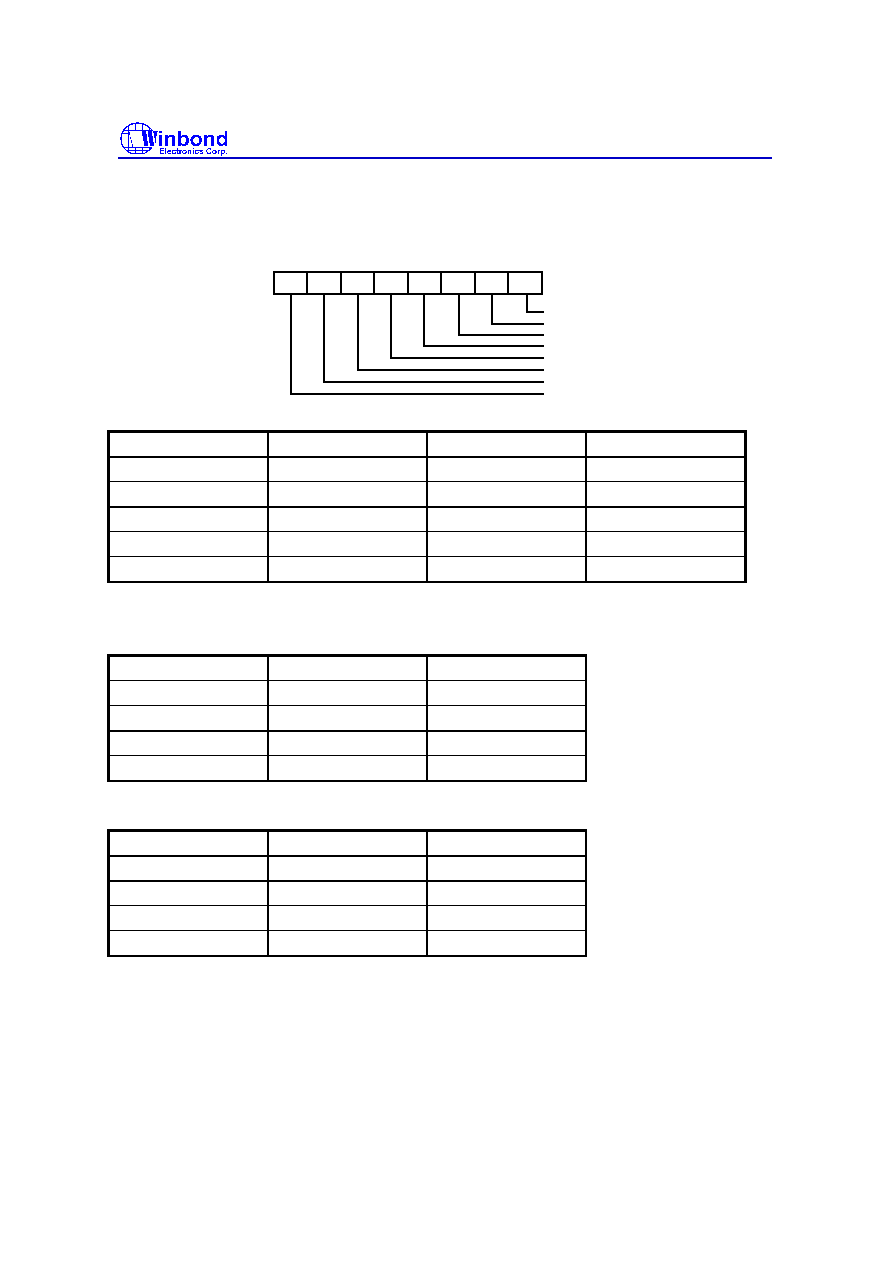
W83877ATF
Publication Release Date: April 1998
- 132 - Version 0.51
8.2.35 Configuration Registers (CR2B)
When the device is in Extended Function mode and EFIR is 2BH, the CR2B register can be accessed
through EFDR. This register default value is 00
16
. The bit definitions are as follows:
1
2
3
4
5
6
7
0
PIN93FUN0
PIN93FUN1
PIN3FUN0
PIN3FUN1
PIN2FUN0
PIN2FUN1
PIN1FUN0
PIN1FUN1
Bit 7~6: PIN1FUN1~0 - Pin 1 function select.
IRQMODS
*
PIN1FUN1
PIN1FUN0
Pin 1
0
0
0
IRQ_G
0
0
1
Reserved
0
1
0
DRQ_D
0
1
1
IRSL2
1
X
X
PCICLK
* Note that: IRQMODS is defined in CR31.Bit2, that is, the IRQ mode selection bit.
Bit 5-4: PIN2FUN1~0 - Pin 2 function select.
PIN2FUN1
PIN2FUN0
Pin 2
0
0
nCS
0
1
A11
1
0
Reserved
1
1
Reserved
Bit 3-2: PIN3FUN1~0 - Pin 3 function select.
PIN3FUN1
PIN3FUN0
Pin 3
0
0
PDCIN
0
1
nDACK_D
1
0
IRSL1
1
1
IRRXH/IRSL0
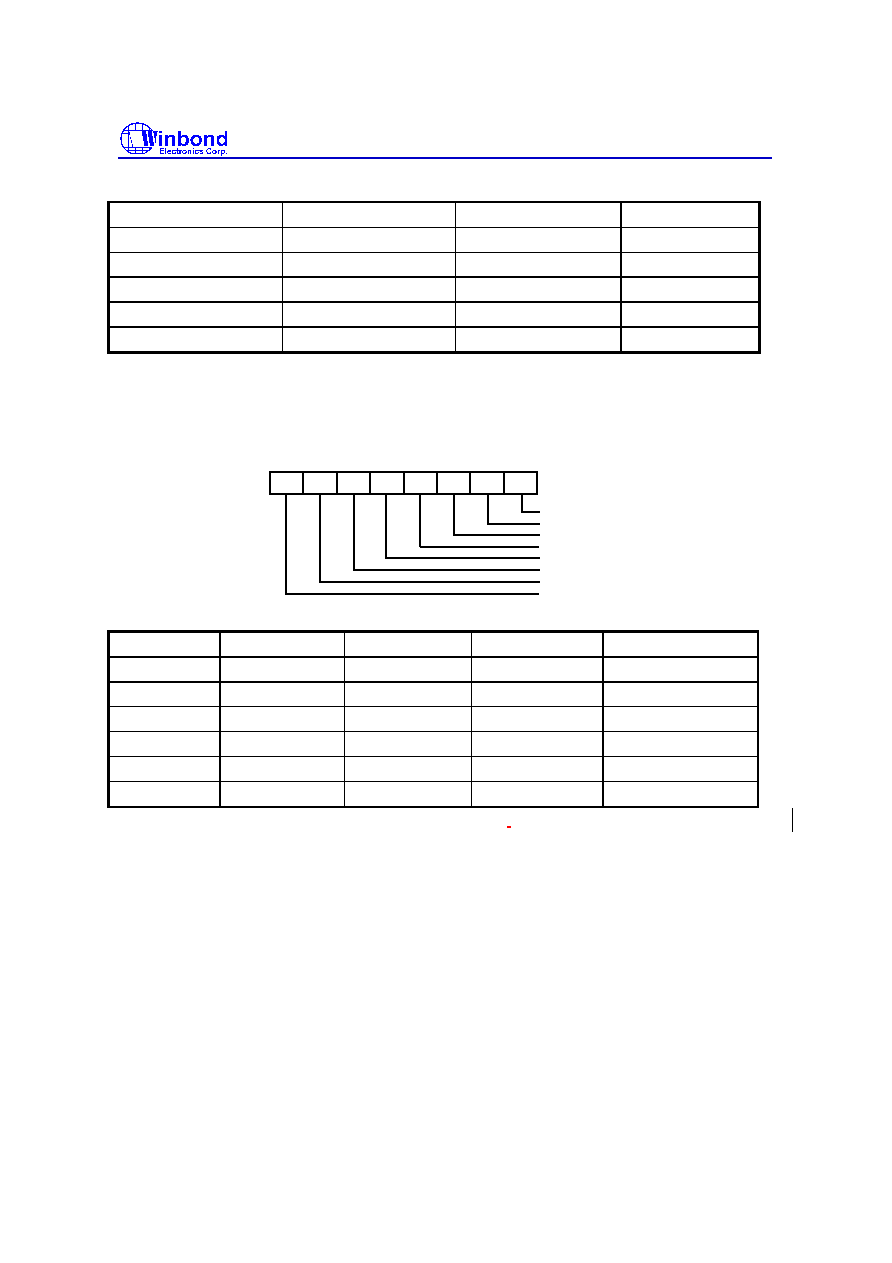
W83877ATF
Publication Release Date: April 1998
- 133 - Version 0.51
Bit 1-0: PIN93FUN1~0 - Pin 93 function select.
ENPNF(CR16.Bit7)
PIN93FUN1
PIN93FUN0
Pin 93
0
0
0
IRQIN
0
0
1
DRQ_D
0
1
0
IRSL2
0
1
1
IRRXH/IRSL0
1
X
X
PNF
8.2.36 Configuration Registers (CR2C)
When the device is in Extended Function mode and EFIR is 2CH, the CR2C register can be accessed
through EFDR. This register default value is 10
16
. The bit definitions are as follows:
1
2
3
4
5
6
7
0
Reserved
Reserved
CLKINSEL
ENBNKSEL
APEDCRC
PIN91FUN0
PIN91FUN1
PIN91FUN2
Bit 7-2 : PIN91FUN2~0 - Pin 91 function select.
IRQMODS
*
PIN91FUN2
PIN91FUN1
PIN91FUN0
Pin 91
0
0
0
0
IRQ_H
0
0
0
1
Reserved
0
0
1
0
IRSL2
0
0
1
1
Reserved
0
1
0
0
DACK_D
1
X
X
X
SERIRQ
* Note that the bit IRQMODS is defined in CR31.Bit2, that is
,
a IRQ mode selection.
Note: The IRSL0/IRRXH selection is determined by Bit 5(IRSL0 Mode selection) of Register7 of
Bank7. When setting Bit 5 to logical 1, IRSL0 is selected; When setting Bit 5 to logical 0, IRRXH is
selected.
Bit 4 :APEDCRC - Append CRC to receiver when a frame is end.
= 0 No append hardware CRC value as data in FIR/MIR mode
= 1 Append hardware CRC value as data in FIR/MIR mode
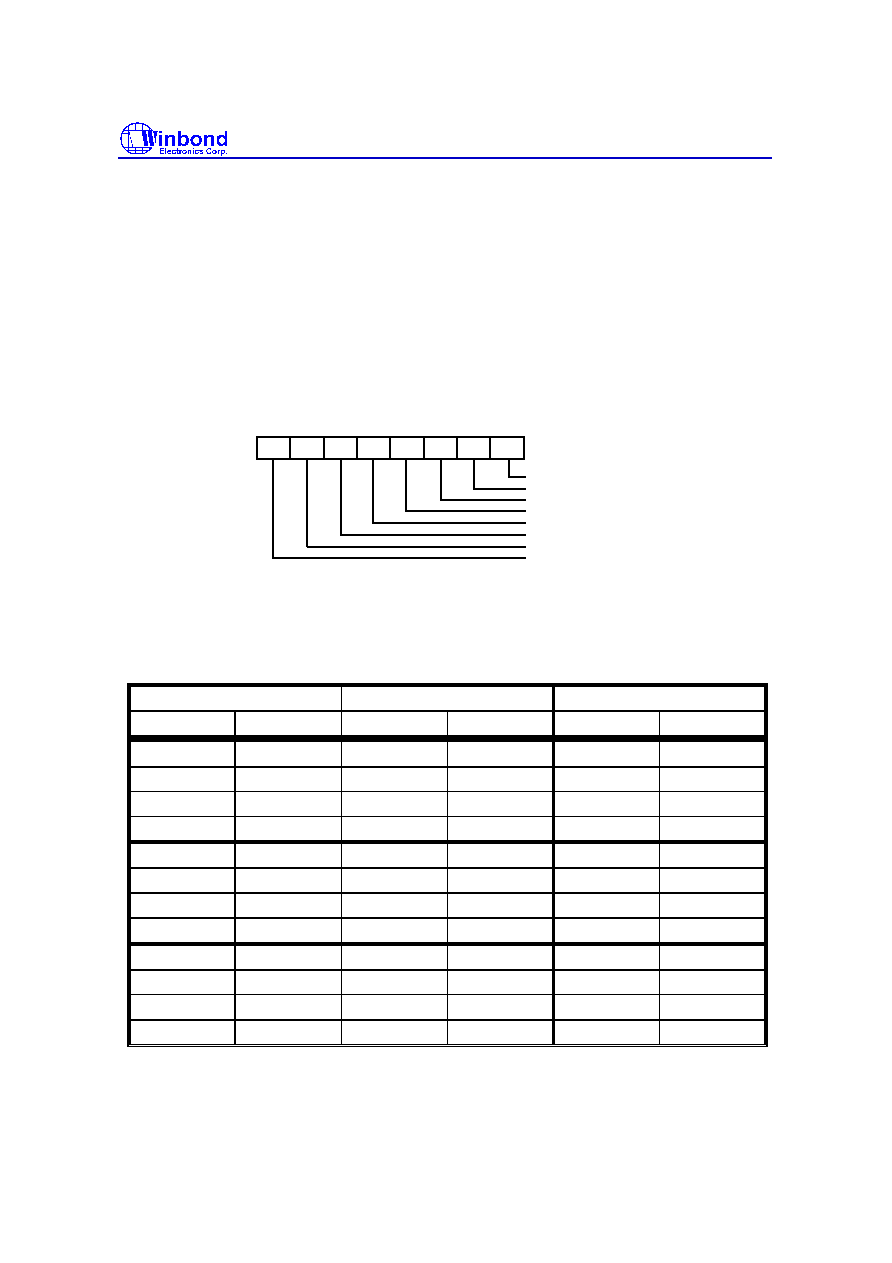
W83877ATF
Publication Release Date: April 1998
- 134 - Version 0.51
Bit 3 :ENBNKSEL - Bank select enable
= 0 Disable UART B bank selection
= 1 Enable UART B bank selection
Bit 2 :CLKINSEL - Clock input selection
= 0 The clock on pin CLKIN is 24 MHz
= 1 The clock on pin CLKIN is 48MHz
Bit 1, Bit 0: Reserved
8.2.37 Configuration Registers (CR2D)
When the device is in Extended Function mode and EFIR is 2D
16
, the CR2D register can be
accessed through EFDR. This register default value is 00
16
. The bit definitions are as follows:
1
2
3
4
5
6
7
0
DRTA0
DRTA1
DIS_PRECOMP0
DRTB0
DRTB1
DIS_PRECOMP1
Reserved
Reserved
This register controls the data rate selection for FDC. It also controls if precompensation is enabled.
DRTA1, DRTA0 (bit 1 - bit 0):
These two bits combining with data rate selection bits in Date Rate Register select the operational
data rate for FDD A as follows:
Drive Rate Table
Data Rate
operational data rate
DRTA1
DRTA0
DRATE1
DRATE0
MFM
FM
0
0
1
1
1M
---
0
0
0
0
500K
250K
0
0
0
1
300K
150K
0
0
1
0
250K
125K
0
1
1
1
1M
---
0
1
0
0
500K
250K
0
1
0
1
500K
250K
0
1
1
0
250K
125K
1
0
1
1
1M
---
1
0
0
0
500K
250K
1
0
0
1
2M
---
1
0
1
0
250K
125K
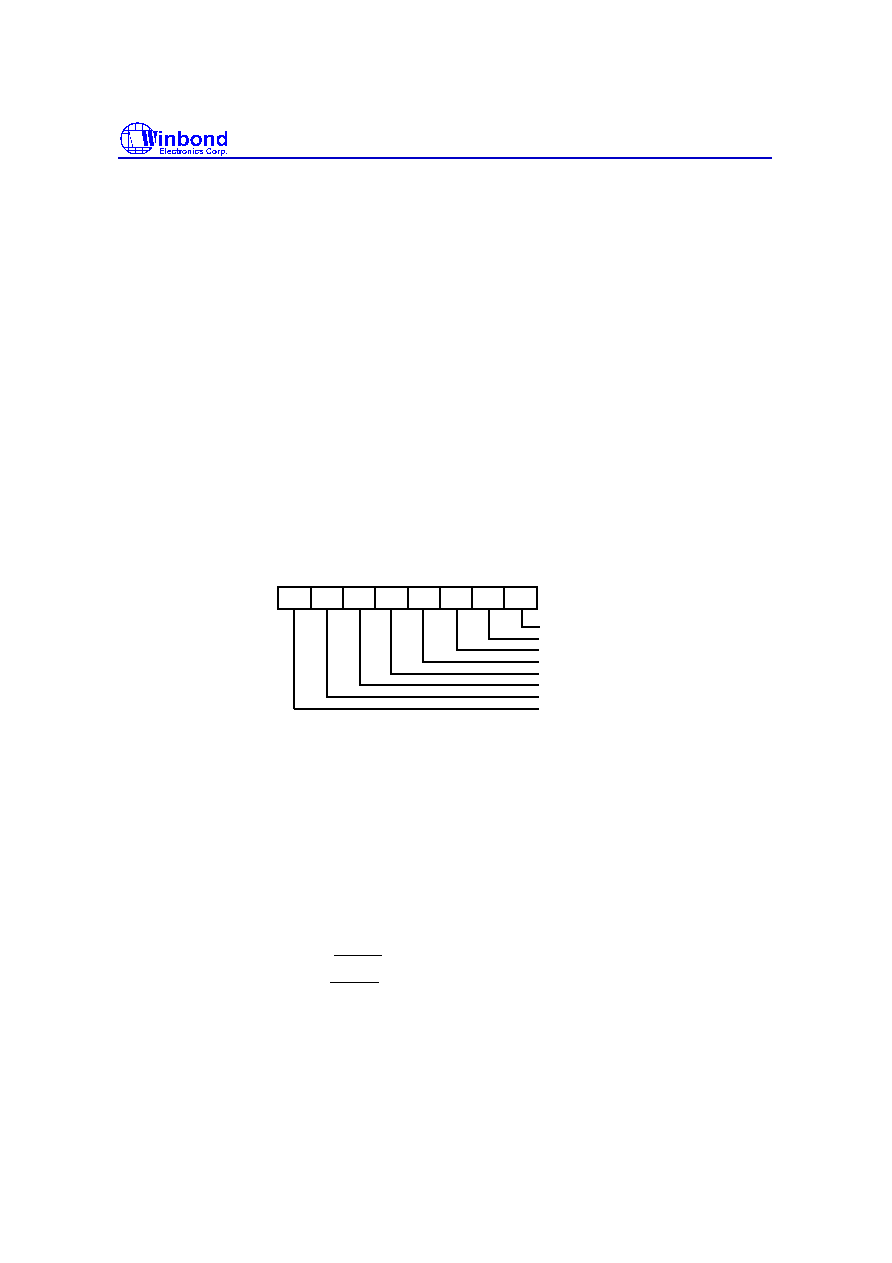
W83877ATF
Publication Release Date: April 1998
- 135 - Version 0.51
DIS_PRECOMP0 (bit 2):
This bit controls if precompensation is enabled for FDD A.
0 enable precompensation for FDD A
1 disable precompensation for FDD A
DRTB1, DRTB0 (bit 4 - bit 3):
These two bits combining with data rate selection bits in Date Rate Register select the operational
data rate for FDD B as shown in last table.
DIS_PRECOMP1 (bit 5):
This bit controls if precompensation is enabled for FDD B.
0 enable precompensation for FDD B
1 disable precompensation for FDD B
Bit 7 - bit 6: Rreserved.
8.2.38 Configuration Register 2E (CR2E), default = 2eH
When the device is in Extended Function mode and EFIR is 2eH, the CR2E register can be accessed
through EFDR. The bit definitions are as follows:
1
2
3
4
5
6
7
0
nEN16SA
ENPNF
INVRD
EN24X2M
DIS_BST
Reserved
Reserved
Reserved
ENPNF (Bit 0):
0
Disable Printer Not Floppy function. (Default)
1
Enable Printer Not Floopy function.
nEN16SA (Bit 1):
0
Enable 16-bit address decoder in the ISA bus. If the function of full ISA address
decoder is used, the device of COM B will be Changed to SIR/FIR function
automatically.
1
Disable 16-bit address decoder in the ISA bus.
INVRD (Bit 2):
0
Disable inverting RDATA from floppy disk input signal. (Default)
1
Enable inverting RDATA from floppy disk input signal.

W83877ATF
Publication Release Date: April 1998
- 136 - Version 0.51
EN24MX2:
0
Using internal circuit type
one to generate 48M Hz when CLKIN is 24M Hz. (Default)
1
Using internal circuit type
two to generate 48M Hz when CLKIN is 24M Hz.
DIS_BST(Bit3): Disable FDC DMA Burst Mode.
0
Enable FDC burst mode. (Default)
1
Disable FDC burst mode.
8.2.39 Configuration Register 31 (CR31), default=00H
When the device is in Extended Function mode and EFIR is 31H, the CR31 register can be accessed
through EFDR. The bit definitions are as follows:
1
2
3
4
5
6
7
0
reserved
reserved
IRQMODS
reserved
SCIIRQ0
SCIIRQ1
SCIIRQ2
SCIIRQ3
SCIIRQ3 ~ SCIIRQ0 (Bit 7 - bit 4):
The four bits select one IRQ pin for the SCI signal except for dedicated SCI signal output pin. Any
unselected pin is in tri-state.
CR31[7:4]
Mapped IRQ pin
0000
None (default)
0001
IRQ_A
0010
IRQ_B
0011
IRQ_C
0100
IRQ_D
0101
IRQ_E
0110
IRQ_F
0111
IRQ_G
1000
IRQ_H
While in the Serial IRQ mode (IRQMODS=1, CR31 bit 2), the above selection is invalid and all the
IRQ signal pins, from IRQ_A to IRQ_H, are all in tri-state. The SCI interrupt output is dedicated to the
SERIRQ pin. For the host controller to correctly sample the SCI interrupt, the SCI interrupt should be
programmed to appear in one of IRQ/Data Frame sampling periods.
In Serial IRQ mode, the definition of SCIIQS3-SCIIQS0 (bit 7-bit 4) is as follows:
SCIIQS3-SCIIQS0 (bit 7-bit 4): Select the IRQ/Data sampling period on the SERIRQ pin.
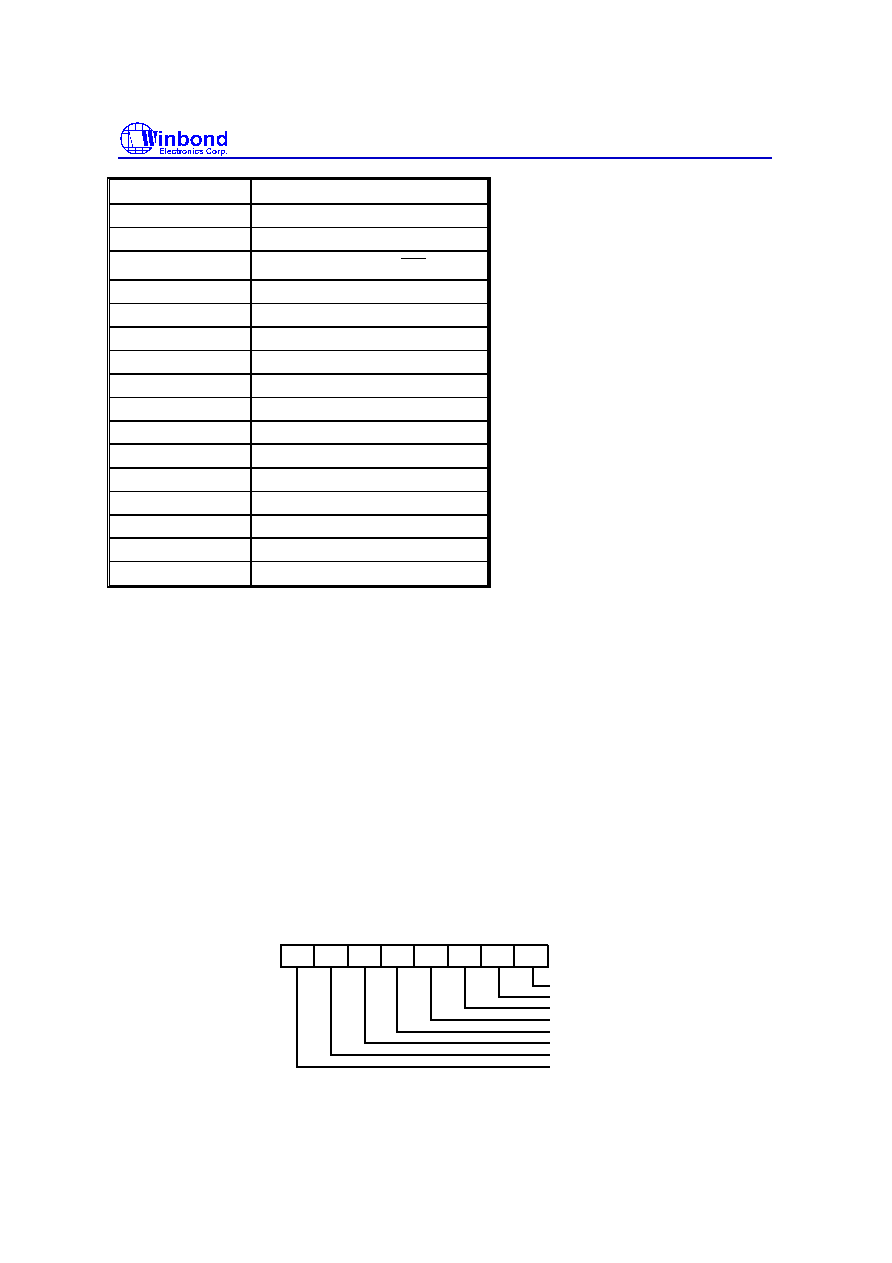
W83877ATF
Publication Release Date: April 1998
- 137 - Version 0.51
CR27[7:4]
IRQ/Data Frame Period
0000
None
0001
IRQ1
0010
Reserved for
SMI
0011
IRQ3
0100
IRQ4
0101
IRQ5
0110
IRQ6
0111
IRQ7
1000
IRQ8
1001
IRQ9
1010
IRQ10
1011
IRQ11
1100
IRQ12
1101
IRQ13
1110
IRQ14
1111
IRQ15
Bit 3: Reserved.
IRQMODS (Bit 2):
IRQ mode seleection. The W83877ATF supports: (1) legacy ISA IRQ mode or ISA IRQ sharing
mode. (2) Serial IRQ mode used in the PCI bus. In the legacy ISA IRQ sharing mode, the selected
IRQ pin for the device's IRQ is defined in the configuration registers CR27 - CR29. In the ISA IRQ
sharing mode, configuration register CR18 indicates which IRQ pin is in the IRQ sharing mode.
0: legacy ISA IRQ mode or ISA IRQ sharing mode.(default)
1: Serial IRQ mode used in PCI bus.
Bit 1 - bit 0: Reserved.
8.2.40 Configuration Register 32 (CR32), default=00H
When the device is in Extended Function mode and EFIR is 32H, the CR32 register can be accessed
through EFDR. The bit definitions are as follows:
1
2
3
4
5
6
7
0
URBPME
URAPME
FDCPME
PRTPME
reserved
reserved
reserved
CHIPPME
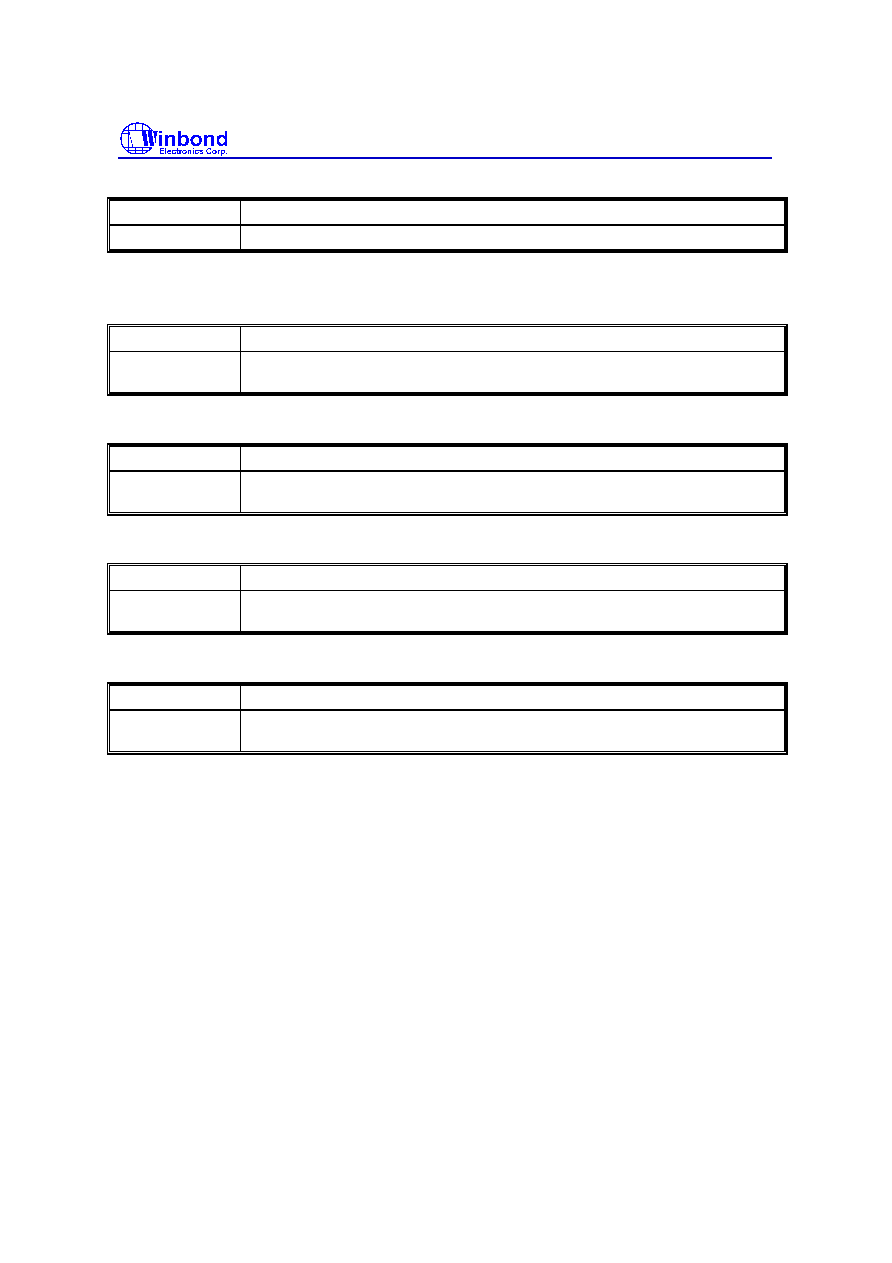
W83877ATF
Publication Release Date: April 1998
- 138 - Version 0.51
CHIPPME (Bit 7): W83877ATF chip power management enable.
0
disable the ACPI/Legacy and the auto power management functions.
1
enable the ACPI/Legacy and the auto power management functions.
Bit 6 - bit 4: Reserved.
PRTPME (Bit 3): Printer port power management enable.
0
disable the auto power management function.
1
enable the auto power management function, if this bit and CHIPPME(CR32 bit
7) are both set to 1.
FDCPME (Bit 2): FDC power management enable.
0
disable the auto power management function.
1
enable the auto power management function, if this bit and CHIPPME(CR32 bit
7) are both set to 1.
URAPME (Bit 1): UART A power management enable.
0
disable and the auto power management function.
1
enable auto power management function, if this bit and CHIPPME(CR32 bit 7)
are both set to 1.
.
URBPME (Bit 0): UART B power management enable.
0
disable the auto power management functions.
1
enable the auto power management function, if this bit and CHIPPME(CR32 bit
7) are both set to 1.
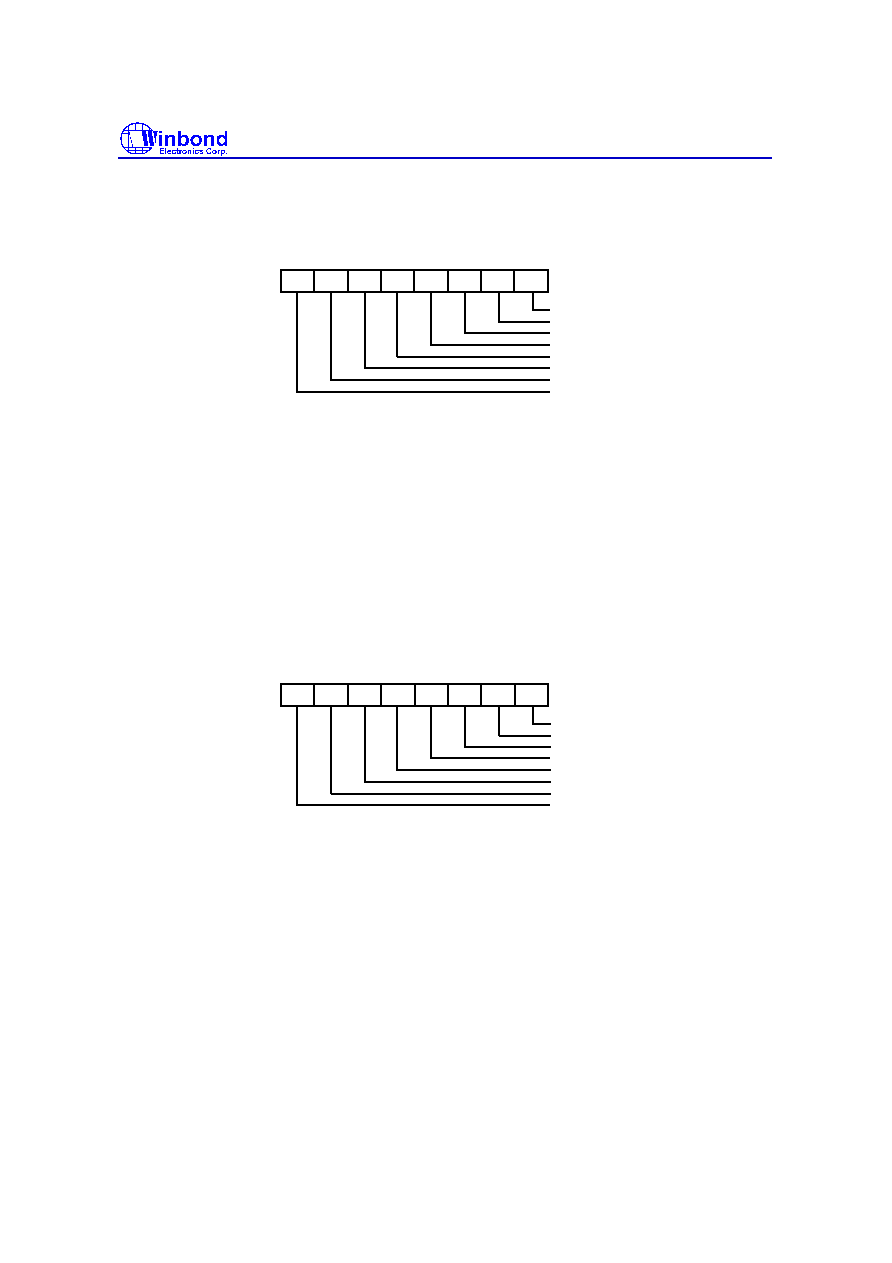
W83877ATF
Publication Release Date: April 1998
- 139 - Version 0.51
8.2.41 Configuration Register 33 (CR33), default=00H
When the device is in Extended Function mode and EFIR is 33H, the CR33 register can be accessed
through EFDR. The bit definitions are as follows:
1
2
3
4
5
6
7
0
reserved
reserved
PM1AD2
PM1AD3
PM1AD4
PM1AD5
PM1AD6
PM1AD7
PM1AD7 - PM1AD2 (Bit 7 - bit 2): Base address of the power management register block PM1.
This address is the base address of PM1a_EVT_BLK in the ACPI specification. The based address
should range from 01,0000,0000
b
to 11,1111,0000
b
,i.e., 100H ~ 3F0H, where bit 1 and bit 0 of the
base address should be set to 0 and the based address is in the 16-byte alignment. Note that the
based address of PM1a_CNT_BLK is equal to PM1a_EVT_BLK + 4, and PM_TMR_BLK is equal to
PM1a_EVT_BLK + 8.
Bit 1 - bit 0: Reserved, fixed at 0.
8.2.42 Configuration Register 34 (CR34), default=00H
When the device is in Extended Function mode and EFIR is 34H, the CR34 register can be accessed
through EFDR. The bit definitions are as follows:
1
2
3
4
5
6
7
0
reserved
GPEAD1
GPEAD2
GPEAD3
GPEAD4
GPEAD5
GPEAD6
GPEAD7
GPEAD7 - GPEAD1 (Bit7 - bit 1): Base address of the power management register block GPE.
This address is the base address of GPE0_BLK in the ACPI specification. The base address should
range from 01,0000,0000
b
to 11,1111,1000
b
,i.e., 100H ~ 3F8H, where bit 0 of the base address
should be set to 0 and the base address is in the 8-byte alignment. Note that the base address of
GPE1_BLK is GPE0_BLK + 4.
Bit 0: Reserved, fixed at 0.
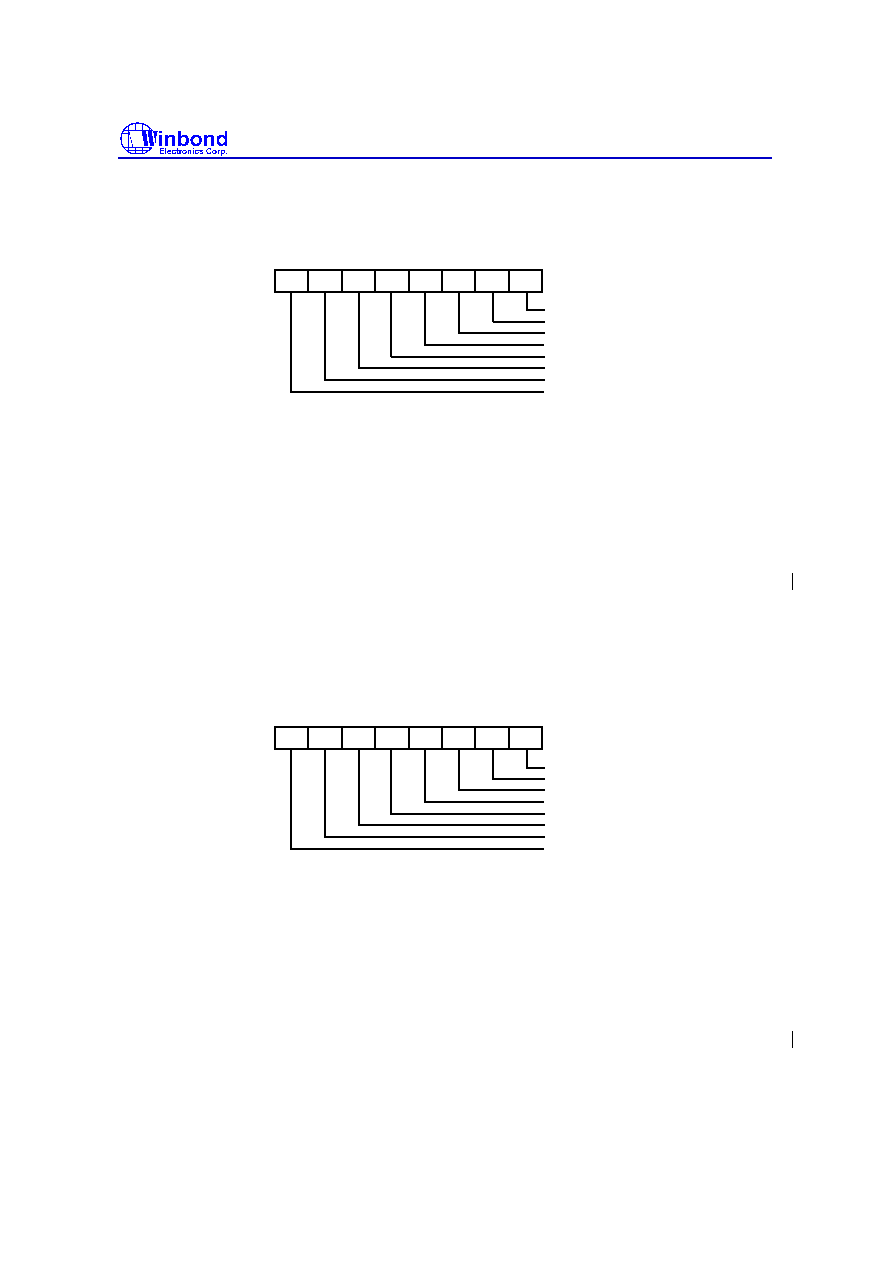
W83877ATF
Publication Release Date: April 1998
- 140 - Version 0.51
8.2.43 Configuration Register 35 (CR35), default=00H
When the device is in Extended Function mode and EFIR is 35H, the CR35 register can be accessed
through EFDR. The bit definitions are as follows:
1
2
3
4
5
6
7
0
URACNT0
URACNT1
URACNT2
URACNT3
URACNT4
URACNT5
URACNT6
URACNT7
URACNT7 - URACNT0 (Bit 7 - bit 0): UART A idle timer count.
This register is used to specify the initial value of UART A idle timer. Once UART A enters the
working state (that is, after any access to this device, any IRQ, and any external input), the power
down machine of UART A reloads this count value and the idle timer counts down. When the timer
counts down to zero, UART A enters the power down state ,i.e., sleeping state. If this register is set to
00H, the power down function will be invalid. The time resolution of this value is minute or second,
which is defined by the TMIN_SEL bit of the CR3A. Note that (1). This register is valid only when the
power management function of UART A is enabled, that is, CHIPPME=1 (CR32 bit 7) and
URAPME=1 (CR32 bit 1), (2). If the register is set to 00H, UART A will remain in the current state
(working or sleeping).
8.2.44 Configuration Register 36 (CR36), default=00H
When the device is in Extended Function mode and EFIR is 36H, the CR36 register can be accessed
through EFDR. The bit definitions are as follows:
1
2
3
4
5
6
7
0
URBCNT0
URBCNT1
URBCNT2
URBCNT3
URBCNT4
URBCNT5
URBCNT6
URBCNT7
URBCNT7 - URBCNT0 (Bit 7 - bit 0): UART B idle timer count.
This register is used to specify the initial value of UART B idle timer. Once UART B enters the
working state (that is, after any access to this device, any IRQ, and any external input), the power
down machine of UART B reloads this count value and the idle timer counts down. When the timer
counts down to zero, UART B enters the power down state ,i.e., sleeping state. If this register is set to
00H, the power down function will be invalid. The time resolution of this value is minute or second,
which is defined by the TMIN_SEL bit of CR3A. Note that (1). This register is valid only when the
power management function of UART B is enabled, that is, CHIPPME=1 (CR32 bit 7) and
URBPME=1 (CR32 bit 0), (2). If the register is set to 00H, UART B will remain in the current state
(working or sleeping).
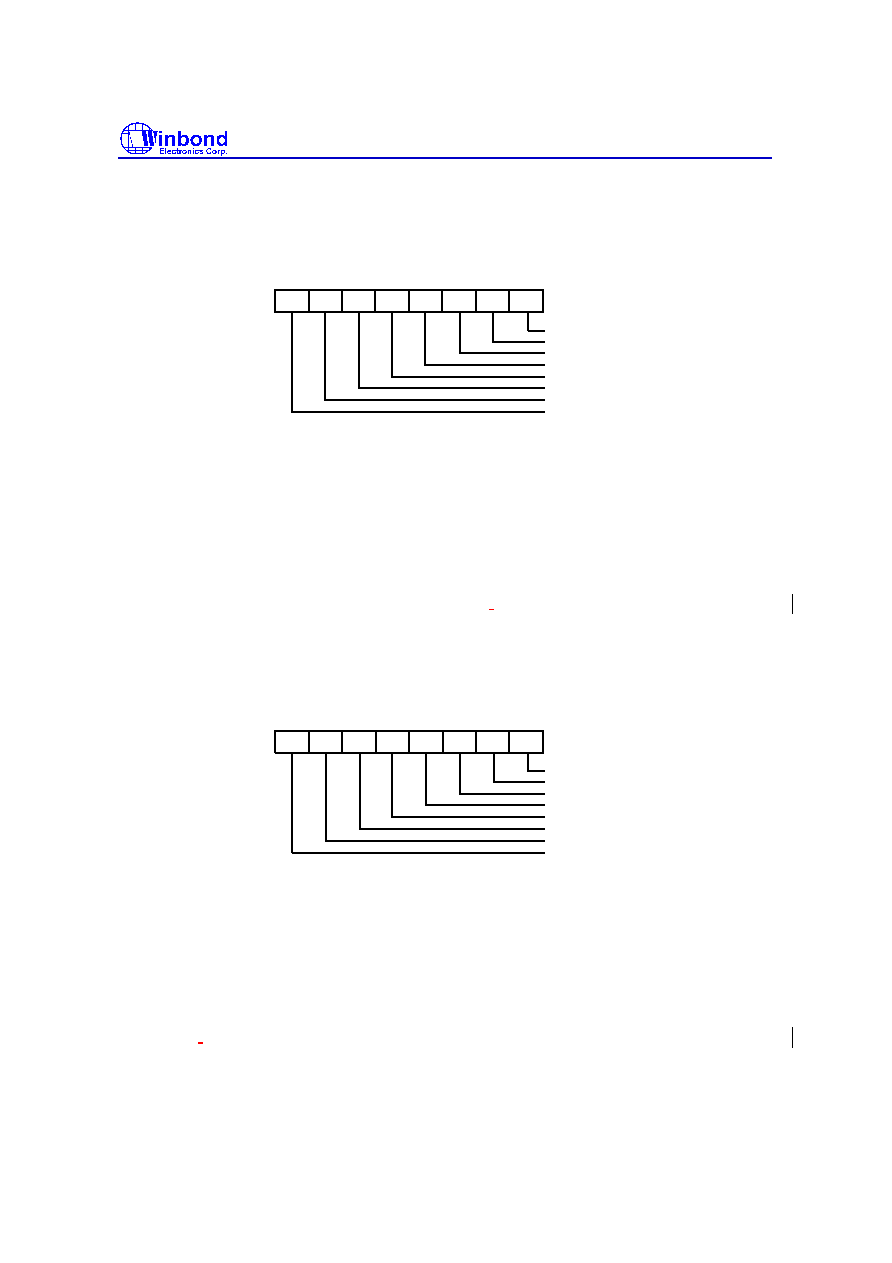
W83877ATF
Publication Release Date: April 1998
- 141 - Version 0.51
8.2.45 Configuration Register 37 (CR37), default=00H
When the device is in Extended Function mode and EFIR is 37H, the CR37 register can be accessed
through EFDR. The bit definitions are as follows:
1
2
3
4
5
6
7
0
FDCCNT0
FDCCNT1
FDCCNT2
FDCCNT3
FDCCNT4
FDCCNT5
FDCCNT6
FDCCNT7
FDCCNT7 - FDCCNT0 (Bit 7 - bit 0): FDC idle timer count.
This register is used to specify the initial value of FDC idle timer. Once FDC enters the working state
(that is, after any access to this device, any IRQ, and any external input), the power down machine of
FDC reloads this count value and the idle timer counts down. When the timer counts down to zero,
FDC enters the power down state ,i.e., sleeping state. If this register is set to 00H, the power down
function will be invalid. The time resolution of this value is minute or second, which is defined by the
TMIN_SEL bit of the CR3A. Note that (1). This register is valid only when the power management
function of FDC is enabled, that is, CHIPPME=1 (CR32 bit 7) and FDCPME=1 (CR32 bit 2), (2). If the
register is set to 00H, FDC will remain in the current state
(working or sleeping).
8.2.46 Configuration Register 38 (CR38), default=00H
When the device is in Extended Function mode and EFIR is 38H, the CR38 register can be accessed
through EFDR. The bit definitions are as follows:
1
2
3
4
5
6
7
0
PRTCNT0
PRTCNT1
PRTCNT2
PRTCNT3
PRTCNT4
PRTCNT5
PRTCNT6
PRTCNT7
PRTCNT7 - PRTCNT0 (Bit 7 - bit 0): printer port idle timer count.
This register is used to specify the initial value of the printer port idle timer. Once the printer port
enters the working state (that is, after any access to this device, any IRQ, and any external input), the
power down machine of the printer port reloads this count value and this idle timer counts down.
When the timer counts down to zero, printer port enters the power down state ,i.e., sleeping state. If
this register is set to 00H, the power down function will be invalid. The time resolution of this value is
minute or second, which is defined by the TMIN_SEL bit of CR3A. Note that (1). This register is valid
only when the power management function of the printer port is enabled, that is, CHIPPME=1 (CR32
bit 7) and PRTPME=1 (CR32 bit 3), (2). If the register is set to 00H, the printer port will remain in the
current state
(working or sleeping).

W83877ATF
Publication Release Date: April 1998
- 142 - Version 0.51
8.2.47 Configuration Register (CR39), default=00H
When the device is in Extended Function mode and EFIR is 39H, the CR39 register can be accessed
through EFDR. The bit definitions are as follows:
1
2
3
4
5
6
7
0
GSBCNT0
GSBCNT1
GSBCNT2
GSBCNT3
GSBCNT4
GSBCNT5
GSBCNT6
GSBCNT7
GSBCNT7 - GSBCNT0 (Bit 7 - bit 0): global stand-by idle timer count.
Once all devices of the chip (including UART A, UART B, FDC and the printer port) are all in the
power down state, the power down machine of W83877ATF chip loads this register value and counts
down. When the timer counts to zero, the whole chip enters the power down state, i.e., sleeping state.
If this register is set to 0, the power down function will be invalid. The time resolution of this register
value is minute or second, which is defined by the TMIN_SEL bit of CR3A. Note that (1). This register
is valid when the CHIPPME = 1 (CR32 bit 7), and (2) If the register is set to 00H, W83877ATF chip
will remain in the current state
(working or sleeping).
8.2.48 Configuration Register 3A (CR3A), default=00H
When the device is in Extended Function mode and EFIR is 3AH, the CR3A register can be accessed
through EFDR. The bit definitions are as follows:
7 6 5 4 3 2 1 0
UPULLEN
reserved
SMI_EN
reserved
reserved
TMIN_SEL
reserved
reserved
Bit 7 - bit 6 : Reserved, fixed at 0.
TMIN_SEL (Bit 5): Time resolution of the auto power machines of all devices.
CR35 to CR39 store the initial counts of the devices.
0
one second
1
one miniute
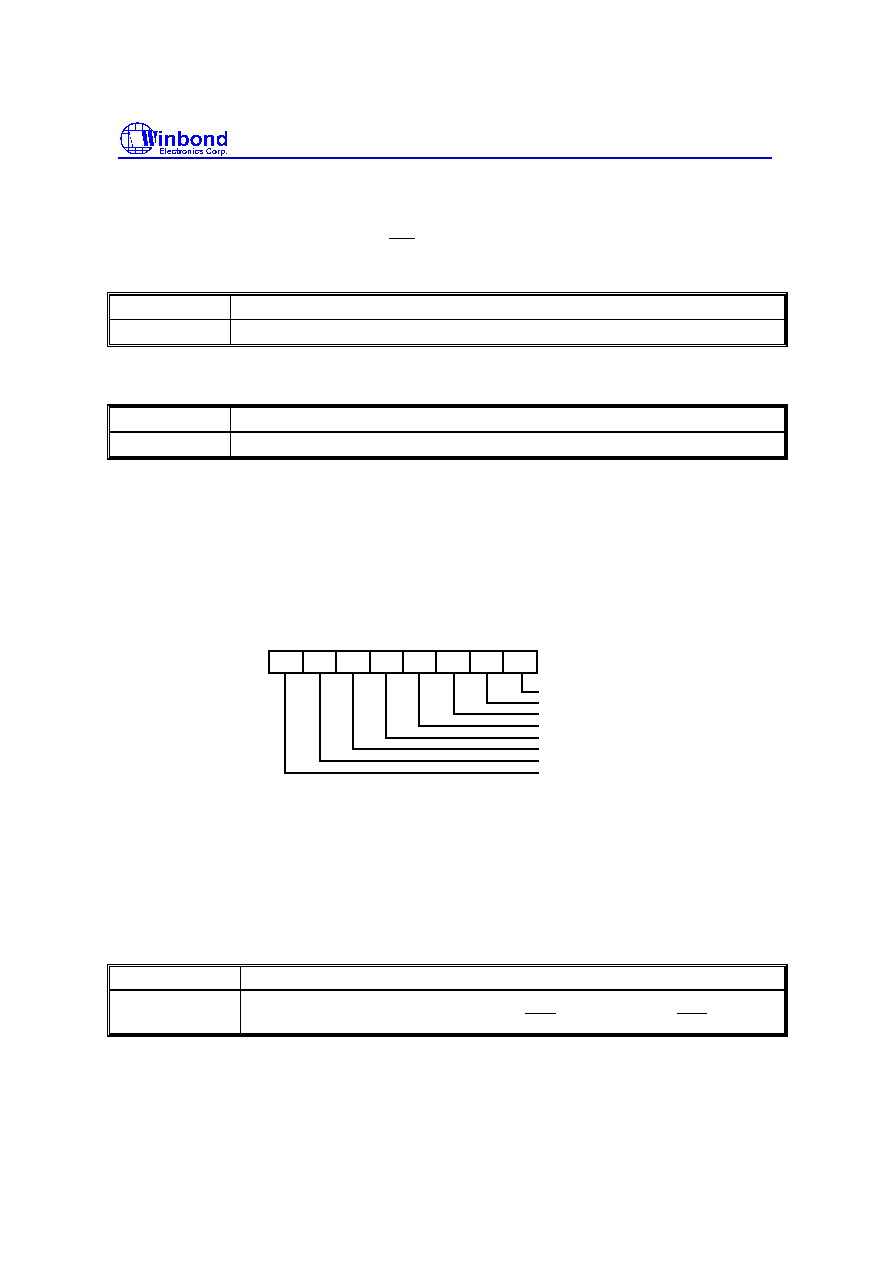
W83877ATF
Publication Release Date: April 1998
- 143 - Version 0.51
Bit 4 - bit 2: Reserved, fixed at 0.
SMI_EN (Bit 2): SMI output pin enable.
While an SMI event is raised on the output of the SMI logic, this bit determines whether the SMI
interrupt is generated on the SMI output SMI pin and on the Serial IRQ IRQSER pin while in Serial
IRQ mode.
0
disable
1
enable
Bit 1:Reserved.
UPULLEN (Bit 0): Enable the pull up of IRQSER pin in Serial IRQ mode.
0
disable the pull up of IRQSER pin.
1
enable the pull up of IRQSER pin.
8.2.49 Configuration Register 3B (CR3B), default=00H
Reserved for testing. Should be kept all 0's.
8.2.50 Configuration Register 40 (CR40), default=00H
When the device is in Extended Function mode and EFIR is 40H, the CR40 register can be accessed
through EFDR. The bit definitions are as follows:
1
2
3
4
5
6
7
0
URBIDLSTS
URAIDLSTS
FDCIDLSTS
PRTIDLSTS
reserved
reserved
reserved
reserved
Bit 7 - bit 4 : Reserved, fixed at 0.
Bit 3 - bit 0 : Devices' idle status.
These bits indicate that the individual device's idle timer expires due to no I/O access, IRQ, and
external input to the device respectively. These 4 bits are controlled by the printer port, FDC, UART
A, and UART B power down machines individually. The bits are set/cleared by W83877ATF
automatically. Writing a 1 can also clear this bit, and writing a 0 has no effect.
PRTIDLSTS (Bit 3): printer port idle status.
0
printer port is now in the working state.
1
printer port is now in the sleeping state due to no printer port access, IRQ, DMA
acknowledge, and no transition on BUSY, ACK , PE, SLCT, and ERR pins.

W83877ATF
Publication Release Date: April 1998
- 144 - Version 0.51
FDCIDLSTS (Bit 2): FDC idle status.
0
FDC is now in the working state.
1
FDC is now in the sleeping state due to no FDC access, no IRQ, no DMA
acknowledge, and no enabling of the motor enable bits in the DOR register.
URAIDLSTS (Bit 1): UART A idle status.
0
UART A is now in the working state.
1
UART A is now in the sleeping state due to no UART A access, no IRQ, the
receiver is now waiting for a start bit, the transmitter shift register is now empty,
and no transition on MODEM control input lines.
URBIDLSTS (Bit 0): UART B idle status.
0
UART B is now in the working state.
1
UART B is now in the sleeping state due to no UART B access, no IRQ, the
receiver is now waiting for a start bit, the transmitter shift register is now empty,
and no transition on MODEM control input lines.
8.2.51 Configuration Register 41 (CR41), default=00H
When the device is in Extended Function mode and EFIR is 41H, the CR41 register can be accessed
through EFDR. The bit definitions are as follows:
1
2
3
4
5
6
7
0
URBTRAPSTS
URATRAPSTS
FDCTRAPSTS
PRTTRAPSTS
reserved
reserved
reserved
reserved
Bit 7 - bit 4 : Reserved, fixed at 0.
Bit 3 - bit 0 : Devices'
trap status.
These bits indicate that the individual device wakes up due to any I/O access, IRQ, and external input
to the device respectively. The device's idle timer reloads the initial count value from CR35-CR39,
depending on which device wakes up. These 4 bits are controlled by the printer port, FDC, UART A,
and UART B power down machines individually. The bits are set/cleared by W83877ATF
automatically. Writing a 1 can also clear this bit, and writing a 0 has no effect.

W83877ATF
Publication Release Date: April 1998
- 145 - Version 0.51
PRTTRAPSTS (Bit 3): printer port trap status.
0
the printer port is now in the sleeping state.
1
the printer port is now in the working state due to any printer port access, any
IRQ, any DMA acknowledge, and any transition on BUSY, ACK , PE, SLCT, and
ERR pins.
FDCTRAPSTS (Bit 2): FDC trap status.
0
FDC is now in the sleeping state.
1
FDC is now in the working state due to any FDC access, any IRQ, any DMA
acknowledge, and any enabling of the motor enable bits in the DOR register.
URATRAPSTS (Bit 1): UART A trap status.
0
UART A is now in the sleeping state.
1
UART A is now in the working state due to any UART A access, any IRQ, the
receiver begins receiving a start bit, the transmitter shift register begins
transmitting a start bit, and any transition on MODEM control input lines.
URBTRAPSTS (Bit 0): UART B trap status.
0
UART B is now in the sleeping state.
1
UART B is now in the working state due to any UART B access, any IRQ, the
receiver begins receiving a start bit, the transmitter shift register begins
transmitting
a start bit, and any transition on MODEM control input lines.
8.2.52 Configuration Register 42 (CR42), default=N/A
When the device is in Extended Function mode and EFIR is 42H, the CR42 register can be accessed
through EFDR. The bit definitions are as follows:
1
2
3
4
5
6
7
0
URBIRQSTS
URAIRQSTS
FDCIRQSTS
PRTIRQSTS
reserved
reserved
reserved
reserved
Bit 7 - bit 4 : Reserved, fixed at 0.
Bit 3 - bit 0 : Device's IRQ status .
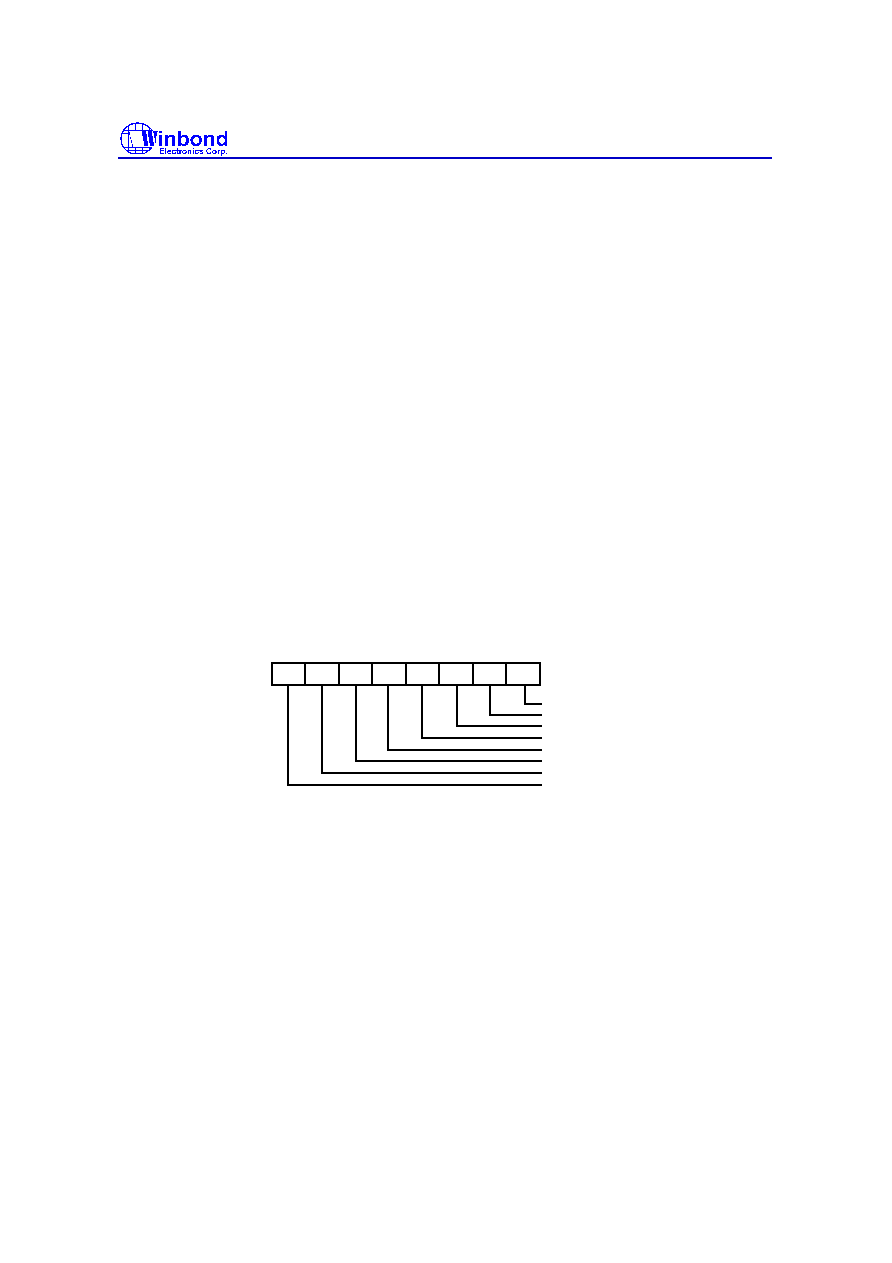
W83877ATF
Publication Release Date: April 1998
- 146 - Version 0.51
These bits indicate the IRQ pin status of the individual device. The device's IRQ status bit is set or
cleared at their source device; writing a 1 or 0 has no effect.
PRTIRQSTS (Bit 3) : printer port IRQ status. While the IRQ type of printer port is edge trigger-type,
this bit will set and reset immediately. As the software reads this bit, it indicates low level. The
software must read the IRQ status bit in the printer port device register to correctly identify whether
the printer port IRQ occurs.
FDCIRQSTS (Bit 2) : FDC IRQ status.
URAIRQSTS (Bit 1) : UART A IRQ status.
URBIRQSTS (Bit 0) : UART B IRQ status.
8.2.53 Configuration Register 43 (CR43), default=00H
When the device is in Extended Function mode and EFIR is 43H, the CR43 register can be accessed
through EFDR. This register is reserved.
8.2.54 Configuration Register 44 (CR44), default=00H
When the device is in Extended Function mode and EFIR is 44H, the CR44 register can be accessed
through EFDR. This register is reserved.
8.2.55 Configuration Register 45 (CR45), default=00H
When the device is in Extended Function mode and EFIR is 45H, the CR45 register can be accessed
through EFDR. The bit definitions are as follows:
1
2
3
4
5
6
7
0
URBIRQEN
URAIRQEN
FDCIRQEN
PRTIRQEN
reserved
reserved
reserved
reserved
Bit 7 - bit 4 : Reserved, fixed at 0.
Bit 3 - bit 0 : Enable bits of the SMI generation due to the device's IRQ.

W83877ATF
Publication Release Date: April 1998
- 147 - Version 0.51
These bits enable the generation of an SMI interrupt due to any IRQ of the devices respectively.
These 4 bits control the printer port, FDC, UART A, and UART B SMI logics individually. The SMI
logic output for the IRQs is as follows:
SMI logic output = (URBIRQEN and URBIRQSTS) or (URAIRQEN and URAIRQSTS) or
(FDCIRQEN and FDCIRQSTS) or (PRTIRQEN and PRTIRQSTS)
If any device's IRQ is raised, the coresponding IRQ status bit in CR42 is set. If the device's enable bit
is set and SMI_EN(in CR3A) and CHIPPME(in CR32) is both set, then SMI interrupt occurs on the
SMI output pin.
PRTIRQEN (Bit 3):
0
disable the generation of an SMI interrput due to the printer port's IRQ.
1
enable the generation of an SMI interrput due to the printer port's IRQ.
FDCIRQEN (Bit 2):
0
disable the generation of an SMI interrupt due to the FDC's IRQ.
1
enable the generation of an SMI interrupt due to the FDC's IRQ.
URAIRQEN (Bit 1):
0
disable the generation of an SMI interrupt due to the UART A's IRQ.
1
enable the generation of an SMI interrupt due to the UART A's IRQ.
URBIRQEN (Bit 0):
0
disable the generation of an SMI interrupt due to the UART B's IRQ.
1
enable the generation of an SMI interrupt due to the UART B's IRQ.
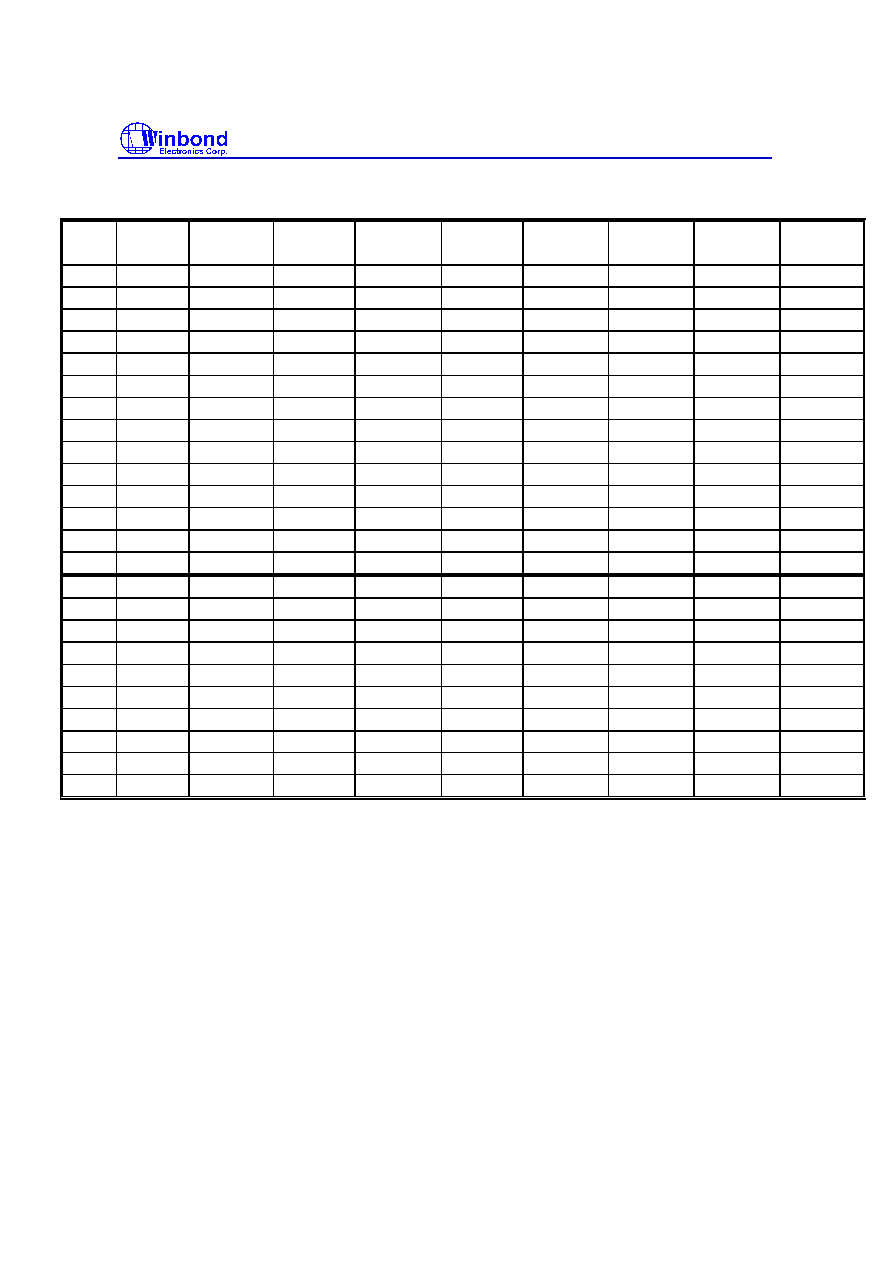
W83877ATF
Publication Release Date: April 1998
- 148 - Version 0.51
8.2.56 Bit Map Configuration Registers
Table 8-1: Bit Map of Configuration Registers
Register
Power-on
Reset Value
D7
D6
D5
D4
D3
D2
D1
D0
CR0
0000 0000
0
0
0
0
PRTMODS1
PRTMODS0
0
IPD
CR1
0000 0000
ABCHG
0
0
0
0
0
0
0
CR2
0000 0000
0
0
0
0
0
0
0
0
CR3
0011 0000
0
0
EPPVER
0
0
0
SUAMIDI
SUBMIDI
CR4
0000 0000
PRTPWD
0
URAPWD
URBPWD
PRTTRI
0
URATRI
URBTRI
CR5
0000 0000
0
0
0
0
ECPFTHR3
ECPFTHR2
ECPFTHR1
ECPFTHR0
CR6
0000 0000
0
0
SEL4FDD
FIPURDWN
FDCPWD
0
FDCTRI
0
CR7
0000 0000
FDD D T1
FDD D T0
FDD C T1
FDD C T0
FDD B T1
FDD B T0
FDD A T1
FDD A T0
CR8
0000 0000
0
0
DISFDDWR
SWWP
MEDIA 1
MEDIA 0
BOOT 1
BOOT 0
CR9
0000 1101
PRTMODS2
LOCKREG
EN3MODE
0
CHIP ID 3
CHIP ID 2
CHIP ID 1
CHIP ID 0
CRA
0000 0000
0
0
0
0
0
0
0
0
CRB
0000 1100
0
Tx4WC
Rx4WC
ENIFCHG
IDENT
MFM
INVERTZ
DRV2EN
CRC
0010 1000
TURA
TURB
HEFERE
0
URIRSEL
0
RX2INV
TX2INV
CRD
1010 0011
SIRTX1
SIRTX0
SIRRX1
SIRRX0
HDUPLX
IRMODE2
IRMODE1
IRMODE0
CR10
0000 0000
GIO0AD7
GIO0AD6
GIO0AD5
GIO0AD4
GIO0AD3
GIO0AD2
GIO0AD1
GIO0AD0
CR11
0000 0000
G0CADM1
G0CADM0
0
0
0
GIO0AD10
GIO0AD9
GIO0AD8
CR12
0000 0000
GIO1AD7
GIO1AD6
GIO1AD5
GIO1AD4
GIO1AD3
GIO1AD2
GIO1AD1
GIO1AD0
CR13
0000 0000
G1CADM1
G1CADM0
0
0
0
GIO1AD10
GIO1AD9
GIO1AD8
CR14
0000 0000
GIOP0MD2
GIOP0MD1
GIOP0MD0
GIO0CSH
GCS0IOR
GCS0IOW
GDA0OPI
GDA0IPI
CR15
0000 0000
GIOP1MD2
GIOP1MD1
GIOP1MD0
GIO1CSH
GCS1IOR
GCS1IOW
GDA1OPI
GDA1IPI
CR16
00ss 0s0s
1
0
0
G1IQSEL
G0IQSEL
0
PNPCVS
0
HEFRAS
CR17
0000 0000
0
0
0
PRIRQOD
DSFDLGRQ
DSPRLGRQ
DSUALGRQ
DSUBLGRQ
CR18
0000 0000
SHARH
SHARG
SHARF
SHARE
SHARD
SHARC
SHARB
SHARA
CR19
0000 0000
0
0
0
0
0
0
FASTA
FASTB

W83877ATF
Publication Release Date: April 1998
- 149 - Version 0.51
ContinuedTable 8-1: Bit Map of Configuration Registers
CR20
1111 1100
2
FDCAD7
FDCAD6
FDCAD5
FDCAD4
FDCAD3
FDCAD2
0
0
CR23
1101 1110
2
PRTAD7
PRTAD6
PRTAD5
PRTAD4
PRTAD3
PRTAD2
PRTAD1
PRTAD0
CR24
1111 1110
2
URAAD7
URAAD6
URAAD5
URAAD4
URAAD3
URAAD2
URAAD1
0
CR25
1011 1110
2
URBAD7
URBAD6
URBAD5
URBAD4
URBAD3
URBAD2
URBAD1
0
CR26
0010 0011
2
FDCDQS3
FDCDQS2
FDCDQS1
FDCDQS0
PRTDQS3
PRTDQS2
PRTDQS1
PRTDQS0
CR27
0000 0101
2
ECPIRQx2
ECPIRQx1
ECPIRQx0
0
PRTIQS3
PRTIQS2
PRTIQS1
PRTIQS0
CR28
0100 0011
2
URAIQS3
URAIQS2
URAIQS1
URAIQS0
URBIQS3
URBIQS2
URBIQS1
URBIQS0
CR29
0110 0000
2
FDCIQS3
FDCIQS2
FDCIQS1
FDCIQS0
IQNIQS3
IQNIQS2
IQNIQS1
IQNIQS0
CR2A
0000 0000
IRTXDSL3
IRTXDSL2
IRTXDSL1
IRTXDSL0
IRRXDSL3
IRRXDSL2
IRRXDSL1
IRRXDSL0
CR2B
0000 0000
PIN1FUN1
PIN1FUN0
PIN2FUN1
PIN2FUN0
PIN3FUN1
PIN3FUN0
PIN93FUN1
PIN93FUN0
CR2C
0000 0000
PIN91FUN2
PIN91FUN1
PIN91FUN0
APEDCRC
ENBNKSL
CLKINSEL
0
0
CR2D
0000 0000
0
0
DIS-PRECOM1
DRTB 1
DRTB 0
DIS-PRECOM0
DRTA 1
DRTA 0
CR31
0000 0s00
SCIIRQ3
SCIIRQ2
SCIIRQ1
SCIIRQ0
0
IRQMODS
0
0
CR32
0000 0000
CHIPPME
0
0
0
PRTPME
FDCPME
URAPME
URBPME
CR33
0000 0000
PM1AD7
PM1AD6
PM1AD5
PM1AD4
PM1AD3
PM1AD2
0
0
CR34
0000 0000
GPEAD7
GPEAD6
GPEAD5
GPEAD4
GPEAD3
GPEAD2
GPEAD1
0
CR35
0000 0000
URACNT7
URACNT6
URACNT5
URACNT4
URACNT3
URACNT2
URACNT1
URACNT0
CR36
0000 0000
URBCNT7
URBCNT6
URBCNT5
URBCNT4
URBCNT3
URBCNT2
URBCNT1
URBCNT0
CR37
0000 0000
FDCCNT7
FDCCNT6
FDCCNT5
FDCCNT4
FDCCNT3
FDCCNT2
FDCCNT1
FDCCNT0
CR38
0000 0000
PRTCNT7
PRTCNT6
PRTCNT5
PRTCNT4
PRTCNT3
PRTCNT2
PRTCNT1
PRTCNT0
CR39
0000 0000
GSBCNT7
GSBCNT6
GSBCNT5
GSBCNT4
GSBCNT3
GSBCNT2
GSBCNT1
GSBCNT0
CR3A
0000 0000
0
0
TMIN_SEL
0
0
SMI_EN
0
UPULLEN
CR40
0000 0000
0
0
0
0
PRTIDLSTS
FDCIDLSTS
URAIDLSTS
URBIDLSTS
CR41
0000 0000
0
0
0
0
PRTTRAPSTS
FDCTRAPSTS
URATRAPSTS
URBTRAPSTS
CR42
0000 0000
0
0
0
0
PRTIRQSTS
FDCIRQSTS
URAIRQSTS
URBIRQSTS
CR43
0000 0000
0
0
0
0
0
0
0
0
CR44
0000 0000
0
0
0
0
0
0
0
0
CR45
0000 0000
0
0
0
0
PRTIRQEN
FDCIRQEN
URAIRQEN
URBIRQEN
Notes:
1. 's' means its value depends on corresponding power-on setting pin.
2. These default values are valid when CR16 bit 2 is 1 during power-on reset; They will be all 0's if CR16 bit 2 is 0.

W83877ATF
Publication Release Date: April 1998
- 150 - Version 0.51
8.3 ACPI Registers Features
W83877ATF supports both the ACPI and legacy power managements. The switch logic of the power
managment block generates an SMI interrupt in the legacy mode and an SCI interrupt in the ACPI
mode. For the legacy mode, the SMI_EN bit is used. If it is set, it routes the power management
events from the SMI interrupt logic to the SMI output pin. For the ACPI mode, the SCI_EN bit is used.
If it is set, it routes the power management events to the SCI interrupt logic. The SMI_EN bit is
located in the CR3A register and the SCI_EN bit is located in the PM1 register block. See the
following figure for an illustration.
PM Timer
Device Idle
Timers
Device Trap
Timer
SMI Logic
SMI_EN
SMI output
Logic
SCI output
Logic
Sleep/Wake
State machine
WAK_STS
Clock
Control
SCI
SMI
SCI Logic
Global STBY
SCI events
0
1
SCI_EN
SMI events
IRQs
IRQs
IRQs
The SMI interrupt is routed to pin SMI , which is dedicated for the SMI interrupt output. Another way
to output the SMI interrupt is to route to pin IRQSER, which is the signal pin in the Serial IRQ mode.
The SCI interrupt is routed to pin SCI , which is dedicated for the SCI function. The other way to
output the SCI interrupt is to route to one interrupt request signal pin IRQA~H, which is selected
through CR31 bit[7:4]. Another way is output the SCI interrupt is to route to pin IRQSER.
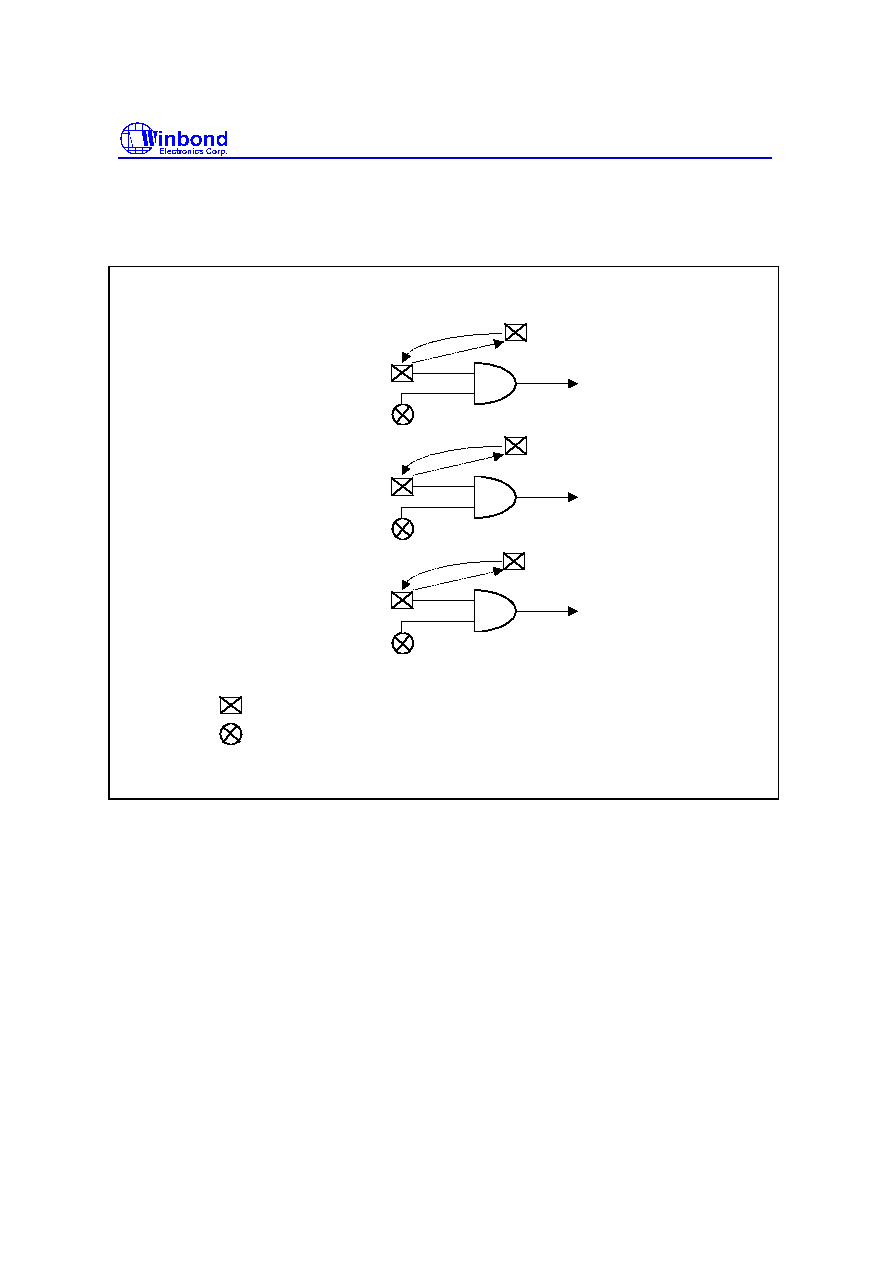
W83877ATF
Publication Release Date: April 1998
- 151 - Version 0.51
8.3.1 SMI to SCI/SCI to SMI and Bus Master
For the process of generating an interrupt from SMI to SCI or from SCI to SMI, see the following
figure for an illustration.
BIOS_RLS
GBL_EN
from SCI to SMI
GBL_RLS
BIOS_EN
Bus Master SCI
BM_CNTPL
BM_RLD
clear
set
BM_STS
To SCI Logic
To SMI Logic
To SCI Logic
from SMI to SCI
clear
set
clear
set
GBL_STS
BIOS_STS
: Status bit
: Enable bit
For the BIOS software to raise an event to the ACPI software, BIOS_RLS, GBL_EN, and GBL_STS
bits are involved. GBL_EN is the enable bit and the GBL_STS is the status bit. Both are controlled by
the ACPI software. If BIOS_RLS is set by the BIOS software and GBL_EN is set by the ACPI
software, an SCI interrupt is raised. Writing a 1 to BIOS_RLS sets it to logic 1 and also sets
GBL_STS to logic 1; Writing a 0 to BIOS_RLS has no effect. Writing a 1 to GBL_STS clears it to
logic 0 and also clears BIOS_RLS to logic 0; writing a 0 to GBL_STS has no effect.
For the ACPI software to raise an event to the BIOS software, GBL_RLS, BIOS_EN, and BIOS_STS
bits are involved. BIOS_EN is the enable bit and the BIOS_STS is the status bit. Both are controlled
by the BIOS software. If GBL_RLS is set by the ACPI software and BIOS_EN is set by the BIOS
software, an SMI is raised. Writing a 1 to GBL_RLS sets it to logic 1 and also sets BIOS_STS to
logic 1; Writing a 0 to GBL_RLS has no effect. Writing a 1 to BIOS_STS clears it to logic 0 and also
clears GBL_RLS to logic 0; writing a 0 to BIOS_STS has no effect.
For the bus master to raise an event to the ACPI software, BM_CNTRL, BM_RLD, and BM_STS bits
are involved. Both BM_RLD and BM_STS are controlled by the ACPI software. If BM_CNTRL is set

W83877ATF
Publication Release Date: April 1998
- 152 - Version 0.51
by the BIOS software and BM_RLD is set by the ACPI software, an SCI interrupt is raised. Writing a
1 to BM_CNTRL sets it to logic 1 and also sets BM_STS to logic 1; Writing a 0 to BM_CNTRL has no
effect. Writing a 1 to BM_STS clears it to logic 0 and also clears BM_CNTRL to logic 0; writing a 0 to
BM_STS has no effect.
8.3.2 Power Management Timer
In the ACPI specification, a power management timer is required. The power management timer is a
24-bit fixed rate free running count-up timer that runs off a 3.579545MHZ clock. The power
management timer has the corresponding status bit (TMR_STS) and enable bit (TMR_EN). The
TMR_STS bit is set any time the last bit of the timer (bit 23) goes from 0 to 1 or from 1 to 0. If the
TMR_EN bit is set, the setting of the TMR_STS bit will generate an SCI interrupt. Three registers are
used to read the timer value; they are located in the PM1 register block. The power management
timer has one enable bit (TMR_ON) to turn if on or off. The TMR_ON is located in GPE register
block. If it is cleared to 0, the power management timer function will not work. There are no timer
reset requirements, except that the timer should function after power-up. See the following figure for
an
illustration.
To SCI Logic
24 bit
counter
Bits (23-0)
TMR_STS
TMR_EN
TMR_ON
3.579545 MHz
24
TMR_VAL
8.4 ACPI Registers (ACPIRs)
The ACPI register model consists of the fixed register blocks that perform the ACPI functuions. A
register block may be a event register block which deals with ACPI events, or a control register block
which deals with control features. The ordering in the event register block is the status register,
followed by the enable register.
Each event register, if implemented, contains two egisters: a status register and an enable register,
both in 16-bit size. The status register indicates what defined function needs the ACPI System Control
Interrupt (SCI). When the hardware event occurs, the defined status bit is set. However, to generate
the SCI, the associated enable bit must be set. If the enable bit is not set, the software can examine
the state of the hardware event by reading the status bit without generating an SCI interrupt.
Any status bit, unless otherwise noted, can only be set by some defined hardware event. It is cleared
by writing a 1 to its bit position; writing a 0 has no effect. Except forsome special status bits, every
status bit has an assiciated enable bit in the same bit position in the enable register. Those status bits
which have no respective enable bit are read for special purposes. Reserved or un-implemented
enable bits always return zero, and writing to these bits should have no effect.
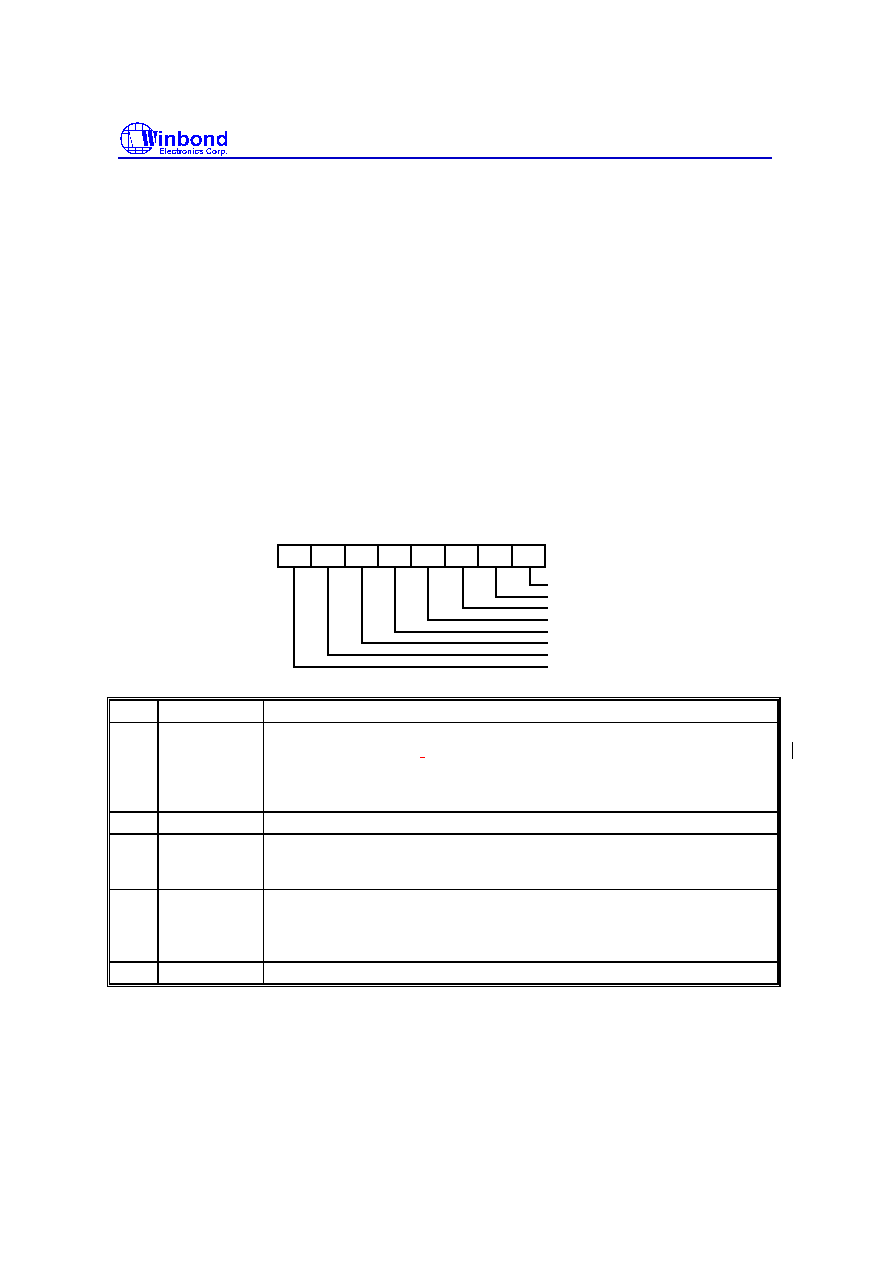
W83877ATF
Publication Release Date: April 1998
- 153 - Version 0.51
The control bit in the control register provides some special control functions over the hardware
event, or some special control over SCI event. Reserved or un-implemented control bits always
return zero, and writing to those bits should have no effect.
Table 8-4 lists the PM1 register block and the relative locations of the registers within it. The base
address of PM1 register block is named as PM1a_EVT_BLK in the ACPI specification. The base
address should range from 01,0000,0000
b
to 11,1111,0000
b
,i.e., 100H ~ 3F0H, where bit 1 and bit 0
of PM1 register block should be set to 0 and the base address is in the 16-byte alignment.
Table 8-5 lists the GPE register block and the relative locations within it. The base address of power
management event block GPE is named as GPE0_BLK in the ACPI specification. The base address
should range from 01,0000,0000
b
to 11,1111,1000
b
,i.e., 100H ~ 3F8H, where bit 0 of the base
address should be set to 0 and the base address is in the 8-byte alignment.
8.4.1 Power Management 1 Status Register 1 (PM1STS1)
Register Location: <CR33> System I/O Space
Default Value: 00h
Attribute: Read/write
Size: 8 bits
1
2
3
4
5
6
7
0
TMR_STS
Reserved
Reserved
Reserved
BM_STS
GBL_STS
Reserved
Reserved
Bit
Name
Description
0
TMR_STS
This bit is the timer carry status bit. This bit gets set anytime the bit 23 of the
24-bit counter changes
(whenever the MSB changes from low to high or high
to low). While TMR_EN and TMR_STS are set, a power magement event is
raised. This bit is only set by hardware and can only be cleared by the
software writing a 1 to this bit position. Writing a 0 has no effect.
1-3
Reserved
Reserved.
4
BM_STS
This is the bus master status bit. Writing a 1 to BM_CNTRL also sets
BM_STS. Writing a 1 clears this bit and also clears BM_CNTRL. Writing a 0
has no effect.
5
GBL_STS
This is the global status bit. This bit is set when the BIOS want the attention
of the SCI handler. BIOS sets this bit by setting BIOS_RLS and can only be
cleared by software writing a 1 to this bit position. Writing a 1 to this bit
position also clears BIOS_RLS. Writing a 0 has no effect.
6-7
Reserved
Reserved. These bits always return a value of zero.
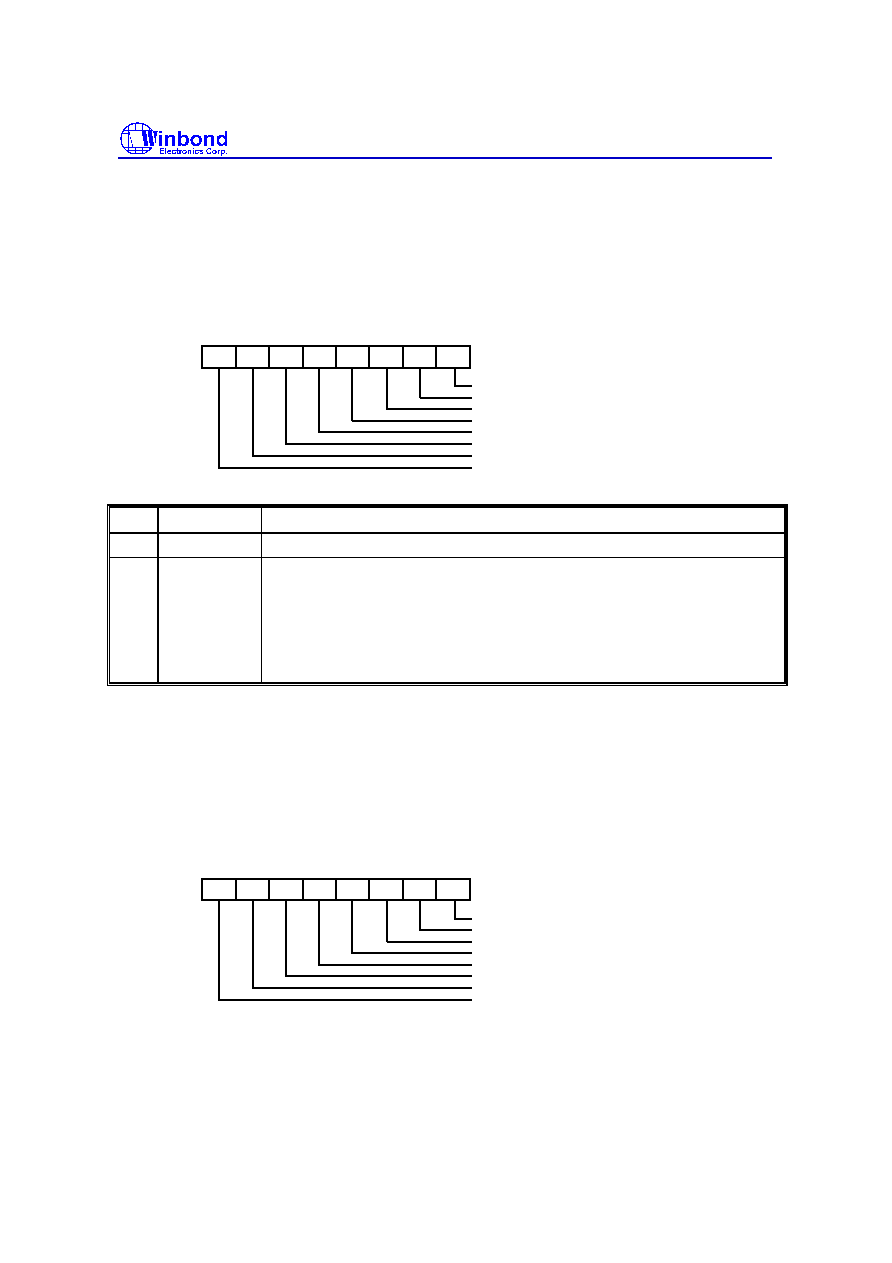
W83877ATF
Publication Release Date: April 1998
- 154 - Version 0.51
8.4.2 Power Management 1 Status Register 2 (PM1STS2)
Register Location: <CR33>+1H System I/O Space
Default Value: 00h
Attribute: Read/write
Size: 8 bits
1
2
3
4
5
6
7
0
Reserved
Reserved
Reserved
Reserved
Reserved
Reserved
Reserved
WAK_STS
Bit
Name
Description
0-6
Reserved
Reserved.
7
WAK_STS
This bit is set when the system is in the sleeping state and an enabled resume
event occurs. Upon setting this bit, the sleeping/working state machine will
transition the system to the working state. This bit is only set by hardware, and
is cleared by software writing a 1 to this bit position or by the sleeping/working
state machine automatically upon the expiry of the global standby timer.
Writing a 0 has no effect. Upon the WAK_STS beingcleared and all devices
being in sleeping state, the whole chip enters the sleeping state.
8.4.3 Power Management 1 Enable Register 1(PM1EN1)
Register Location: <CR33>+2H System I/O Space
Default Value: 00h
Attribute: Read/write
Size: 8 bits
1
2
3
4
5
6
7
0
TMR_EN
Reserved
Reserved
Reserved
GBL_EN
Reserved
Reserved
Reserved
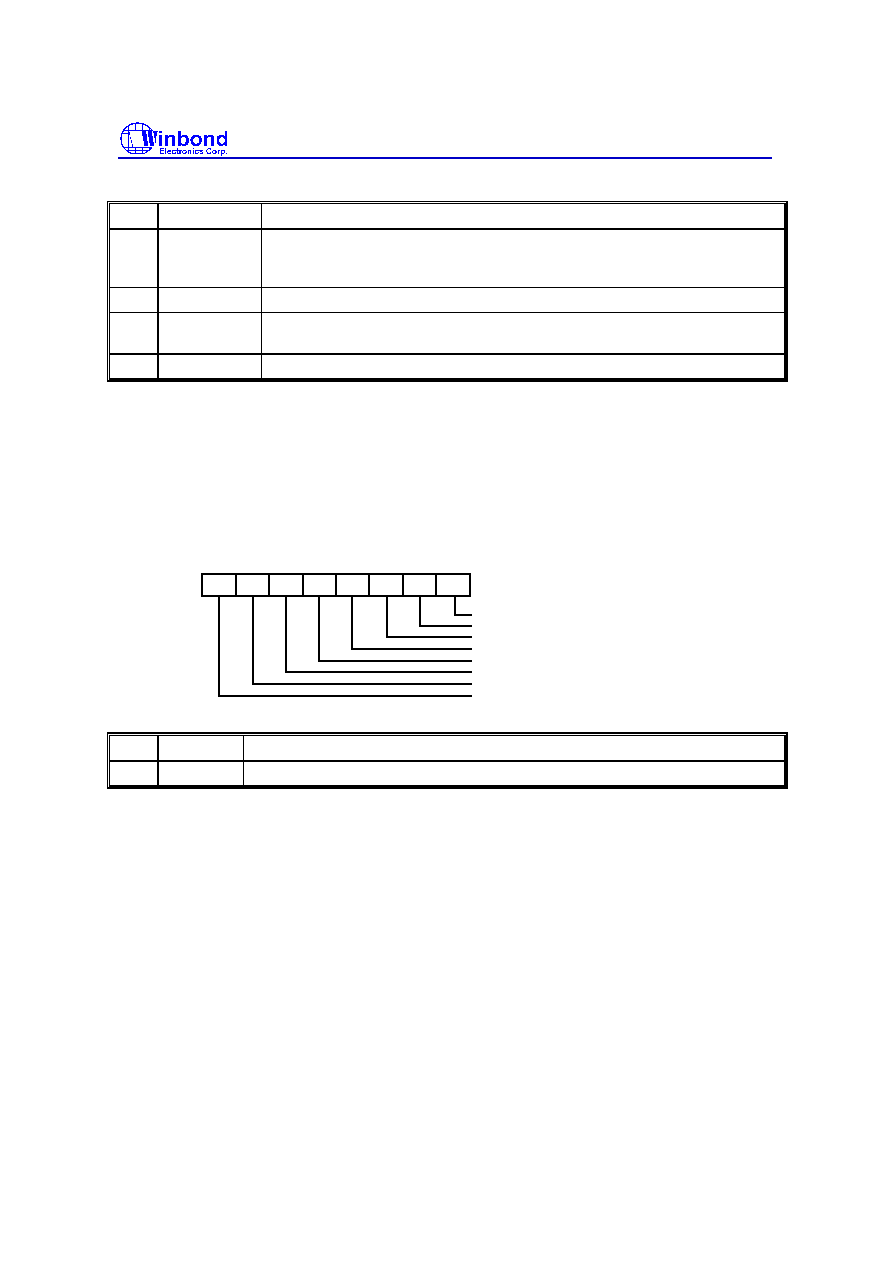
W83877ATF
Publication Release Date: April 1998
- 155 - Version 0.51
Bit
Name
Description
0
TMR_EN
This is the timer carry interrupt enable bit. When this bit is set, an SCI event is
generated anytime the TMR_STS bit is set. When this bit is reset no interrupt
is generated when the TMR_STS bit is set.
1-4
Reserved
Reserved. These bits always return a value of zero.
5
GBL_EN
The global enable bit. When both the GBL_EN bit and the GBL_STS bit are
set, an SCI interrupt is raised.
6-7
Reserved
Reserved.
8.4.4 Power Management 1 Enable Register 2 (PM1EN2)
Register Location: <CR33>+3H System I/O Space
Default Value: 00h
Attribute: Read/write
Size: 8 bits
1
2
3
4
5
6
7
0
Reserved
Reserved
Reserved
Reserved
Reserved
Reserved
Reserved
Reserved
Bit
Name
Description
0-7
Reserved
Reserved. These bits always return a value of zero.
8.4.5 Power Management 1 Control Register 1 (PM1CTL1)
Register Location: <CR33>+4H System I/O Space
Default Value: 00h
Attribute: Read/write
Size: 8 bits
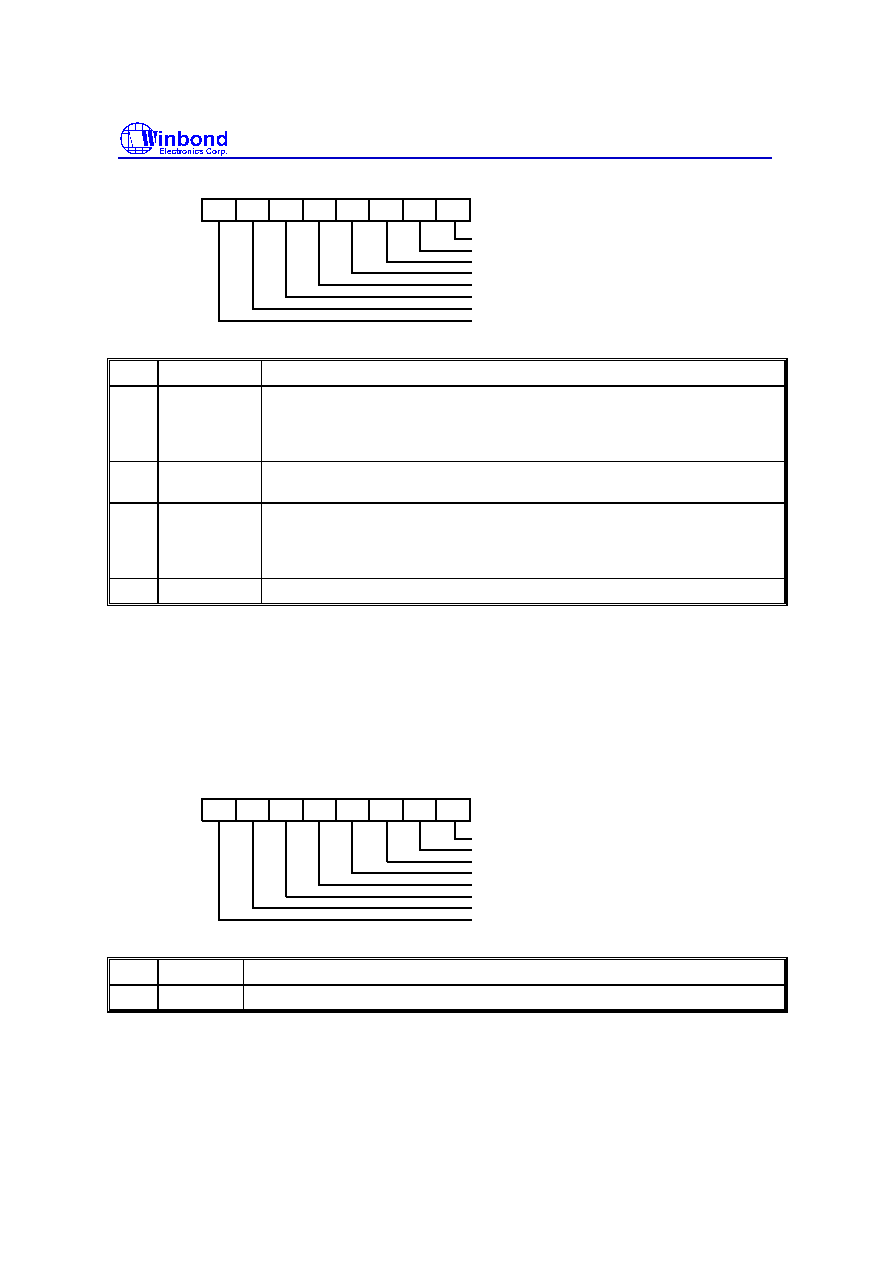
W83877ATF
Publication Release Date: April 1998
- 156 - Version 0.51
1
2
3
4
5
6
7
0
SCI_EN
BM_RLD
GBL_RLD
Reserved
Reserved
Reserved
Reserved
Reserved
Bit
Name
Description
0
SCI_EN
Select the power management event to be either an SCI or an SMI interrupt.
When this bit is set, the power management events will generate an SCI
interrupt. When this bit is reset and SMI_EN bit is set, the power management
events will generate an SMI interrupt.
1
BM_RLD
This is the bus master reload enable bit. If this bit is set and BM_CNTRL is
set, an SCI interrupt is raised.
2
GBL_RLS
The global release bit. This bit is used by the ACPI software to raise an event
to the BIOS software. The BIOS software has a corresponding enable and
status bit to control its ability to receive the ACPI event. Setting GBL_RLS
sets BIOS_STS, and it generates an SMI interrupt if BIOS_EN is also set.
3-7
Reserved
Reserved. These bits always return a value of zero.
8.4.6 Power Management 1 Control Register 2 (PM1CTL2)
Register Location: <CR33>+5H System I/O Space
Default Value: 00h
Attribute: Read/write
Size: 8 bits
1
2
3
4
5
6
7
0
Reserved
Reserved
Reserved
Reserved
Reserved
Reserved
Reserved
Reserved
Bit
Name
Description
0-7
Reserved
Reserved. These bits always return a value of zero.
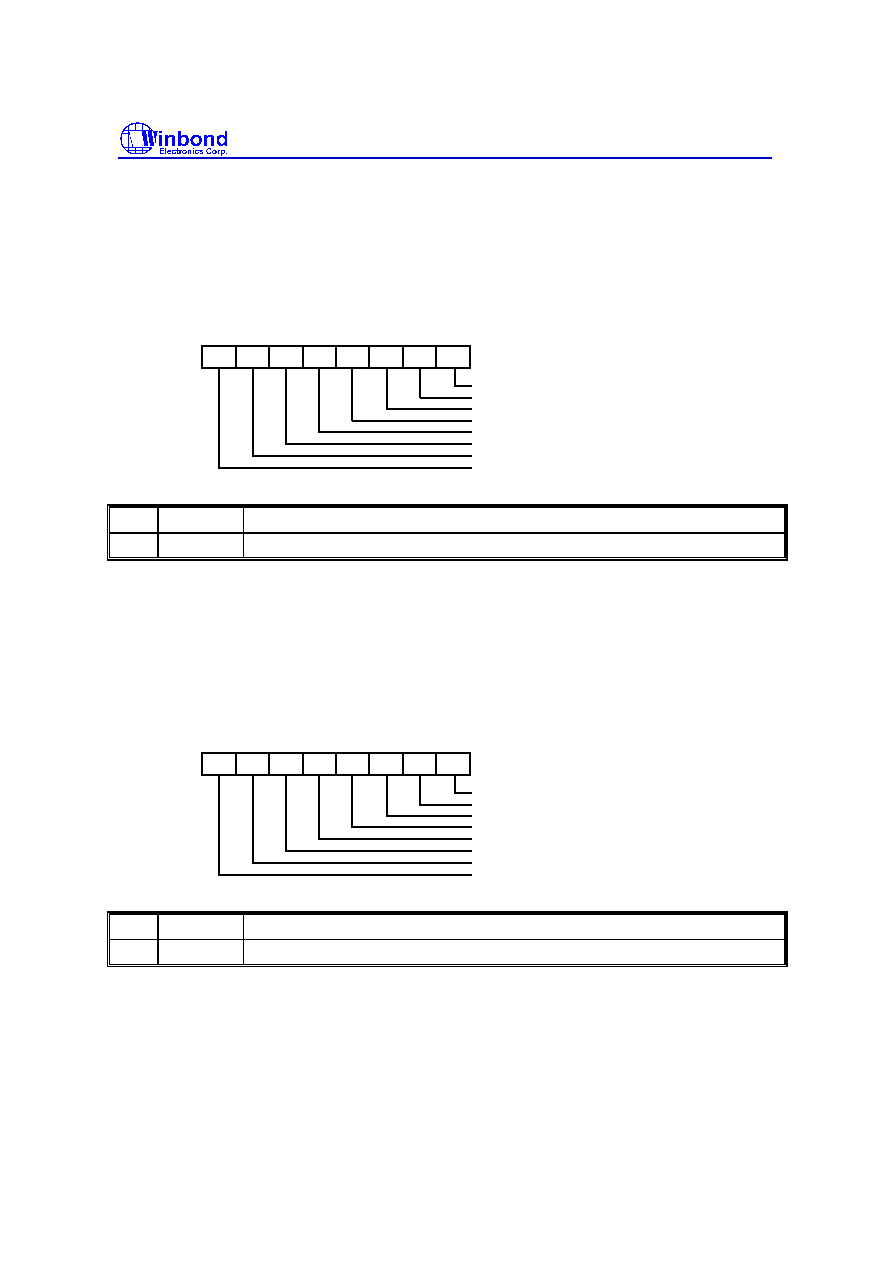
W83877ATF
Publication Release Date: April 1998
- 157 - Version 0.51
8.4.7 Power Management 1 Control Register 3 (PM1CTL3)
Register Location: <CR33>+6H System I/O Space
Default Value: 00h
Attribute: Read/write
Size: 8 bits
1
2
3
4
5
6
7
0
Reserved
Reserved
Reserved
Reserved
Reserved
Reserved
Reserved
Reserved
Bit
Name
Description
0-7
Reserved
Reserved. These bits always return a value of zero.
8.4.8 Power Management 1 Control Register 4 (PM1CTL4)
Register Location: <CR33>+7H System I/O Space
Default Value: 00h
Attribute: Read/write
Size: 8 bits
1
2
3
4
5
6
7
0
Reserved
Reserved
Reserved
Reserved
Reserved
Reserved
Reserved
Reserved
Bit
Name
Description
0-7
Reserved
Reserved. These bits always return a value of zero.
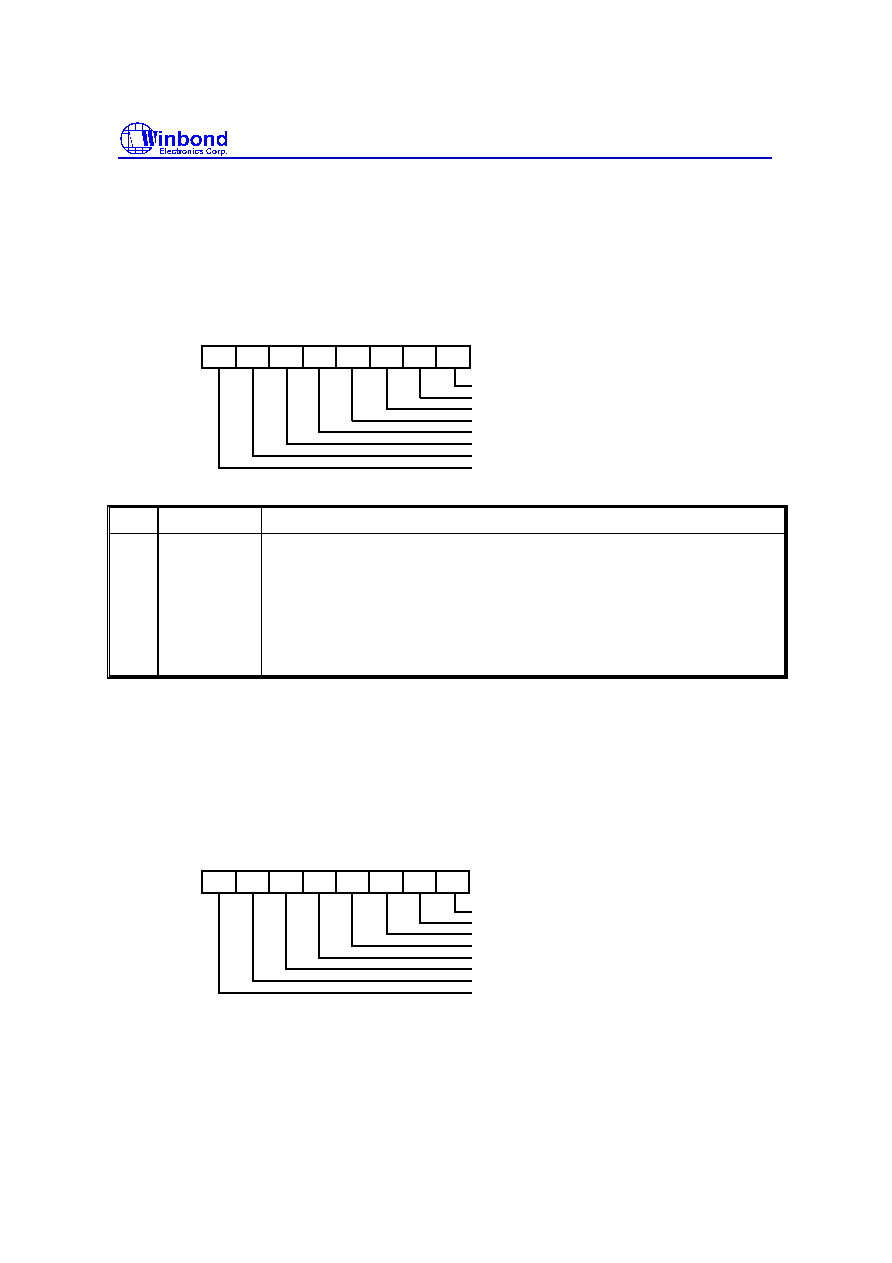
W83877ATF
Publication Release Date: April 1998
- 158 - Version 0.51
8.4.9 Power Management 1 Timer 1 (PM1TMR1)
Register Location: <CR33>+8H System I/O Space
Default Value: 00h
Attribute: Read only
Size: 8 bits
1
2
3
4
5
6
7
0
TMR_VAL0
TMR_VAL1
TMR_VAL2
TMR_VAL3
TMR_VAL4
TMR_VAL5
TMR_VAL6
TMR_VAL7
Bit
Name
Description
0-7
TMR_VAL
This read-only field returns the running count of the power management timer.
This is a 24-bit counter that runs off of a 3.579545 MHZ clock, and counts
while in the system working state. The timer is reset and then continues
counting until the CLKIN input to the chip is stopped. If the clock is restarted
without a MR reset, then the counter will continue counting from where it
stopped. The TMR_STS bit is set any time the last bit of the timer (bit 23)
goes from 0 to 1 or from 1 to 0. If the TMR_EN bit is set, the setting of the
TMR_STS bit will generate an SCI interrupt.
8.4.10 Power Management 1 Timer 2 (PM1TMR2)
Register Location: <CR33>+9H System I/O Space
Default Value: 00h
Attribute: Read only
Size: 8 bits
1
2
3
4
5
6
7
0
TMR_VAL8
TMR_VAL9
TMR_VAL10
TMR_VAL11
TMR_VAL12
TMR_VAL13
TMR_VAL14
TMR_VAL15

W83877ATF
Publication Release Date: April 1998
- 159 - Version 0.51
Bit
Name
Description
0-7
TMR_VAL
This read-only field returns the running count of the power management timer.
This is a 24-bit counter that runs off of a 3.579545 MHZ clock, and counts
while in the system working state. The timer is reset and then continues
counting until the CLKIN input to the chip is stopped. If the clock is restarted
without a MR reset, then the counter will continue counting from where it
stopped. The TMR_STS bit is set any time the last bit of the timer (bit 23)
goes from 0 to 1 or from 1 to 0. If the TMR_EN bit is set, the setting of the
TMR_STS bit will generate an SCI interrupt.
8.4.11 Power Management 1 Timer 3 (PM1TMR3)
Register Location: <CR33>+AH System I/O Space
Default Value: 00h
Attribute: Read only
Size: 8 bits
1
2
3
4
5
6
7
0
TMR_VAL16
TMR_VAL17
TMR_VAL18
TMR_VAL19
TMR_VAL20
TMR_VAL21
TMR_VAL22
TMR_VAL23
Bit
Name
Description
0-7
TMR_VAL
This read-only field returns the running count of the power management timer.
This is a 24-bit counter that runs off of a 3.579545 MHZ clock, and counts
while in the system working state. The timer is reset and then continues
counting until the CLKIN input to the chip is stopped. If the clock is restarted
without a MR reset, then the counter will continue counting from where it
stopped. The TMR_STS bit is set any time the last bit of the timer (bit 23)
goes from 0 to 1 or from 1 to 0. If the TMR_EN bit is set, the setting of the
TMR_STS bit will generate an SCI interrupt.
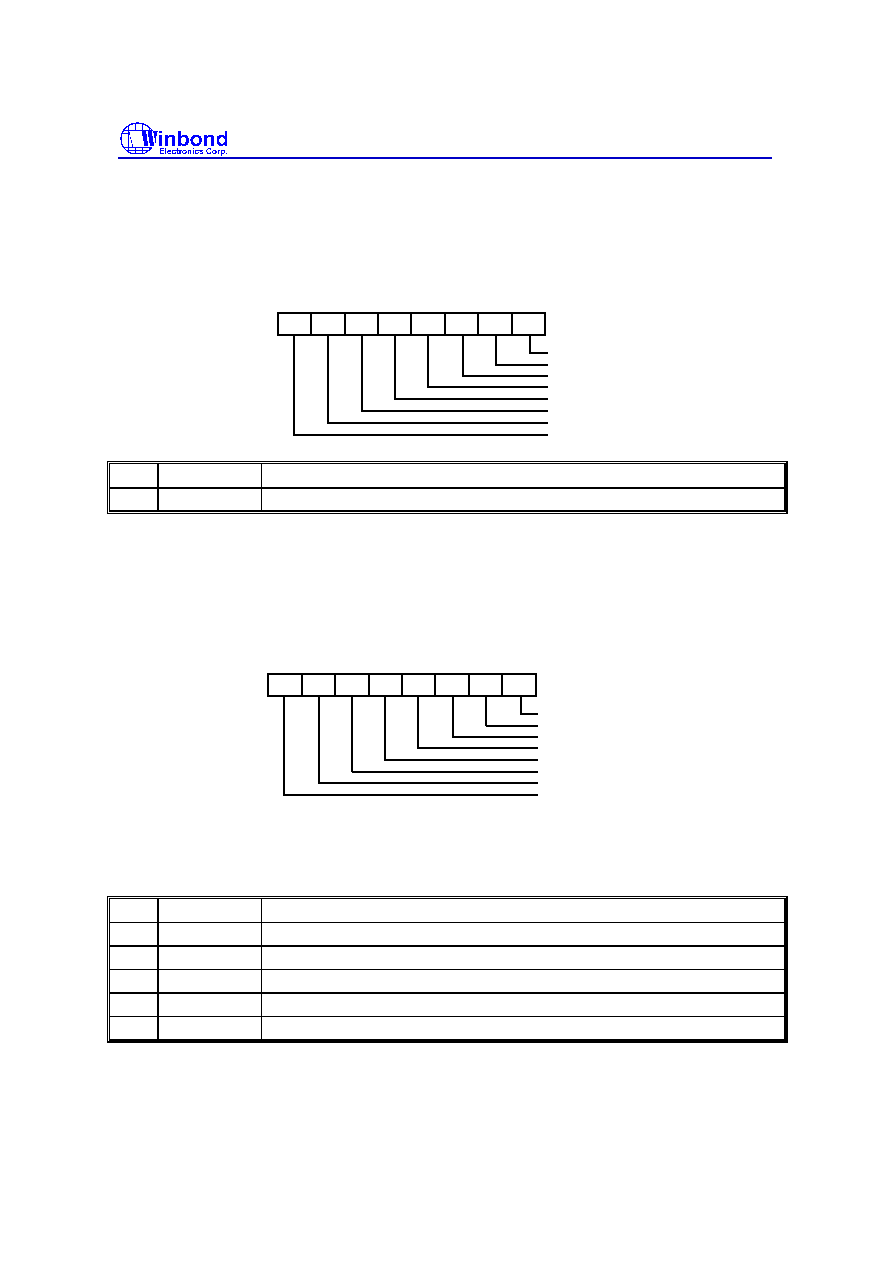
W83877ATF
Publication Release Date: April 1998
- 160 - Version 0.51
8.4.12 Power Management 1 Timer 4 (PM1TMR4)
Register Location: <CR33>+BH System I/O Space
Default Value: 00h
Attribute: Read only
Size: 8 bits
1
2
3
4
5
6
7
0
Reserved
Reserved
Reserved
Reserved
Reserved
Reserved
Reserved
Reserved
Bit
Name
Description
0-7
Reserved
Reserved. These bits always return a value of zero.
8.4.13 General Purpose Event 0 Status Register 1 (GP0STS1)
Register Location: <CR34> System I/O Space
Default Value: 00h
Attribute: Read/write
Size: 8 bits
1
2
3
4
5
6
7
0
URBSCISTS
URASCISTS
FDCSCISTS
PRTSCISTS
Reserved
Reserved
Reserved
Reserved
These bits indicate the status of the SCI input, which is set when the device's IRQ is raised. If the
corresponding enable bit in the SCI interrupt enable register (in GP0EN1) is set, an SCI interrupt is
raised and routed to the output pin. Wrinting a 1 clears the bit, and writing a 0 has no effect. If the bit
is not cleared, new IRQ for the SCI logic input is ignored, therefore no SCI interrupt is raised.
Bit
Name
Description
0
URBSCISTS UART B SCI status, which is set by the UART B IRQ.
1
URASCISTS UART A SCI status, which is set by the UART A IRQ.
2
FDCSCISTS
FDC SCI status, which is set by the FDC IRQ.
3
PRTSCISTS
PRT SCI status, which is set by the printer port IRQ.
4-7
Reserved
Reserved.
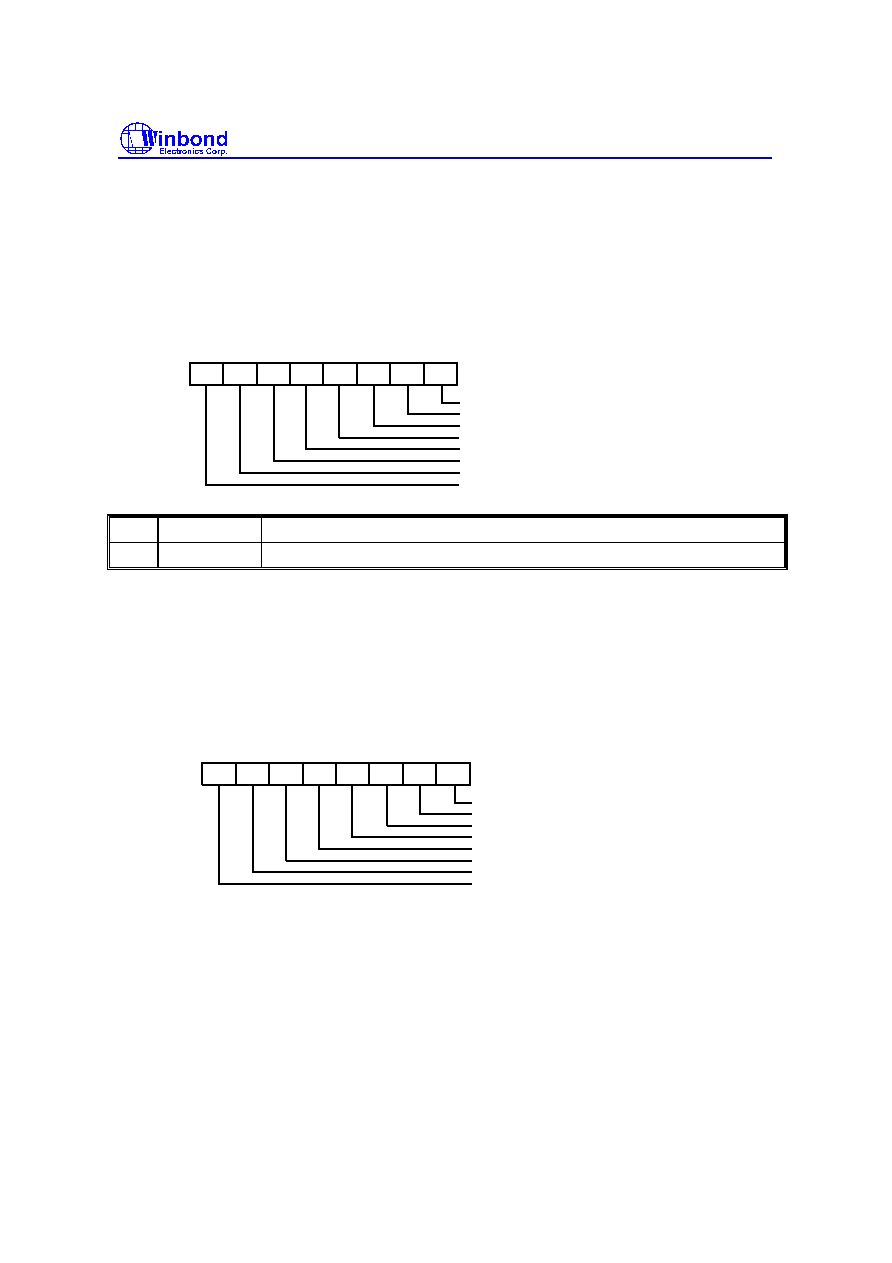
W83877ATF
Publication Release Date: April 1998
- 161 - Version 0.51
8.4.14 General Purpose Event 0 Status Register 2 (GP0STS2)
Register Location: <CR34>+1H System I/O Space
Default Value: 00h
Attribute: Read/write
Size: 8 bits
1
2
3
4
5
6
7
0
Reserved
Reserved
Reserved
Reserved
Reserved
Reserved
Reserved
Reserved
Bit
Name
Description
0-7
Reserved
Reserved. These bits always return a value of zero.
8.4.15 General Purpose Event 0 Enable Register 1 (GP0EN1)
Register Location: <CR34> +2H System I/O Space
Default Value: 00h
Attribute: Read/write
Size: 8 bits
1
2
3
4
5
6
7
0
URBSCIEN
URASCIEN
FDCSCIEN
PRTSCIEN
Reserved
Reserved
Reserved
Reserved
These bits are used to enable the device's IRQ sources onto the SCI logic. The SCI logic output for
the IRQs is as follows:
SCI logic output = (URBSCIEN and URBSCISTS) or (URASCIEN and URASCISTS) or (FDCSCIEN
and FDCSCISTS) or (PRTSCIEN and PRTSCISTS)
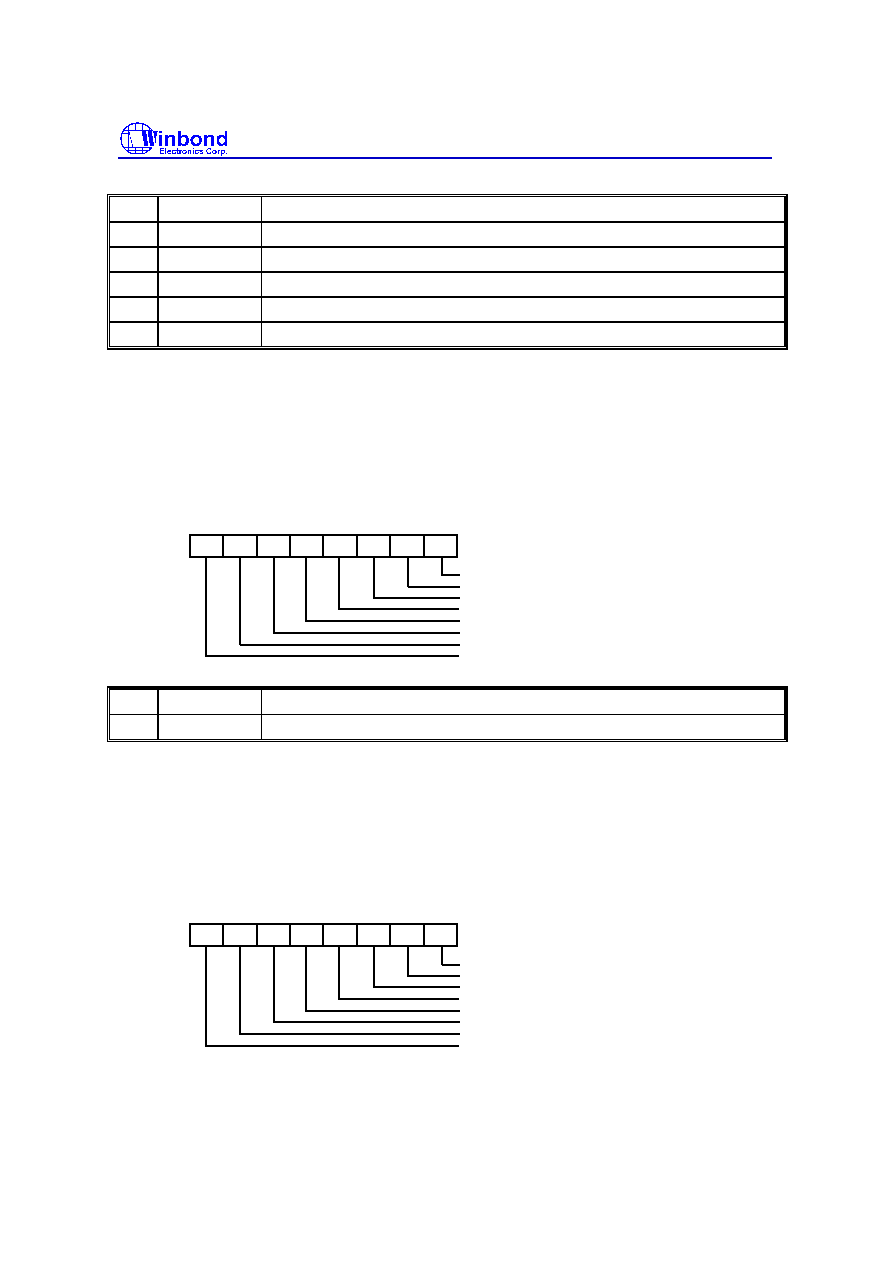
W83877ATF
Publication Release Date: April 1998
- 162 - Version 0.51
Bit
Name
Description
0
URBSCIEN
UART B SCI enable, which controls the UART B IRQ for SCI.
1
URASCIEN
UART A SCI enable, which controls the UART A IRQ for SCI.
2
FDCSCIEN
FDC SCI enable, which controls the FDC IRQ for SCI.
3
PRTSCIEN
Printer port SCI enable, which controls the printer port IRQ for SCI.
4-7
Reserved
Reserved.
8.4.16 General Purpose Event 0 Enable Register 2 (GP0EN2)
Register Location: <CR34>+3H System I/O Space
Default Value: 00h
Attribute: Read/write
Size: 8 bits
1
2
3
4
5
6
7
0
Reserved
Reserved
Reserved
Reserved
Reserved
Reserved
Reserved
Reserved
Bit
Name
Description
0-7
Reserved
Reserved. These bits always return a value of zero.
8.4.17 General Purpose Event 1 Status Register 1 (GP1STS1)
Register Location: <CR34>+4H System I/O Space
Default Value: 00h
Attribute: Read/write
Size: 8 bits
1
2
3
4
5
6
7
0
BIOS_STS
Reserved
Reserved
Reserved
Reserved
Reserved
Reserved
Reserved
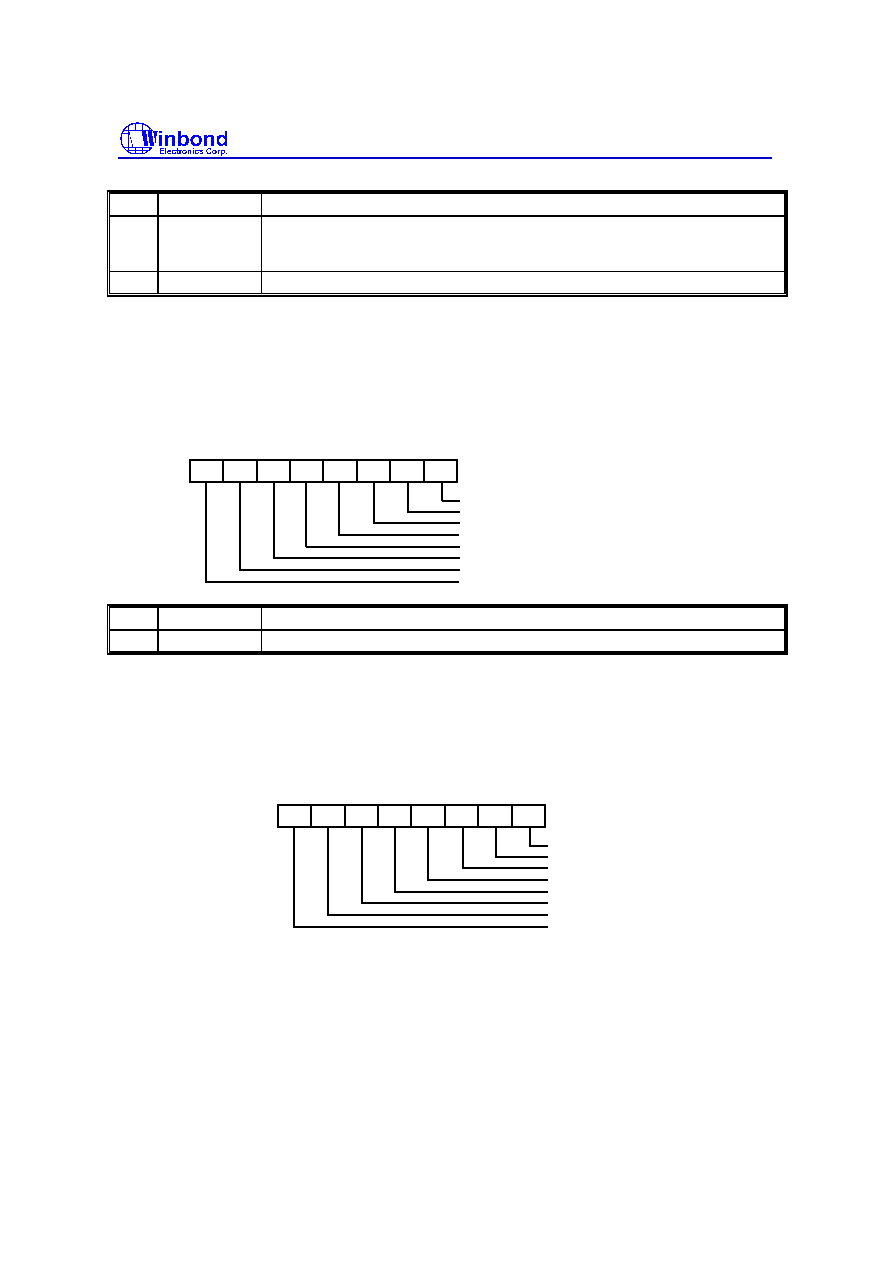
W83877ATF
Publication Release Date: April 1998
- 163 - Version 0.51
Bit
Name
Description
0
BIOS_STS
The BIOS status bit. This bit is set when GBL_RLS is set. If BIOS_EN is set,
setting GBL_RLS will raise an SMI event. Writing a 1 to its bit location clears
BIOS_STS and also clears GBL_RLS. Writing a 0 has no effect.
1-7
Reserved
Reserved.
8.4.18 General Purpose Event 1 Status Register 2 (GP1STS2)
Register Location: <CR34>+5H System I/O Space
Default Value: 00h
Attribute: Read/write
Size: 8 bits
1
2
3
4
5
6
7
0
Reserved
Reserved
Reserved
Reserved
Reserved
Reserved
Reserved
Reserved
Bit
Name
Description
0-7
Reserved
Reserved. These bits always return a value of zero.
8.4.19 General Purpose Event 1 Enable Register 1 (GP1EN1)
Register Location: <CR34>+6H System I/O Space
Default Value: 00h
Attribute: Read/write
Size: 8 bits
1
2
3
4
5
6
7
0
BIOS_EN
TMR_ON
Reserved
Reserved
Reserved
Reserved
Reserved
Reserved
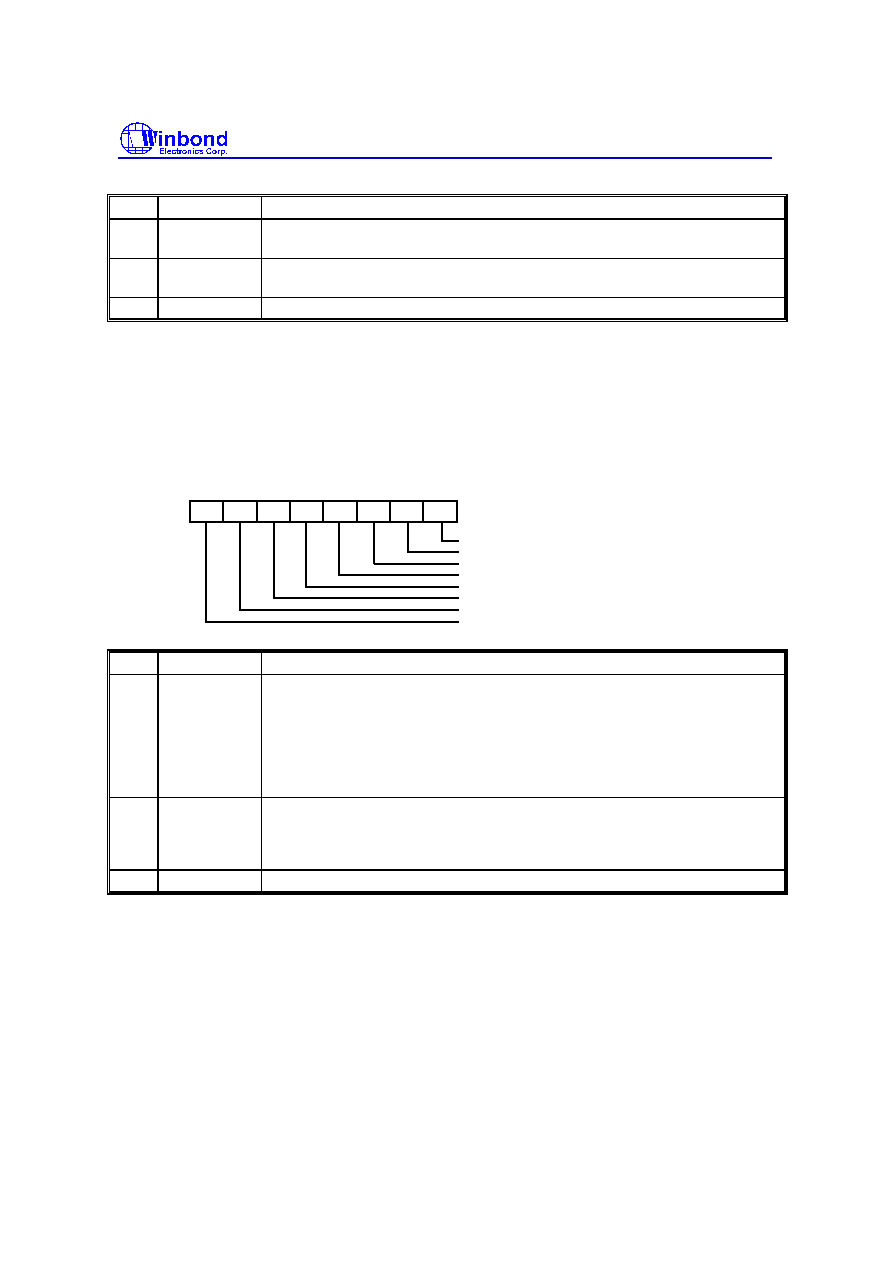
W83877ATF
Publication Release Date: April 1998
- 164 - Version 0.51
Bit
Name
Description
0
BIOS_EN
This bit raise the SMI event. When this bit is set and the ACPI software writes
a 1 to the GBL_RLS bit, an SMI event is raised on the SMI logic output.
1
TMR_ON
This bit is used to turn on the power management timer. 1: timer on ; 0: timer
off.
2-7
Reserved
Reserved.
8.4.20 General Purpose Event 1 Enable Register 2 (GP1EN2)
Register Location: <CR34>+7H System I/O Space
Default Value: 00h
Attribute: Read/write
Size: 8 bits
1
2
3
4
5
6
7
0
BIOS_RLS
BM_CNTRL
Reserved
Reserved
Reserved
Reserved
Reserved
Reserved
Bit
Name
Description
0
BIOS_RLS
The BIOS release bit. This bit is used by the BIOS software to raise an event
to the ACPI software. The ACPI software has a corresponding enable and
status bit to control its ability to receive the ACPI event. Setting BIOS_RLS
sets GBL_STS, and it generates an SCI interrupt if GBL_EN is also set.
Writing a 1 to its bit position sets this bit and also sets the BM_STS bit.
Writing a 0 has no effect. This bit is cleared by writing a 1 to the GBL_STS
bit.
1
BM_CNTRL
This bit is used to set the BM_STS bit and if the BM_RLD bit is also set, then
an SCI interrupt is generated. Writing a 1 sets BM_CNTRL to 1 and also sets
BM_STS. Writing a 0 has no effect. Writing a 1 to BM_STS clears BM_STS
and also clears BM_CNTRL.
2-7
Reserved
Reserved.
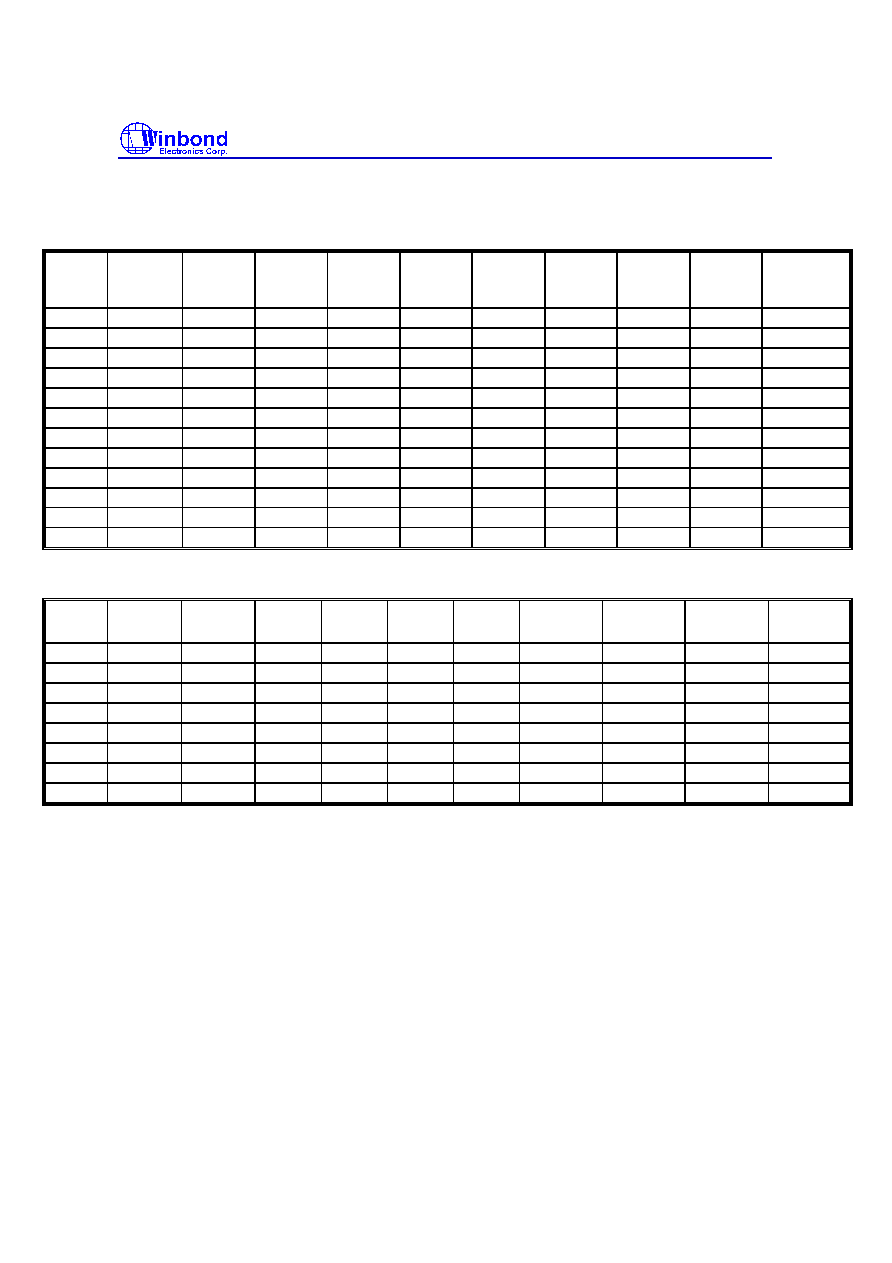
W83877ATF
Publication Release Date: April 1998
- 165 - Version 0.51
8.4.21 Bit Map Configuration Registers
Table 8-4: Bit Map of PM1 Register Block
Register
Address
Power-On
Reset
Value
D7
D6
D5
D4
D3
D2
D1
D0
PM1STS1
<CR33>
0000 0000
0
0
GBL_STS
BM_STS
0
0
0
TMR_STS
PM1STS2
<CR33>+1H
0000 0000
WAK_STS
0
0
0
0
0
0
0
PM1EN1
<CR33>+2H
0000 0000
0
0
GBL_EN
0
0
0
0
TMR_EN
PM1EN2
<CR33>+3H
0000 0000
0
0
0
0
0
0
0
0
PM1CTL1
<CR33>+4H
0000 0000
0
0
0
0
0
GBL_RLS
BM_RLD
SCI_EN
PM1CTL2
<CR33>+5H
0000 0000
0
0
0
0
0
0
0
0
PM1CTL3
<CR33>+6H
0000 0000
0
0
0
0
0
0
0
0
PM1CTL4
<CR33>+7H
0000 0000
0
0
0
0
0
0
0
0
PM1TMR1
<CR33>+8H
0000 0000
TMR_VAL7
TMR_VAL6
TMR_VAL5
TMR_VAL4
TMR_VAL3
TMR_VAL2
TMR_VAL1
TMR_VAL0
PM1TMR2
<CR33>+9H
0000 0000
TMR_VAL15 TMR_VAL14 TMR_VAL13 TMR_VAL12 TMR_VAL11 TMR_VAL10
TMR_VAL9
TMR_VAL8
PM1TMR3
<CR33>+AH
0000 0000
TMR_VAL23 TMR_VAL22 TMR_VAL21 TMR_VAL20 TMR_VAL19 TMR_VAL18 TMR_VAL17
TMR_VAL16
PM1TMR4
<CR33>+BH
0000 0000
0
0
0
0
0
0
0
Table 8-5: Bit Map of GPE Register Block
Register
Address
Power-On
Reset Value
D7
D6
D5
D4
D3
D2
D1
D0
GP0STS1
<CR34>
0000 0000
0
0
0
0
PRTSCISTS
FDCSCISTS
URASCISTS
URBSCISTS
GP0STS2
<CR34>+1H
0000 0000
0
0
0
0
0
0
0
0
GP0EN1
<CR34>+2H
0000 0000
0
0
0
0
PRTSCIEN
FDCSCIEN
URASCIEN
URBSCIEN
GP0EN2
<CR34>+3H
0000 0000
0
0
0
0
0
0
0
0
GP1STS1
<CR34>+4H
0000 0000
0
0
0
0
0
0
0
BIOS_STS
GP1STS2
<CR34>+5H
0000 0000
0
0
0
0
0
0
0
0
GP1EN1
<CR34>+6H
0000 0000
0
0
0
0
0
0
TMR_ON
BIOS_EN
GP1EN2
<CR34>+7H
0000 0000
0
0
0
0
0
0
BM_CNTRL
BIOS_RLS
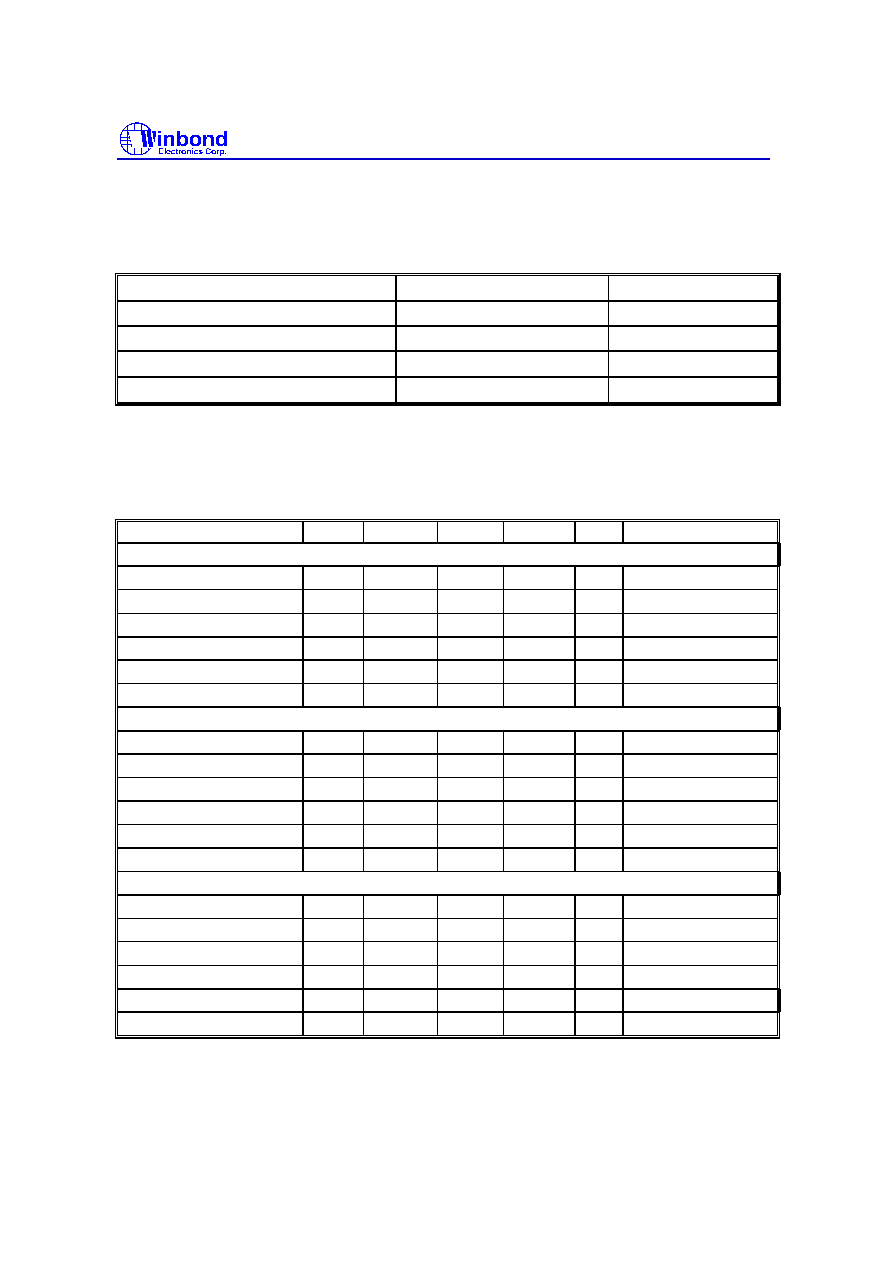
W83877ATF
Publication Release Date: April 1998
- 166 - Version 0.51
9.0 SPECIFICATIONS
9.1 Absolute Maximum Ratings
PARAMETER
RATING
UNIT
Power Supply Voltage
-0.5 to 7.0
V
Input Voltage
-0.5 to V
DD
+0.5
V
Operating Temperature
0 to +70
�
C
Storage Temperature
-55 to +150
�
C
Note: Exposure to conditions beyond those listed under Absolute Maximum Ratings may adversely affect the life and reliability of the
device.
9.2 DC CHARACTERISTICS
(Ta = 0
�
C to 70
�
C, V
DD
= 5V
�
10%, V
SS
= 0V)
PARAMETER
SYM.
MIN.
TYP.
MAX.
UNI
CONDITIONS
I/O
8tc
- TTL level output pin with source-sink capabilities of 8 mA; CMOS level input voltage
Input Low Voltage
V
IL
-0.5
0.3xV
DD
V
Input High Voltage
V
IH
0.7xV
DD
V
DD
+0.5
V
Output Low Voltage
V
OL
0.4
V
I
OL
= 8 mA
Output High Voltage
V
OH
2.4
V
I
OH
= -8 mA
Input High Leakage
I
LIH
+10
�
A
V
IN
= V
DD
Input Low Leakage
I
LIL
-10
�
A
V
IN
= 0V
I/O
12t
- TTL level bi-directional pin with source-sink capabilities of 12 mA
Input Low Voltage
V
IL
-0.5
0.8
V
Input High Voltage
V
IH
2.0
V
DD
+0.5
V
Output Low Voltage
V
OL
0.4
V
I
OL
= 12 mA
Output High Voltage
V
OH
2.4
V
I
OH
= -12 mA
Input High Leakage
I
LIH
+10
�
A
V
IN
= V
DD
Input Low Leakage
I
LIL
-10
�
A
V
IN
= 0V
I/O
24t
- TTL level bi-directional pin with source-sink capabilities of 24 mA
Input Low Voltage
V
IL
-0.5
0.8
V
Input High Voltage
V
IH
2.0
V
DD
+0.5
V
Output Low Voltage
V
OL
0.4
V
I
OL
= 24 mA
Output High Voltage
V
OH
2.4
V
I
OH
= -24 mA
Input High Leakage
I
LIH
+10
�
A
V
IN
= V
DD
Input Low Leakage
I
LIL
-10
�
A
V
IN
= 0V

W83877ATF
Publication Release Date: April 1998
- 167 - Version 0.51
9.2 DC Characteristics, continued
PARAMETER
SYM.
MIN.
TYP.
MAX.
UNIT
CONDITIONS
OUT
8t
- TTL level output pin with source-sink capabilities of 8 mA
Output Low Voltage
V
OL
0.4
V
I
OL
= 8 mA
Output High Voltage
V
OH
2.4
V
I
OH
= -8 mA
OUT
12t
- TTL level output pin with source-sink capabilities of 12 mA
Output Low Voltage
V
OL
0.4
V
I
OL
= 12 mA
Output High Voltage
V
OH
2.4
V
I
OH
= -12 mA
OD
12
- Open-drain output pin with sink capabilities of 12 mA
Output Low Voltage
V
OL
0.4
V
I
OL
= 12 mA
OD
24
- Open-drain output pin with sink capabilities of 24 mA
Output Low Voltage
V
OL
0.4
V
I
OL
= 24 mA
IN
t
- TTL level input pin
Input Low Voltage
V
IL
0.8
V
V
DD
= 5 V
Input High Voltage
V
IH
2.0
V
V
DD
= 5 V
Input High Leakage
I
LIH
+10
�
A
V
IN
= V
DD
Input Low Leakage
I
LIL
-10
�
A
V
IN
= 0V
IN
ts
- TTL level input pin Schmitt-trigger input pin
Input Low Threshold Voltage
V
t-
0.5
0.8
1.1
V
V
DD
= 5 V
Input High Threshold Voltage
V
t+
1.6
2.0
2.4
V
V
DD
= 5 V
Hysteresis (V
t+
- V
t-
)
V
TH
0.5
1.2
V
V
DD
= 5 V
Input High Leakage
I
LIH
+10
�
A
V
IN
= V
DD
Input Low Leakage
I
LIL
-10
�
A
V
IN
= 0V
IN
c
- CMOS level input pin
Input Low Voltage
V
IL
0.3xV
DD
V
V
DD
= 5 V
Input High Voltage
V
IH
0.7xV
DD
V
V
DD
= 5 V
Input High Leakage
I
LIH
+10
�
A
V
IN
= V
DD
Input Low Leakage
I
LIL
-10
�
A
V
IN
= 0V
IN
cs
- CMOS level schmitt-triggered input pin
Input Low Threshold Voltage
V
t-
1.3
1.5
1.7
V
V
DD
= 5 V
Input High Threshold Voltage
V
t+
3..2
3.5
3.8
V
V
DD
= 5 V
Hysteresis (V
t+
- V
t-
)
V
TH
1.5
2
V
V
DD
= 5 V
Input High Leakage
I
LIH
+10
�
A
V
IN
= V
DD
Input Low Leakage
I
LIL
-10
�
A
V
IN
= 0V
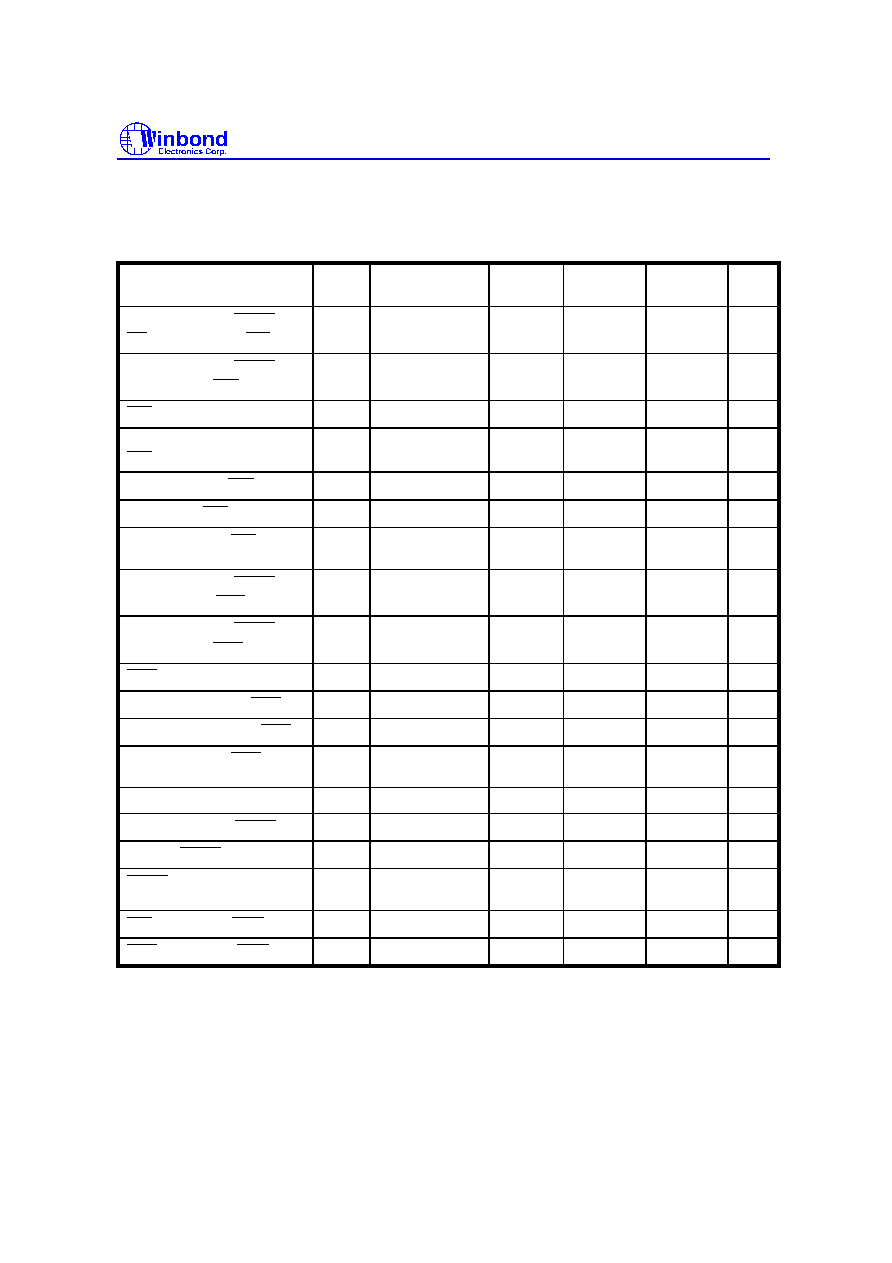
W83877ATF
Publication Release Date: April 1998
- 168 - Version 0.51
9.3
AC Characteristics
FDC: Data rate = 1 MB/500 KB/300 KB/250 KB/sec.
PARAMETER
SYM.
TEST
CONDITIONS
MIN.
TYP.
(NOTE 1)
MAX.
UNIT
SA9-SA0, AEN, DACK ,
CS, setup time to IOR
��
T
AR
25
nS
SA9-SA0, AEN, DACK ,
hold time for IOR
��
T
AR
0
nS
IOR width
T
RR
80
nS
Data access time from
IOR
��
T
FD
CL = 100 pf
80
nS
Data hold from IOR
��
T
DH
CL = 100 pf
10
nS
SD to from IOR
��
T
DF
CL = 100 pf
10
50
nS
IRQ delay from IOR
��
T
RI
360/570
/675
nS
SA9-SA0, AEN, DACK ,
setup time to IOW
��
T
AW
25
nS
SA9-SA0, AEN, DACK ,
hold time for IOW
��
T
WA
0
nS
IOW width
T
WW
60
nS
Data setup time to IOW
��
T
DW
60
nS
Data hold time from IOW
��
T
WD
0
nS
IRQ delay from IOW
��
T
WI
360/570
/675
nS
DRQ cycle time
T
MCY
27
�
S
DRQ delay time DACK
��
T
AM
50
nS
DRQ to DACK delay
T
MA
0
nS
DACK width
T
AA
260/430
/510
nS
IOR delay from DRQ
T
MR
0
nS
IOW delay from DRQ
T
MW
0
nS

W83877ATF
Publication Release Date: April 1998
- 169 - Version 0.51
9.3.1 AC Characteristics, FDC continued
PARAMETER
SYM.
TEST
CONDITIONS
MIN.
TYP.
(NOTE 1)
MAX.
UNIT
IOW or IOR response time
from DRQ
T
MRW
6/12
/20/24
�
S
TC width
T
TC
135/220
/260
nS
RESET width
T
RST
1.8/3/3.
5
�
S
INDEX width
T
IDX
0.5/0.9
/1.0
�
S
DIR setup time to STEP
T
DST
1.0/1.6
/2.0
�
S
DIR hold time from STEP
T
STD
24/40/48
�
S
STEP pulse width
T
STP
6.8/11.5
/13.8
7/11.7
/14
7.2/11.9
/14.2
�
S
STEP cycle width
T
SC
Note 2
Note 2
Note 2
�
S
WD pulse width
T
WDD
100/185
/225
125/210
/250
150/235
/275
�
S
Write precompensation
T
WPC
100/138
/225
125/210
/250
150/235
/275
�
S
Notes:
1. Typical values for T = 25
�
C and normal supply voltage.
2. Programmable from 2 mS through 32 mS in 2 mS increments.
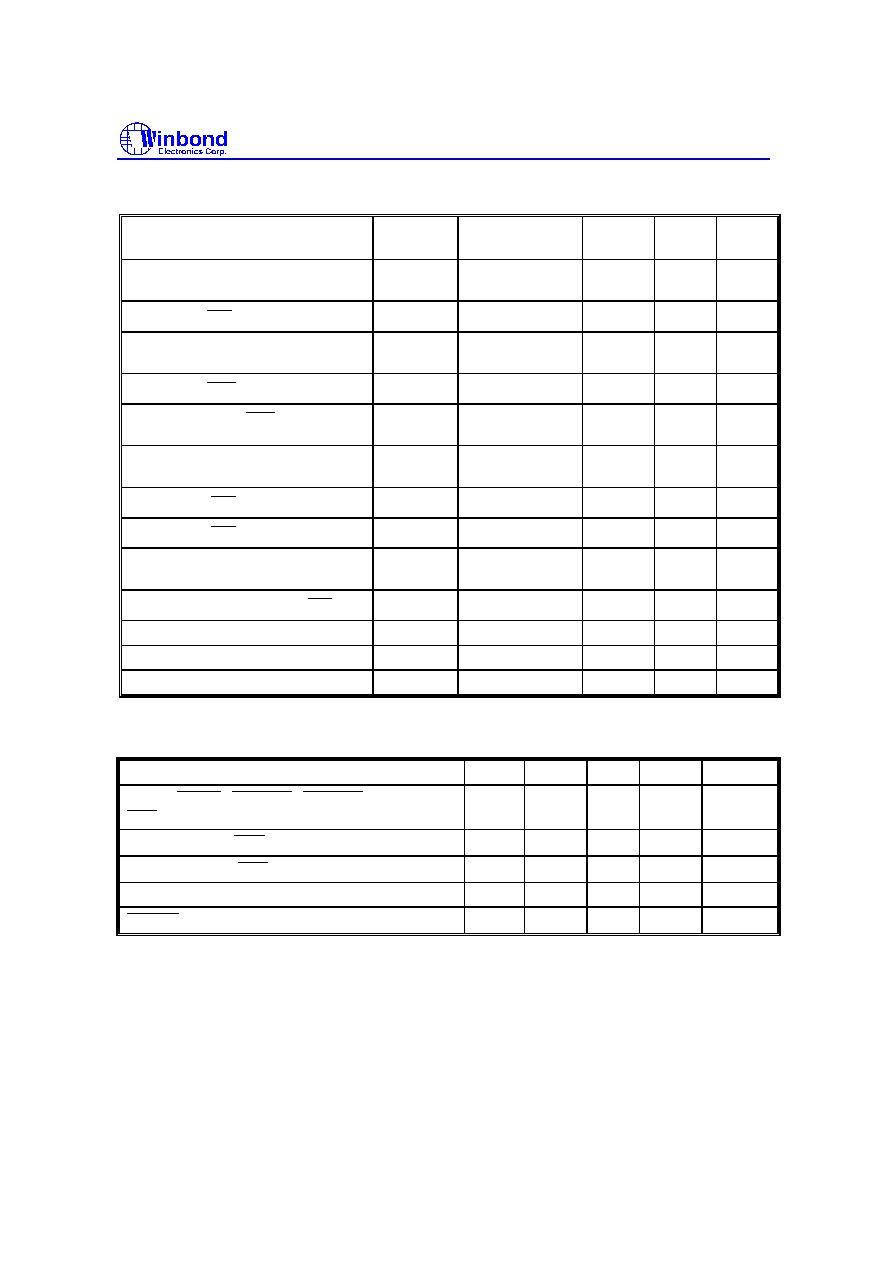
W83877ATF
Publication Release Date: April 1998
- 170 - Version 0.51
UART/Parallel Port
PARAMETER
SYMBOL
TEST
CONDITIONS
MIN.
MAX.
UNIT
Delay from Stop to Set Interrupt
T
SINT
9/16
Baud
Rate
Delay from IOR Reset Interrupt
T
RINT
100 pF Loading
1
�
S
Delay from Initial IRQ Reset to
Transmit Start
T
IRS
1/16
8/16
Baud
Rate
Delay from IOW to Reset Interrupt
T
HR
100 pF Loading
175
nS
Delay from Initial IOW to Interrupt
T
SI
9/16
16/16
Baud
Rate
Delay from Stop to Set Interrupt
T
STI
1/2
Baud
Rate
Delay from IOR to Reset Interrupt
T
IR
100 pF Loading
250
nS
Delay from IOR to Output
T
MWO
100 pF Loading
200
nS
Set Interrupt Delay from Modem
Input
T
SIM
250
nS
Reset Interrupt Delay from IOR
T
RIM
250
nS
Interrupt Active Delay
T
IAD
100 pF Loading
25
nS
Interrupt Inactive Delay
T
IID
100 pF Loading
30
nS
Baud Divisor
N
100 pF Loading
2
16
-1
Parallel Port Mode Parameters
PARAMETER
SYM.
MIN. TYP. MAX.
UNIT
PD0-7, INDEX, STROBE , AUTOFD Delay from
IOW
t1
100
nS
IRQ Delay from ACK , nFAULT
t2
60
nS
IRQ Delay from IOW
t3
105
nS
IRQ Active Low in ECP and EPP Modes
t4
200
300
nS
ERROR Active to IRQ Active
t5
105
nS
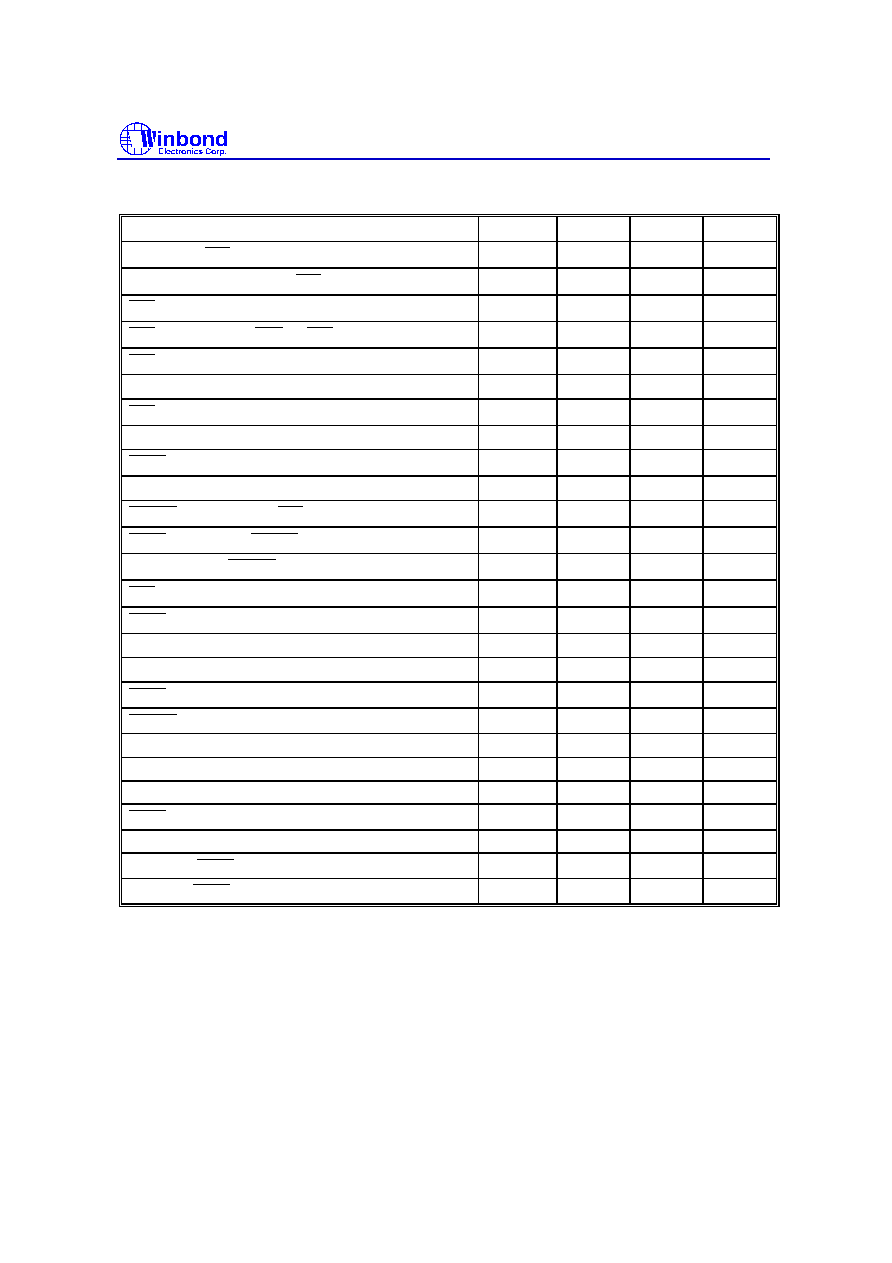
W83877ATF
Publication Release Date: April 1998
- 171 - Version 0.51
EPP Data or Address Read Cycle Timing Parameters
PARAMETER
SYM.
MIN.
MAX.
UNIT
Ax Valid to IOR Asserted
t1
40
nS
IOCHRDY Deasserted to IOR Deasserted
t2
0
nS
IOR Deasserted to Ax Valid
t3
10
10
nS
IOR Deasserted to IOW or IOR Asserted
t4
40
IOR Asserted to IOCHRDY Asserted
t5
0
24
nS
PD Valid to SD Valid
t6
0
75
nS
IOR Deasserted to SD Hi-Z (Hold Time)
t7
0
40
�
S
SD Valid to IOCHRDY Deasserted
t8
0
85
nS
WAIT Deasserted to IOCHRDY Deasserted
t9
60
160
nS
PD Hi-Z to PDBIR Set
t10
0
nS
WRITE Deasserted to IOR Asserted
t13
0
nS
WAIT Asserted to WRITE Deasserted
t14
0
185
nS
Deasserted to WRITE Modified
t15
60
190
nS
IOR Asserted to PD Hi-Z
t16
0
50
nS
WAIT Asserted to PD Hi-Z
t17
60
180
nS
Command Asserted to PD Valid
t18
0
nS
Command Deasserted to PD Hi-Z
t19
0
nS
WAIT
Deasserted to PD Drive
t20
60
190
nS
WRITE
Deasserted to Command
t21
1
nS
PBDIR Set to Command
t22
0
20
nS
PD Hi-Z to Command Asserted
t23
0
30
nS
Asserted to Command Asserted
t24
0
195
nS
WAIT
Deasserted to Command Deasserted
t25
60
180
nS
Time out
t26
10
12
nS
PD Valid to
WAIT
Deasserted
t27
0
nS
PD Hi-Z to
WAIT
Deasserted
t28
0
�
S
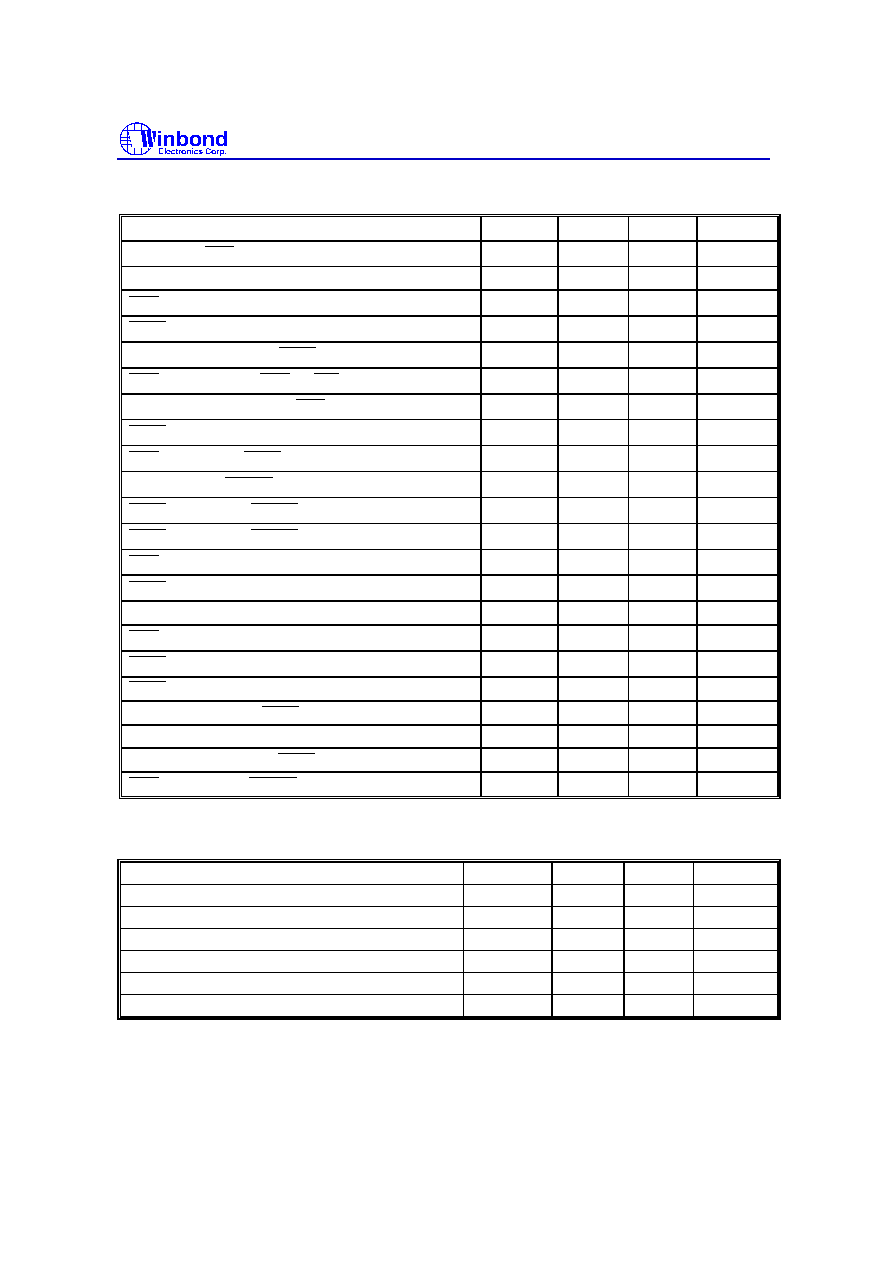
W83877ATF
Publication Release Date: April 1998
- 172 - Version 0.51
EPP Data or Address Write Cycle Timing Parameters
PARAMETER
SYM.
MIN.
MAX.
UNIT
Ax Valid to IOW Asserted
t1
40
nS
SD Valid to Asserted
t2
10
nS
IOW Deasserted to Ax Invalid
t3
10
nS
WAIT Deasserted to IOCHRDY Deasserted
t4
0
nS
Command Asserted to WAIT Deasserted
t5
10
nS
IOW Deasserted to IOW or IOR Asserted
t6
40
nS
IOCHRDY Deasserted to IOW Deasserted
t7
0
24
nS
WAIT Asserted to Command Asserted
t8
60
160
nS
IOW Asserted to WAIT Asserted
t9
0
70
nS
PBDIR Low to WRITE Asserted
t10
0
nS
WAIT Asserted to WRITE Asserted
t11
60
185
nS
WAIT Asserted to WRITE Change
t12
60
185
nS
IOW Asserted to PD Valid
t13
0
50
nS
WAIT Asserted to PD Invalid
t14
0
nS
PD Invalid to Command Asserted
t15
10
nS
IOW to Command Asserted
t16
5
35
nS
WAIT Asserted to Command Asserted
t17
60
210
nS
WAIT
Deasserted to Command Deasserted
t18
60
190
nS
Command Asserted to
WAIT
Deasserted
t19
0
10
�
S
Time out
t20
10
12
�
S
Command Deasserted to
WAIT
Asserted
t21
0
nS
IOW
Deasserted to
WRITE
Deasserted and PD invalid
t22
0
nS
Parallel Port FIFO Timing Parameters
PARAMETER
SYMBOL
MIN.
MAX.
UNIT
DATA Valid to nSTROBE Active
t1
600
nS
nSTROBE Active Pulse Width
t2
600
nS
DATA Hold from nSTROBE Inactive
t3
450
nS
BUSY Inactive to PD Inactive
t4
80
nS
BUSY Inactive to nSTROBE Active
t5
680
nS
nSTROBE Active to BUSY Active
t6
500
nS
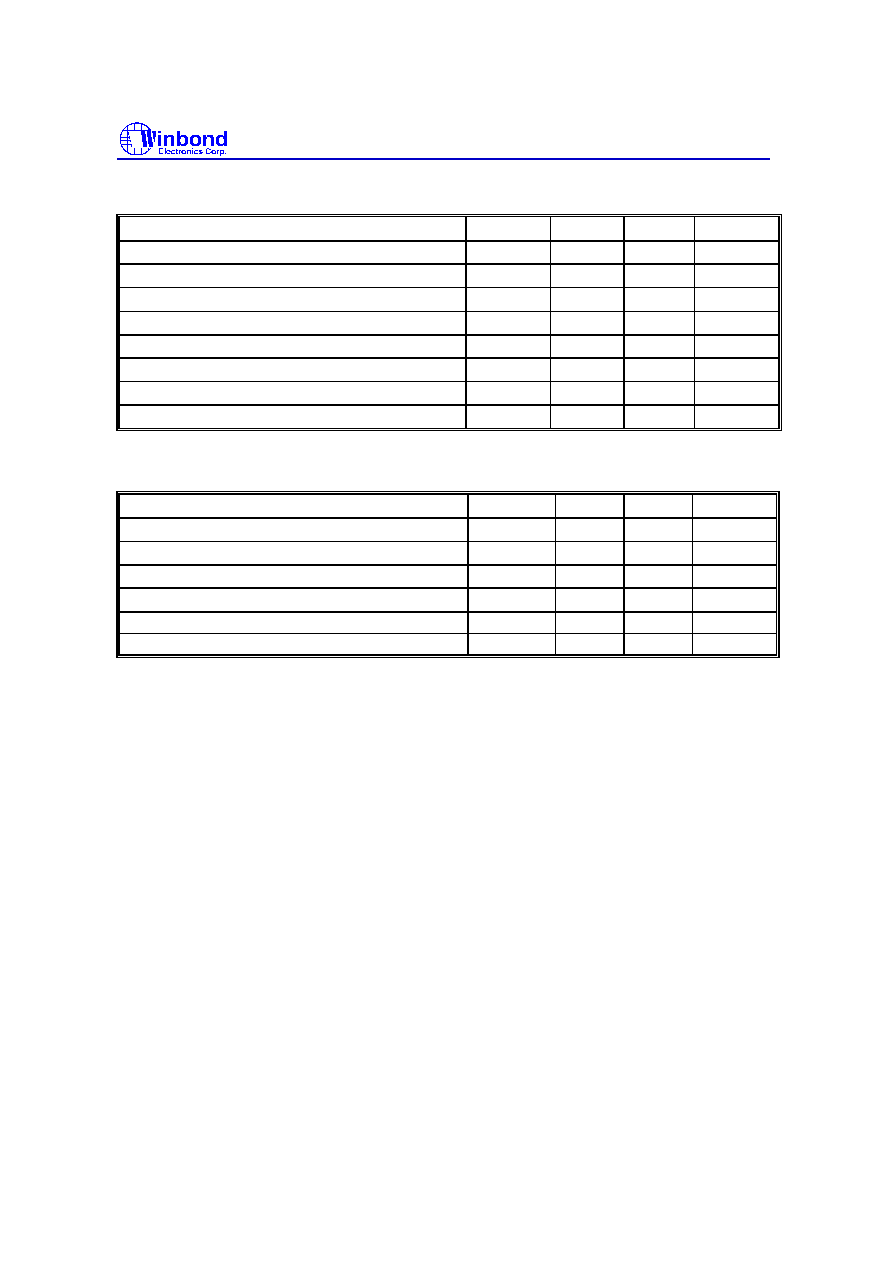
W83877ATF
Publication Release Date: April 1998
- 173 - Version 0.51
ECP Parallel Port Forward Timing Parameters
PARAMETER
SYMBOL
MIN.
MAX.
UNIT
nAUTOFD Valid to nSTROBE Asserted
t1
0
60
nS
PD Valid to nSTROBE Asserted
t2
0
60
nS
BUSY Deasserted to nAUTOFD Changed
t3
80
180
nS
BUSY Deasserted to PD Changed
t4
80
180
nS
nSTROBE Deasserted to BUSY Deasserted
t5
0
nS
BUSY Deasserted to nSTROBE Asserted
t6
80
200
nS
nSTROBE Asserted to BUSY Asserted
t7
0
nS
BUSY Asserted to nSTROBE Deasserted
t8
80
180
nS
ECP Parallel Port Reverse Timing Parameters
PARAMETER
SYMBOL
MIN.
MAX.
UNIT
PD Valid to nACK Asserted
t1
0
nS
nAUTOFD Deasserted to PD Changed
t2
0
nS
nAUTOFD Asserted to nACK Asserted
t3
0
nS
nAUTOFD Deasserted to nACK Deasserted
t4
0
nS
nACK Deasserted to nAUTOFD Asserted
t5
80
200
nS
PD Changed to nAUTOFD Deasserted
t6
80
200
nS
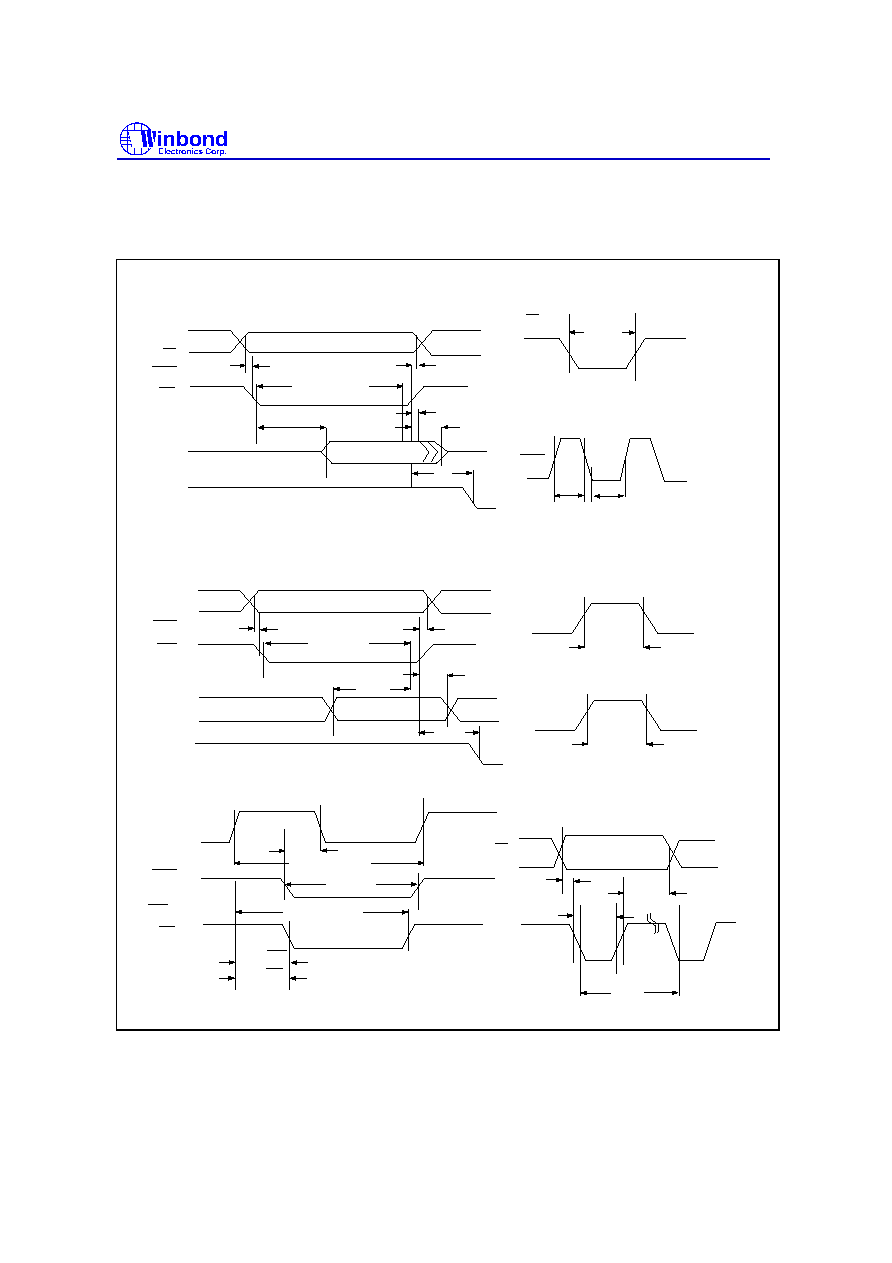
W83877ATF
Publication Release Date: April 1998
- 174 - Version 0.51
10.0 TIMING WAVEFORMS
10.1 FDC
Processor Read Operation
WD
Write Date
AEN
SA0-SA9
CS
TWDD
TAR
TDH
TDF
TRA
Index
TIDX
TIDX
INDEX
TAW
TWD
TWA
Processor Write Operation
Terminal Count
Reset
TTC
TC
TRST
RESET
DMA Operation
IRQ
D0-D7
DACK
IOR
IRQ
D0-D7
AEN
SA0-SA9
DACK
IOW
Drive Seek operation
STEP
DIR
TDST
TSTP
TSTD
TRR
TR
TFD
TSC
TMW (IOW)
TMR (IOR)
TMA
TAM
DRQ
DACK
IOW or
IOR
TMCY
TAA
TMRW
TWW
TWI
TDW
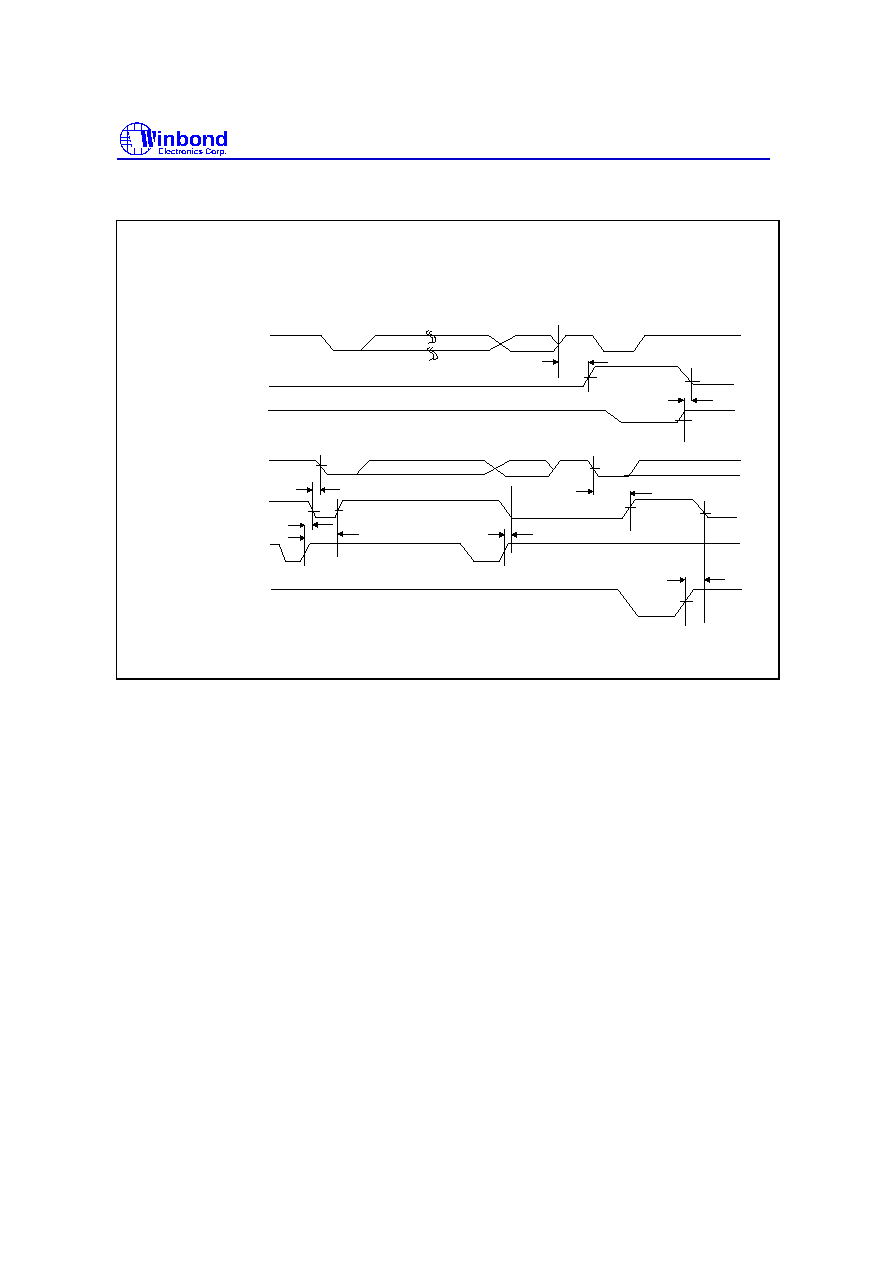
W83877ATF
Publication Release Date: April 1998
- 175 - Version 0.51
10.2 UART/Parallel
TRINT
STAR
DATA BITS (5-8)
PARITY
STOP
TSINT
STAR
PARITY
DATA (5-8)
STOP
(1-2)
STAR
TIR
THR
TSI
THR
THRS
TSTI
SIN
(RECEIVER
INPUT DATA)
IRQ3 or IRQ4
IOR
(READ RECEIVER
BUFFER REGISTER)
SERIAL OUT
(SOUT)
IOW
(WRITE THR)
IRQ3 or IRQ4
IOR
(READ TIR)
Receiver Timing
Transmitter Timing
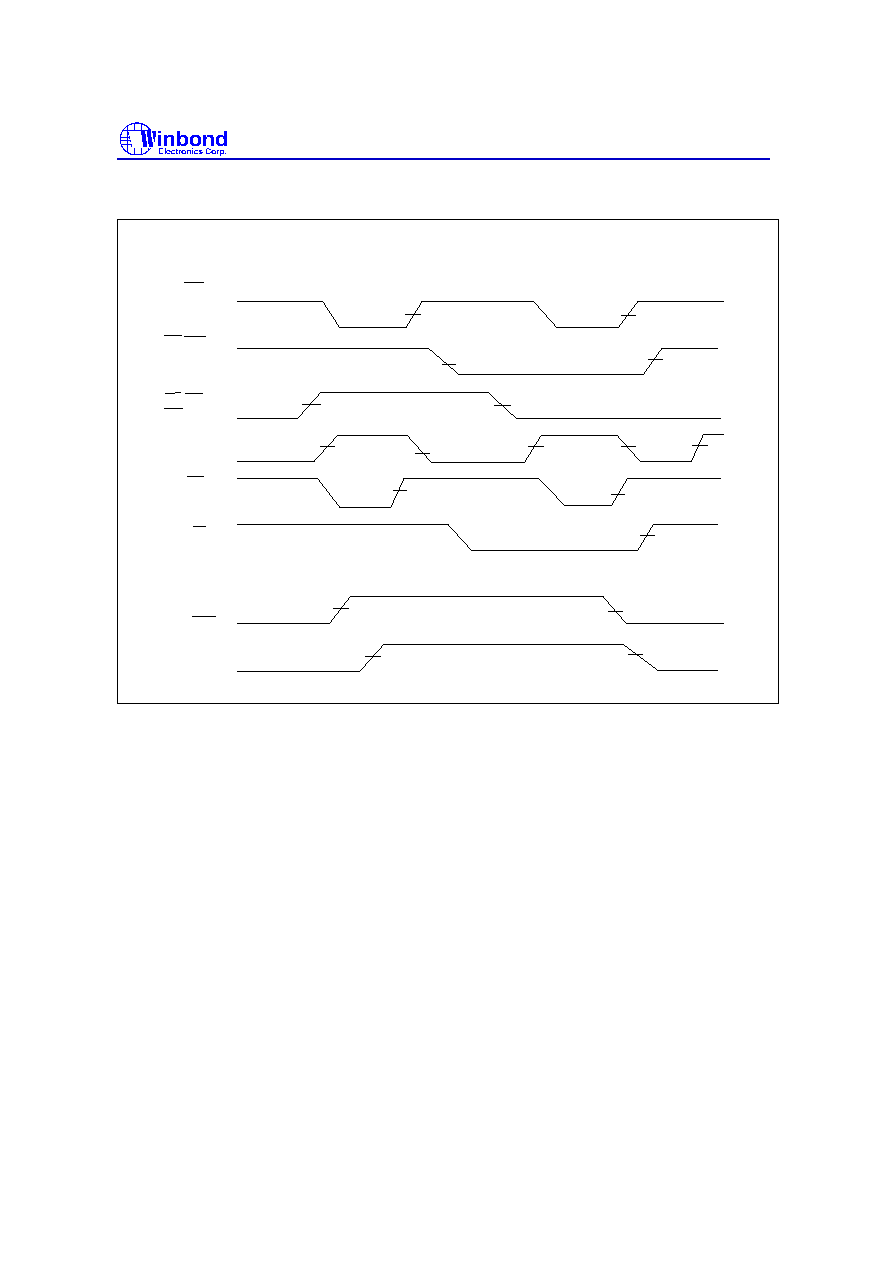
W83877ATF
Publication Release Date: April 1998
- 176 - Version 0.51
Modem Control Timing
ACK
IRQ7
RI
IOR
(READ MSR)
IOW
(WRITE MCR)
RTS,DTR
CTS,DSR
DCD
MODEM Control Timing
�x
�x
�x
�x
�
�x
�x
�x
�x
�
�x
�x
�x
�
�x
�x
�x
�
�x
�
�x
�x
�x
�x
�
�x
�x
�x
�x
�
�x
�x
�x
�
�x
�x
�x
�
�x
�x
�x
�
�x
�x
�x
�
�x
�x
�x
�x
�
�x
�x
�x
�x
�
�x
�x
�x
�x
�
�x
�x
�x
�
�x
�x
�x
�x
�x
�x
�x
�x
�x
�
�x
�x
�x
�
�x
�x
�x
�x
�x
�x
�
�x
�x
�x
�x
�x
�
�x
�x
�x
�x
�x
�
�x
�x
��
��
��
��
TLID
TLAD
Printer Interrupt Timing
��
TSIM
��
��
��
��
��
TMWO
TMWO
��
��
TSIM
��
��
��
��
��
��
TRIM
TRIM
TSIM
IRQ3 or
IRQ4
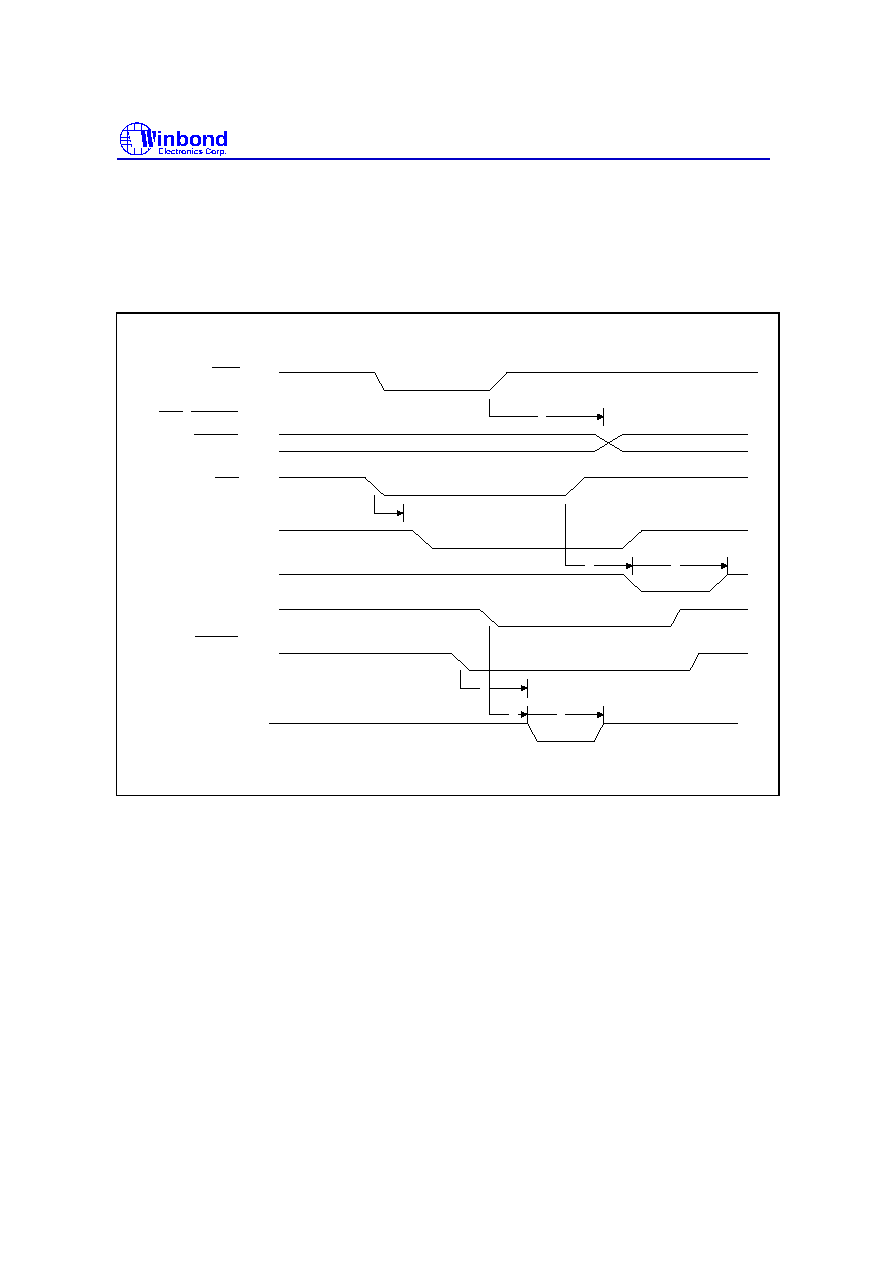
W83877ATF
Publication Release Date: April 1998
- 177 - Version 0.51
10.3 Parallel Port
Parallel Port Timing
IOW
INIT, STROBE
AUTOFD, SLCTIN
ACK
IRQ (SPP)
IRQ
(EPP or ECP)
nFAULT
(ECP)
ERROR
(ECP)
IRQ
t1
t2
t3
t4
t5
t2
t4
PD<0:7>
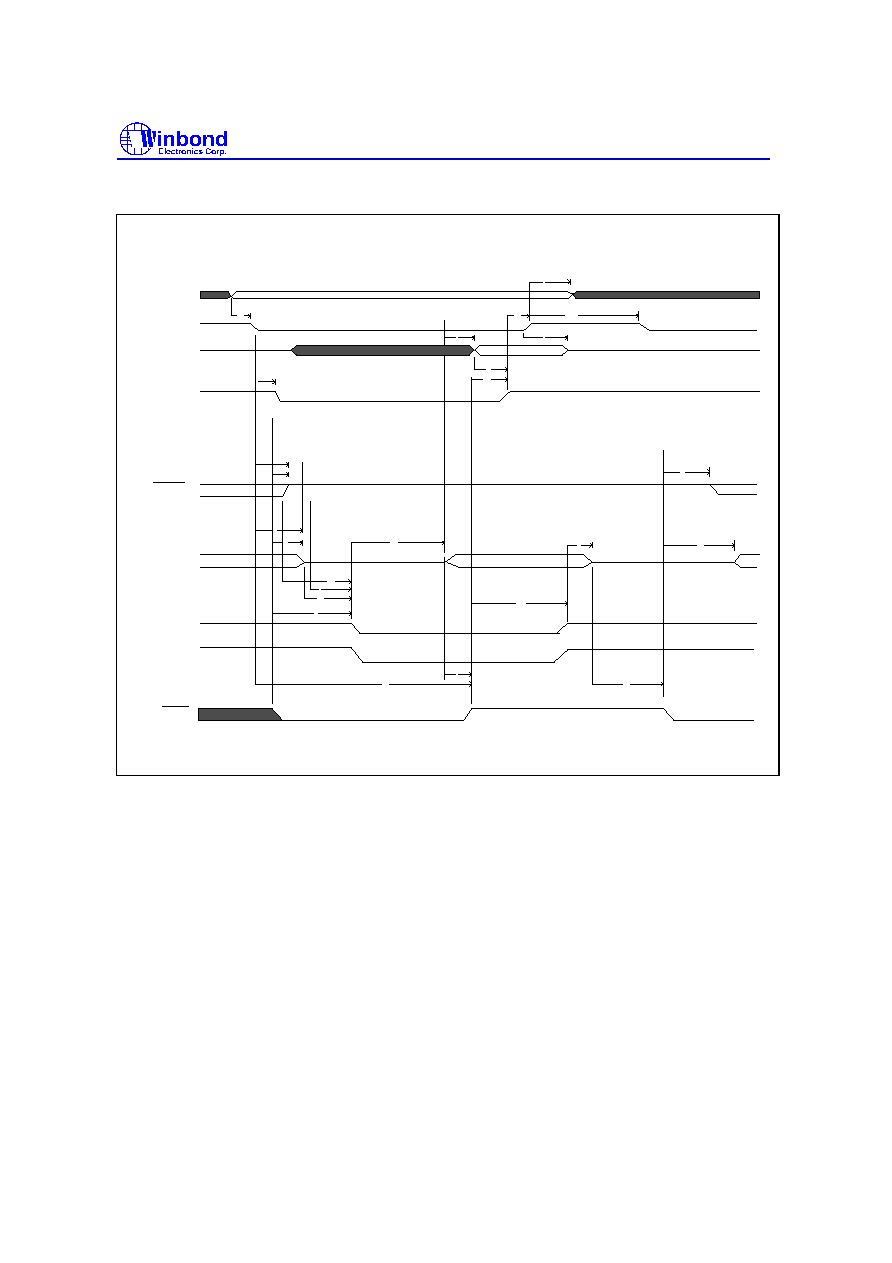
W83877ATF
Publication Release Date: April 1998
- 178 - Version 0.51
EPP Data or Address Read Cycle (EPP Version 1.9)
WRITE
DATASTB
t13
t16
t14
t17
t22
t18
t23
t24
t21
t25
t19
t15
t20
ADDRSTB
WAIT
t26
t27
t28
PD<0:7>
t1
IOCHRDY
t3
t2
t4
t10
IOR
t5
t6
t7
t8
t9
SD<0:7>
A<0:10>
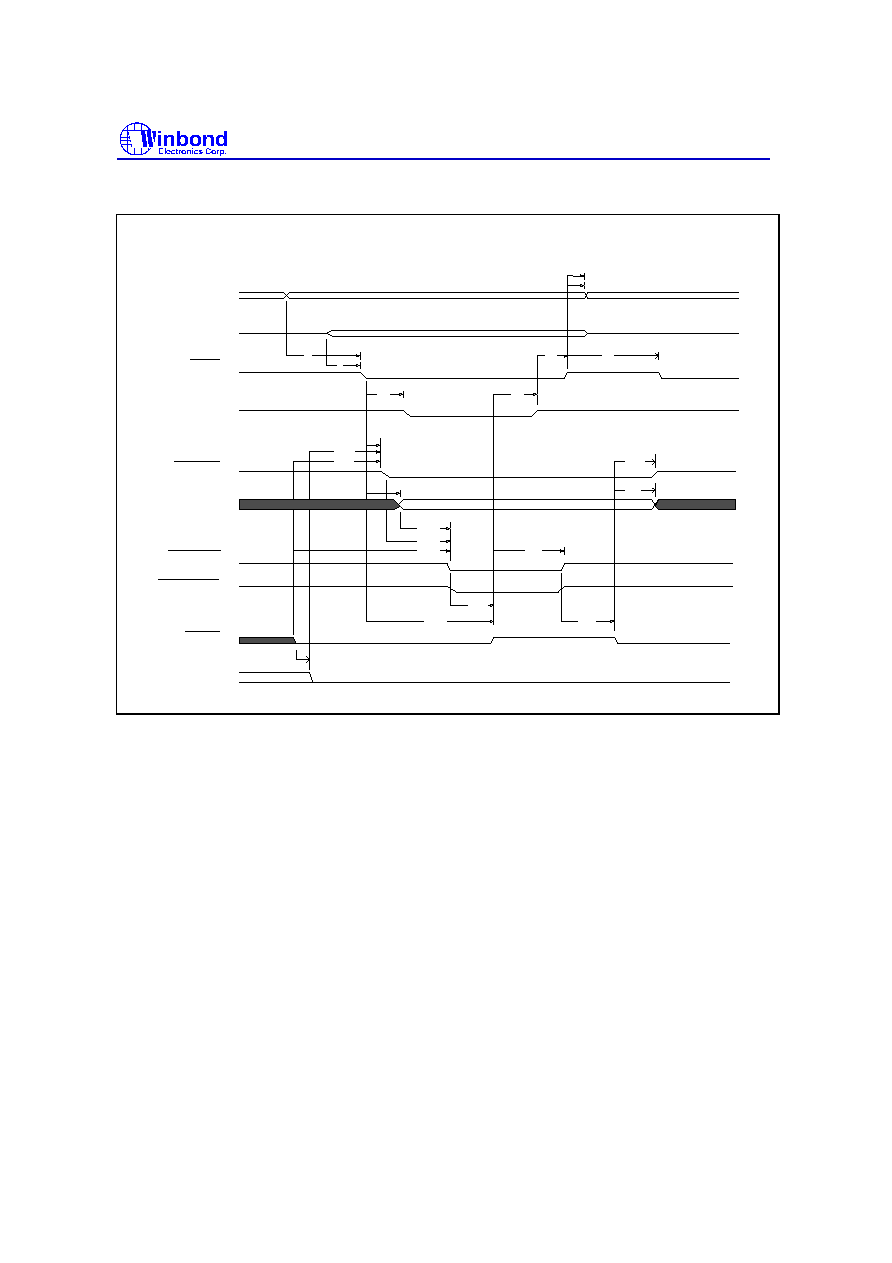
W83877ATF
Publication Release Date: April 1998
- 179 - Version 0.51
EPP Data or Address Write Cycle (EPP Version 1.9)
t3
ADDRSTB
A10-A0
IOW
IOCHRDY
WRITE
DATAST
t1
t2
WAIT
t4
t5
t6
t20
t19
t
7
t9
t10
t11
t13
t15
t16
t17
t22
t8
t18
t21
t12
t14
SD<0:7>
PD<0:7>
PBDIR

W83877ATF
Publication Release Date: April 1998
- 180 - Version 0.51
EPP Data or Address Read Cycle (EPP Version 1.7)
WRITE
DATASTB
t13
t16
t14
t17
t22
t18
t23
t24
t21
t25
t19
t15
t20
ADDRSTB
WAIT
t26
t27
t28
PD<0:7>
t1
IOCHRDY
t3
t2
t4
t10
IOR
t5
t6
t7
t8
t9
SD<0:7>
A<0:10>
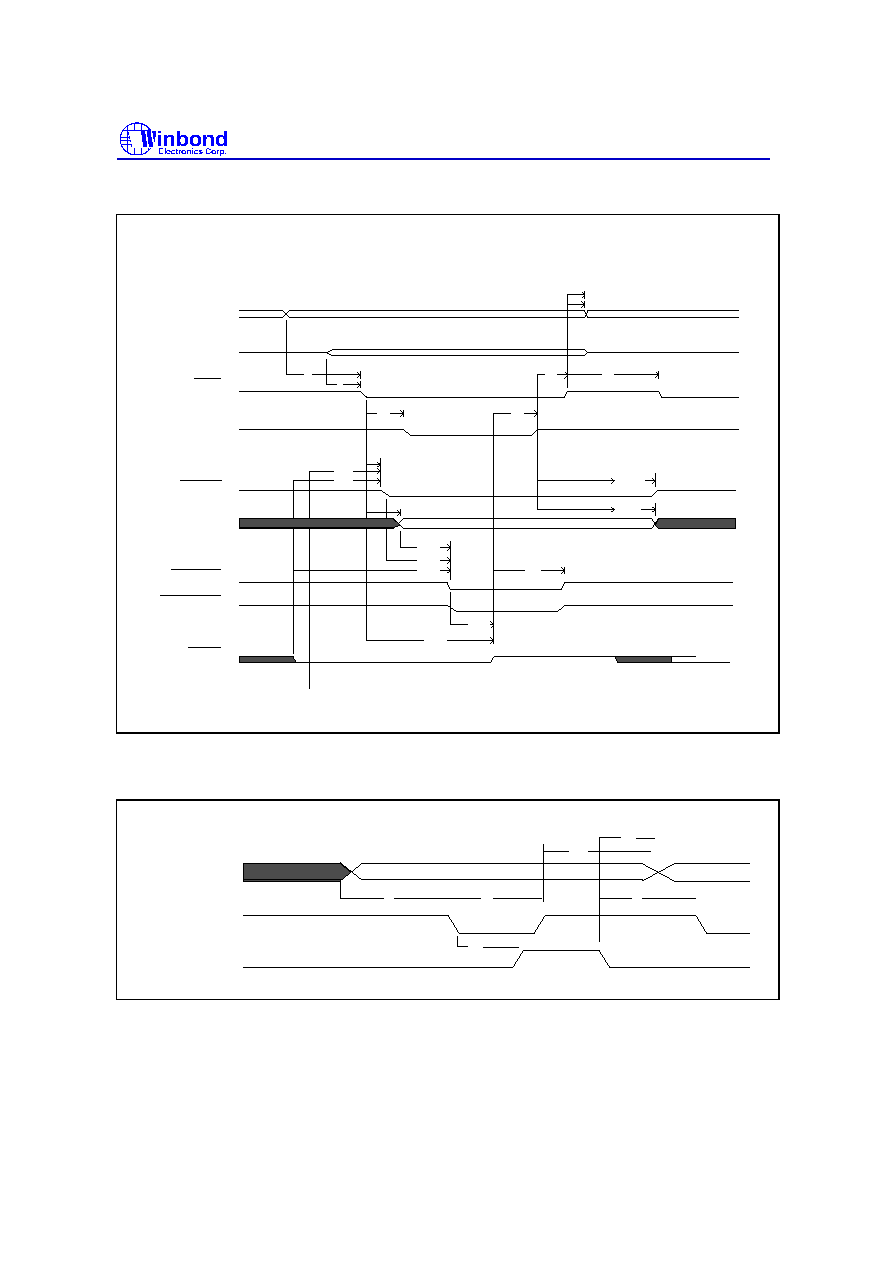
W83877ATF
Publication Release Date: April 1998
- 181 - Version 0.51
EPP Data or Address Write Cycle (EPP Version 1.7)
t3
ADDRSTB
A10-A0
IOCHRDY
WRITE
DATAST
t1
t2
IOW
WAIT
t4
t5
t6
t20
t19
t7
t9
t10
t11
t13
t15
t16
t17
t8
t18
t22
t22
SD<0:7>
PD<0:7>
Parallel Port FIFO Timing
nSTROBE
BUSY
>
t3
>|
>|
>|
t1
>|
t2
t6
>|
t5
t4
PD<0:7>

W83877ATF
Publication Release Date: April 1998
- 182 - Version 0.51
ECP Parallel Port Forward Timing
t3
nAUTOFD
t1
t2
nSTROBE
BUSY
t5
t7
t5
t6
t8
t4
PD<0:7>
ECP Parallel Port Reverse Timing
t1
t5
nACK
nAUTOFD
t3
t6
t4
t5
t2
PD<0:7>
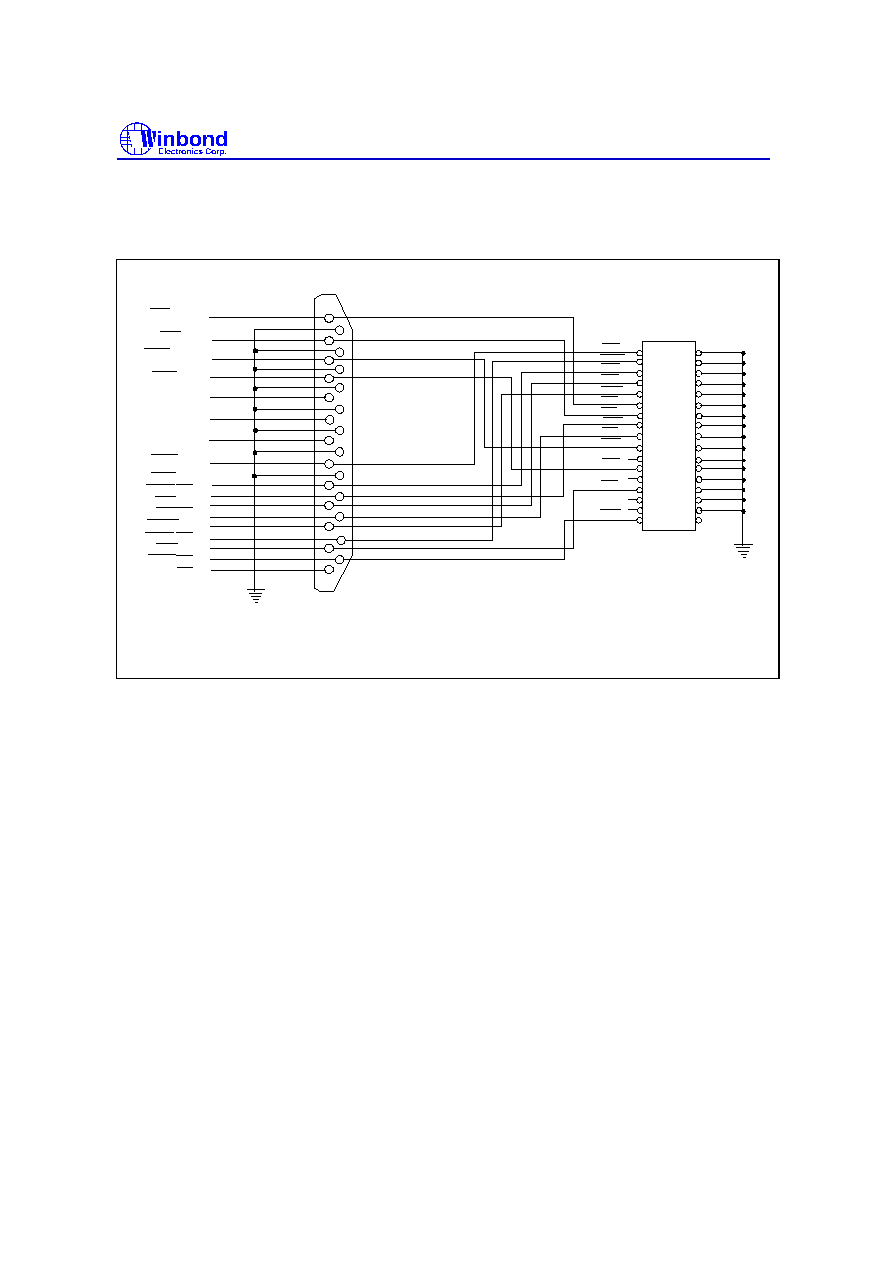
W83877ATF
Publication Release Date: April 1998
- 183 - Version 0.51
11.0 APPLICATION CIRCUITS
11.1 Parallel Port Extension FDD
34
32
30
28
26
24
22
20
18
16
14
12
10
8
6
4
2
33
31
29
27
25
23
21
19
17
15
13
11
9
7
5
3
1
PRINTER PORT
13
25
12
24
11
23
10
22
9
21
8
20
7
19
6
18
5
17
4
16
3
15
2
14
1
JP13
WE2/SLCT
WD2/PE
MOB2/BUSY
DSB2/ACK
PD7
PD6
PD5
DCH2/PD4
RDD2/PD3
STEP2/SLIN
WP2/PD2
DIR2/INIT
TRK02/PD1
HEAD2/ERR
IDX2/PD0
RWC2/AFD
STB
JP 13A
EXT FDC
DCH2
TRK02
RDD2
DIR2
WP2
MOB2
RWC2
DSB2
HEAD2
STEP2
WD2
WE2
IDX2
Parallel Port Extension FDD Mode Connection Diagram

W83877ATF
Publication Release Date: April 1998
- 184 - Version 0.51
11.2 Parallel Port Extension 2FDD
33
31
29
27
25
23
21
19
17
15
13
11
9
7
5
3
1
PRINTER PORT
13
25
12
24
11
23
10
22
9
21
8
20
7
19
6
18
5
17
4
16
3
15
2
14
1
JP13
WE2/SLCT
WD2/PE
MOB2/BUSY
DSB2/ACK
PD5
DCH2/PD4
RDD2/PD3
STEP2/SLIN
WP2/PD2
DIR2/INIT
TRK02/PD1
HEAD2/ERR
IDX2/PD0
RWC2/AFD
STB
JP 13A
EXT FDC
DCH2
TRK02
RDD2
DIR2
WP2
MOB2
RWC2
DSB2
HEAD2
STEP2
WD2
WE2
IDX2
34
32
30
28
26
24
22
20
18
16
14
12
10
8
6
4
2
DSA2
MOA2
Parallel Port Extension 2FDD Connection Diagram
DSA2/PD7
MOA2/PD6
11.3 Four FDD Mode
G1
A1
B1
G2
A2
B2
1Y0
1Y1
1Y2
1Y3
2Y0
2Y1
2Y2
2Y3
DSA
MOA
DSA
DSB
MOA
MOB
W83777ATF
74LS139
7407(2)
MOD
MOC
MOB
DSC
DSD
DSB
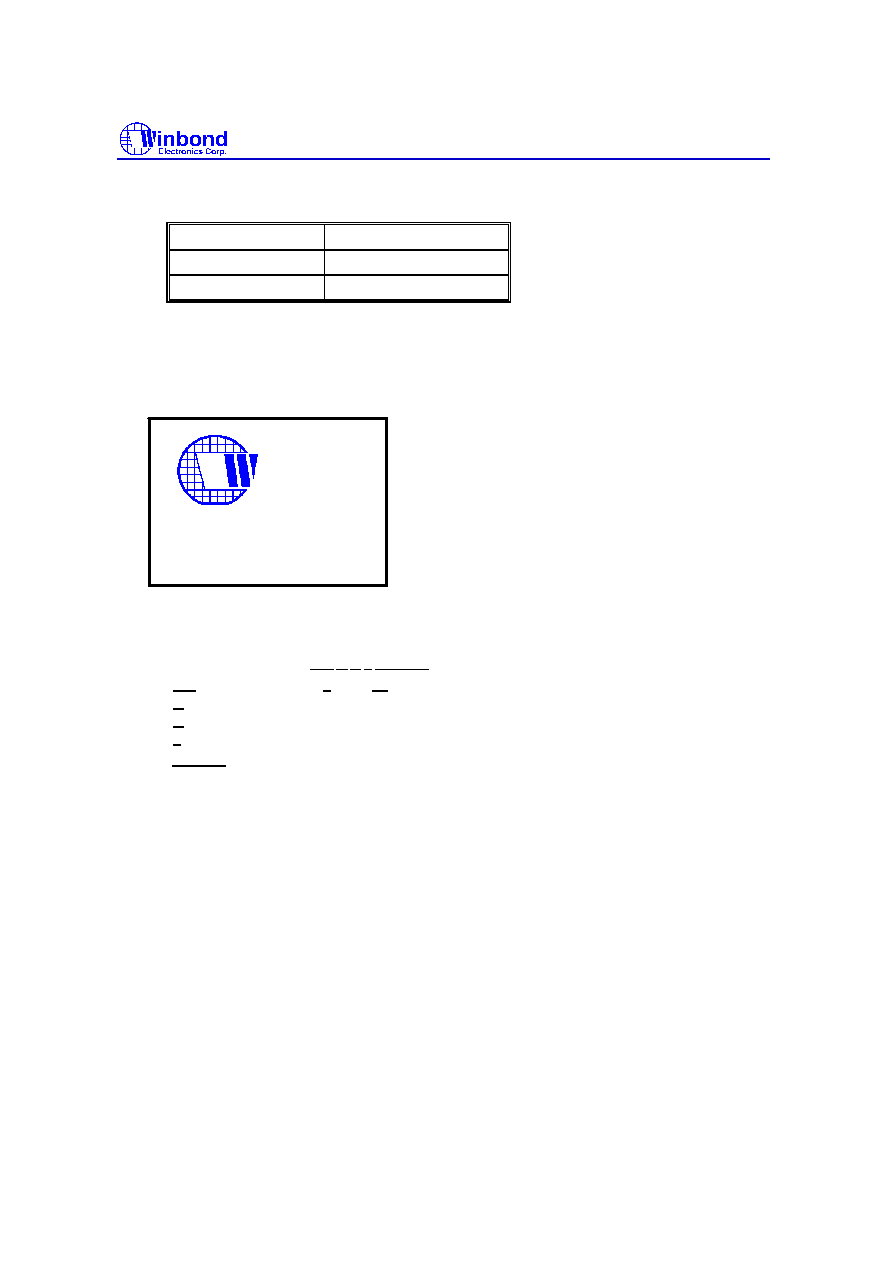
W83877ATF
Publication Release Date: April 1998
- 185 - Version 0.51
12.0 ORDERING INFORMATION
Part No.
Package
W83877ATF
100-pin QFP
W83877ATD
100-pin TQFP
13.0 HOW TO READ THE TOP MARKING
Example: The top marking of W83877ATF
inbond
W83877ATF
732AC27242968
1st line: Winbond logo
2nd line: the type number: W83877ATF
3rd line: the tracking code: 732 A C 2 7242968
732: packages made in '97, week 19
A: assembly house ID; A means ASE, S means SPIL ... etc
C: IC revision; B means version B, C means version C
2: wafers manufactured in Winbond FAB 2
7242968: wafer production series lot number
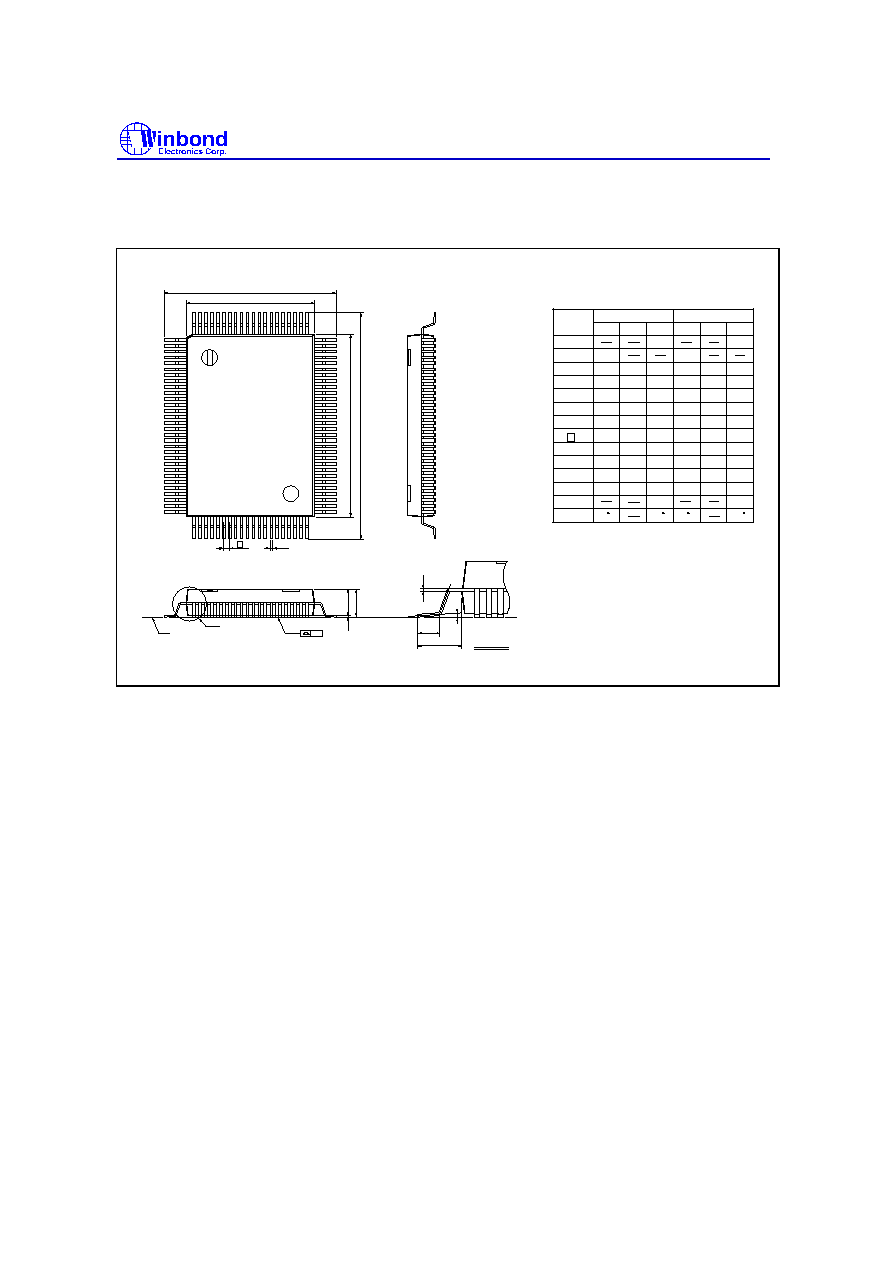
W83877ATF
Publication Release Date: April 1998
- 186 - Version 0.51
14.0 PACKAGE DIMENSIONS
W83877ATF (100-pin QFP)
51
50
31
30
1
80
81
100
2
1
A
H
D
D
e
b
E H
E
y
A
A
Seating Plane
L
L
1
See Detail F
Detail F
c
1. Dimension D & E do not include interlead
flash.
2. Dimension b does not include dambar
protrusion/intrusion.
3. Controlling dimension: Millimeters
4. General appearance spec. should be based
on final visual inspection spec.
0.10
0
12
0
0.004
3.30
0.10
0.130
0.004
Notes:
Symbol
Min. Nom. Max.
Max.
Nom.
Min.
Dimension in inches
Dimension in mm
12
2.40
1.40
19.10
1.20
18.80
1.00
18.49
0.094
0.055
0.988
0.752
0.047
0.976
0.740
0.039
0.964
0.728
0.65
20.13
14.13
0.25
0.40
2.97
20.00
14.00
2.85
19.87
13.87
0.10
0.25
2.73
0.792
0.556
0.010
0.016
0.117
0.787
0.551
0.112
0.026
0.782
0.546
0.004
0.010
0.107
0.012
0.006
0.15
0.30
24.49
24.80
25.10
0.020
0.087
0.032
0.103
0.50
0.80
2.21
2.62
A
b
c
D
e
H
D
H
E
L
y
A
A
L
1
1
2
E
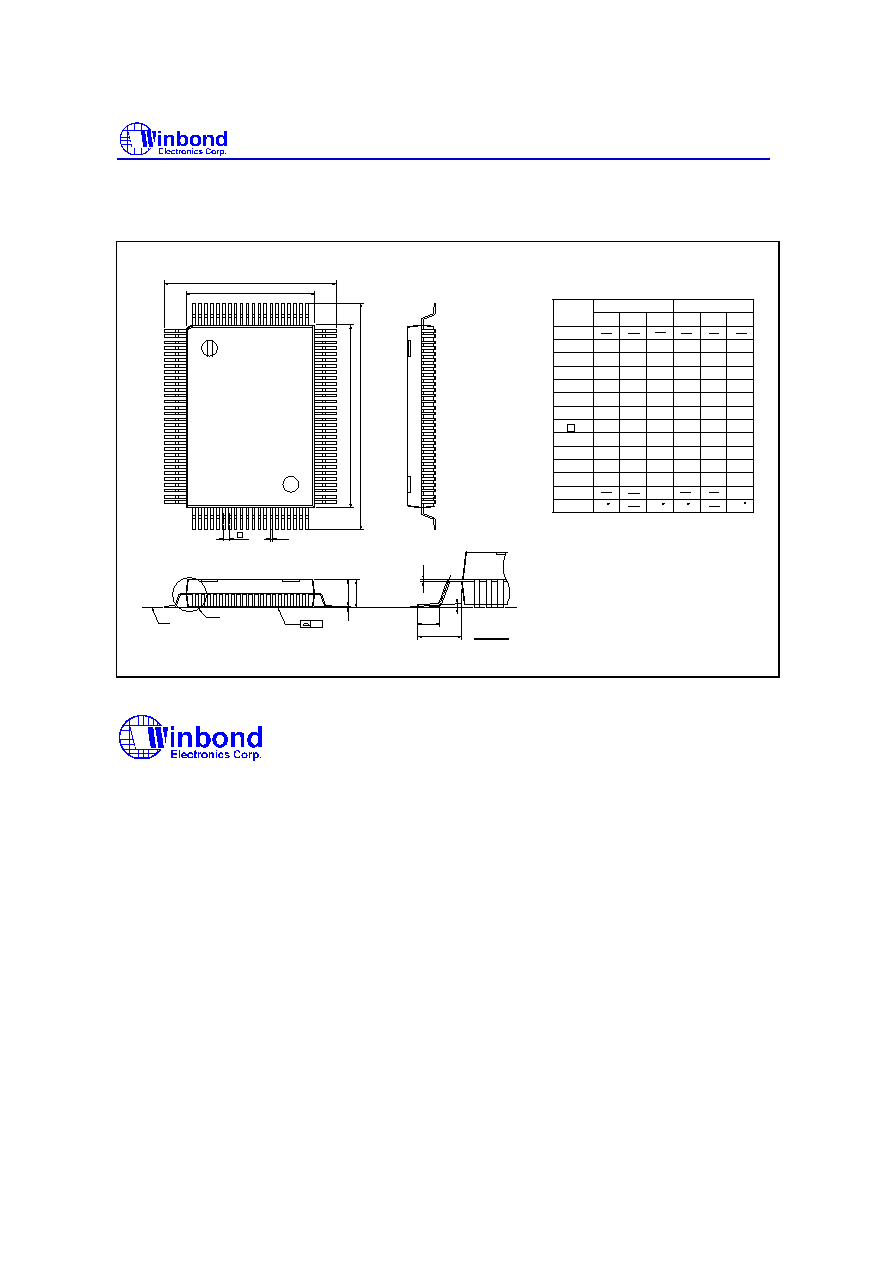
W83877ATF
Publication Release Date: April 1998
- 187 - Version 0.51
W83877ATD (100-pin TQFP)
51
50
31
30
1
80
81
100
2
1
A
H
D
D
e
b
E H
E
y
A
A
Seating Plane
L
L
1
See Detail F
Detail F
c
1. Dimension D & E do not include interlead
flash.
2. Dimension b does not include dambar
protrusion/intrusion.
3. Controlling dimension: Millimeters
4. General appearance spec. should be based
on final visual inspection spec.
0.08
0
7
0
0.003
0.05
0.002
Notes:
Symbol
Min. Nom. Max.
Max.
Nom.
Min.
Dimension in inches
Dimension in mm
7
1.00
0.75
16.10
0.60
16.00
0.45
15.90
0.039
0.030
0.870
0.634
0.024
0.866
0.630
0.018
0.862
0.626
0.65
20.10
14.10
0.20
0.38
1.45
20.00
14.00
1.40
19.90
13.90
0.10
0.22
1.35
0.791
0.555
0.008
0.015
0.057
0.787
0.551
0.055
0.026
0.783
0.547
0.004
0.009
0.053
0.013
0.006
0.15
0.32
21.90
22.00
22.10
0.020
0.032
0.498
0.802
A
b
c
D
e
H
D
H
E
L
y
A
A
L
1
1
2
E
0.004
0.006
0.10
0.15
Headquarters
No. 4, Creation Rd. III
Science-Based Industrial Park
Hsinchu, Taiwan
TEL: 886-35-770066
FAX: 886-35-789467
www: http://www.winbond.com.tw/
Taipei Office
11F, No. 115, Sec. 3, Min-Sheng East Rd.
Taipei, Taiwan
TEL: 886-2-7190505
FAX: 886-2-7197502
TLX: 16485 WINTPE
Winbond Electronics (H.K.) Ltd.
Rm. 803, World Trade Square, Tower II
123 Hoi Bun Rd., Kwun Tong
Kowloon, Hong Kong
TEL: 852-27516023-7
FAX: 852-27552064
Winbond Electronics
(North America) Corp.
2730 Orchard Parkway
San Jose, CA 95134 U.S.A.
TEL: 1-408-9436666
FAX: 1-408-9436668
Please note that all data and specifications are subject to change without notice. All the trade marks of products and companies
mentioned in this data sheet belong to their original owners.






























































































































































































